Alberta Tourism Information
Why visit alberta.
Alberta , the largest of Canada’s three prairie provinces , contains a large portion of the Rocky Mountains and most tourism to the province centers around visiting the beautiful parks that surround them. The province’s two main cities, Calgary and Edmonton , are Canada’s largest outside the Toronto-Montreal-Vancouver axis, though they’re much less popular as tourist destinations. The larger city, Calgary, is generally acknowledged to contain more to see and do, though Edmonton contains a few famous attractions, as well.

Orientation
Most Albertans live in either Calgary or Edmonton and the cities are about three hours apart, with Calgary in the south and Edmonton in the north. The Rocky Mountain region is on the province’s far west, along the border with British Columbia . Everywhere else is largely rural, home to small farm towns and oil fields.
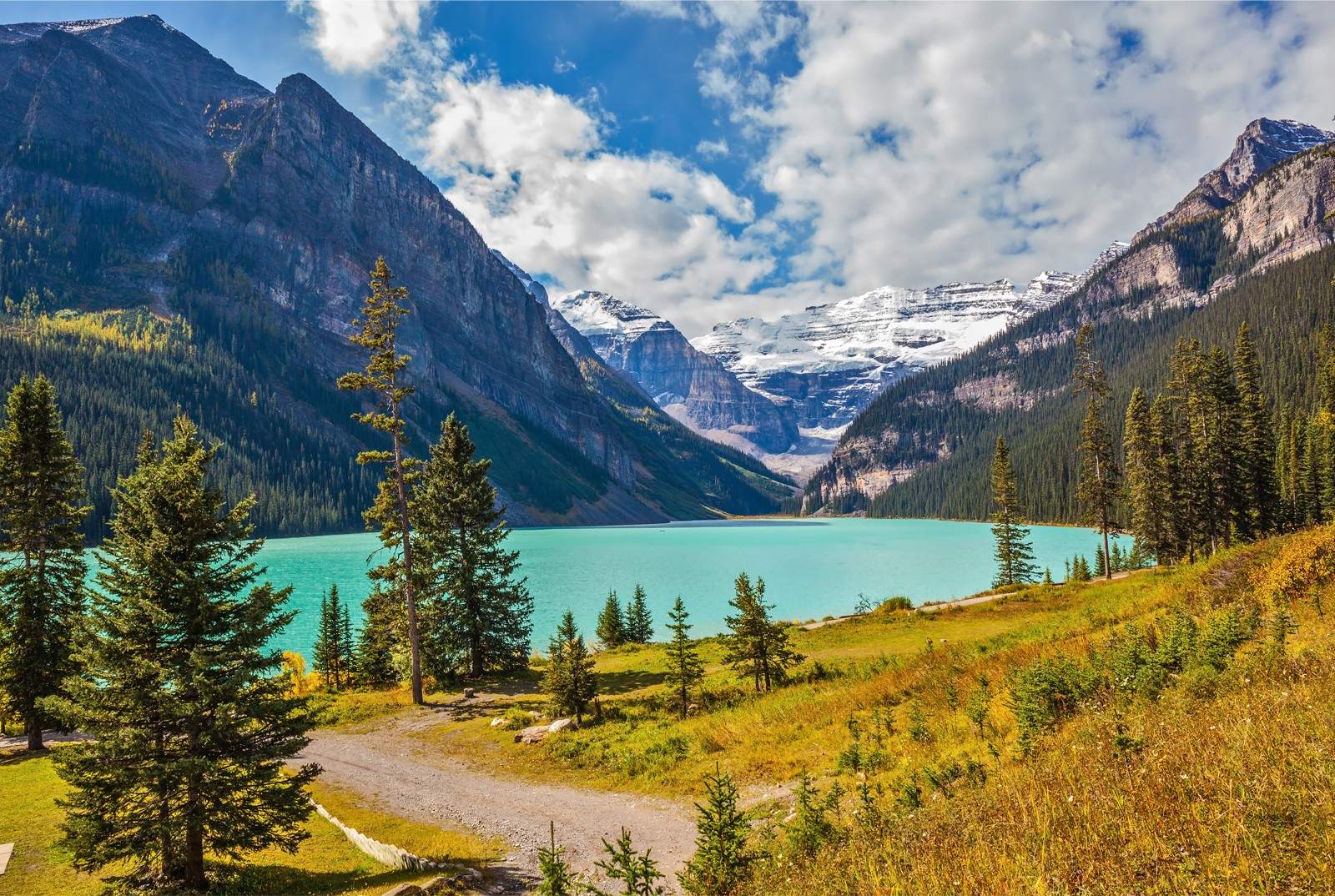
Lake Louise in Banff National Park. kavram/Shutterstock
The rocky mountain parks.
The most iconic tourist destination in Alberta — and possibly the entire country — is the beautiful Banff National Park and its emerald-green Lake Louise . Containing over 6,000 square kilometers of unspoiled Rocky Mountain scenery, Canada’s most popular outdoor resort is home to virtually every activity you could imagine, with over 1,000 km of hiking trails, a dozen campgrounds, numerous ski hills, a 27-hole golf course , three hot springs, and a wild river (the Kicking Horse ) that’s ideal for white water rafting . There are no shortages of shops, hotels, and restaurants in the village of Banff Town , which is usually packed with tourists.
Three hours north of Banff is Jasper National Park , which is broadly similar to Banff in terms of natural beauty, but is harder to get to, has fewer activities and is thus slightly less popular. Some prefer its more laid-back vibe. Even more laid-back are the smaller-still mountain communities of Canmore Kananaskis , which is near Banff, and Waterton Lakes National Park which is in Alberta’s most south-west corner. All of the Rocky Mountain parks are a couple hours from the two big cities. Banff, Canmore, and Waterton are closer to Calgary while Jasper is closer to Edmonton.
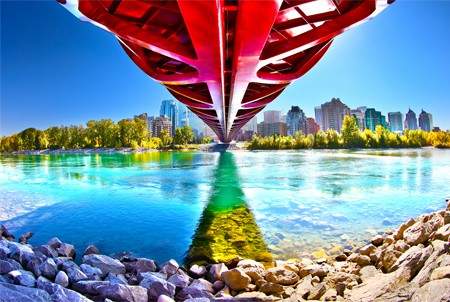
Calgary's Peace Bridge, over the Bow River that divides the city. Its eccentric design, though controversial at first, has now become an icon of the city.
Calgary Tourism
The largest city in Alberta.
Calgary is split in half by the Bow River , which has a pleasant coastline for walking and in the summer is popular for “floating” — what locals call riding in inner tubes. The river is crossed by multiple bridges, with the recently-completed Peace Bridge the most architecturally interesting.
The 160 meter tall Calgary Tower is the city’s most famous landmark, and like most buildings of its sort, it contains a rotating restaurant and observation deck at the top. It’s no longer the tallest building in Calgary, however — that honor goes to the uniquely curved Bow Building , recognizable from afar with its criss-cross design. Equally iconic is the sloping roof of the Scotiabank Saddledome , home of the city’s NHL team, as well as other sports events and concerts.
Within walking distance of downtown is the massive Calgary Zoo which encompasses over 159 hectares and houses a vast assortment of Canadian and foreign animals, as well as exhibits on Alberta’s dinosaur-filled past.
Calgary postcards often feature pictures of the Ski Jump Towers , a relic of the 1988 Olympics found on the edge of the city limits. The surrounding Olympic Park is now run by a company named WinSport that offers a variety of public activities, including a Zipline and bobsled.
- Official Website, Tourism Calgary
- The Top 10 Things to Do in Calgary, TripAdviso r
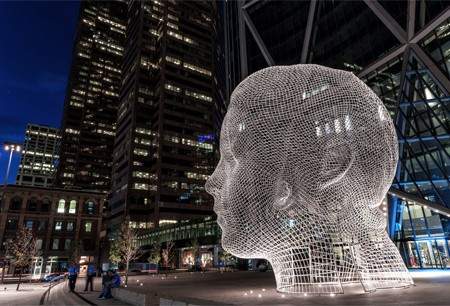
" Wonderland ," a sculpture by famed Spanish artist Jaume Plensaat (b. 1955) at the base of downtown Calgary's Bow Building.
Museums and Galleries
The Glenbow Museum is Alberta’s largest museum, featuring an extensive history of the province from aboriginal times to the present, as well as contemporary artwork and traveling exhibits from around the world.
Spanning over 127 acres, Heritage Park Historical Village is a vast village of antique buildings containing re-creations of Canadian life from the Victorian era to the 1950s, complete with costumed actors.
Shopping and Restaurants
8th Ave SE, better known as Stephen Ave (Calgary streets often have two names) is the primary shopping district. Closed to car traffic in the summer and weekends, it contains a vast array of shops, restaurants, and vendors, many of which are housed in iconic Victorian-era sandstone buildings. An enormous shopping mall known as the CORE runs parallel to a portion of 8th, and contains most major retail chains, as well as a large indoor park, the Devonian Gardens , on the top floor.
Many blocks away, 17th Ave SW, also known as the Red Mile , is the other trendy shopping area, but is better known for its bars and restaurants. A 15 minute drive from the downtown core is the city’s largest mall, the Chinook Centre , which has everything the CORE doesn’t.
The Red Mile is Calgary’s iconic drinking and party zone, named after the color of Calgary’s hockey team, the Flames, which appears in considerable abundance on game nights. The Mile is home to many of the city’s oldest and most iconic bars and lounges.
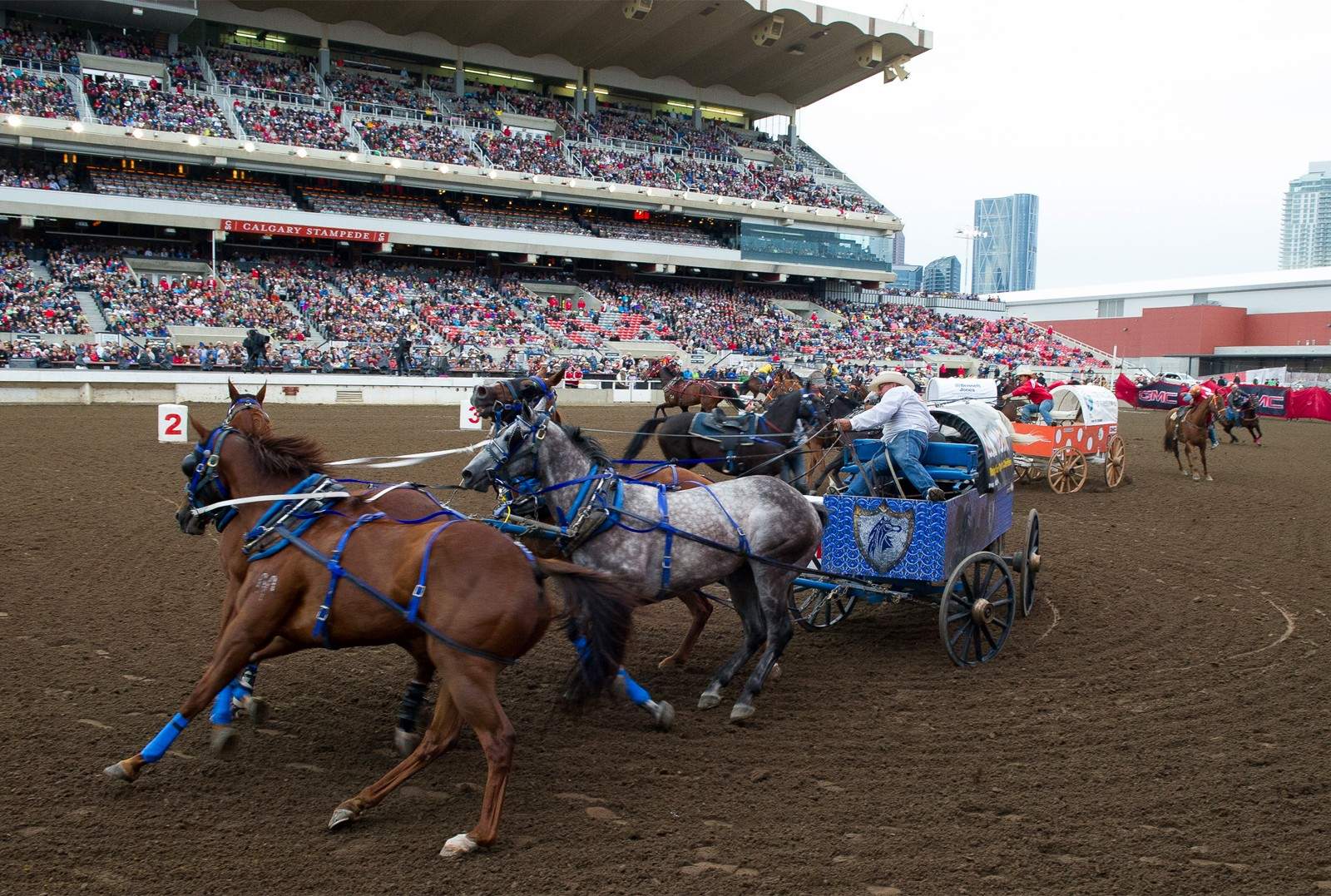
Chuckwagon races at the 2016 Stampede. Bill Marsh/Calgary Stampede
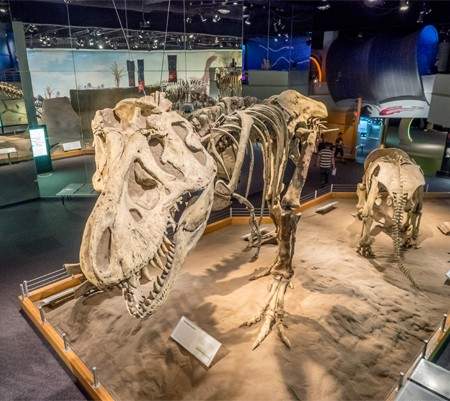
A T-Rex skeleton display at the Royal Tyrrell Museum in Drumheller.
The Calgary Stampede is Canada’s biggest party, and takes over much of the city for 10 days every July. Though the 100-year-old festival is officially supposed to revolve around watching traditional cowboy sports like bronco riding and steer wrestling, the modern-day Stampede has grown to offer something for everyone, including live concerts, carnival rides, shopping, and plenty of hot, greasy food.
Spectator Spots
Calgary has an NHL team, the Calgary Flames who play in the Scotiabank Saddledome and a CFL team, the Calgary Stampeders , who play in the McMahon Stadium .
Outside Calgary
An hour and a half from Calgary, the Royal Tyrrell Museum in Drumheller houses a vast collection of exhibits on life in prehistoric Canada, including an array of dinosaur skeletons uncovered from the Alberta badlands. The bizarre landscape of the badlands themselves, which surround the museum, are fun to explore as well.
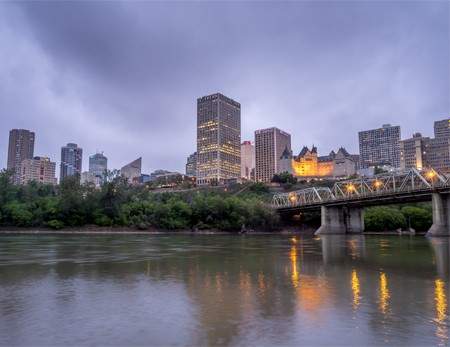
The skyline of Edmonton on the base of the Saskatchewan River .
Edmonton Tourism
Alberta’s second-biggest city and provincial capital.
Edmonton is split in half by the North Saskatchewan River and ample parklands surround the coasts. The downtown area is located on the north side.
The city’s most iconic building is the enormous sandstone structure that houses the Legislative Assembly of Alberta and four glass pyramids on the south side of the river that house the Muttart Conservatory , a massive indoor garden and museum. An equally grand glass pyramid can be found on the roof of the distinctive City Hall building. Surrounding city hall is Sir Winston Churchill Square , a large public plaza.
The gigantic Hotel Macdonald is Edmonton’s fanciest hotel, and the city’s most prominent example of Victorian-era architecture. Outside of downtown, the neighborhood of Old Strathcona contains most other historic buildings of note.
- Official Website, Tourism Edmonton
- The Top 10 Things to Do in Edmonton, TripAdvisor
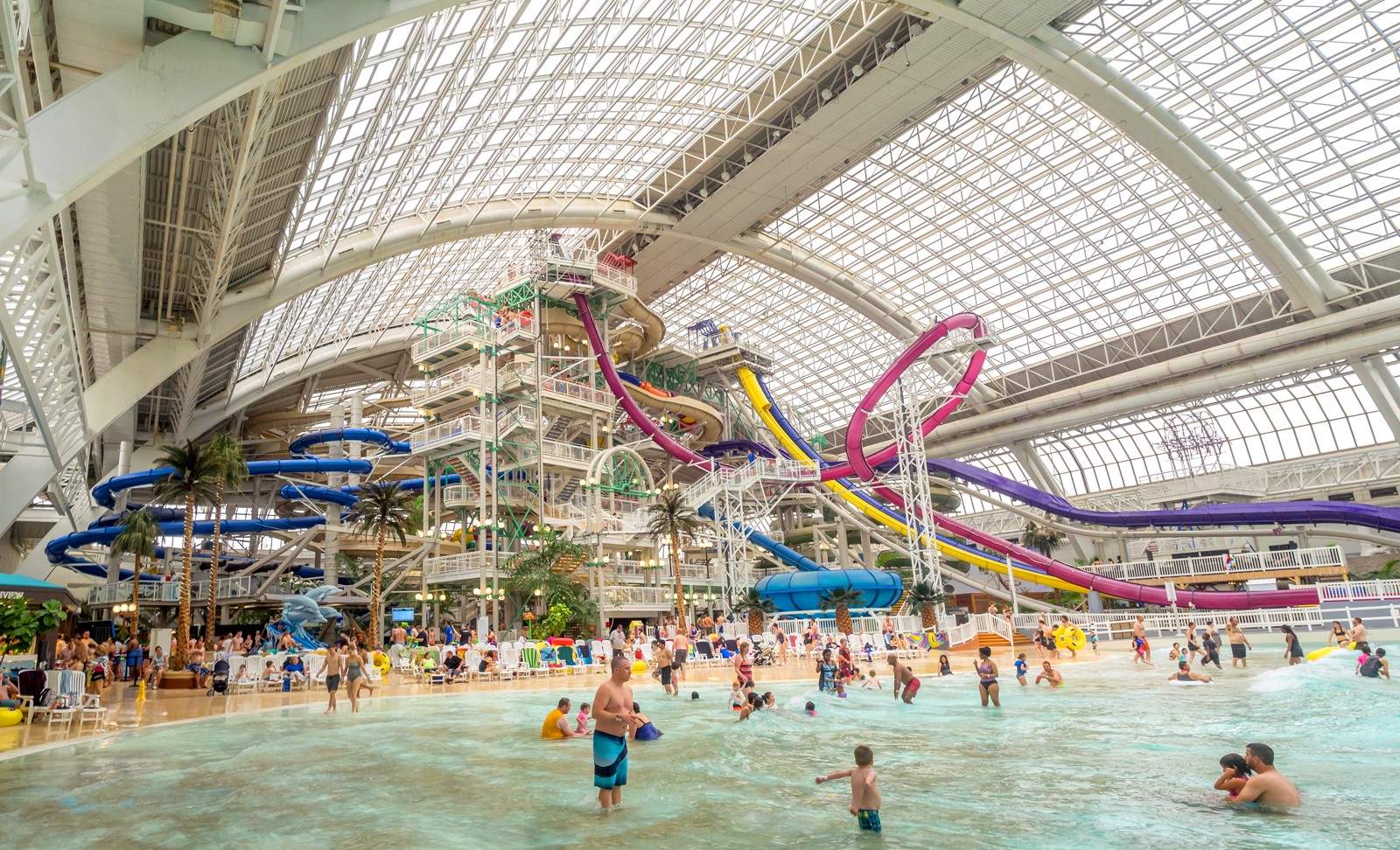
The World Waterpark at the West Edmonton Mall. Jeff Whyte/Shutterstock
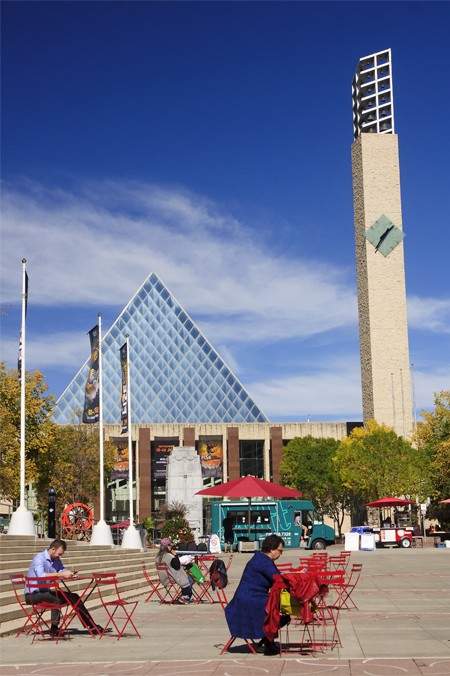
Edmonton City Hall and the Friendship Tower clock.
Most of Edmonton’s shops and restaurants are concentrated around the long Jasper Ave. (also known as 101st Ave) which runs through the downtown core, and the Old Strathcona neighborhood, centered around Whyte Ave (also known as 82nd Ave), which has a more bohemian character.
More than anything else, however, shopping in Edmonton is synonymous with the enormous West Edmonton Mall , which was at one time the largest mall in the world. Though the 1980s-era building is hardly state-of-the-art by today’s standards, its size remains awe-inspiring. It contains over 800 shops and countless other gimmicky attractions, including a roller coaster, a waterpark, a petting zoo, mini-golf, and a re-created 16th Spanish galleon. It’s about a half-hour drive from downtown.
The Art Gallery of Alberta is a wild-looking building containing the province’s largest collection of historic and contemporary art from both Canadian and international artists, with constantly changing exhibits.
Fort Edmonton Park is an outdoor “living history” museum offering recreated streets and buildings from Edmonton’s past. It’s popular with schoolchildren on field trips.
Spectator sports
Edmonton has an NHL team, the Edmonton Oilers , who play in Rogers Place . Edmonton’s CFL team, the Edmonton Eskimos , play at the Brick Field in Commonwealth Stadium .
Edmonton is unexpectedly home to the world’s third-largest fringe festival , run by a local outfit called Fringe Theatre Adventures . Held in August, Edmonton Fringe is an 11-day celebration of independent plays, story slams, comedy, magic, busking, and all other forms of public performance. A global assortment of talent stage shows all over town. Ticket prices are quite cheap.
Fan of more conventional performances can check out a play at the Citadel Theater , or a concert by the Edmonton Symphony Orchestra at the beautiful Winspear Centre .
Outside Edmonton
As Edmonton is not exactly a major tourist destination unto itself, the surrounding area offers limited appeal for visitors. Parks and campgrounds are the main attractions, primarily Jasper National Park (see above), and to a lesser extent Elk Island National Park , which, though beautiful, has the dubious distinction of being Alberta’s only national park not recognized as a World Heritage Site by the U.N.
Alberta Tourism Resources
- Alberta Tourism Official Website
- Alberta, Lonely Planet
- Alberta Travel Guide, Fodor's
- Budget Travel
- Cheap Flights
- Driving Canada
- Paved Roads
- Gravel Roads
- Train Travel
- Hitchhikers Guide
- Tourist Visa
- Working Holiday Visa
- Hospitality Work
- Organic Farms
- Ranch Jobs in Canada
- Canada Topo Maps
- Climate & Weather
- Alaska Highway
- Thompson Okanagan
- Kootenay Rockies
- Cariboo Chilcotin
- Northern BC
- Alberta Rockies
Southern Alberta
- 19 Best Alberta Towns
- Yukon & Alaska
- Northwest Territories
- Saskatchewan
- Guided Tours in 2024
- Camper Rental
- Accommodation
- Travel Insurance
- Basic Packing List
- Campfire Cooking
- Campfire Recipes
- Multi Day Hikes
- Horseback Adventures
- National Parks Canada
- Small Town Rodeos
- Heliskiing Canada
- Canada Facts
- Wilderness Dangers
- Black Bears
- Grizzly Bears
- Polar Bears
- Canada With Kids
- Canadian Food
- Canadian Currency
- Outdoor Store
- Travel Resources
- Backcountry Newsletter
Alberta Trip Planner and Travel Guide
Experience Alberta on the wild side with my Alberta Trip Planner full of epic content and personal tips to get you inspired.
Alberta is a breathtaking province and a vacation destination you won’t soon forget with high mountains and glacially-fed blue lakes, golden wheat, and bright yellow flowers of canola fields across an endlessly rolling countryside.
Discover remote alpine lakes and glaciers, hidden places that most people never see, not even the Albertans.

Visit the Rocky Mountains with world-famous Banff and Jasper national parks. Head east to the Canadian Badlands and the dinosaurs at Drumheller. Explore the boreal forest and lake lands of the north. Travel through the grasslands and rolling prairies of the south. Refresh in the steaming waters of a natural hot spring.
Plan your Alberta trip
Alberta rocky mountains, central alberta, northern alberta.
Alberta epic Road trips
Small towns in Alberta to visit
Alberta’s Heritage
Top things to do in Alberta
Winter in Alberta

Travel in Alberta
Alberta is full of natural wonders with its over 250 provincial parks and recreation areas plus five national parks, Banff, Jasper, Waterton, Wood Buffalo and Elk Island, including three world heritage sites. For Alberta trip planning you need to know the basics.
- Park Passes – Park passes are required for entry into any of Canada’s national parks. You can buy them at the park entrance or buy them online . Instead of a single entry pass, Parks Canada Discovery Passes cover admission to more than 80 destinations for 12 months. They are also available at all MEC Mountain Equipment Company locations. Entrance to provincial parks is free.
- Wildlife – Alberta has hundreds of species of wildlife, including elk, moose, bighorn sheep, grizzly bear, bison, cougar and wolf. Pick up brochures at Visitor Information Centres for safety tips and check out Canadian Wildlife – what you need to know for more information.
- Weather and Climate – Alberta is known for sunny days and strong winds. Summer daytime highs are normally 20 to 25°C but can reach the upper 30s. Winter temperatures range from -5 to -15°C. They can drop as low as -30 to -40°C for short periods of time. Read more about the weather and climate here
- Emergency – Fire/Police/Ambulance: 911
- Road Conditions – call #511 – 511.alberta.ca
Alberta Trip Planner and things to know
- What to Pack: Be prepared for all kinds of weather when travelling in Alberta. The weather can change quickly and it’s best to dress in layers in any season.
- Taxes: Alberta is the only province in Canada without a provincial sales tax (PST) which makes travelling in this province a bit more affordable. There is still a five percent government goods and service tax (GST) charged on most purchases. Learn more about Canadian currency .
- Tipping in Canada is expected by food servers, taxi drivers, tour guides, hotel staff and estheticians and is usually not added to your bill.
- Accommodation Guide
- Cell phones – stay connected
- General tips and advice
Getting here
- Air: International airports in Alberta are Calgary (YYC), Edmonton (YEG), and Fort McMurray (YYM). For more on flights visit How to find cheap flights .
- Car: Alberta is accessible from the east and west by two officially designated Trans-Canada routes. Highway 1 crosses Alberta in the south and Trans-Canada Yellowhead Highway 16 crosses through central Alberta. For north-south travel use the Queen Elizabeth II Highway.
- Train : Via Rail service is available to Edmonton and Jasper. The Rocky Mountaineer runs between Vancouver and Jasper, as well as Banff, Lake Louise and Calgary.
Getting around
- Getting around Canada guide – complete getting around guide
- Car rental what you need to know
- RV and Camper rental guide
- Bus tours , scheduled coach services and shuttle services are available through various operators. Every city has good public transportation.
- Weather, road construction and other activities result in different highway conditions across Alberta. For road reports dial 511 or visit 511alberta.ca .
Few mountain ranges are as dramatic as the Canadian Rockies. It’s a vast land filled with inspiring scenery, wildlife, and an abundance of recreational activities. Explore the areas of Jasper, Banff and Waterton Lakes National Parks, as well as less known Kananaskis Country. Many small unique towns and attractions will meet you along the way.
PLAN YOUR TRIP

Here you travel through rolling foothills, wide open prairies and stunning badlands, home to the world’s largest deposits of dinosaur bones. Dinosaur Provincial Park and Head-Smashed-In Buffalo Jump, are two of Alberta’s five World Heritage Sites. Cypress Hills Provincial Park and Writing-on-Stone Provincial Park are also in this region.

Alberta’s heartland stretches from the foothills of the Rockies to an endless of golden plains and aspen parkland east to the Saskatchewan border. Here you feel the lively western heritage and pioneering spirit. Many provincial parks and beautiful historic towns to visit along the way.
Plan your trip to Central Alberta.

A fast land of massive mountain ranges, boreal forests, sweeping grassland, sand dunes and huge rivers. Fly into Wood Buffalo National Park, the world’s largest dark sky preserve for a bucket list experience. Easier to access are Elk Island National Park and Lesser Slave Lake Provincial Park.
Plan your trip to Northern Alberta

Alberta epic road trips
Road trip travel means freedom of choice and total flexibility. Go where you want, stop anywhere, and detour off the beaten track for the best adventures. The experience of having the open road in front of you is addictive. It’s the best way to experience the amazing province of Alberta.
Road trip itineraries coming soon.

19 Best towns in Alberta
Visiting small towns, meeting locals and exploring surrounding areas are highlights of my travels. Don’t just glance at the town sign on your way through. Stop at the local coffee shop or store and inquire about the area. You will be surprised by what you get.
Alberta Towns

Alberta is not only an outdoor lover’s paradise, but it also comes with an interesting history. Museums and historic sites around the province show off the beginning of the fur trade 250 years ago and the era of the cowboys and pioneers o the 1800s.
The history of native cultures can be seen at the Head-Smashed-In Buffalo Jump Interpretive Centre near Fort Macleod and in the petroglyphs and pictographs at Writing-on-Stone Provincial Park, near Milk River.
Traditions of Aboriginal people are remembered in Edmonton’s Provincial Museum of Alberta and many other smaller museums throughout the province.
Top things to do
Alberta is a nature lover’s paradise with its five National Parks. The Rocky Mountain parks are loaded with outdoor adventures. In summer, ride horses or hike endless trails.
Go for a paddle on Alberta’s scenic lakes or rent a mountain bike and go explore. Whatever you do, watch out for wildlife. Venture north into a land of whitewater, backcountry lodges, and trophy fishing. The possibilities are endless.
Rodeo and the Wild West
Visit the bronc-buckin’ Calgary Stampede, a Wild West exhibition, which is much more than a big-time rodeo. Calgary, the former cow town’s very roots are in ranching and meatpacking.
Thousands of folks gather to watch the rough rodeo and chuckwagon races of the 10 days Calgary Stampede happening each July.
If you’re not into big events, look out for a small-town rodeo instead where you can get up close and it’s much more personal and cheaper.
Horseback Riding
For many, Alberta is an image of the Wild West, horses and cowboys. Therefore, it is the perfect place to get into the saddle the way the explorers did centuries ago. Riding through alpine meadows or across the wide open prairie on a guided horseback adventure ride will be one of your best memories in the time to come.
- Best Horseback adventures
- Authentic Wilderness Ranch Vacations
Hiking should be included in every Alberta Trip Planner. Alberta’s many parks and trails offer the best and cheapest way to explore new wilderness treasures. The beautiful, diverse landscape offers something for every fitness level. Go for a stroll along a river, or try a day hike on a mountain path. What about taking part in a multi-day hike with a guided tour?
Alberta is also the place to try heli-hiking in the Canadian Rockies’ backcountry. These trips will take you to a secluded wilderness heaven.
- Top guided hikes in Alberta
- Best Canadian maps – for the backcountry to never get lost
- Let us trek Canada and be safe
- Alberta Parks
Camping in Alberta
More and more people find the pleasures of wilderness camping. This means that campgrounds are filling up faster. Therefore planning is the key, especially for camping during July and August. Campsites book up early, especially the popular areas that offer “free” camping on public land in Alberta, locally known as crown land camping. In British Columbia, these campsites are called recreation sites, or forestry campsites.
A Public Lands Camping Pass is required in Alberta. You need to purchase the pass before you embark on your trip, and it costs $20 per person for three days or $30 per person for an annual pass. You can purchase your pass online here .
- Backcountry camping in the wild
- In winter, many outfitters offer dog sledding, ice climbing, and heliskiing .
- Or try your luck with ice fishing. Enjoy the comfort of a heated shelter perched on the ice, and wait for a delicious lake trout, walleye, northern pike, perch, or Arctic grayling to gobble your bait. What better adventure than that?
- Take part in a snowmobiling trip and speed through the excellent powder. Sled across frozen lakes and up mountains, through boreal forests, and across wide-open plains. A well-thought-out Alberta Trip Planner for winter travel can get you on fantastic outdoor adventures.
Try something you have never done before, Alberta Canada is the place to do it!
Alberta Highlights along the tourist route
Lake louise.
Lake Louise is a major tourist destination in Alberta. It is part of Banff National Park and is on every traveller’s list.
Located nearby is the beautiful Moraine Lake. This spectacular lake is surrounded by the Valley of the Ten Peaks and is less touristy than Lake Louise.
Head-Smashed- In Buffalo Jump
Head-Smashed- In Buffalo Jump is located at Fort Macleod, where the remains of marked trails, an aboriginal camp, and vast quantities of buffalo skeletons can still be found. They are evidence of a custom practiced by aboriginal people for nearly 6,000 years.
Dinosaur Provincial Park
Dinosaur Provincial Park is a UNESCO World Heritage Site located about a 2 1/2 hour drive southeast of Calgary. The Royal Tyrrell Museum in Drumheller is housing one of the world’s largest displays of dinosaurs. You can easily spend a whole day at the museum to educate yourself.

You may also like
This website contains affiliate links. At no cost to you, I earn a commission if you make a purchase. I only recommend products and companies I use and the income helps keep this website up. Thank you!
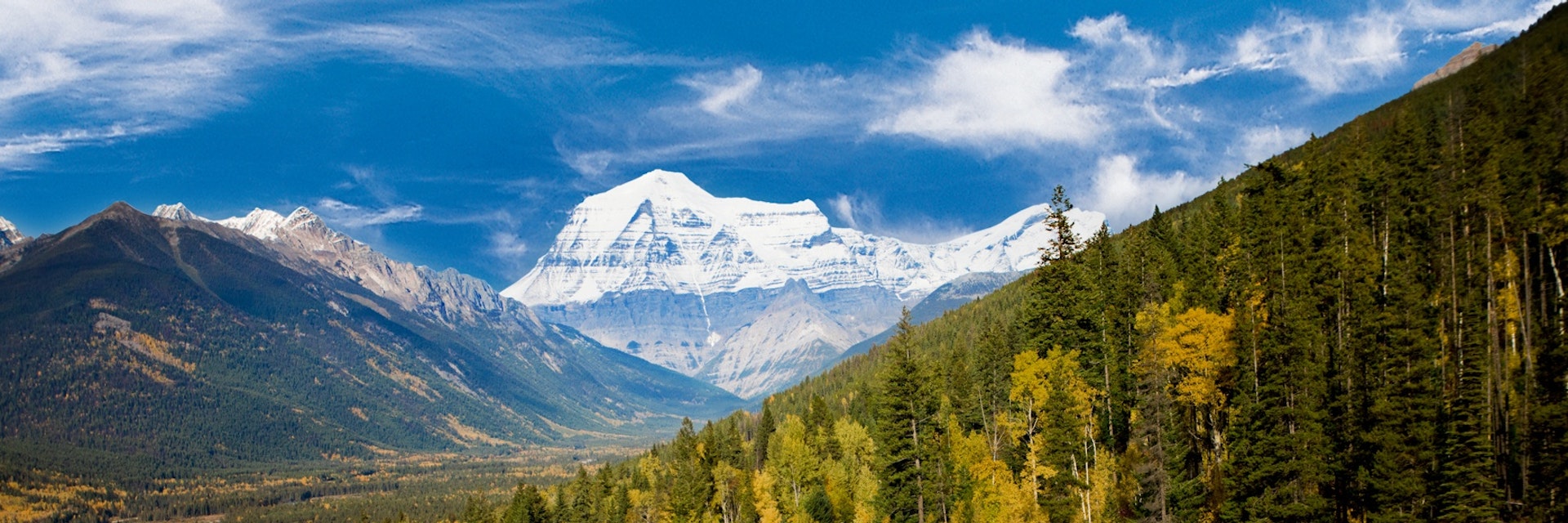
Pete Seaward
Alberta does lakes and mountains like Rome does cathedrals and chapels, but without the penance. For proof head west to Jasper and Banff, two of the world’s oldest national parks; despite their wild and rugged terrain, they remain untrammeled and easily accessible. They're majestic, breathtaking, awesome. No one should leave without first laying eyes on Peyto Lake and the Columbia Icefield, nor before traveling east to the fossil-encrusted badlands around Drumheller, south to the Crypt Lake trail in Waterton Lakes National Park, and north to spot bison in the vast, empty northern parklands.
Leave the planning to a local expert
Experience the real Alberta. Let a local expert handle the planning for you.
Attractions
Must-see attractions.
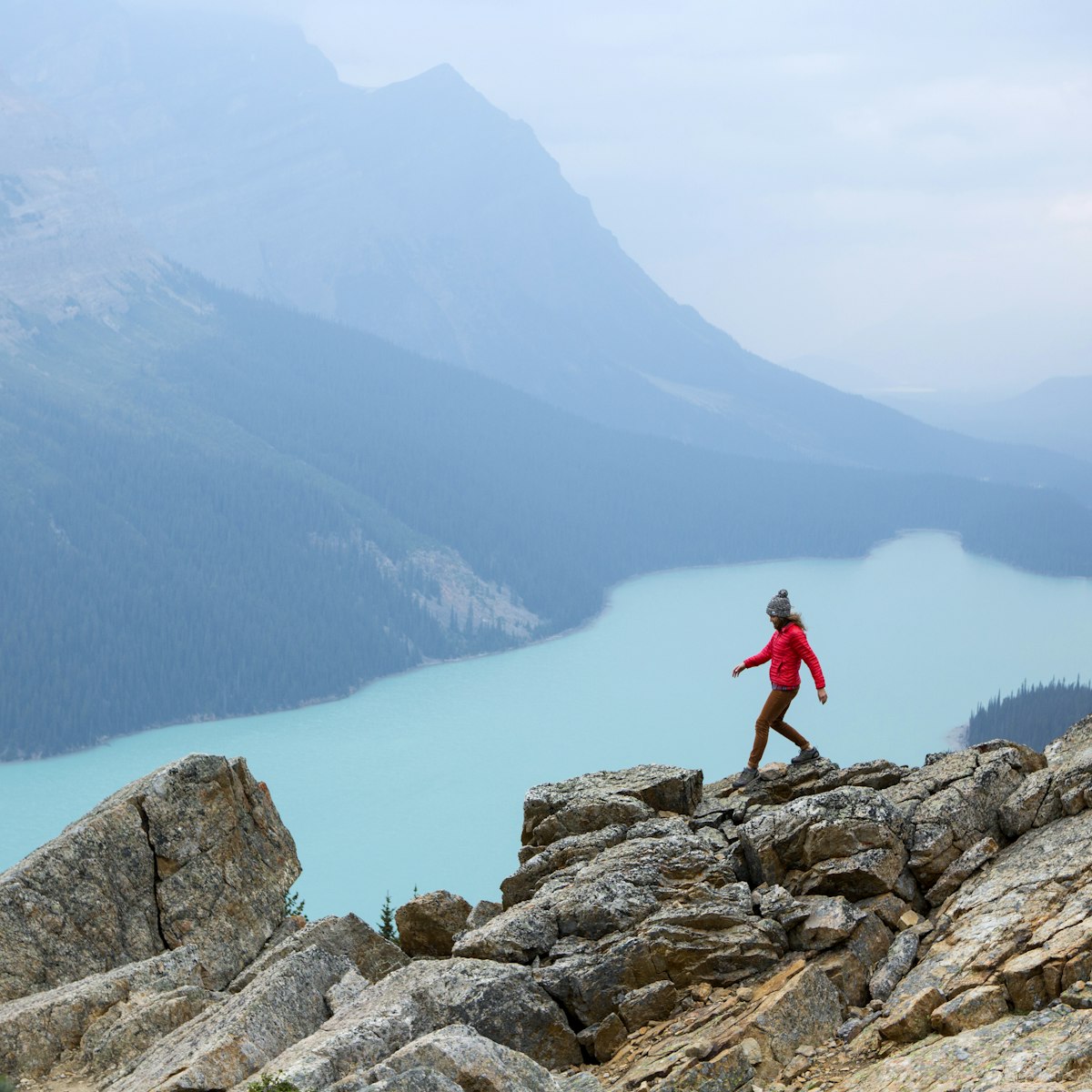
Banff National Park
Banff & Jasper National Parks
Of all Canada’s top sights, Banff National Park justifiably ranks as many people’s number one. As much a piece of history as a natural wonder, Canada’s…

Jasper National Park
Jasper Town & Around
Jasper is a rugged beauty; it's more raw and less tourist-pampering than its southern cousin Banff, and hence host to a more ambitious, adventurous…
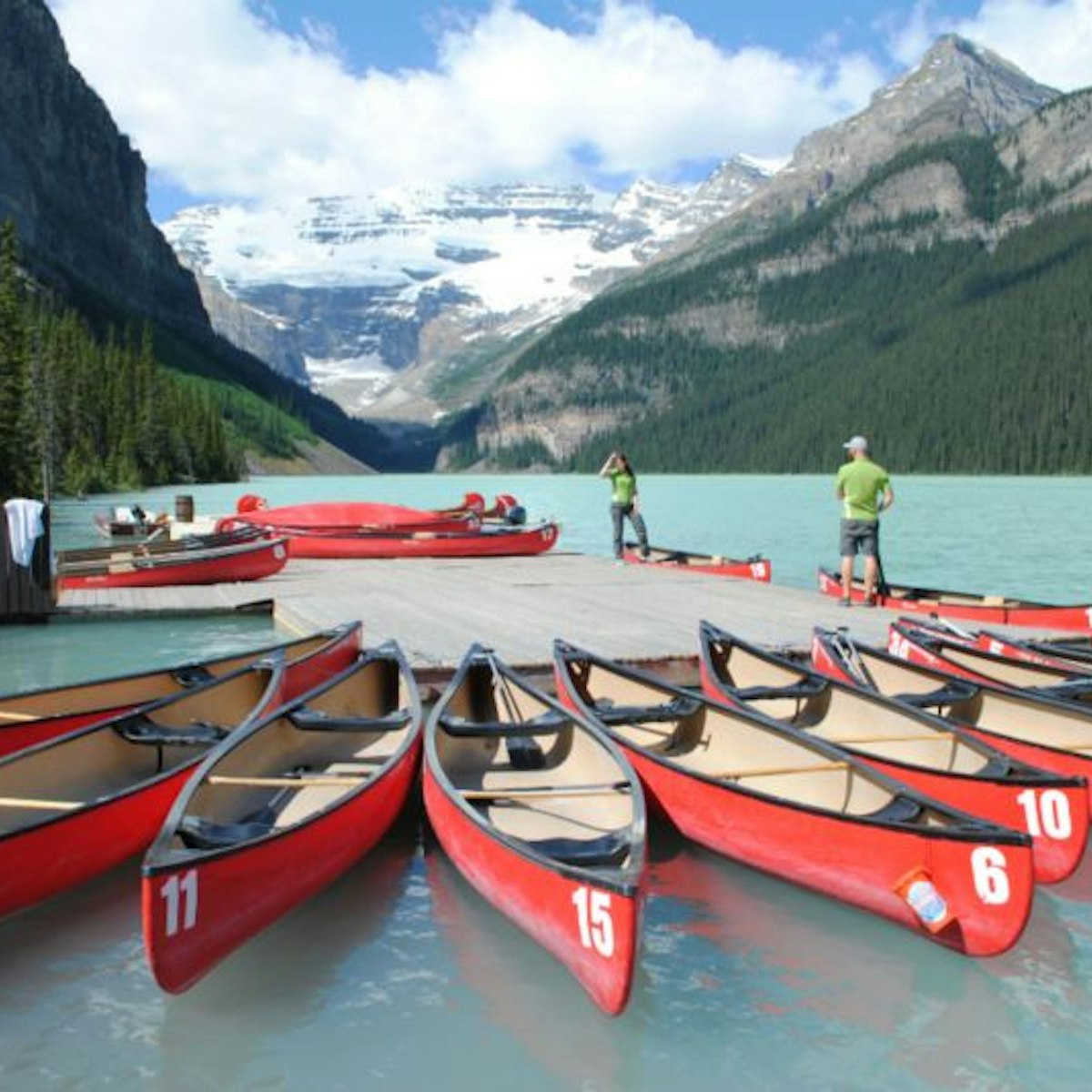
Lake Louise
Considered by many to be the crown jewel of Banff National Park, Lake Louise is nearly impossible to describe without resorting to clichés. This…
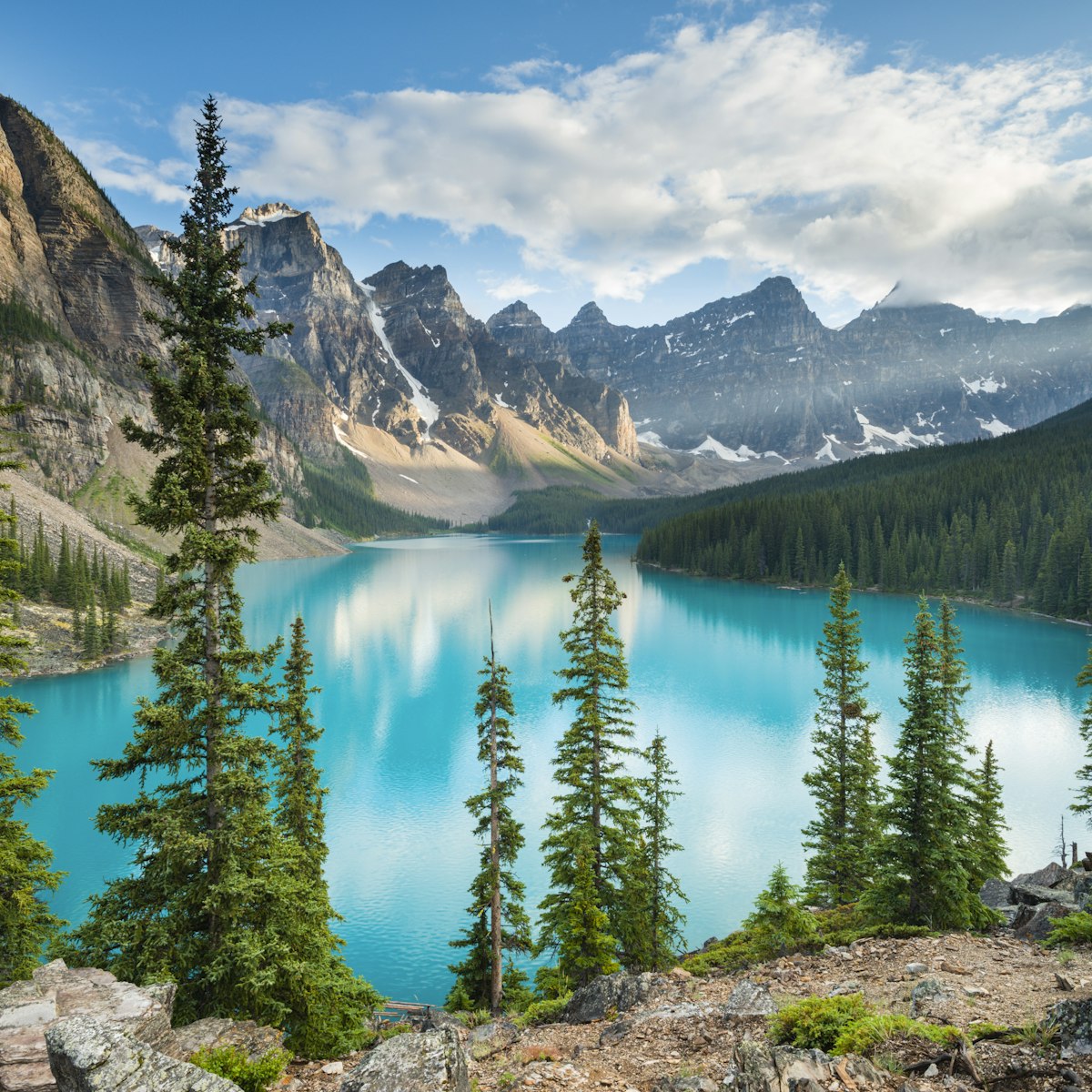
Moraine Lake
The spectacular, deep teal waters of Moraine Lake are one of Banff National Park’s most iconic sights. The lake’s rugged and remote setting…

Encompassing 11,228 sq km of Rocky Mountains wilderness, including jagged peaks, vast forests, glacial lakes and the magnificent Columbia Icefield, Jasper…
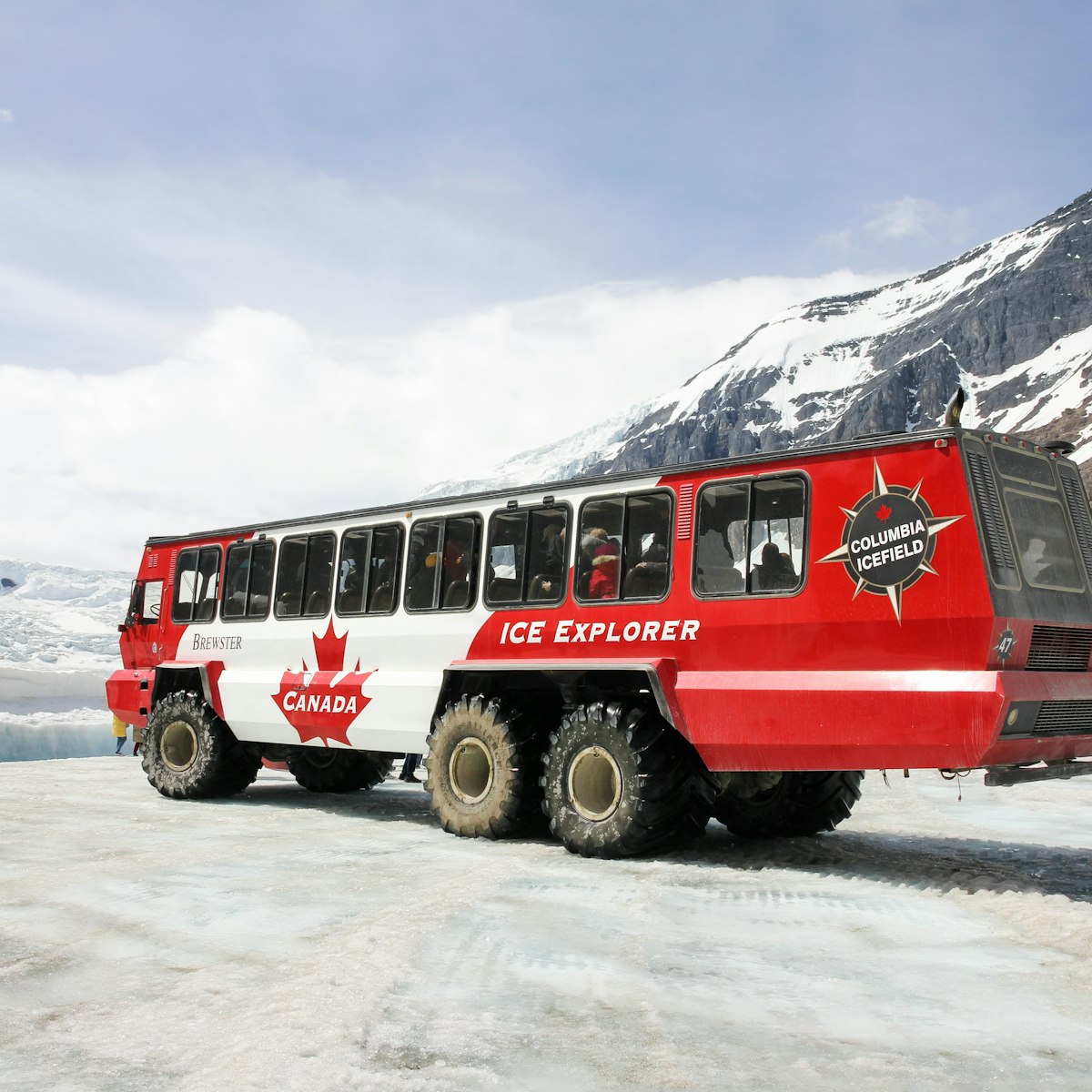
Athabasca Glacier
The tongue of the Athabasca Glacier runs from the Columbia Icefield to within walking distance of the road opposite the Icefield Centre. It can be visited…
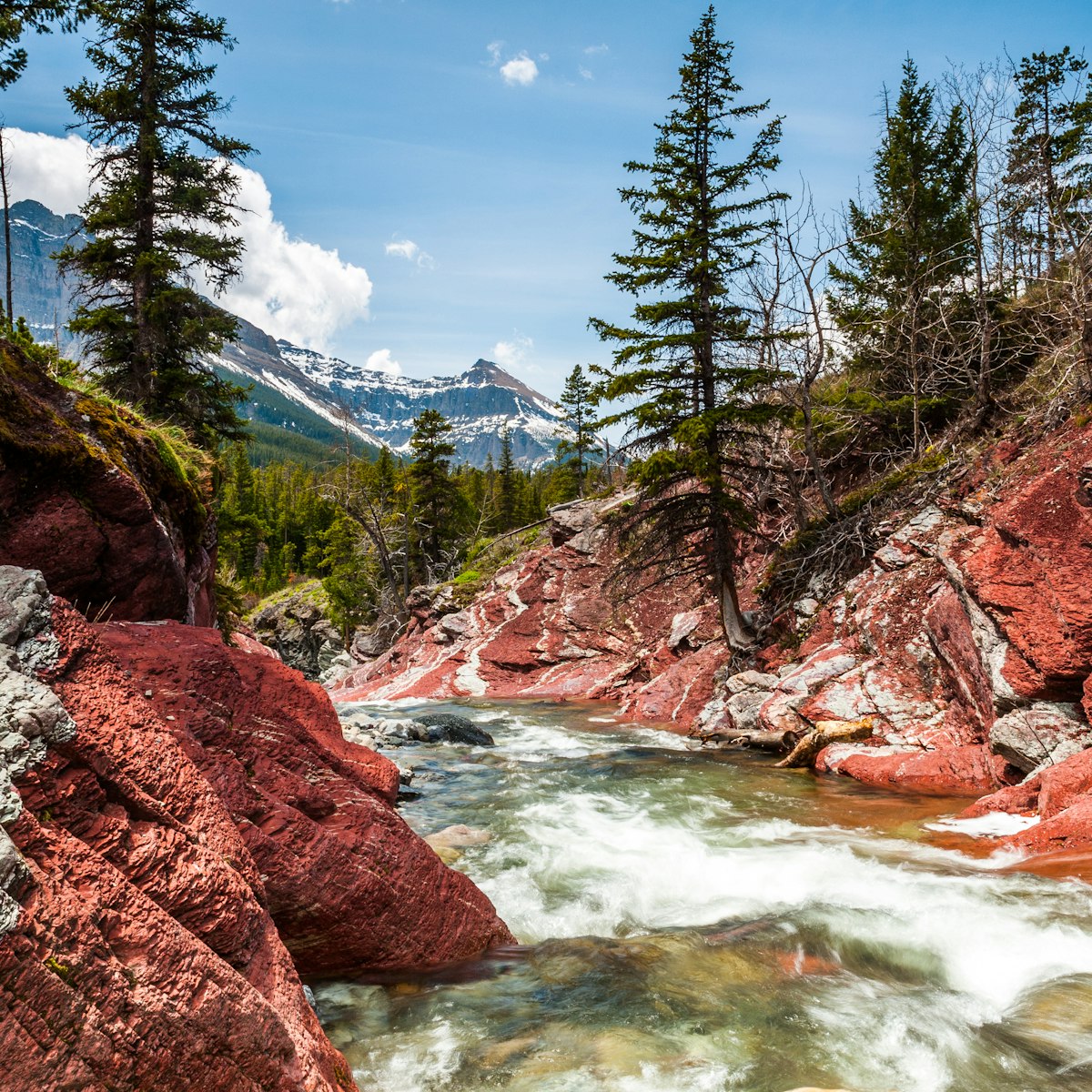
Waterton Lakes National Park
Southern Alberta
Here flat prairies collide dramatically with the Rockies, with a sparkling lake and a hilltop castle that may make you wonder if you've fallen into a…
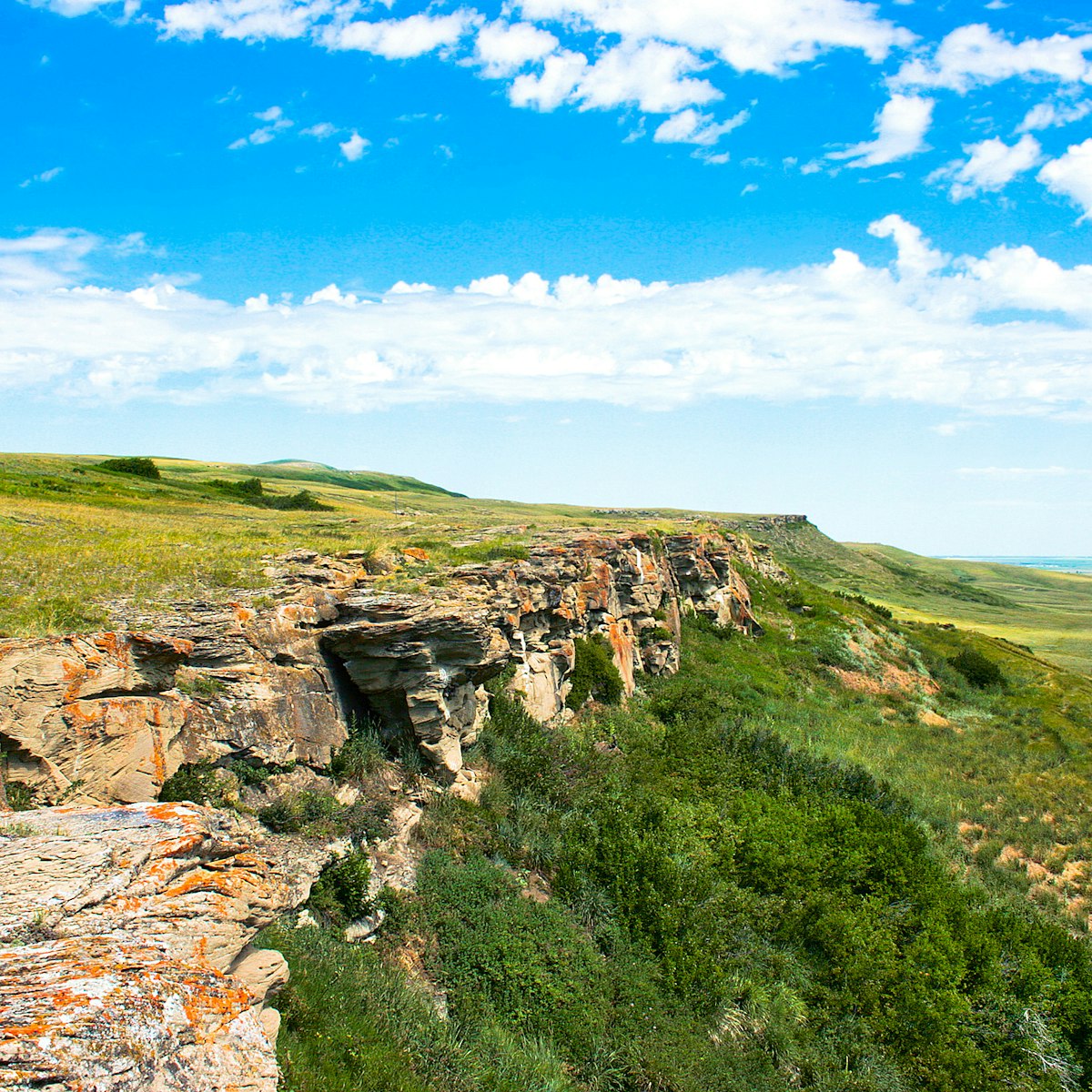
Head-Smashed-In Buffalo Jump
The story behind this Unesco World Heritage site with the strangest name of any attraction in Alberta is one of ingenuity and resourcefulness – and is key…
Plan with a local
Experience the real Canada
Let a local expert craft your dream trip.
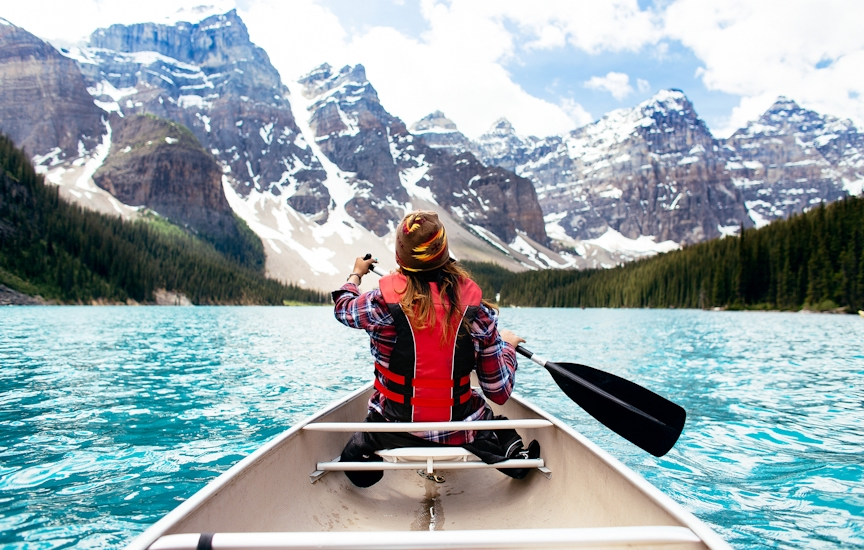
Latest stories from Alberta
Filter by interest:
- All Interests
- Adventure Travel
- Art & Culture
- Beaches, Coasts & Islands
- Food & Drink

National Parks
Jul 13, 2022 • 5 min read
As the holidays roll around, Banff and Lake Louise become a wintry wonderland with plenty of frosty fun.
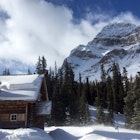
Jul 13, 2022 • 6 min read
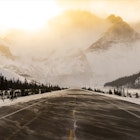
Nov 2, 2020 • 5 min read
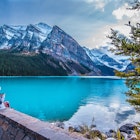
Oct 23, 2020 • 2 min read
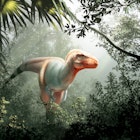
Feb 14, 2020 • 2 min read
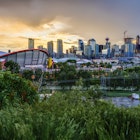
Jun 16, 2016 • 6 min read
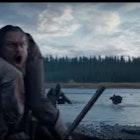
Jan 19, 2016 • 3 min read
Purchase our award-winning guidebooks
Get to the heart of Alberta with one of our in-depth, award-winning guidebooks, covering maps, itineraries, and expert guidance.
Alberta and beyond
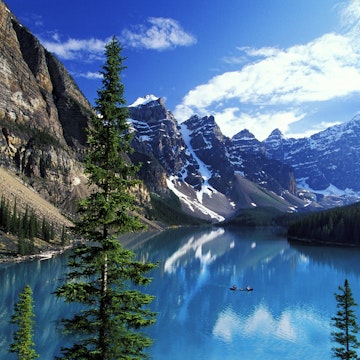

Endless Wonder
Your guide to travel and exploring the endless wonders of life
ALBERTA , CANADA , NORTH AMERICA , TRAVEL DESTINATIONS · October 7, 2021 updated on March 30, 2024
Travel Alberta: Your Guide & Everything You Need to Know
Alberta is one of the most beautiful places to visit in Canada. There is so much that it has to offer – the amazing rocky mountains of Banff, Jasper, and Waterton National Park, the rolling prairies, the dinosaur capital of the world and the badlands, the chance to see the Northern Lights, buffalo watching at Elk Island National Park, and SO MUCH more!! This is your guide to travel Alberta, and includes everything you have to see when traveling this amazing place!
I have lived in Alberta my entire life, and have spent my free time exploring this beautiful province! Every year I get to visit new places and re-visit some of my favourite spots here.
In this article, we will talk about everything that has to do with Alberta travel! Including the best time to visit and what it’s like in each season, as well as how to get around, where to stay and what to see, the National Parks in Alberta, and things to know before visiting.
Please know this website is reader supported and includes some affiliate links. I earn a small commission when you click on or purchase from affiliate links at no additional cost to you. Thank you for your support! !
Table of Contents
Best Time to Visit Alberta
Alberta is truly beautiful in each season, although there are pros and cons to visiting during each season as well! In Alberta, the summers can be incredibly hot, and with the increasing amount of wildfires each year, they can be smoky as well. Summer is also an incredible time to get outside and see all of the nature has to offer. Whereas winter can get incredibly cold and snowy! But winter can also be magical.

November – Late March: Winter
Winter is an amazing time to visit Alberta if you are interested in visiting frozen waterfalls, playing any winter sports ( ice skating on frozen lakes , snowboarding, skiing…), dog-sledding in the Rockies , snowshoeing, or hoping to see the mountains covered in snow.
During the winter the Northern Lights are also out a lot more, although they are still unpredictable during this time of year and require a bit of luck to see them on a short visit.
In Alberta, wintertime can also be freeeezing, so make sure you bundle up and come prepared with snow boots, jackets, toques, and mittens. The temperatures can fluctuate to around 0C, all the way down to feelinf like -40C.
Read more: The 12 Best Places to Ice Skate in Banff National Park

Late March – May: Spring
Spring is a beautiful time of the year to visit Alberta. The snow is melting and trees are starting to get their leaves back. Animals are waking up from a long winter and wildlife babies are starting to come out! It can get pretty slushy in the spring, but because of the melting snow, the waterfalls are at their best.
The crowds are also just starting to pick up in the Canadian Rockies, but it still isn’t as busy as the peak summer season.
The temperature in Alberta during Spring typically ranges from +2C to +20C (the weather can be wild!). Sometimes if winter is hanging around longer the temperatures can still be below 0C, but typically the weather averages around +10C.

June – September: Summer
Summer is another amazing time to visit Alberta. It is actually warm out, which makes it perfect for getting outside and enjoying the stunning nature in the province.
Summertime in Alberta is great for seeing the wildflowers while on hikes, camping, swimming in glacial lakes, and just enjoying Alberta while it’s nice out.
There is the risk of wildfires during the summer season, so sometimes the air can get very smoky around the province. Unfortunately, this can make it hard to get outside when the air quality isn’t great.
As summer continues on, the lakes of the Rockies turn bluer and bluer in colour.
Temperatures in the summer can get up to around 35C in Alberta!

September – Late October: Fall
If you’re after the golden larch trees in the Rockies, you’ll want to visit Alberta in the fall time.
Yellow trees are so so sooo pretty to see all over the province as everything starts to turn golden, but the larch trees do it best (in my opinion). Larches are a type of tree that look like pine trees, but they are actually deciduous, so their needles turn yellow and fall during autumn. They grow mainly at high elevations in the Rockies, so if you’re wanting to see the larches in the fall, you’ll have to either hike up to see them or take one of the gondolas!
The fall is the perfect time to visit for fall hikes, or for autumn festivals around the province. It starts to get chilly in the fall though and there is a risk of snow, so come prepared!!
Read more: This is the Perfect Fall Hike to do in Banff National Park

How to Get Around Alberta
Alberta isn’t the most “public transit friendly” place, just because it is quite big and takes a long time to drive from place to place, everything is pretty spread out. But really, it depends where you are.
Places like Edmonton, Calgary, and even Banff are very easy to get around using public transportation such as busses.
Other places, like Jasper, do not have public transportation options.
If you’re looking to travel far distances, I would highly recommend renting a car to drive yourself.
Or, check out Sundog Transportation . They have a couple of buses and charters to connect cities together (including a connection to Jasper National Park).
In the bigger cities (Edmonton & Calgary) uber is a very popular service to use as well.
Because of the lack of public transportation, Alberta can be a hard place to backpack around.
Read more: Visiting the Canadian Rockies Without a Car

Where to Stay
You can find accommodation to match your budget no matter where you’re heading in Alberta. Prices do vary depending on where you are planning to go, though.
Staying in Edmonton
Edmonton is the capital city of Alberta and is the closest city with an airport to Jasper National Park (small towns that are close to Jasper are Edson and Hinton). If you’re looking to stay in Edmonton and explore for a day or two, I would recommend checking out these places –
- Metterra Hotel
- Fantasyland Hotel (inside West Edmonton Mall)
- Air BNBs are also a great option in Edmonton
I would recommend booking a hotel nearby what you want to do and see while in Edmonton, because things can be spread out, and some areas of the city don’t really have a lot to offer!
Staying in Calgary
Calgary has the biggest airport in Alberta and is only an hour drive from Banff, which makes it one of the most popular cities to stop at when heading to the mountains.
- Sheraton Suites Calgary Eau Claire
- Westin Hotel
- Air BNBs are great all over Alberta!
If you are spending time in Calgary, I would recommend finding a hotel nearby what you are planning to do and see! If you are just staying overnight between flights and then driving to the Rockies the next day, it may be better to find an airport hotel and grab your car rental directly from the airport.

Staying in Canmore
Canmore is a cute little mountain town that is super close to Banff, but it isn’t as expensive to stay in (usually). It’s a great place to look into if you’re planning to visit Banff National Park .
Hostels are a great option in the mountains too (if you’re a hostel person), as they are all over the national parks!
- MTN House by Basecamp
- Mountain View Inn (not as modern, but can be a more affordable option)
- Canmore Downtown Hostel

Staying in Banff
Banff is the place everyone wants to visit when they are traveling Alberta. For this reason, Banff can usually get pretty pricey to stay in! (I usually stay in Canmore or camp during the summer, to save some money).
- Moose Hotel & Suites
- Fairmont Chateau Lake Louise
- Banff International Hostel
Staying in Jasper
Jasper is not as popular as Banff is in the Rockies, but it is becoming more and more popular throughout the years. Either way, it is an awesome place to visit in Alberta, and I would recommend checking out these places if you’re looking to stay in Jasper –
- Forest Park Hotel
- Pyramid Lake Lodge
- Jasper Downtown Hostel
- Fairmont Jasper Park Lodge

Things to Know About Traveling Alberta
- Weather can change at any moment, come prepared with a jacket no matter the season!
- Wildlife is everywhere (even in the prairies). If you’re driving on highways or in National Parks, always watch for deer and moose that can jump out of nowhere
- You will need a Canada National Park Pass if you are stopping in a National Park (you can get them at the entrance to National Parks)
- If you are visiting Kananaskis Country, you will need a separate, Kananaskis Conservation Pass to park there
- Distances between places of interest can be quite far, so make sure you google map distances of places you’re hoping to visit, and factor in the time it takes to get there
- There is more to Alberta than just Banff and Jasper National Park! Although the Canadian Rockies are absolutely amazing!

National Parks in Alberta
Alberta is home to 5 National Parks, and they are all worth a visit if you are traveling Alberta for a while! If you have a vehicle and are stopping in one of these parks, you will need a proper Canadian National Parks pass.
Waterton National Park
Located in Southern Alberta, right by the border to Montana in the United States, Waterton National Park is an incredibly beautiful place to visit! In Waterton, there are mountains, they are just a little bit different than the mountains you see in the Rockies.
Waterton is also home to a bunch of amazing hikes, including the Crypt Lake hike – which National Geographic named one of the most thrilling hikes in the world!

Banff National Park
Of course, everyone knows Banff National Park. And just in case you don’t, you need to! Banff National Park is one of the best places you can add to your itinerary. It is the main spot to visit in the Rocky Mountains, with the cutest little mountain town, Banff, as the main and really only city in the National Park.
Here you will also find infamous Lake Louise , Moraine Lake , and so many incredible outdoor adventures like hiking to the Lake Agnes Teahouse , swimming in Banff’s glacial lakes , one of the world’s most beautiful drives (the Icefields Parkway) , and more!

Jasper National Park
Often overshadowed by Banff is Jasper National Park. Another mountain town in the Canadian Rockies that is just North of Banff! There is so much to do in Jasper National Park , including incredible hikes, outdoor adventures like canoeing to Spirit Island , and exploring Maligne Canyon (in the winter, you can explore the interior by doing a Maligne Canyon ice walk !),
Wood Buffalo National Park
This is the one National Park in Alberta that I have yet to visit! It is located in Northern Alberta is quite a distance from any major airport here.
Nontheless, Wood Buffalo National Park seems like the perfect place for an outdoor adventure. It is the largest national park in Canada and the world’s largest Dark Sky Preserve, meaning they limit the amount of light pollution allowed here, making it the perfect spot to stargaze and see the Northern Lights.
You can also camp here, hike, and keep your eyes peeled for herds of bison!
Elk Island National Park
Around a 30 minute drive from the city of Edmonton is Elk Island National Park!
This is a great place to get out in nature, go on a walk through pretty forests, and try to see bison! They roam free around Elk Island National Park, although you always don’t get a chance to see them (since they roam wherever they want to!).
In the winter time, Astotin Lake freezes and there is a path cleared for ice skating. You can also sign up for Snowshoe and Stargaze with Parks Canada during the winter time.
In the summer you can swim, although the lake usually gets overrun by blue-green algae, and when this happens, swimming isn’t really advisable!
But, it is a great place to spend the day out in nature on a daytrip from Edmonton!
Top 5 Things to do in Alberta

1. Explore the mountains –
The Canadian Rocky Mountains are the main thing that bring so many visitors to Alberta each year! They are absolutely stunning and cannot be missed during your trip to Alberta!

Banff, Alberta is full of amazing things to do. During Alberta’s winter, you can go wild ice skating , dog sledding, skiing, and snowboarding in Banff. In the fall you can hike and be surrounded by amazing golden alpine larches . In the summertime, you can hike around popular places like Lake Louise (with a teahouse in the mountains), swim in glacial lakes, or head out on a canoe tour. Springtime in Banff gives visitors incredible opportunities to beat the crowds (especially to Moraine Lake) , and see waterfalls at their peak as the snow melts.
Read more: Your 4 Day Banff Itinerary

Jasper National Park is another incredible place to visit in Alberta. Surrounded by mountains (just like Banff), there are so many amazing things to do in this National Park. One of my favourite adventures is renting a canoe to visit iconic Spirit Island , or taking the Jasper Sky Tram up the mountain to get amazing views of the surrounding mountains. Jasper is also home to so many amazing hikes, you could spend a lifetime exploring the nature here.
Read more: Your Jasper National Park Bucket List: 25 Things to See & Do

Icefields Parkway
The Icefields Parkway is another incredible stop to make on a trip across Alberta. This is the road that connects the town of Banff to the town of Jasper and is rated as one of the most beautiful drives in the world. You’ll have to budget quite a bit of time to drive this road because you’ll want to stop every 5 minutes to look at the amazing viewpoints and lakes along the way.
Read more: Where to Stop Along the Icefields Parkway
Read more: How to see the Frozen Methane Bubbles of Abraham Lake
Hike, swim, and camp at Waterton National Park. It is located at the very southern end of Alberta and is an awesome (and a little lesser known) place to visit. Waterton National Park is basically the Canadian side of Glacier National Park in Montana, which makes it the perfect place to hike if you’re trying to stay in Alberta.

Kananaskis Provincial Park
Kananaskis Provincial Park is located just outside of Banff and is a hikers dream. There are soo many amazing places to hike and camp here, it is worth a stop on any Alberta itinerary. One of my favourite spots in Kananaskis is the Blackshale Suspension Bridge , which isn’t too bad of a hike to visit! (and it is also free).
Tip: If you’re stopping in Kananaskis, you will need to purchase a Kananaskis Conservation Pass.
Read more: Hiking Chester Lake in Kananaskis, Alberta
Read more: The Ptarmigan Cirque Hike in Kananaskis Country
2. See the Bison
If you’re looking to see Alberta’s bison, the two best places to see them are at Elk Island National Park (about 35 minutes out of Edmonton) or up North at Wood Buffalo National Park .
Bison are an important part of Alberta’s past. If you do end up exploring Southern Alberta, I would highly recommend checking out Head Smashed in Buffalo Jump while there. It is a great way to learn about the Indigenous connection with the bison, and Alberta’s bison history!

3. Explore Alberta’s Cities
There are quite a few cities and towns in Alberta, but the two main ones are Edmonton and Calgary!
If you’re visiting one of these cities and there is a hockey game happening, they can be so fun attend! The fans in Alberta can go crazy for hockey!
The City of Edmonton is Alberta’s capital and is one of two cities with a major airport. Edmonton is a cool place to explore if you have the time, although I honestly wouldn’t go out of my way to visit!
Some popular spots to check out include the Muttart Conservatory, University of Alberta Botanical Gardens , Fort Edmonton Park , and the river valley.
If visiting in the summer, there are a ton of festivals in Edmonton, such as K-Days, The Fringe, Taste of Edmonton, and Heritage Days.
You can also take a day trip to Elk Island National Park from Edmonton!
Calgary is the city that most people will fly into when visiting Alberta, and is a good base to explore from!
The City of Calgary is only an hour drive from Banff, an hour and a half to Drumheller (Alberta’s badlands), and just under 3 hours to Waterton National Park.
If you’re spending some time in Calgary, I would recommend checking out Prince’s Island Park, the Calgary Zoo , or go to the top of the Calgary Tower .

4. See the Badlands in Dinosaur Country
Drumheller is a town located in the heart of dinosaur country and is a pretty close drive from Calgary. Here you’ll find landscapes of the badlands, the world’s largest dinosaur, and the chance to discover fossils.
Another provincial park nearby Calgary where you can see the badlands is Dinosaur Provincial Park. You can camp at both of these spots and it is a really cool landscape to see!
Drumheller also has a super cool dinosaur museum called the Royal Tyrell Museum. It is one of the world’s largest places where you can see dinosaur fossils, and is an awesome spot to explore whether you are an adult or a kid!
Read more: The Top Things to see in Drumheller, Alberta
5. Hunt for the Northern Lights
There are dark sky preserves (places with little to no light pollution) in Alberta which are perfect for seeing the Aurora. Popular ones include Jasper National Park and Elk Island National Park, but if you can get out of the city you have a high chance of seeing the lights (if they’re out that night). Fort McMurray and up North(like Wood Buffalo National Park) are also great places to go Northern Lights hunting.
Tip: Check out Aurorawatch for the Northern Lights forecast
Other Areas in Alberta to Mention:
There is SO much to see and do in Alberta, it cannot possibly fit in one blog post!
A few other spots you might be interested in exploring are:
- Big Knife Provincial Park
- Medicine Hat and Southern Alberta
- Frank Slide
- Rochon Sands Provincial Park
Alberta Travel Guide Summary
Alberta is truly a beautiful place to visit in Canada, with so much to offer (especially if you love to be outside!). From the Canadian Rockies to Southern Alberta and the badlands, there is so much to see and do here.
I feel lucky to live in a place that has so many interesting spots to explore! Each season is super unique, with different activities and things to do in each month.
Getting around can be difficult if you don’t have a car – so I highly recommend renting one when visiting Alberta! Or, sign up for a tour or book seats on shuttle busses if you can.
Accommodation prices can really vary all over the province, but the earlier you look the more likely you are to find something in your price range! And if you’re visiting Banff, look into staying just outside of the National Park in Canmore instead.
Always be prepared for changing weather because it can be hard to predict, especially in the mountains!
And don’t forget to budget in the cost of a Canadian National Parks Pass if you’re planning to head to one of Alberta’s 5 national parks.
Hopefully, this guide helps you travel Alberta! Please let me know if you have any questions about your Alberta trip (or travel in general!).
Other Resources to Help Plan Your Trip to Alberta
- TravelAlberta.com
- Parks Canada
- All Trails (for hiking)
Find me on: Instagram | Pinterest

Hey! I’m Kat. Based in Alberta, Canada I love to travel to the Rockies and explore new places around the world. Follow along on my adventures and find inspiration and tips for your own travels.
Share this post!
You’ll also love.

Leave a Reply Cancel reply
Your email address will not be published. Required fields are marked *
Save my name, email, and website in this browser for the next time I comment.
This site uses Akismet to reduce spam. Learn how your comment data is processed .

Healy Pass Hike in Banff National Park During Fall
Trending now.
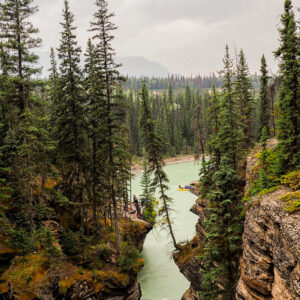
Join the List!
Subscribe to receive access to printable freebies, checklists, itineraries and more!
I'm Kat. Based in Alberta, I'm currently exploring and documenting my adventures in Alberta's Rocky Mountains. I'm also taking smaller international travel every now and then when I get the chance! Thanks so much for stopping by!
- TERMS OF SERVICE
- PRIVACY POLICY
- WORK WITH ME
Destinations
- NORTH AMERICA
- SOUTH AMERICA
Travel Canada
- BRITISH COLUMBIA
Latest on Instagram

Copyright © 2024 Endless Wonder · Theme by 17th Avenue
Privacy Overview

- Destinations
Alberta Travel Guide
National Geographic’s latest travel stories about Alberta
- Terms of Use
- Privacy Policy
- Your US State Privacy Rights
- Children's Online Privacy Policy
- Interest-Based Ads
- About Nielsen Measurement
- Do Not Sell or Share My Personal Information
- Nat Geo Home
- Attend a Live Event
- Book a Trip
- Inspire Your Kids
- Shop Nat Geo
- Visit the D.C. Museum
- Learn About Our Impact
- Support Our Mission
- Advertise With Us
- Customer Service
- Renew Subscription
- Manage Your Subscription
- Work at Nat Geo
- Sign Up for Our Newsletters
- Contribute to Protect the Planet
Copyright © 1996-2015 National Geographic Society Copyright © 2015-2024 National Geographic Partners, LLC. All rights reserved
- 3 Other destinations
- 4.1 History
- 4.2 Climate
- 4.5 Tourist information
- 6.1 By plane
- 6.2 By train
- 6.5 By thumb
- 6.6 By bicycle
- 8.1.1 On the way to Alaska
- 8.1.2 Circle tour
- 8.1.3 Icefields Parkway
- 8.1.4 Big stuff tour
- 8.2 Indigenous tourism
- 9.1 Outdoor life
- 12 Drink (and smoke)
- 14 Stay safe
Alberta spans great, contrasting sceneries of mountains, forests and prairies. It offers the visitor six UNESCO World Heritage sites , preserving mountain vistas ( Banff and Jasper National Parks ), the world's largest inland delta and largest protected boreal forest ( Wood Buffalo National Park ), one of the world's great dinosaur fossil beds ( Dinosaur Provincial Park ), historic Indigenous rock art ( Writing-on-Stone Provincial Park ), and ancient buffalo hunting sites ( Head Smashed In Buffalo Jump ). And for sports fans, this is the home one of the world's greatest rodeos every July in Calgary, two famous professional ice hockey teams, and one of the longest ski seasons in the northern hemisphere. Like colder versions of other oil towns ( Houston comes to mind), the burgeoning cities of Edmonton and Calgary are adding new skyscrapers, museums, art galleries, concert venues, and libraries as these cities are still very much in their youth.

Alberta, Canada 's fourth largest province by size and population, stretches from British Columbia at the Rocky Mountains in the west, to Saskatchewan in the east and from the Northwest Territories in the north, to Montana , U.S.A. in the south.
Alberta is a huge province, about three times the size of the United Kingdom (from where many of its people can trace a heritage) or nearly as large as Texas (with which is shares a historic connection though the cattle and petroleum industries). In this huge expanse of territory, only four and half million Albertans reside, and about half of those live in just the two main cities of Calgary and Edmonton , with most of the rest of population clustered near the main highways. The rest of the province has a tiny population, but is far from empty: on this land you will find Indigenous cultures that have survived here for thousands of years, rural settlements with a proud pioneering history, and new immigrants arriving daily from all corners of the world in one of the developed world's wealthiest and fastest-growing regions.
Alberta is not well known by non-Canadians, but if you do know much about it you might associate the province with the Rocky Mountains (which in truth are only found along Alberta's western boundary), perhaps the 1988 Winter Olympics which were held in Calgary, the cowboy country of Southern Alberta , or the controversial "oil sands"/"tar sands" of Fort McMurray .
In a province as large and dynamic as Alberta, there shouldn't be any problem finding enough to see and do, no matter what your travel style is.
Regions [ edit ]

Cities [ edit ]

Below are 8 cities frequently considered to have the most interest for the visitor.
- 53.533333 -113.5 1 Edmonton - the capital city of Alberta and the second largest urban population (1,010,899 city; 1,418,118 metro region). Known for the largest urban parks system in North America, North America's largest indoor shopping mall, and is self-proclaimed as "Canada's Festival City". Also home to Western Canada's largest indoor museum (since 2018), a huge outdoor museum, the provincial art gallery, a science centre, and an iconic pyramid-shaped plant conservatory.
- 51.05 -114.066667 2 Calgary - Alberta's largest city (1,306,784 city; 1,481,806 metro region). It is home to a beautiful river, nice museum, high-rise architecture, a world class zoo, and shopping. Famous for the 1988 Winter Olympics and the annual Calgary Stampede.
- 51.1781 -115.572 3 Banff - vacation destination in the Rockies offering a variety of outdoor activities. By far the busiest resort town in Alberta and one of the most popular in all of North America.
- 51.463611 -112.719444 4 Drumheller - the dinosaur-lover's mecca, site of the Royal Tyrell Museum, the largest paleontology museum in Canada, set in the desert-like "badlands" landscape.
- 52.8731 -118.082 5 Jasper - Banff's northerly neighbour - less visited than Banff but no less stunning.
- 49.694167 -112.832778 6 Lethbridge - a city in southern Alberta with a population of about 93,000 and most famous for "coulees" (canyons) and proximity to four world heritage sites.
- 50.033333 -110.666667 7 Medicine Hat - is in southern Alberta with a population nearing 60,000. The main stop on the Trans-Canada Highway between Calgary and Regina , Saskatchewan and jumping-off point for the Cypress Hills .
- 52.268056 -113.811111 8 Red Deer - midway between Edmonton and Calgary and, with about 100,000 people, the third largest city in the province behind those two. The main centre for tourist services in Central Alberta.
Other destinations [ edit ]

- 52.356133 -116.313583 3 David Thompson Country - a series of parks, campgrounds, and rustic lodges, along Highway 11 between Red Deer and the Rocky Mountains.
- 52.8 -117.9 4 Jasper National Park - beautiful mountain and shopping attractions without the hustle of Banff
- 53.949847 -112.162376 5 Kalyna Country - Alberta's Ukrainian ethnic enclave in Edmonton's eastern hinterland
- 50.9 -114.9 6 Kananaskis Country - major natural recreation area in southern Alberta at the foot of the Rockies south of Calgary
- 49.05 -113.933333 7 Waterton Lakes National Park - a true natural gem in the Rockies in Alberta's extreme southwest
- 59.3833 -112.983 8 Wood Buffalo National Park - the largest national park in Canada home to the world's largest freshwater delta and free-ranging wood bison ("buffalo")
Understand [ edit ]
The province of Alberta inherited its name from one of the old districts of the North West Territories, which was named after an English princess, Louis Caroline Alberta, Duchess of Argyll (1848 – 1939), the sixth child and fourth daughter of Queen Victoria and Prince Albert.
Since Alberta gained self-government as a province in 1905, its capital has been Edmonton , which is roughly in the middle of the province, while the main centre in terms of corporate headquarters is Calgary to the south. Most of the population of Alberta lives along the " Highway 2 Corridor " between Edmonton and Calgary, although Lethbridge to the south, Grande Prairie to the northwest, and Fort McMurray to the northeast are also notable settlements of 50,000 or more.
Alberta is by far the richest province in Canada in terms of average salary. Its wealth is derived mainly from oil and gas production, though historically farming and cattle raising were important. Ranching maintains an important place in the economy and culture, particularly in Southern Alberta and seventy percent of the Canadian cattle herd is in Alberta. Alberta is subject to repeated booms and busts tied to the price of oil (and gas): when the United States began producing more oil and gas through fracking in the 2010s Alberta's economy suffered for most of the next decade, with the next Albertan boom not starting until the onset of the Russian full scale invasion of Ukraine (2022-present) and the consequent spike in energy prices.
Alberta is widely considered to be the most conservative area of Canada, however this is relative: Alberta has universal medical insurance, a social safety net and well-funded public education in a way that would seem "left wing" to many Americans. Nevertheless, Alberta is definitely distinct from the other provinces and has historically had a tense relationship with the federal government in Ottawa, mostly over control of natural resources. These days Albertan conservatism tends to express itself as a pro-business, pro-corporate and pro-development attitude, and a suspicion of environmentalism, especially if its thought be to unfairly targeted against Alberta's petroleum industry by climate scientists and biased "outsiders" (usually other Canadians, but occasionally foreigners as well). This won't affect the average traveller, and many benefit as Alberta's taxes are lower than that of the rest of Canada (there is no provincial sales tax).
History [ edit ]
Deep in the interior of North America and cut off from the coasts by the Rockies to the west and the rugged Canadian Shield to the north and east, Alberta was one of the last parts of North America explored by Europeans, last to be effectively controlled by a colonial force, and the last agricultural region to be settled by non-Indigenous people. Yet this area experienced several dramatic turns in a few short decades, and went from being mostly wilderness in 1870 when it joined Canada (as a sort of colony) to a mostly agricultural but economically struggling full province by 1930, to the urbanized economic powerhouse of Canada by the 1970s, to major global investment hub and migration destination by the early 2000s, to global environmental pariah in the 2010s.
The original inhabitants were (and are) the various Indigenous people s, who belong to a number of different ethno-linguistic groups (usually called "First Nations" in Canada, not "tribes" as in the US), namely the Cree, Blackfoot, Sarcee, Stoney, Chipewyan, Beaver, and Slavey. These peoples were all nomadic hunters at the time of European contact, so travellers will not find any giant temples or monuments to see. There are however, "stone circles" (like smaller versions of Stonehenge) and rock art (painting and carvings) as well as archaeological remains of camps and hunting sites, including World Heritage sites at Writing-on-Stone Provincial Park and Head Smashed In Buffalo Jump .
European goods arrived, second-hand, in what would be Alberta long before the European themselves did and the local Indigenous people were able to take advantage of the horse, firearms, metal tools, and so on, to make their lives much easier. However, with this trade new diseases were introduced that repeatedly devastated local communities over several centuries, opening the way for European expansion. Alberta was never seriously contested by any other European power besides Britain, or more precisely the Hudson's Bay Company (HBC), a privately-owned British corporation that made money by selling animal furs in England. The HBC did have to fend off incursions from other trading companies, however, by building posts further inland, reaching Edmonton by 1795. At the same time Christian missionaries from various denominations were competing to convert the natives, often setting up missions within the walls of the trading posts. Trading posts are preserved or rebuilt at several places around the province, notably Dunvegan , Fort Edmonton Park , Fort George and Buckingham House , Fort Victoria , and Rocky Mountain House , with major missionary sites at the Mission Hill historic district of St. Albert , Fort Victoria, and Pigeon Lake .
The HBC recruited its traders mostly from French Canada and Scotland's Orkney Islands . These traders often had temporary "country marriages" with local Indigenous women while posted in Canada, and from these mixed marriages by the 1810s, a new population had emerged and moved into the void left by the decimation of the original groups: the "half-breeds", known in French (and nowadays, also in English) as the Métis. Métis history is notably present at St. Albert and the Métis Crossing historic site .
When the new country of Canada bought the HBC's claim to what later became Alberta in 1869, the tiny population (perhaps ten thousand) was mostly First Nations or Métis. In order to solidify Canada's claim on the region, the famous "mounties" (North-West Mounted Police) were sent to Alberta in 1874, establishing outposts at Fort Walsh , Cardston , Lethbridge , and Fort Macleod near the American border, and Fort Calgary and Fort Saskatchewan further north There are reconstructions of those forts preserved as open-air museums in Fort Macleod and Fort Saskatchewan and a museum on the former site of Fort Calgary. Although called "police", these were paramilitary forts responsible for negotiating treaties with Indigenous peoples, expelling American traders and hunters who had moved across the so-called "medicine line" (49th parallel), and generally asserting Canada's claim to the area. The site of the signing of Treaty #7 between Canada and the Blackfoot Confederacy in 1877 is commemorated at Blackfoot Crossing .
At this time, Indigenous people in central and southern Alberta were suffering from the near-extinction of the bison, once their primary food source, so they signed treaties in the hope of getting desperately needed emergency assistance from the Canadians. When this aid didn't always arrive when and where it was needed or without strings attached, some Cree people in Alberta decided to join a campaign of violent resistance against Canada started by a Métis community in nearby Saskatchewan. The result was the massacre of white settlers at Frog Lake in 1885, the only instance of such an attack in Alberta's history. Canada responded by sending in the military via the newly-completed Canadian Pacific Railway, crushing Indigenous resistance, hanging several warriors, confining whole communities to their small reserve lands, taking away the children to be educated in missionary schools and generally beginning a long and dark chapter of Indigenous disenfranchisement in Alberta.

At the same time the federal government offered incentives for settlers to come to Alberta, and hundreds of thousands of people arrived in Alberta between 1885 and the First World War, many from elsewhere in Canada, but also with significant ethnic pockets in various regions, such as Austro-Hungarian subjects (Ukrainians, Poles, Romanians, etc.) in Eastern Alberta , Scandinavians in Central Alberta , and American Mormons in Southern Alberta . With this new labour, the economy shifted to the mass export of unprocessed natural resources, notably beef, lumber, and, especially, wheat. Several living history and outdoor museums interpret this era of mass settlement in Alberta, the largest of which are Fort Edmonton Park , Heritage Park in Calgary , and the Ukrainian Cultural Heritage Village. For sites related to expansion of particular industries, try Leitch Collieries or Atlas Coal Mine for coal mining, the Reynolds Alberta Museum or Remington Carriage Museum for transportation and agriculture, or Bar U Ranch for cattle ranching.
Alberta received self-government as a province in 1905, with Edmonton as the capital and the Alberta Legislature Building was built soon thereafter in 1913 in the midst of a major land boom in that city. Most of the heritage buildings in the Old Strathcona neighbourhood in Edmonton date from this time.
The Great War was a tense time, with most of the British-descended majority enthusiastically backing the war effort and enlisting in the Canadian Expeditionary Force in huge numbers, while looking with suspicion upon those who did not join up, with many recently-arrived German and Austro-Hungarian subjects (most of whom were ethnic Ukrainians) placed on watch lists or even interned in camps. For the province's military story, see the Military Museums in Calgary and the Prince of Wales Armoury in Edmonton, and for the history of internment consult the two church-run Ukrainian museums in Edmonton or see the internment sites in person near Banff and Jasper .
As well there were tensions with the more urbanized parts of Central Canada, as Albertan farmers were profiting from high wartime prices. This prosperity ground to a halt when wheat prices collapsed in 1921, just as the rest of North America was enjoying the "roaring twenties". This reignited simmering political tensions and led to the election of a United Farmers party government committed to bold social and political experimentation: women's suffrage and farmer-owned cooperatives taking over grain exporting from private companies were the two boldest examples. Their efforts were all but destroyed by the Great Depression, however, and Alberta defaulted on its debts in 1935, just as the United Farmers were replaced by Social Credit party, radical in a very different way. Social Credit tried to abolish banking and replace it with government-provided loans and a universal basic income scheme, but the plans were blocked by the courts and the federal government. This might have led to further tensions, but the Second World War intervened, and all sides rallied to the colours. For more on the turbulent politics of the early 20th century visit the Alberta Legislature or Government House (the former lieutenant governor's mansion) in Edmonton.
The Second World War again resulted in a "suspect" ethnic group being put into camps, this time the Japanese, who were forced to work on sugar beet farms near Taber and built difficult mountain roads, such through the Yellowhead Pass near Jasper . Besides the thousands who enlisted to serve in the Canadian Armed Forces, Alberta's other major contribution to the Allied war effort was the pilot training schools and network of airfields in Alberta that helped relay aircraft across to Alaska and on to the Soviet Union. This story is told at the Alberta Aviation Museum . Edmonton also served as the staging area for construction of the famous Alaska Highway , swelling its population with American engineers and soldiers.
Although natural gas had already been found decades earlier in the province, the decisive date in Alberta's economic history is February 13, 1947 when a major crude oil deposit was found at the Leduc No. 1 oil well near Edmonton. Within a generation, small towns mushroomed into major cities with new institutions. Notable landmarks from the 1950s and 1960s era include the main university campuses in Calgary and Lethbridge , the twin Jubilee Auditoria (concert halls) in Edmonton and Calgary, and the Calgary Tower and Edmonton's CN Tower. As well, many of the low-density residential suburbs ringing all of Alberta's town and cities date from this time.
During oil price spikes of the 1970s and 2000s, Alberta became one of the world's richest regions, attracting investment and immigrants from all over the globe, and this is reflected in the many skyscrapers in Edmonton and Calgary dating from those decades (or, more often, slightly after the boom had ended). But during price falls (the 1980s and 2010s) everything went into reverse, with companies and people leaving; while many projects were finished during these times that had been started earlier, almost no new major buildings were conceived or begun during these economic busts. For example Edmonton's famous giant shopping mall was planned in the 1970s but built in the 80s, Calgary's main arena and Olympic park were planned during good times but opened just ahead of the 1988 Winter Olympics in the midst of a otherwise depressed economy, and Edmonton's new provincial art gallery, provincial museum, main arena, and main library, were all built in the 2010s but with money made during the 2000s. Likewise, the two tallest buildings in the province the Stantec Tower (66 stories, 250 m, 2019) in Edmonton and Brookfield Place East (56 stories, 247 m, 2017) in Calgary were both planned during a boom and finished during a bust. The booms and bust don't just produce new buildings, the also destroy old ones: there are very few pre-1947 buildings left in most of central Calgary or Edmonton because they were bulldozed in boom times to make room for something new, allowed to deteriorate during busts until they were un-salvageable, or just demolished to save money: famously Calgary's main central hospital was blown up in 1998 as a cost-cutting measure by a austerity-minded provincial government.
As cyclical as the main cities are, in resource-dependent towns like Fort McMurray or Grande Prairie , the changes from boom to bust are even more dramatic. These are problems that Albertans have been grappling with for decades now, but they have grown more complicated since the 2010s as Indigenous people have reasserted their political influence over land-use decisions (particularly the route of pipelines) and international environmental opinion has turned against the fossil fuel industry. In the 2020s Alberta will certainly be one of the hot spots in a global debate over the future of the energy industry.
Climate [ edit ]
All of Alberta has a continental climate and is in the rain shadow of the Rockies, meaning it's mostly dry and there are profound differences between the seasons. Within Alberta there is considerable variation from north to south.
Northern Alberta has a subarctic climate; outside of Siberia, northern Alberta has some of the most dramatic seasonal variations in the world, with winter averages nearly 40 degrees Celsius lower than summer averages. Snow that falls in November often doesn't melt until April. Summers are brief but warm and dry.
The central and southern parts of the province are slightly warmer and drier than the north. The far south is effected in winter by the "Chinook winds" from the Pacific that can raise the temperature 20 °C in a matter of hours, so snow often melts there even in otherwise cold months. Summers are warm and very dry, with almost no rain showers and most summer precipitation being brought only by thunderstorms.
Read [ edit ]
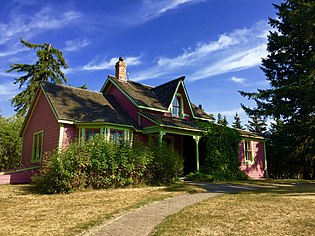
As Alberta is a land of Indigenous peoples and immigrants, it should not be surprising some of Alberta's greatest literature is not in the English language. One of the greatest poets of the Icelandic language , Stephan G. Stephansson (1853 – 1927), lived on a pioneer farm in Central Alberta. Some of his poetry references his time in Alberta and is available in translation.
Perhaps the two most famous modern novels set in Alberta are about the struggles of ethnic minorities in this often majoritarian province. Obisan (1981) is the definitive novel of the internment of Japanese Canadians during the Second World War and is considered a classic of Canadian literature. Green Grass, Running Water (1993) is a novel of magical realism that intertwines a modern-day reworking of an Indigenous Blackfoot creation story with ordinary events on the Blackfoot Indian Reserve in Southern Alberta.
Watch [ edit ]
There are many movies and television shows that have been filmed in Alberta, but not set here (usually Alberta is masquerading as the Western United States). To see some of Alberta's best scenery, you can watch major Hollywood releases like Unforgiven (1992), The Revenant (2015), Brokeback Mountain (2005), The Assassination of Jesse James by the Coward Robert Ford (2007), Inception (2010), and Legends of the Fall (1994), and the HBO Series The Last of Us (2023-). But if you want to see something actually set in Alberta, try the television series Heartland (2007-2020).
Tourist information [ edit ]
- Travel Alberta website
Talk [ edit ]
English is the main language spoken by most people in Alberta, and 98% of the population understands it to some degree. The main minority languages are French (6.7%), Tagalog (3.5%), and Spanish (2.6%), and although there are many other languages spoken by small communities within Alberta, you should only expect services at most businesses in English. The notable exceptions to this rule is that French is available at all federal government institutions (national parks, post offices, and Royal Canadian Mounted Police detachments), and services at provincial and municipal government offices are available in French in a few areas with significant Francophone communities. You might also find French services in the Campus Saint-Jean in Bonnie Doon neighbourhood , Edmonton .
First Nations languages such as Cree, Dené and Blackfoot are spoken to varying degrees among those communities as both mother tongue and as a second language, but travellers at First Nations art galleries or powwows (gatherings) will have no trouble being understood in English.
Get in [ edit ]
By plane [ edit ].
Calgary and Edmonton have international airports. Calgary's is the third largest in Canada (by passenger volume). It serves as the base of low-priced airline WestJet, which provides service to North American (mainly Canadian), Mexican and Caribbean destinations. Edmonton's was the fastest growing in Canada (before COVID) with multiple recent expansions, and had recovered to pre-pandemic levels as of early 2023. International service is provided by several carriers at both locations, including multiple direct flights to London and Frankfurt each day. Other destinations are usually connected to through Vancouver or Toronto. Both airports act as collection points, Calgary for the prairie provinces, and Edmonton for destinations in the Canadian North like Grande Prairie and Yellowknife .
By train [ edit ]

- The Canadian (between Toronto , Ontario and Vancouver , British Columbia ) two to three times per week. Stops in Alberta include Edmonton and Jasper . Other major stops include from Saskatoon , Saskatchewan and Winnipeg , Manitoba
- "The Skeena" (between Jasper and Prince Rupert , British Columbia ) Trip involves an overnight stay in Prince George , British Columbia. Operates twice per week.
There is no passenger rail service into Calgary, except for the exorbitantly-priced, slow and irregular Royal Canadian Pacific . The Rocky Mountaineer operates luxury sightseeing trains out of Vancouver to Jasper , Lake Louise and Banff , with an overnight stop in Kamloops , in the summer months. While much cheaper than the Royal Canadian Pacific, the Rocky Mountaineer still sports a hefty price tag. The route Jasper uses part of the same track as The Canadian, but only travels during daylight hours, thus maximizing the time you will get to enjoy the scenery. These run as nostalgia , not as practical transportation.
By bus [ edit ]
- Cold Shot , ☏ +1 587-557-7719 , [email protected] . Bus service from Monday to Friday between Fort St. John and Grande Prairie with stops in Dawson Creek , Hythe, and Beaverlodge. Also offers bus service between Grande Prairie and Edmonton . ( updated Feb 2021 )
- Between Vancouver and Calgary via cities including Kamloops and Banff .
- Between Regina and Edmonton via cities including Saskatoon and Lloydminster .
- Between Regina and Calgary via cities including Medicine Hat and Lethbridge .
- Mountain Man Mike's Bus Service , ☏ +1-778-382-7729 , [email protected] . Once per week bus service between Nakusp , Nelson , and Cranbrook in British Columbia , and Lethbridge and Calgary . ( updated Mar 2022 )
- Thompson Valley Charters , ☏ +1 877-769-3287 . In partnership with Ebus, operates twice per week service between Kamloops , British Columbia and Edmonton . ( updated Mar 2022 )
By car [ edit ]
There are land border crossing with the United States at (form west to east) Chief Mountain, Carway, Del Bonita, Coutts, Aden, and Wild Horse. The most important of which certainly Coutts, which connects Interstate 15 to Alberta Highway 4 onward to Lethbridge. Some of these may not operate 24 hours per day at all times of the year, so plan to cross the border during daylight hours or check the Canada Border Services Agency website for exact times.
To enter from British Columbia, there are a limited number highways (generally through mountain passes) that can be used, from north to south the most notable are where Highway 2 (in British Columbia) / Highway 43 (Alberta) crosses near Dawson Creek , Highway 16 ( Yellowhead Highway ) at Yellowhead Pass in Jasper National Park , Highway 1 ( Trans-Canada Highway ) at Kicking Horse Pass, Highway 93 crosses at Vermilion Pass, and Highway 3 (Crowsnest Highway) Crowsnest Pass .
From Saskatchewan, since there are no mountains in the way there are literally thousands of local roads connecting the two provinces but the main ones of interest to tourists would be (from north to south) the Highway 16 (Yellowhead Highway) connecting Saskatoon to Edmonton; Saskatchewan 14 where it meets Alberta 13 to connect either Saskatoon or Regina to Red Deer; Saskatchewan 7 where it meets Alberta 9 connecting Saskatoon to Calgary, Highway 1 (Trans-Canada Highway) to connect Regina to Medicine Hat, Lethbridge and Calgary.
From the Northwest Territories there is only one highway (NWT 1, Alberta 35), plus the option of using the infamous "ice roads" in the winter.
By thumb [ edit ]
Hitchhiking is illegal and rare in Alberta, so this is not recommended, but it is possible if you're willing to take your chances.
By bicycle [ edit ]
The vast distances make cycling across Western Canada all but impossible, the lack of dedicated infrastructure also makes it relatively dangerous, and the sparsity of things to see in the spaces between towns (outside of the Rockies) makes it quite boring. This should not stop you from cycling within certain parts of Alberta, which is a much more manageable project. But if you're extremely fit, have lots of time to spare and like a challenge, you can legally cycle on all of Alberta's highways or try the part of the Trans Canada Trail that crosses the province.
Get around [ edit ]
Alberta is quite large and sparsely populated, as are most Canadian provinces. For some comparisons with other parts of the Commonwealth , Alberta is twice as big as Rajasthan (the largest state in India) but with 1/16th of its population, or three-quarters the size of Nigeria , but with 1/50th of the population.
Albertan cities are infamous for their low-density "suburban sprawl" and are thus really big, area wise and difficult to walk without at least a little assistance from other modes of travel. Luckily both Edmonton and Calgary have bicycle paths, light rail transit (LRT) trains, extensive bus networks, taxi fleets, ride-hailing apps, and since 2019 rentable electric scooters. Outside of those two cities, however, options are more limited.
Car travel is almost essential unless you plan on staying within Edmonton or Calgary. It is certainly possible, though expensive, to fly to many of the smaller cities from Edmonton or Calgary, although those places are even more car-dependent so you would need to rent a car while there or be essentially stranded. An inter-city "bus" (coach) is much cheaper than a flight but will take up a lot of time given the distances involved and still leaves you without a car when you arrive in an isolated small town.

Driving regulations are the same as in most of Canada. Turning right (far right lane into far right lane) on a red light is allowed. Drunk driving is taken very seriously, but is disproportionately seen in rural areas; take care when driving there at night. Wildlife is another major concern. When driving on the highways, maintain a reasonable speed and look for sudden movements on the side. The most common animal hit is the deer (white-tailed or mule), which is usually not fatal for the car. But running into an elk or moose could be so. Moose are very dark coloured so keep a close eye out for them. If you see animals on the side of the road it is common to want to slow down. Do so in a safe manner and don't needlessly impede traffic. Don't get out of your car to see the animals.
The Government of Alberta operates 511 Alberta ,a free traveller information service that may be accessed via phone, mobile device, or computer. The information covers highway conditions, roadwork, major incidents, weather alerts, availability of ferry services, and waiting times at border crossings. Users within Alberta may access the information via phone toll-free by simply calling 5-1-1, similar to the way they would call 9-1-1 for emergencies or 4-1-1 for directory assistance. Computer and mobile device users may also visit the 511 Alberta web site at www.511.alberta.ca. Likewise the Alberta Motor Association (AMA) is another good source of specific information. Calgary and Edmonton offer traffic radio stations - government-funded radio that only reports accidents, construction and weather. Watch for signs featuring the frequency in these cities.
Do not heed any warning about Albertan drivers being the most aggressive drivers in Canada - a common myth. They are not more so than Toronto and certainly are nothing compared with Southern Europe. High speeds and lane changes without signalling are generally the worst it gets.
- Banff AIrporter , ☏ +1-403-762-3330 , toll-free: +1-888-449-2901 . Operates a route between Calgary and Banff . ( updated May 2022 )
- Brewster Express , toll-free: +1-866-606-6700 . Bus service throughout the year between Calgary and Lake Louise including stop in Banff . Limited summer service to Jasper . ( updated May 2022 )
- Cold Shot , ☏ +1 587-557-7719 , [email protected] . Operates bus services primarily in Alberta with some service reaching British Columbia . Most routes terminate in Edmonton . ( updated Feb 2021 )
- Ebus , toll-free: +1 877-769-3287 . Bus services connecting destinations in Alberta such as Calgary , Edmonton , Fort McMurray , and Red Deer . ( updated Mar 2022 )
- Mountain Man Mike's Bus Service , ☏ +1-778-382-7729 , [email protected] . Weekly service between Calgary and Kaslo , British Columbia with stops in several Alberta cities including Lethbridge . ( updated Mar 2022 )
- Red Arrow , toll-free: +1-800-232-1958 , [email protected] . Bus services connecting destinations in Alberta such as Calgary , Edmonton , Fort McMurray , Lethbridge , and Red Deer . ( updated Feb 2021 )
- SunDog Tours , ☏ +1-780-852-4056 , toll-free: +1-888-786-3641 , [email protected] . Operates daily service between Edmonton and Jasper . ( updated Sep 2021 )
- The Canada Bus , ☏ +1-403-668-9600 , [email protected] . Operates bus routes in Alberta , including to Banff , Calgary , and Edmonton . ( updated May 2022 )
See [ edit ]
Driving west out of Calgary towards British Columbia , the Rockies rise dramatically and quickly. The drive through Banff , Jasper or Glacier National Park can be quite spectacular. The Icefields Parkway between the towns of Banff and Jasper is definitely not to be missed.
In Edmonton , West Edmonton Mall is one of the province's larger attractions. With over 800 retail shops and the world's largest indoor entertainment centre, it's entertaining even for the non-shoppers. Edmonton calls itself "Canada's Festival City" so there are many things to do throughout the summer, most notably the world's second oldest and largest Fringe Theatre Festival (just behind Edinburgh ) in mid-August, the Edmonton Heritage Festival , the world's largest festival devoted to multiculturalism (first weekend of August), and a large midway and free-admission concert series in July called K-Days . The city also boasts North America's largest urban parkland system, which is very beautiful and completes the skyline over the North Saskatchewan River Valley .

Calgary offers the Calgary Stampede , the wild west-themed festival held every July complete with rodeos and fairs. One should also check out the Calgary Zoo and get a view from the top of the Calgary Tower .
Itineraries [ edit ]
It is easy for people from more densely populated and well-travelled Old World countries visiting Alberta (or Canada) to underestimate the vast distances involved, and the sparse availability of tourist-focused accommodations (as opposed to industry-focused), and other tourist services in the rural areas. Nevertheless, with proper research and planning, a pleasant trip is easily achievable.
On the way to Alaska [ edit ]
Many Americans pass through Alberta on their way to the famous Alaska Highway . There are numerous routes to take to get to the start of the highway at Dawson Creek near the B.C.-Alberta border. The exact route you choose will largely depend on where in the United States you are coming from. Most people with budget and time constraints pick their route first and decide what to see along the way later. If, however, you are interested in seeing the best of Alberta, even if it takes you off the most direct path, then consult the "circle tour" below, which can easily be modified into a through route by doing either the western (Rocky Mountain) or eastern (prairie) sections.

If, however, you are mostly concerned about "making time", the most direct route from Montana would be Alberta Highway 2 (also called the Queen Elizabeth II Highway or "QE2") from Interstate 15 to Edmonton, a short bit of Alberta Highway 16 (Yellowhead Highway), then Alberta Highway 43 to Grande Prairie, and a short bit of Highway 2 again to Dawson.
If time and money are no object, there is also the famous " scenic route to Alaska " (if you think the thousands of miles of wilderness you're about to pass through aren't long and scenic enough) which follows Alberta Highway 40 and which provides a beautiful but isolated route from the Rockies to Grand Prairie.
Circle tour [ edit ]
Assuming you were starting in Calgary, had a week or more to spend, and didn't mind a few longer drives, this would cover virtually every major attraction in the province . It could be done in either direction, or using Edmonton or Lethbridge as the starting or end points instead.

From Calgary International Airport, drive 80 km (1 hr) to find Diamond Valley (former twin towns of Black Diamond and Turner Valley) which hosts Alberta's early energy industry history at the Turner Valley Gas Plant historic site (seasonal May to September). From there learn about two different historic industries at Bar U Ranch National Historic Site (35 km, 30 min) to learn about cowboy culture, then 129 km (1½ hr) to Crowsnest Pass to see the coal mining history of the region at Frank Slide and Leitch Collieries historic sites and a restored police barracks at the Crowsnest Museum. Camp or rent a cabin in Crowsnest.
The next day, drive to the UNESCO World Heritage Site at Head Smashed In Buffalo Jump (140 km, 1½ hr) to learn about ancient Indigenous hunting practices and then continue to Waterton Lakes National Park (100 km, 1 hr) to see the Rockies up close and stay there a day or two to hike, or take the lake ferry into Montana (USA) and back.

On the next travel day, drive to Cardston (55 km, ¾ hr) to see the grain elevators, Mormon temple, and Remington-Alberta Carriage Museum, then on to Writing-on-Stone Provincial Park (155 km, 1½ hr) to see the petroglyphs (rock carvings). This is the southernmost point , where you could continue into Montana if you like. You can also camp here or drive to Lethbridge (130 km, 1½ hr) for your choice of hotels and see the Japanese gardens while you are there. An extension is possible here to Cypress Hills Interprovincial Park as well.
From Lethbridge, it's 200 km (2¼ hr) to Dinosaur Provincial Park where you can have a guided bus tour and walk in the "badlands" and see the dig site where many of Alberta's dinosaur fossils have been found, and another 170 km (1¾ hr) to the Royal Tyrell Museum in Drumheller where those same fossils are displayed in one of the world's greatest dinosaur exhibits. Camping and hotels are both available in "Drum" but plan ahead as it is very busy during high season.

The next day drive 30 km (½ hr) north to the ghost town of Rowley (Alberta) to sight-see (or nearby Big Valley to see the "creation museum") before continuing to Wetaskiwin (190 km, 2 hr), to see the Reynolds-Alberta Museum with its huge collection of automobiles, aircraft, and machinery. The following day, drive 110 km (1¼ hr) to Elk Island National Park to explore the Ukrainian Cultural Heritage Village outdoor museum explaining Alberta's Eastern European heritage (seasonal May to September) and see the famous bison (buffalo) herds, then camp here or drive to Edmonton for a hotel (35 km to the easternmost suburbs , 50 km to the City Centre ). While there, get lost in Canada's largest shopping mall and entertainment complex and see the art gallery, museum, and arena. This is the northernmost point on this itinerary, but only the centre of Alberta. Continue north from here if you are going to the Alaska Highway, for example.
Edmonton to Jasper is the longest stretch on this itinerary at nearly 4 hours, so consider stopping at Wabamun Lake or Pembina River Provincial Park for a picnic, or go in to Edson or Hinton for a restaurant meal, or shorten the trip and stay in a cabin or tipi (indigenous-style tent) in Brule . At Jasper, you are back in the Rockies with lots of hikes to do or a gondola to ride if you prefer.
From Jasper the world-famous Icefields Parkway (230 km, 3 hr) takes you to Lake Louise , reputed to be one of the most beautiful places on earth. If you can afford it, the Chateau Lake Louis hotel is one of Canada's most famous, otherwise proceed to Banff (55 km, 45 min) or Canmore (an additional 25 km, 20 min) for more reasonable accommodations but still in the beautiful setting of the Canadian Rocky Mountains. There are more hikes and drives from here and the town of Banff is also home to several historic sites and museums and lots of touristy shops. From here, you can make side trips to Kananaskis Country for more mountains or Cochrane to get back to cowboy country.
Finally from Canmore to Calgary's airport is 120 km, or 1 hr 15 min in good traffic.
Icefields Parkway [ edit ]
Considered one of the world's most scenic single-day drives, from Lake Louise to Jasper , you drive right past the edge of the Columbia Glacier, the largest glacier in northern hemisphere outside of the Arctic.
This can easily to turned into a circle tour (see above) by adding stops in Edmonton and Calgary. It can also be part of a route to Alaska by linking with Alberta Highway 40 (see above).
Big stuff tour [ edit ]

During the mid twentieth century there was a mania for building roadside attractions in Alberta, especially if it could be called the "world's largest". For example:
- 53.570591 -113.49266 1 World's biggest Baseball Bat – Edmonton ( North Edmonton )
- 52.672817 -112.225533 2 World's largest Baseball glove – Heisler
- 55.204088 -119.423168 3 World's biggest Beaver – Beaverlodge
- 55.734158 -117.201209 4 World's biggest Bee – Falher
- 53.588852 -110.52225 5 World's biggest Chuckwagon – Dewberry
- 51.467294 -112.708804 6 World's biggest Dinosaur – Drumheller
- 53.562733 -114.468017 7 World's biggest Dragonfly – Wabamun
- 49.869307 -111.370338 8 World's biggest Golf Putter – Bow Island
- 51.82035 -113.239433 9 World's largest Golf Tee – Trochu
- 53.878305 -112.332304 10 World's biggest Mallard Duck – Whitford Lake Bird Sanctuary ( Andrew )
- 54.117029 -111.918179 11 World's biggest Mushrooms – Vilna
- 52.585364 -112.573189 12 World's largest Oil Lamp – Donalda
- 54.252687 -111.154109 13 World's biggest Perogy – Glendon
- 49.637143 -114.504373 14 World's biggest Piggy Bank – Crowsnest Pass (Coleman)
- 53.491803 -112.036662 15 World's biggest Pysanka Easter Egg – Vegreville
- 56.247222 -118.600868 16 World's largest Railroad Spike – Hines Creek
- 53.595336 -112.336956 17 World's biggest Sausage – Mundare
- 52.697566 -110.149123 18 Susie the World's largest Softball – Chauvin
- 50.406068 -113.257415 19 World's biggest Star Trek Enterprise Replica – Vulcan
- 53.263824 -110.035466 20 World's biggest Sun dial – Lloydminster
- 50.015257 -110.691808 21 World's biggest Tipi – Medicine Hat
- 53.991033 -111.305444 22 World's first UFO landing pad – St. Paul
- 54.150283 -113.876417 23 World's largest Weather Vane – Westlock
- 53.539464 -113.608878 24 World's largest Western Boot – Edmonton ( West End )
For more, visit: Large Canadian Roadside Attractions
Indigenous tourism [ edit ]

The major year-round places to learn about Indigenous culture would be the Royal Alberta Museum in Central Edmonton , Fort Edmonton Park in West Edmonton , the Glenbown Museum in downtown Calgary, the Buffalo Nations Luxton Museum in Banff , Blackfoot Crossing on the Siksika reserve near Strathmore , Head Smashed In Buffalo Jump near Fort Macleod, Heritage Park in Calgary, Tsuut'ina Nation Culture/Museum just outside Calgary. Seasonal sites include Metis Crossing in Kalyna Country , Writing-on-Stone Provincial Park near Milk River , and the Majorville Cairn and Medicine Wheel near Bassano .
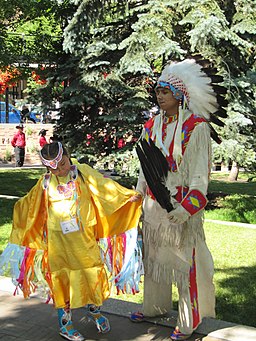
One of the best ways to see Indigenous culture up close is to take in a "powwow" (a festival centred around dancing, drumming, and singing competitions). Most "reserves" (as First Nations communities are often called) have at least one each summer; for a listing see Windspeaker . There are also two famous ones attached to the Calgary Stampede and Edmonton's "K-Days" fair in July. Several stand-alone powwows are also found in cities now as well, often around National Indigenous Day on June 20th. Events are also common around National Truth and Reconciliation Day in late September or during National Métis Week during the first week of November. Increasingly, Indigenous themes are integrated into other types of festivals, such as the arts, notably the Dreamspeakers International Film Festival in Edmonton the last week of April and the Rubaboo Arts Festival the following week.
Indigenous-inspired cuisine is surprisingly difficult to find in Alberta, partly due to (overly?) strict regulations on using wild-harvested meats and plants. Compared to the Nordic countries , there is comparatively little emphasis on using wild foods among Albertan chefs. It is possible to find farmed bison and elk meat but it is much more expensive than beef for a similar taste, which perhaps explains the lack of uptake. The one Indigenous food than every Albertan knows, "bannock" (fry bread or flat bread), is very recent in origin. To be sure, for thousands of years Indigenous people here made various kinds of flat bread from flours made of maize, nuts, roots, and so on. But the modern recipe of wheat flour, lard, and baking soda, is entirely based on goods introduced by Canadian fur traders in the last 250 years. Nevertheless, bannock is considered thoroughly nativized, and you will find it at every museum and powwow.
Shopping for Indigenous souvenirs typically means leather clothing, especially moccasins (slippers) and mittens, decorated with glass beads. Other handicrafts could include tobacco pipes, saddles, parkas (fur coats) and ribbon skirts. Nowadays, however, many Indigenous artists prefer to work in media like sculpture and painting and their work can be found more often at art galleries than at souvenir shops on the sides of highways.
Do [ edit ]
The main attraction in Alberta (outside of the two big cities) are the open spaces and the proximity to nature. This is a good place to visit if you like the idea of outdoor life .
Outdoor life [ edit ]

Horse riding is a major attraction here, especially in the south and west: cowboy country. Guest ranches and trail rides are plentiful.
The ski resorts of Marmot Basin in Jasper National Park, and Sunshine Village, Lake Louise and Norquay in Banff National Park dish up almost every kind of terrain for the hardcore skier, yet allow novice skiers to have fun through green runs and long cruising runs. If the crowds bother you, there are other, smaller, ski areas in the province.
Great hiking can be had in the Rockies or on Alberta's sections of the Trans Canada Trail .
There are a few lakes that allow one to do boating, "sea-dooing" (jetskiing) or most other watersports despite Alberta's landlocked nature.
There are many excellent golf courses available to the public across the provinces. Areas of particular interest include the mountain parks where Banff Springs, Jasper Park Lodge, Kananaskis Country, Stewart Creek, and Silver Tip are recognized as some of Canada's best courses. Central Alberta also offers several excellent courses, including Wolf Creek and Alberta Springs. In the Edmonton area, popular courses include the Northern Bear, Cougar Creek, The Ranch, and Goose Hummock. In Drumheller, the back nine of the Dinosaur Point Golf Course features several very dramatic and spectacular holes.
Offroad driving using "quad" bikes, trucks, dirtbikes, and even snowmobiles is practically the official sport in Alberta. If it is loud, fast, and spews noxious emissions, it can be bought or rented in Alberta.
Events [ edit ]
The biggest festivals in the province are the Calgary Stampede in July combining rodeo and carnival and Edmonton's Fringe Festival in August showcasing avant-garde theatre and street performers. However, hosting festivals has become the unofficial provincial obsession, especially in the short summer months, so expect local media and social media to have lots of suggestions every day from May to September and at least weekly the rest of the year. Notable genres of festival include modern folk music (Calgary, Edmonton, Canmore), film (Edmonton, Calgary, Banff), food trucks (Edmonton, Calgary), multi-ethnic food and dance (Edmonton, Calgary), rodeo (Calgary, Red Deer, Ponoka), as well as street festivals for each of the province's main ethnic communities, notably the Ukrainians (Edmonton, Calgary, Ukrainian Village museum, Vegreville, Lamont), Indigenous peoples (province-wide around summer solstice, as well as sporadically the rest of the year), and in Edmonton and Calgary: Caribbean carnivals, Latin American fiestas, Filipino street parties, and more.
Sports [ edit ]
Alberta is one of the world's heartlands of ice hockey . Two of world's top professional teams located here in Edmonton and Calgary playing from September to April, and if they qualify for the Stanley Cup playoffs, possibly as late as June. But if you'd just like an inexpensive taste of the game without overpriced beer, laser light shows, and deafening music that have infected the professional game, there are dozens of elite amateur and university teams found across the province. Hockey is so popular here that people had to enter a lottery just for the chance to buy tickets to the (later postponed) under-21 Men's World Championships in Edmonton and Red Deer in January 2022.
Winter sports more generally are easy to try here, with Calgary's Canada Olympic Park being a good place to try bobsleigh, for example. And every small town and city neighbourhood will have a skating rink with public skating times and a curling rink, where locals can show you how to throw a stone if you're willing to ask.
Rodeo is a major sport here as well, often tied in to the main fair of many towns, including even big-city Calgary. Check the "see" section above to watch rodeo, but you can't really "do" rodeo without being trained first. A better idea is to try a dude ranch first.
Learn [ edit ]
Alberta is a popular destination for international students, primarily at the university level, but also at colleges and high schools. There are dozens of institutions that are designated as international student ready, so the best idea is to consult the provincial government's website on the topic .
The most popular choice would undoubtedly be the University of Alberta in Edmonton which has one of Canada's largest medical schools and teaching hospitals as well as schools of dentistry, pharmacy, engineering, business, and others that are popular with foreign learners. Classes in all these disciplines are available in English and sometimes also in French. The University of Calgary also has a similar offering of faculties.
Eat [ edit ]
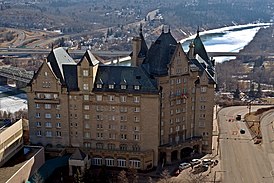
Since Alberta was settled after the industrial revolution was already well established, it completely lacks a regional food culture based on millennia of peasant traditions as one would expect in the Old World or even many local specialties based on a few generations of adaptation and hybridization as you might expect in longer-settled parts of North America. What it does have is an abundance of quality beef (and bison!), raised on its rich grasses and finished on local barley (not corn [maize], as in the US) and a high tolerance for international influences, going back right to the beginning when men from China's Fujian province often worked as cooks in railway-building camps. To this was added the British influence, American cowboy traditions, and continental European dishes. As a result the smallest towns will have a "Chinese café" usually serving an odd assortment of hamburgers, spring rolls, won ton soup, "perogies" (Ukrainian dumplings), and poutine. In the bigger towns and suburban neighbourhoods this quirky eclecticism has sadly been largely replaced by an assortment of chain restaurants. However, in the main resort towns of the Rockies one can find fine dining, and in the two major cities it is possible to find a number of more experimental restaurants as well as variety of ethnic dishes from every corner of the globe, due to recent immigration (Calgary has the province's only Uzbek restaurant, for example). The only thing truly hard to find is good seafood; but when in Rome do as the Romans do, and when in Alberta, go for beef. If you're vegetarian, you will still be distinctly in the minority and might suffer from a lack variety outside the major cities, though even the big chains are much better than in years past.
Drink (and smoke) [ edit ]
The drinking age is 18 - younger than most other provinces in Canada. Alcohol is available from the many private liquor stores and beer/wine stores throughout the province. Unlike other provinces, liquor retail is privatized, there's no government-owned alcohol monopoly; unlike most American states, you cannot buy alcohol directly in grocery stores, although many grocery stores have liquor stores in unattached buildings nearby.
Since 2018, possession of 30 grams of recreational cannabis has been legal everywhere in Canada. You can find cannabis retail stores in most towns and cities in Alberta, which has the most of any province. As with alcohol and unlike the other provinces Alberta has chosen to let private business do the selling.
Production of craft beer and spirits were significantly deregulated in 2015, leading to an explosion of new microbreweries and distilleries. The province is now home to a burgeoning craft scene. Even small towns like Lacombe are now home to breweries making once-obscure brews like fruited kettle sours.
Buy [ edit ]
The main attraction is West Edmonton Mall , which was the world's largest shopping centre from 1983 to 2004 and includes over 800 shops, an ice rink, an indoor waterslide park and wave pool, a bowling alley, a gun range, a minigolf course, an amusement park, a multiscreen cinema, a casino, two hotels, over 100 restaurants or food kiosks, several bars and nightclubs and parking for more than 20,000 vehicles. This is really more of an enclosed neighbourhood than a "mall" as typically conceived. It is Alberta's most visited attraction with over 32 million visitors each year.
Besides that, there are other smaller malls, typical "high streets" in Edmonton and Calgary and two notably large "power centres" (outdoor malls), South Edmonton Common in Edmonton and CrossIron Mills in Balzac near Calgary.
Uniquely among the provinces, Alberta does not have a provincial sales tax, although the federal 5% sales tax still applies and is added to the price at the till and is not shown on price tags.
Stay safe [ edit ]
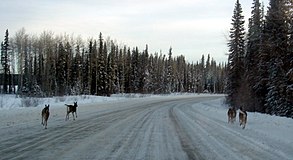
The following areas of Alberta are considered higher risk areas with respect to crime.
- Calgary - walking during night hours should be avoided in the East Village, Victoria Park, and the Bow River Pathway between Eau Claire Market and the Calgary Zoo. These areas are prone to drugs and prostitution. There are panhandlers on various downtown streets.
- Edmonton - an area northeast of downtown is a prostitution stroll. There is also a stretch of Whyte Avenue that can be a problem after 7PM, given its high bar concentration.
Otherwise, Alberta as a whole is a relatively safe area. However common sense should be applied. Do not leave valuables visible in vehicles and lock all vehicle doors.
Growth in urban centres in Alberta has led to increased traffic. Allow plenty of time to reach a destination, especially during rush hour or during adverse weather.
Alberta's weather is very changeable and volatile, especially in the mountains and the foothills and also during the spring season. Driving conditions can deteriorate quickly. Before going out, always check the local forecast. Road conditions are available through the Alberta Motor Association .
During winter strong Chinook winds in the foothills, especially south of Calgary, can blow a vehicle off the road. Highways 2, 3, 4, 5, 6, 22 and 23 south of Calgary are the most vulnerable to these conditions, with Highway 22 usually being the worst. Extra caution is advised, particularly for higher-height vehicles such as trucks and SUVs.
Alberta has had cases of the West Nile Virus. In the spring and summer, it is wise to be protected using Deet-based repellents.
The area within and around the mountain parks is bear country. Hikers, hunters and campers in these areas should follow all bear safety tips . Campsites should be kept clean, all dishes properly washed, and all tables wiped clean after a meal. Never leave any food or garbage loose or unattended. Hikers should travel as a group, make noise regularly and stay on established trails. Pets should be kept out of bear country.
Taxis can be in short supply in Calgary and Edmonton at times, especially during holidays, poor weather, and on weekends. It is advisable to phone ahead in the daytime for a reservation if you realize you may need a taxi. In most cases, taxis are easily available at the airports.
During summers tornadoes are not uncommon and happen most in central Alberta. Edmonton has been hit by many tornadoes, the biggest of which was an F4 in 1987. Hail is very common during these storms — usually very small but sometimes as big as softballs. Check Environment Canada about risks.
Go next [ edit ]
Since Alberta shares the Rocky Mountains with British Columbia (to the west) and several American states (to the south and southwest), travellers interested in skiing, camping, hiking and other outdoor pursuits not need not limit themselves to just the Albertan section of the mountain chain. The other major cities with notable attractions and international air connections near to Alberta—relatively, but still many hours drive away— would be Vancouver , Seattle , or Denver , though there are intra-U.S. connections via smaller airports like Billings or Spokane as well.
A less common path is to the east or southeast, into the wide open spaces of the Great Plains. Here there are no rail connections and few major airports, so driving is virtually a must. When travelling across Saskatchewan or the northern tier of the neighbouring states, you are far from the usual tourist trail, but you can find little-known natural gems here like Grasslands National Park or the Great Sandhills . For urban destinations, the only other main city on the Canadian Prairies to rival Calgary or Edmonton is Winnipeg , with its historic centre, Canadian Museum of Human Rights and an international airport. A little further to the south, major attractions like the Badlands and Black Hills region of South Dakota are accessible with enough time, and from there on to more commonly-travelled parts of the U.S.A.
The most adventurous next step from Alberta is certainly to the north, where literally millions of square miles of boreal forests are to be found. The Alaska Highway through the Yukon is the obvious choice in terms of routes to the great north country, but consider also the Northwest Territories for those who truly want to be off the beaten path.
Of course, once you've mastered the rugged-mountains-and-vast-arid-plains combination of Alberta perhaps you'd like to compare to similar experiences on the other side of the globe. Consider Australia's Great Dividing Range and Outback , Russia's Urals and Steppes, South Africa 's Drakensberg and Veld, or Argentina's Andes and Pampas .
- Has custom banner
- Has mapframe
- Maps with non-default alignment
- Maps with non-default size
- Has map markers
- Go listing with no coordinates
- Guide regions
- Guide articles
- Region articles
- Has Geo parameter
- All destination articles
- Pages with maps
Navigation menu

The 62 Best Things to do in Alberta, Canada – The Ultimate Guide
Written By: The Planet D
Updated On: February 8, 2024
Whether you visit Alberta in winter or summer its beauty shines through. We’ve had the pleasure of visiting Alberta on several occasions in all seasons and trust me, there are plenty of outdoor activities to keep you occupied year-round. In fact, a lot of the province comes to life in the dead of winter. We have rounded up the best things to do in Alberta, Canada from our half-dozen trips to our favourite province in Western Canada.
Table of Contents
Top Things to do in Alberta, Canada
We have broken down this Alberta travel guide into different areas so you can plan your trip in an easily organized manner. This guide shares the very best things to do in Alberta that we have done over the past 10 years of traveling to all corners of the province.
1. Banff National Park
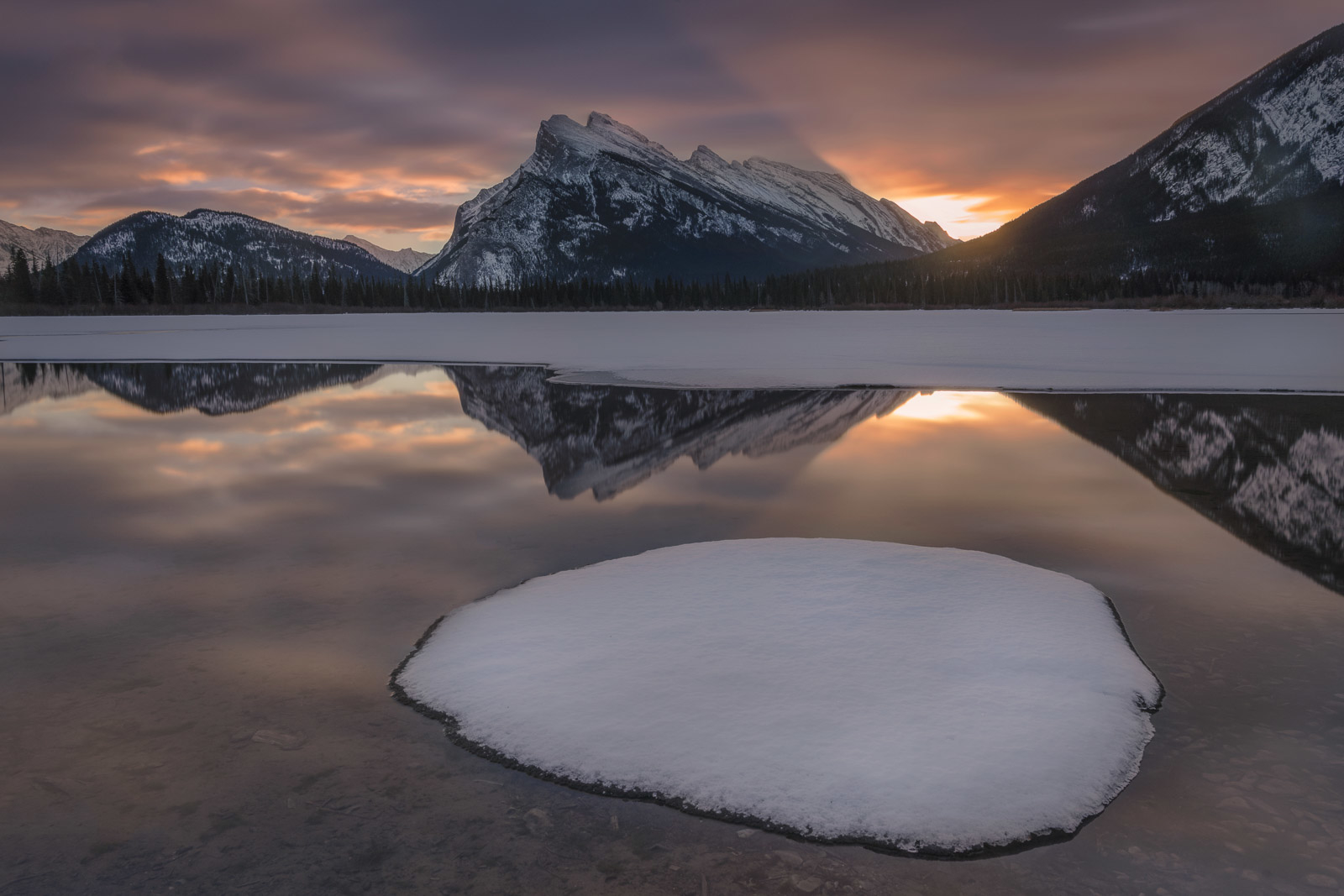
Banff National Park is Canada’s first national park and its most beautiful. This year-round destination has countless outdoor activities from hiking trails into the backcountry, ski resorts, glacier lakes, and a great food scene. The Banff Springs Hotel was opened in 1888 to attract tourists to the area and has continued to draw visitors from around the world making Banff Alberta’s most visited tourist attraction. Read more: Things to do in Banff
2. Canoe Lake Louise
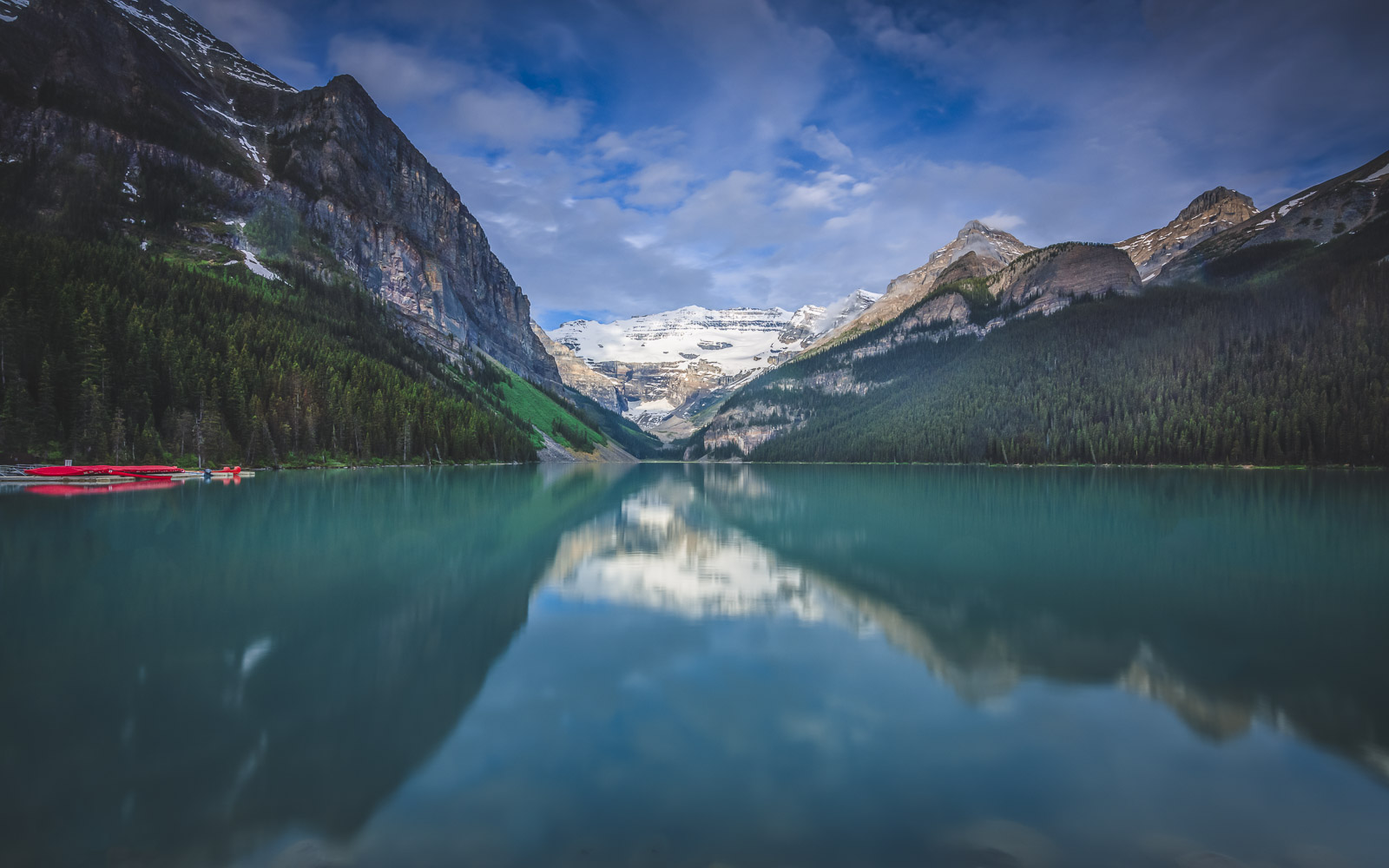
Lake Louise is the most famous of all tourist attractions in Alberta and the first place most people stop when visiting Banff. Victoria Glacier and the surrounding mountains are reflected in the still turquoise waters making it truly one of the most beautiful places in Alberta . The legendary Fairmont Chateau Lake Louise sits on its shores, and one could spend hours just taking in the views. A bucket list item for anyone visiting Lake Louise is to rent a canoe and experience a true Canadian tradition . When visiting Alberta in the summer months, this is a great way to take in the fantastic scenery away from the crowds. Read more: Canoe Lake Louise and Banff National Park, Alberta
3. Pond Hockey on Lake Louise
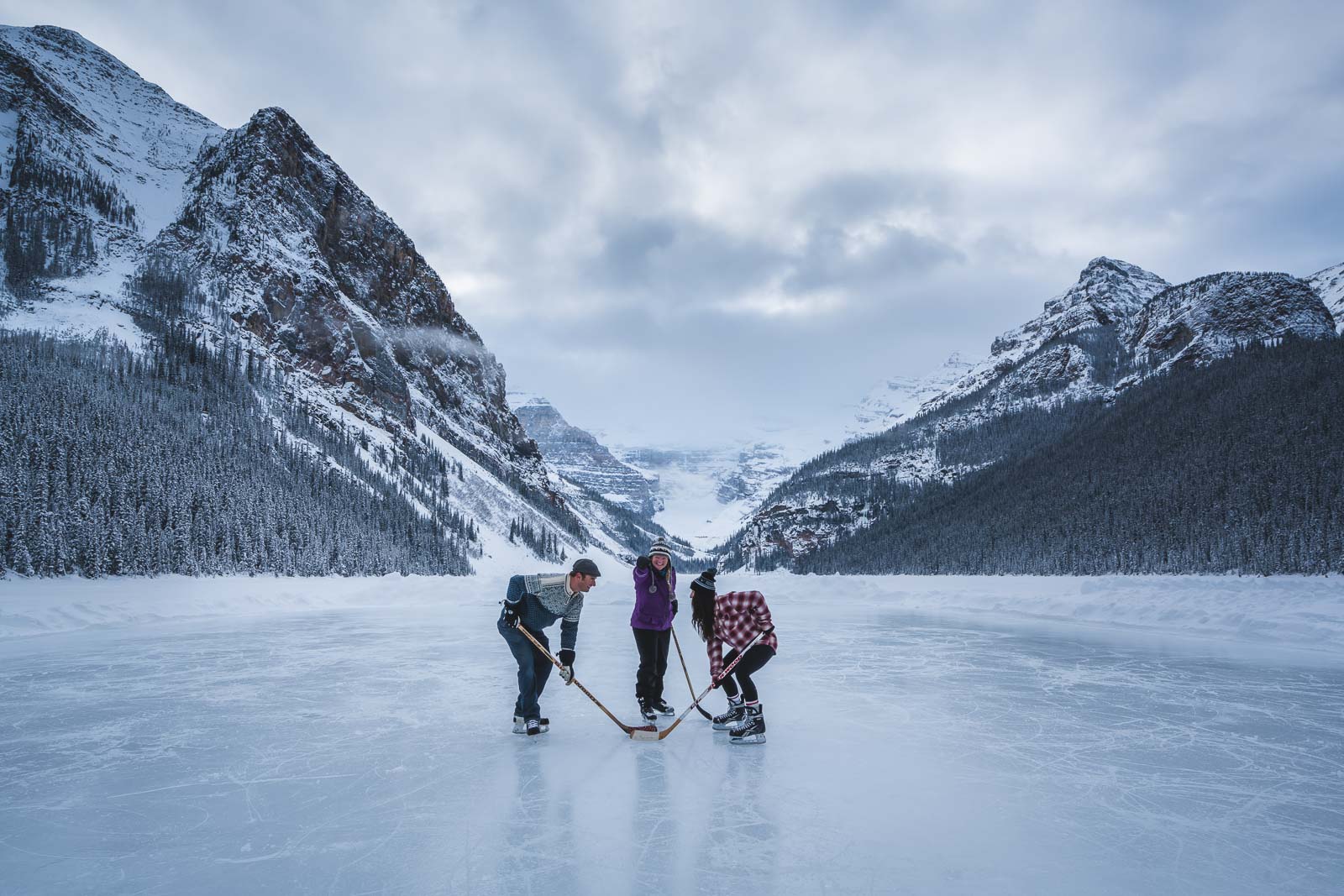
There is absolutely nothing more Canadian than playing pond hockey on a frozen lake. When the temperature drops, Canadians seek outdoor activities like pond hockey and if you visit Alberta in winter, you better skate on the world’s most beautiful skating rink! Imagine dropping a puck surrounded by Canada’s most impressive scenery. Located directly in front of the Fairmont Chateau Lake Louise, the rink attracts visitors from around the world whether they can skate or not! You can rent hockey gear from the hotel or from Wilson Mountain Sports .
4. Moraine Lake
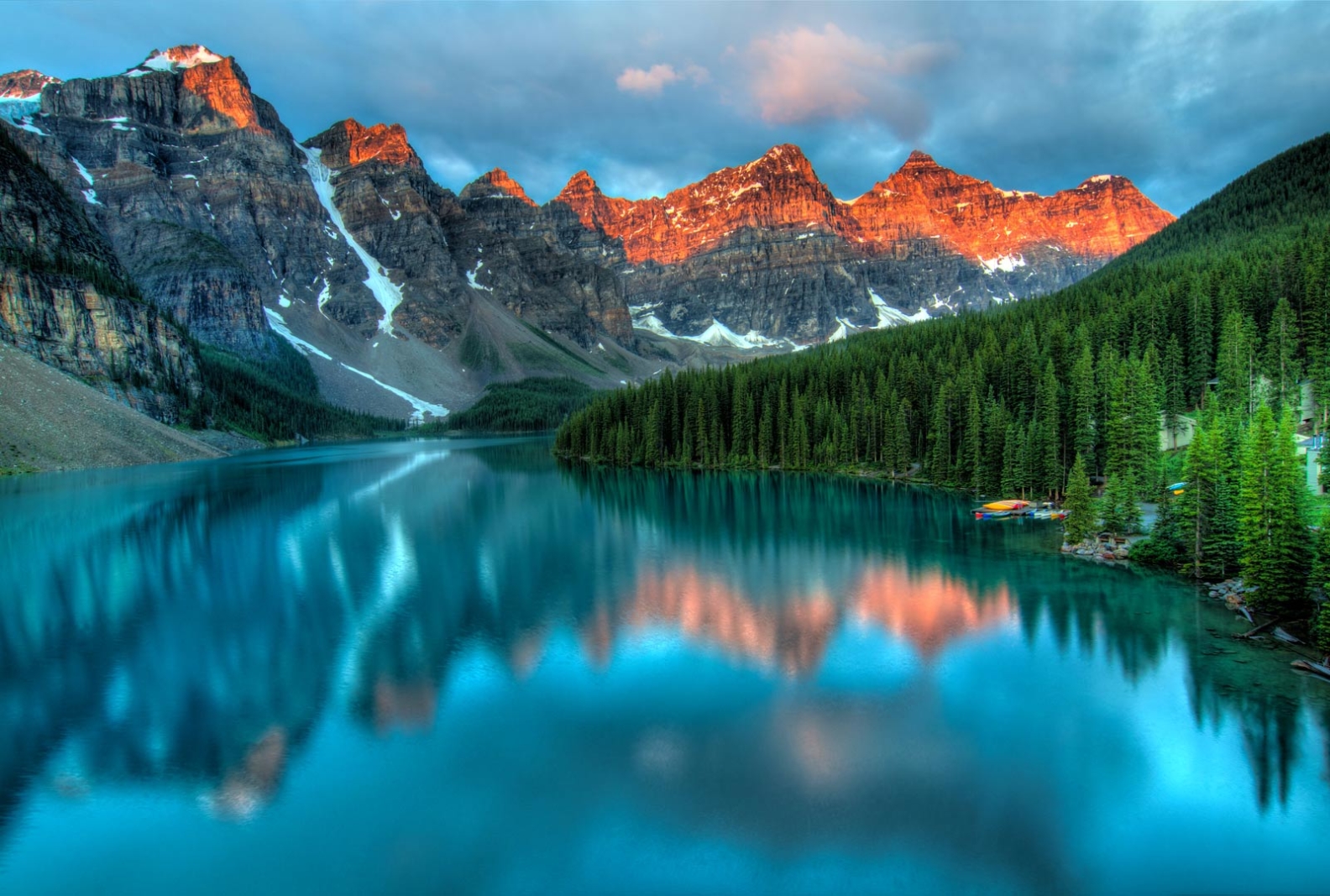
Located just a short distance from Lake Louise within the Valley of the Ten Peaks, Moraine Lake is considered one of the most beautiful places in Alberta. With hiking trails leading to views of the Valley of the Ten Peaks, it is not to be missed. Plus, a fun fact, Moraine Lake is the famous lake that was on our 20 dollar bill! Moraine Lake can be very busy in the summer months, so get there early to avoid the crowds. For more hiking trails in Banff and information on Moraine Lake Read: 12 Best Hikes in Banff National Park
5. Lake Agnes
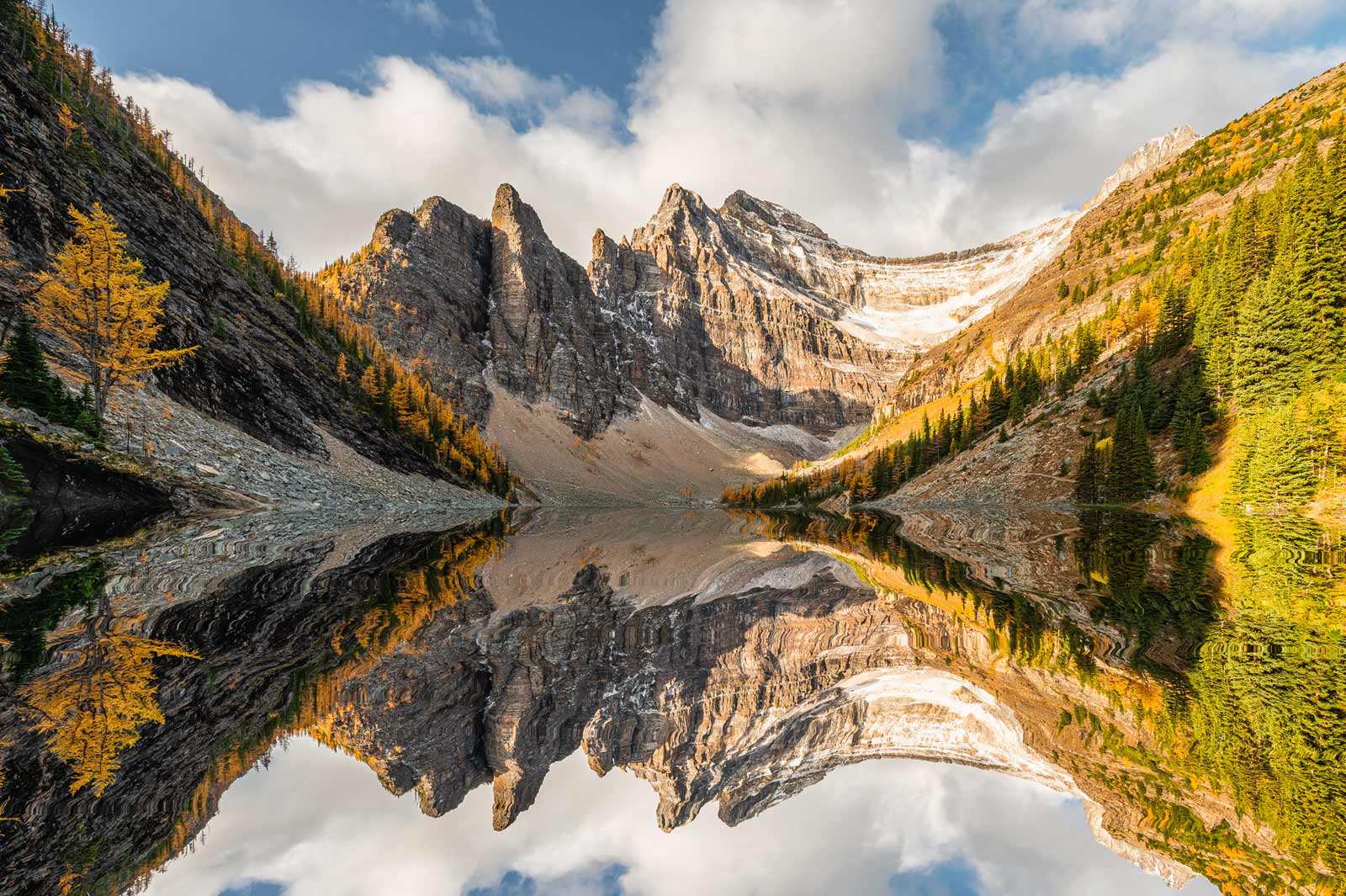
The Lake Agnes Teahouse has been serving tea since 1905. The teahouse was built by the Canadian Pacific Railway in 1901 as a place where hikers could stop and rest. In 1905 it started serving tea and hasn’t stopped since. This popular hike starts out on a paved path before getting into the rugged forest. The Lake Agnes Teahouse hike is a 4.5-mile hike is considered a moderate hike and you can get to it from Chateau Lake Louise which is a mile outside of Lake Louise village. The trailhead is right off the parking lot of Chateau Lake Louise.
6. Backcountry Lodges
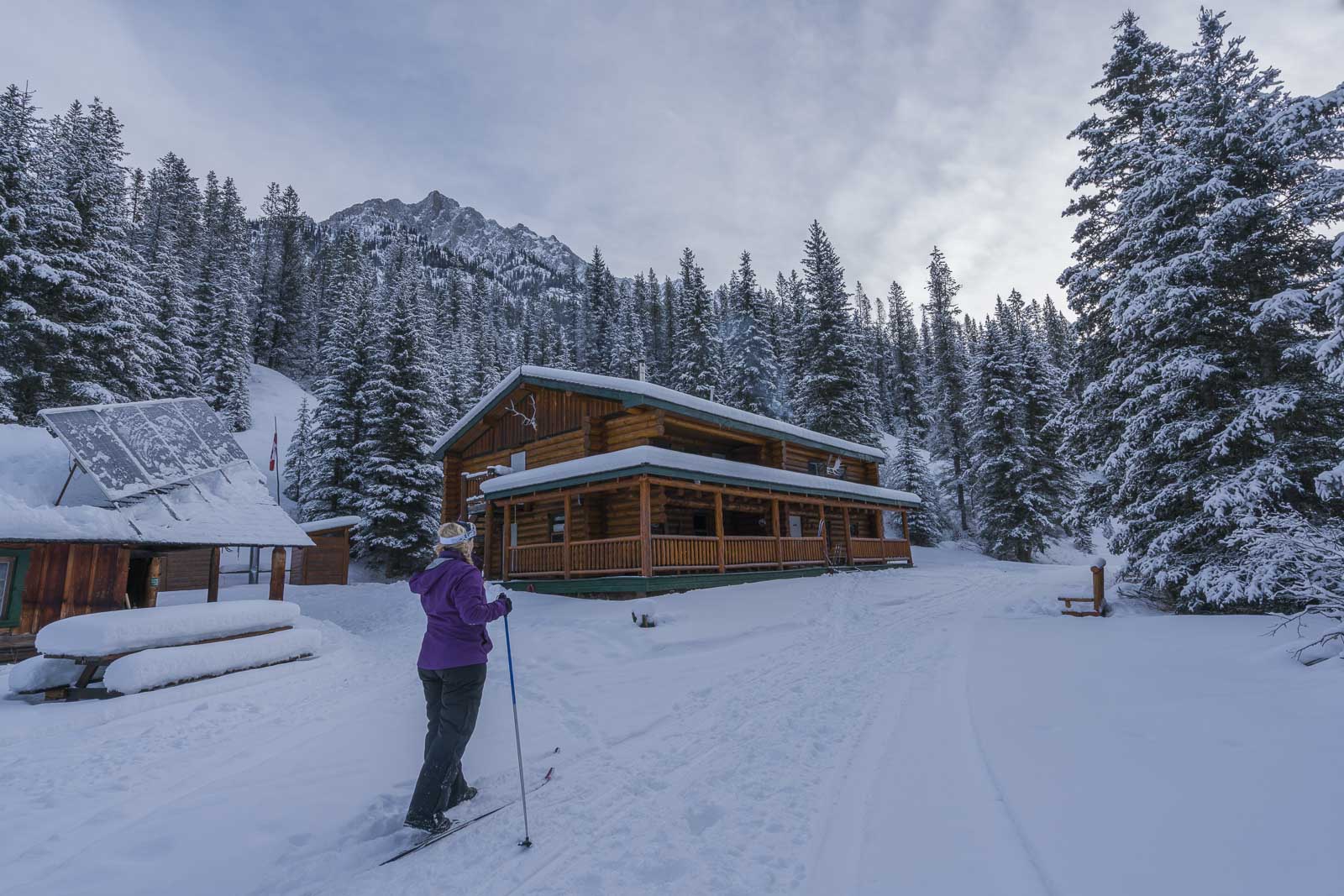
There are several backcountry lodges in Alberta that make for an amazing active adventure that ends with a luxurious stay in a remote lodge surrounded by snow-capped peaks. We visited Sundance Lodge when exploring Banff and fell in love with the beauty of the area.
In the winter you can head out to lodges by cross country skiing or snowshoeing. In the summer you can hike or go by horse. Whichever season you visit Alberta in, a backcountry lodge is an experience you’ll never forget. Read more: Where to Stay in Banff
7. Explore Cave n’ Basin
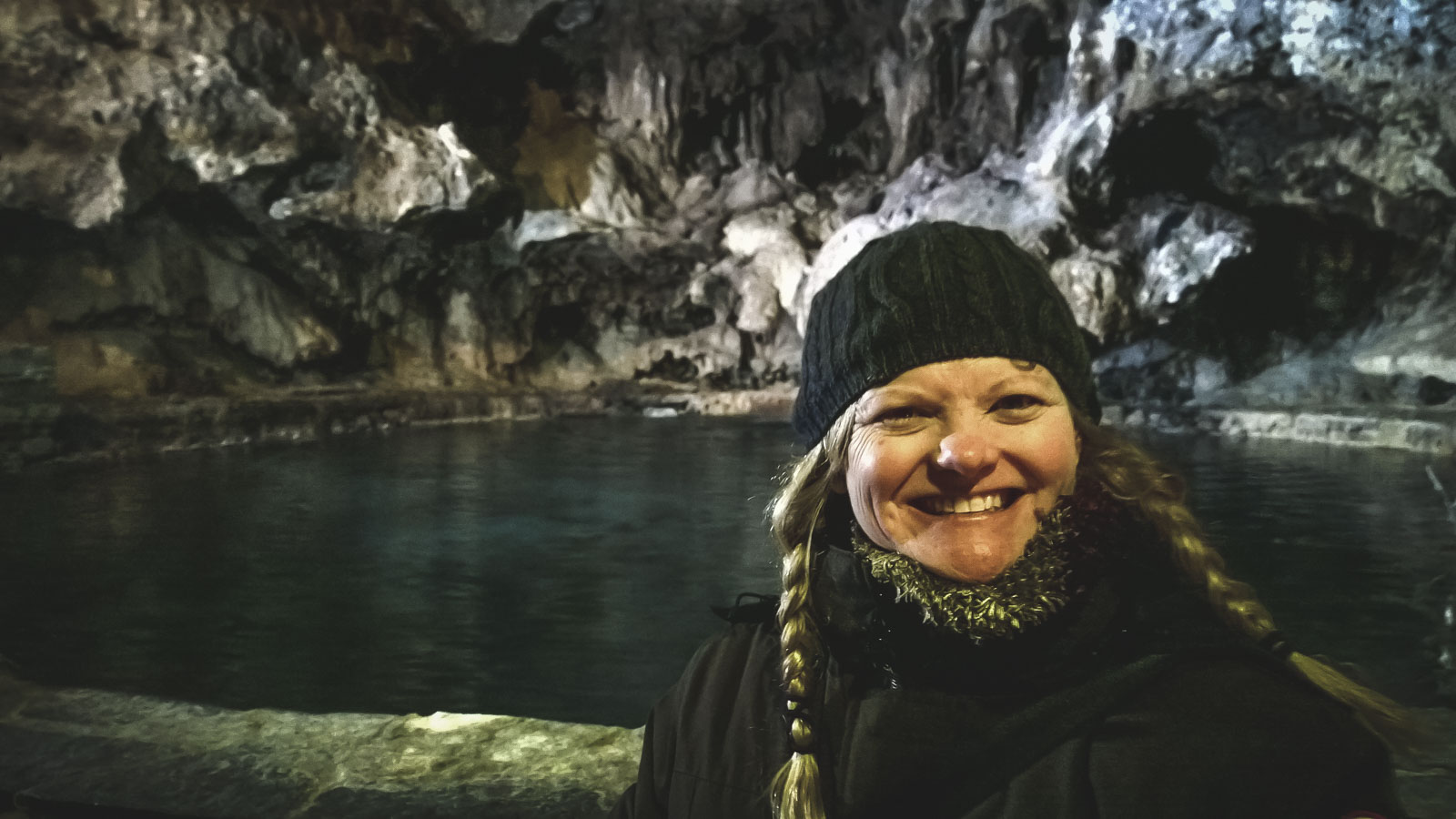
Discovered by railway workers back in 1883, Cave n Basin is where Canada’s National Park System began. To attract visitors to Banff, Canada opened the first National Park and visitors flocked to swim and relax in the hot springs. Soon after the Banff Springs Hotel opened and the rest is history. Today it is a national historic site and there is no swimming in the pool to protect the endangered snails that inhabit the pool. Read: Best Canada National Parks – That We’ve Seen
8. The Banff Hot Springs
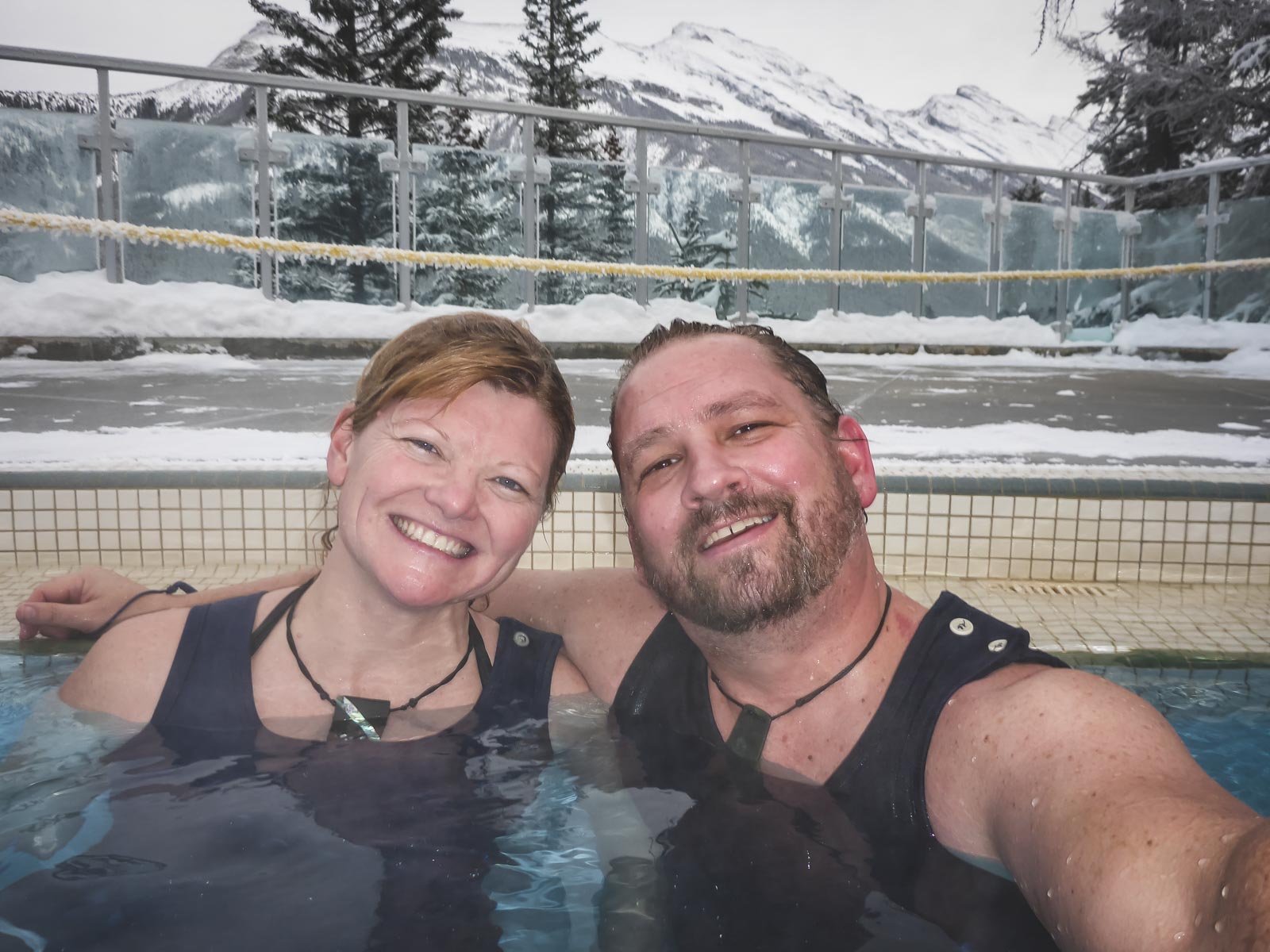
The Banff Upper Hot Springs is world-famous for its natural springs and outstanding view! The upper hot springs are named so because at one time the springs were located lower down the mountain at Cave n’ Basin and the historic pool. Today the springs have moved up the mountain to the Upper Banff Springs. You may also like: Discover Banff Canada – 24 Photos Inspire Wanderlust
9. The Banff Gondola
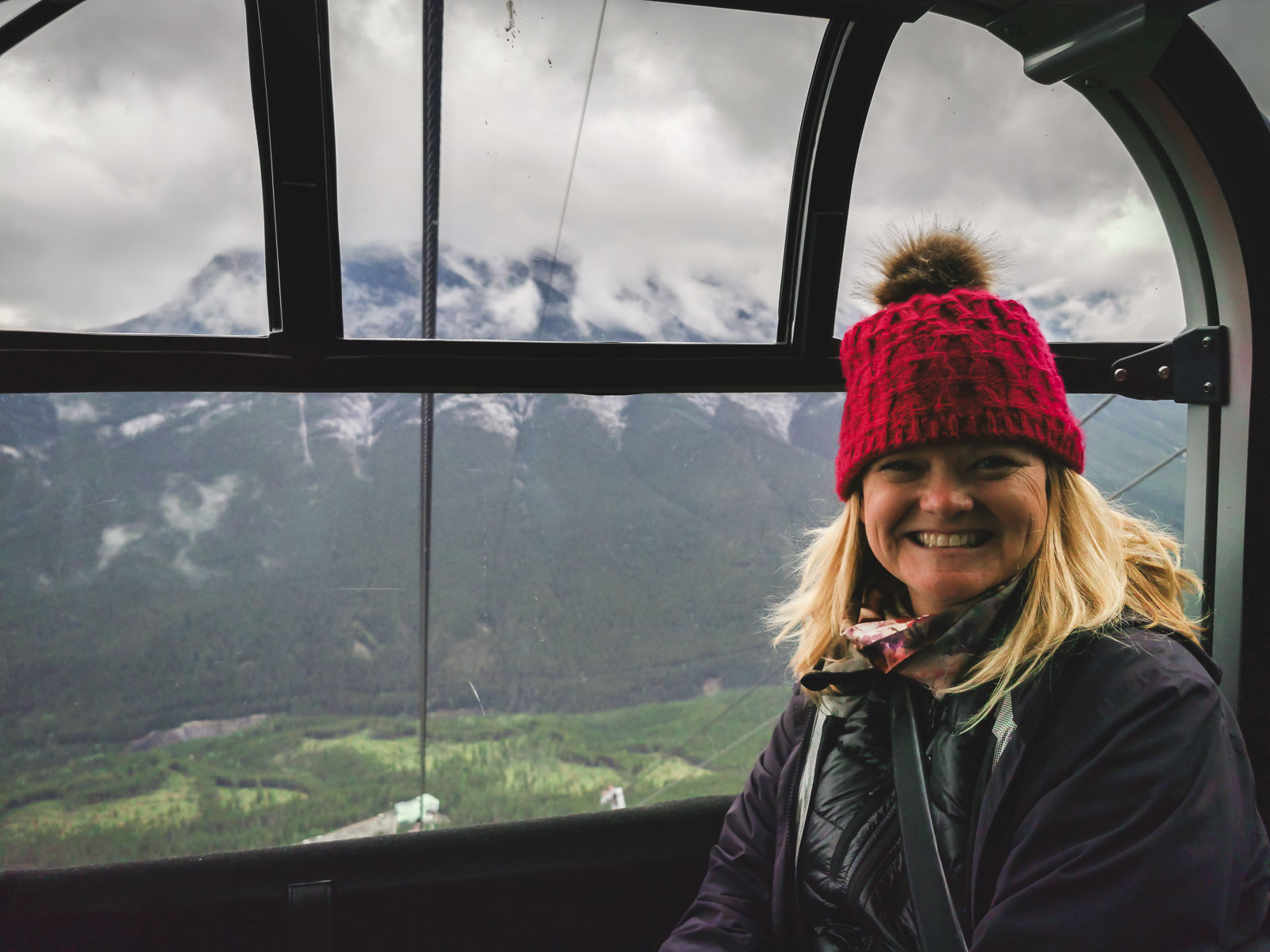
The Banff Gondola gives you incredible views of the snowcapped peaks and the village of Banff. If you don’t have the chance to ski or snowboard at Lake Louise or Sunshine Resort, this is a perfect way to get up into the mountains. The gondola takes you up Sulphur Mountain and you can either take the hiking trails back down or ride the gondola back. Sulphur mountain got its name from two sulfurous springs at the base of the mountain. It is this spring that made Banff famous. There’s a museum, and restaurant at the top and there are hiking trails to get outside.
10. Fairmont Banff Springs Hotel
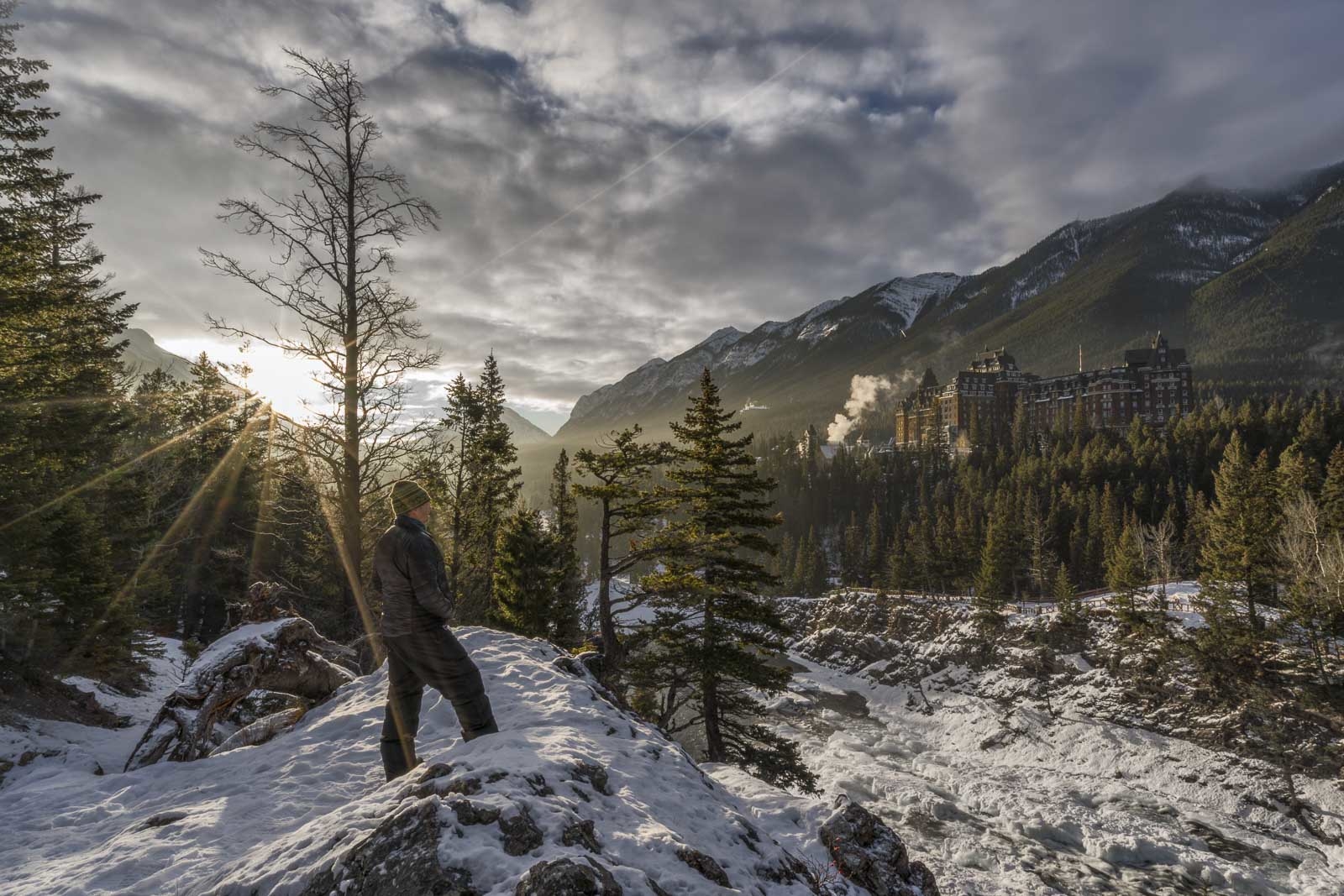
The Fairmont Banff Springs hotel is one of the most historic hotels in Canada. Even if you are not staying there, make sure to stop in for high tea. You can go inside to see this luxury resort so have a look around, grab a coffee, or book dinner at the hotel if you are not going to splurge on a room. If you want to splurge on a room, we highly recommend it. See rates and availability on TripAdvisor / Booking
11. Lake Minnewanka Cruise
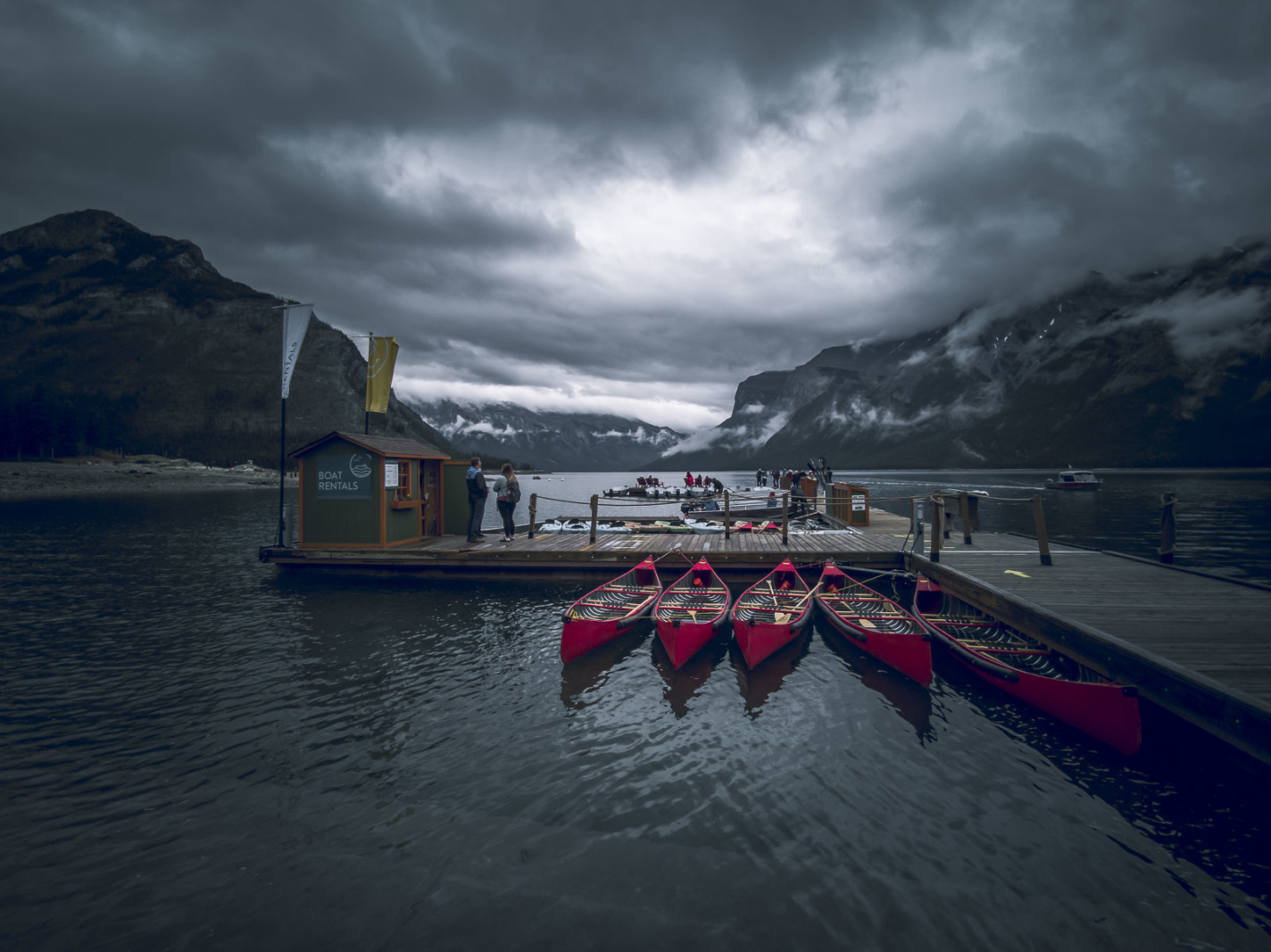
Lake Minnewanka is a popular spot in Banff for hiking, night photography, and for taking a scenic cruise. We took a Lake Minnewanka Cruise and it was a fun way to learn about the history of Banff and see views from a different point of view. The guides are fantastic and you learn all about the monster that drew visitors to this lake in the early 1900s.
12. Banff Town
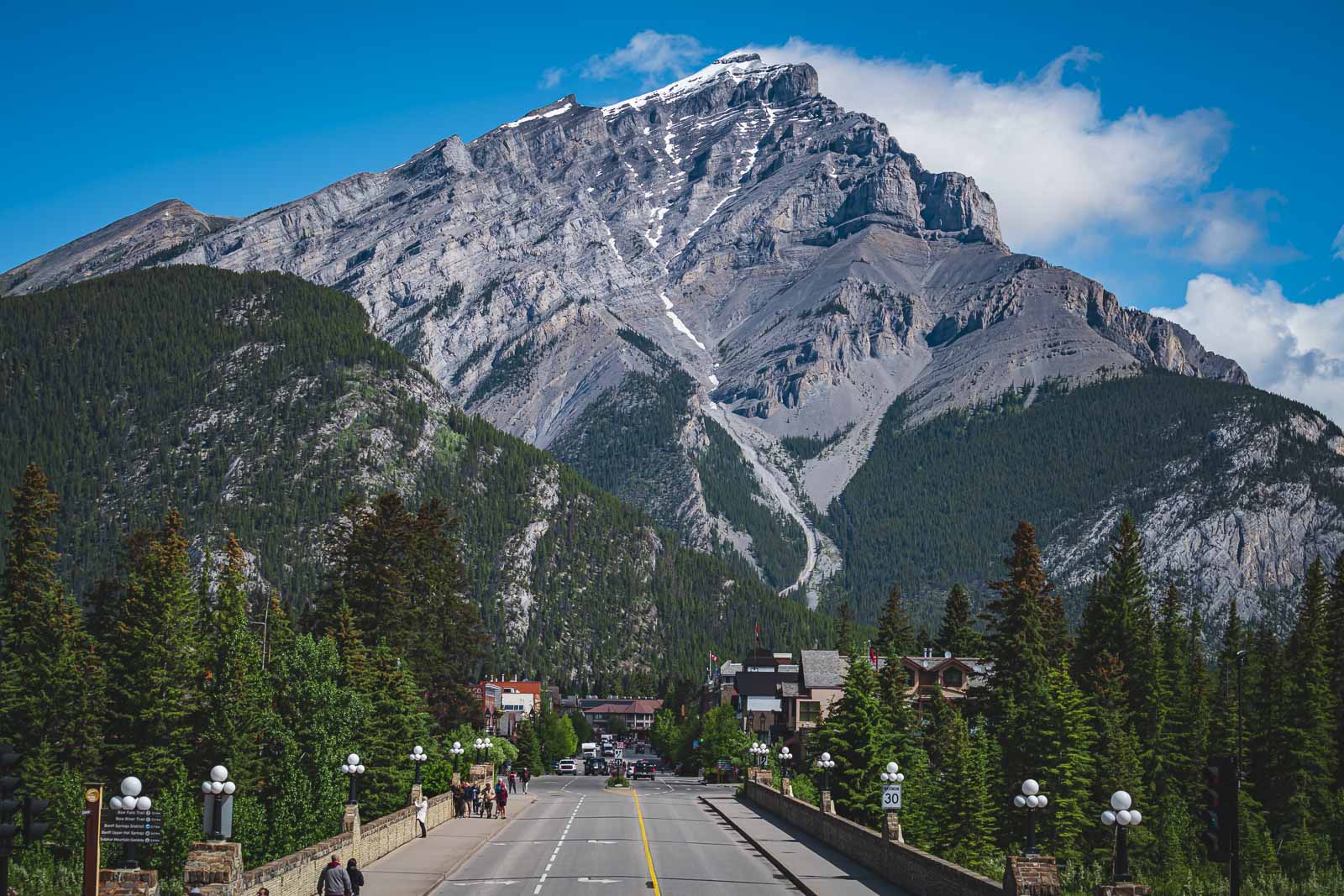
The town of Banff is located right in the heart of Banff National Park. This tourist town is an amazing place to make a base when exploring Banff with many of the top tourist attractions within walking distance of downtown Banff. There are micro brewpubs, distilleries, plenty of eateries, and countless hotels, hostels, and apartment rentals. Boutiques line the streets and it’s a great place to sit back and relax after a day exploring the Rocky Mountains. Read more at: Where to Stay in Banff in 2022 – 17 Best Banff Hotels
13. Johnston Canyon
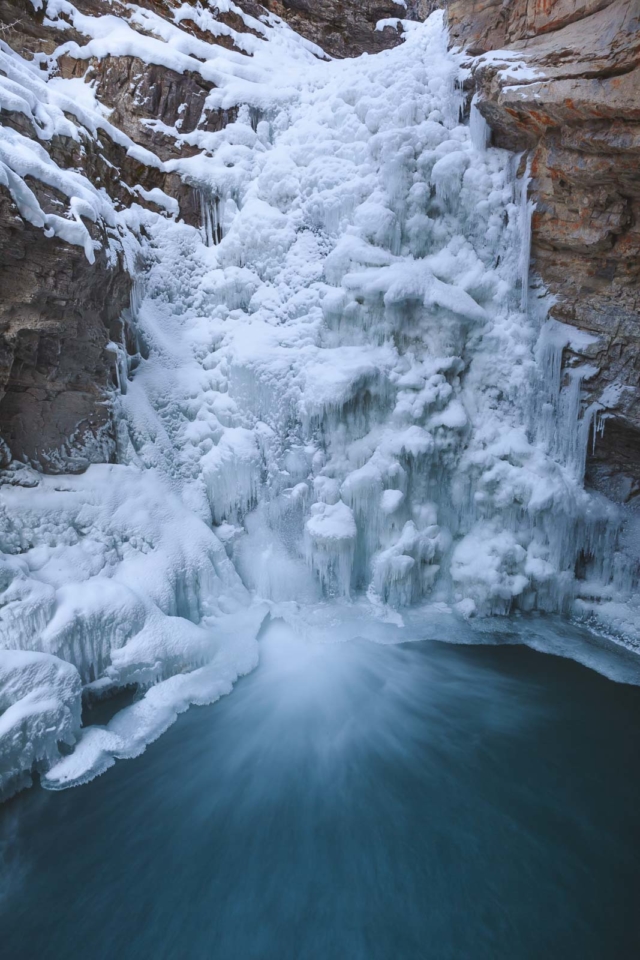
Johnston Canyon is open in winter and summer and is beautiful no matter what time of year you go. In fact, we think it truly comes to life in the winter! Enjoy the hiking trails through the canyon for gorgeous views of the high canyon walls with waterfalls plunging down. In the winter the waterfalls freeze creating a winter wonderland.
Discover Banff Tours offers guided scenic winter walks and let me tell you, this is one of the most stunning walks we’ve ever taken. The steel catwalk runs 2.5 miles through a picture-perfect limestone canyon.
14. the Icefields Parkway
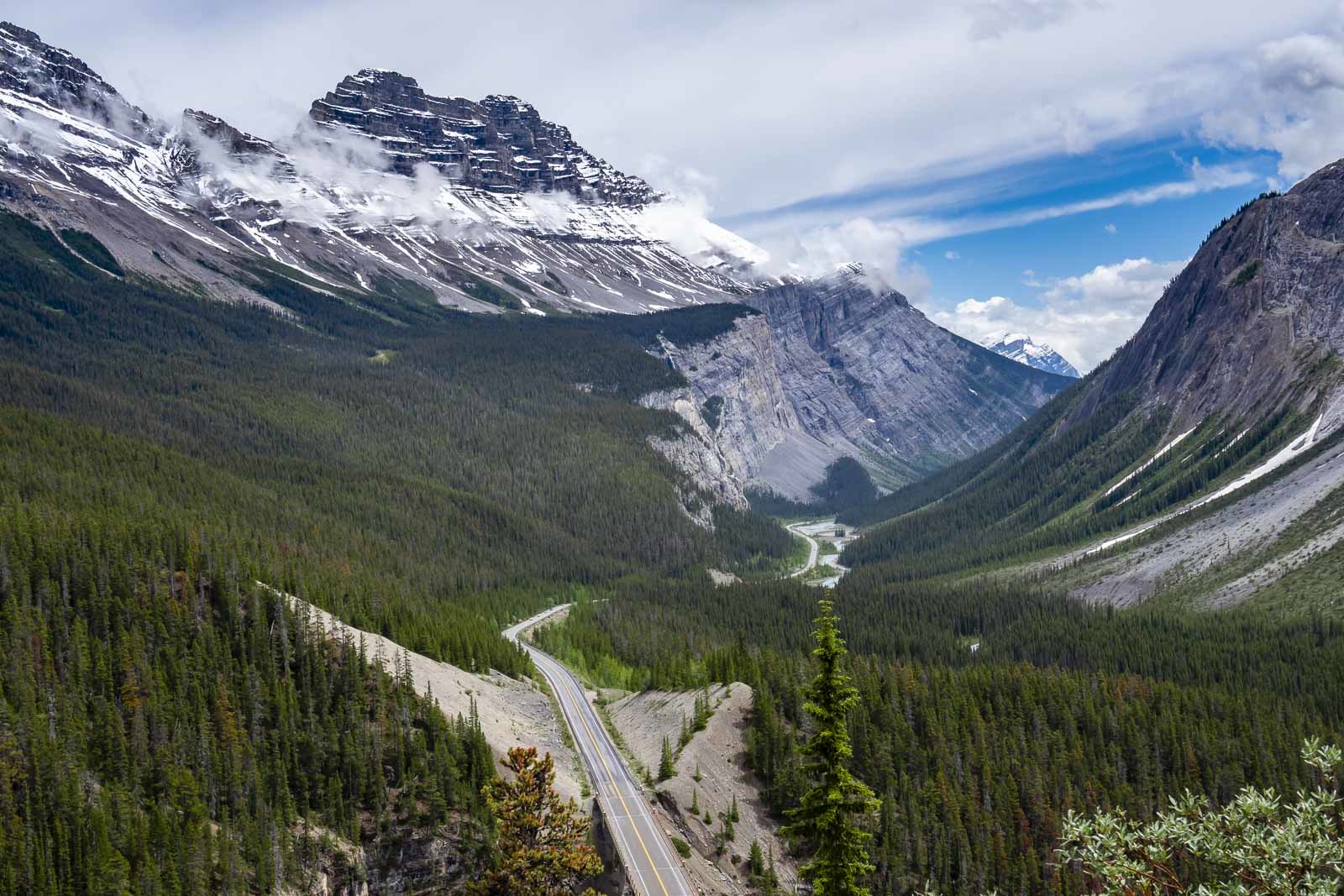
The Icefields Parkway is considered one of the most beautiful drives in the world and with good reason! Surrounded by the Rockies, this drive connects Banff and Jasper National Parks with lookouts at every turn! It is a short drive that can be done in a day, but there are so many things to see and do, it requires a few passes to see it all. These are a few of the must-stop places along the highway. For a full itinerary of the Icefields Parkway read: Driving the Icefields Parkway from Banff to Jasper Alberta
15. Reflections of Bow Lake
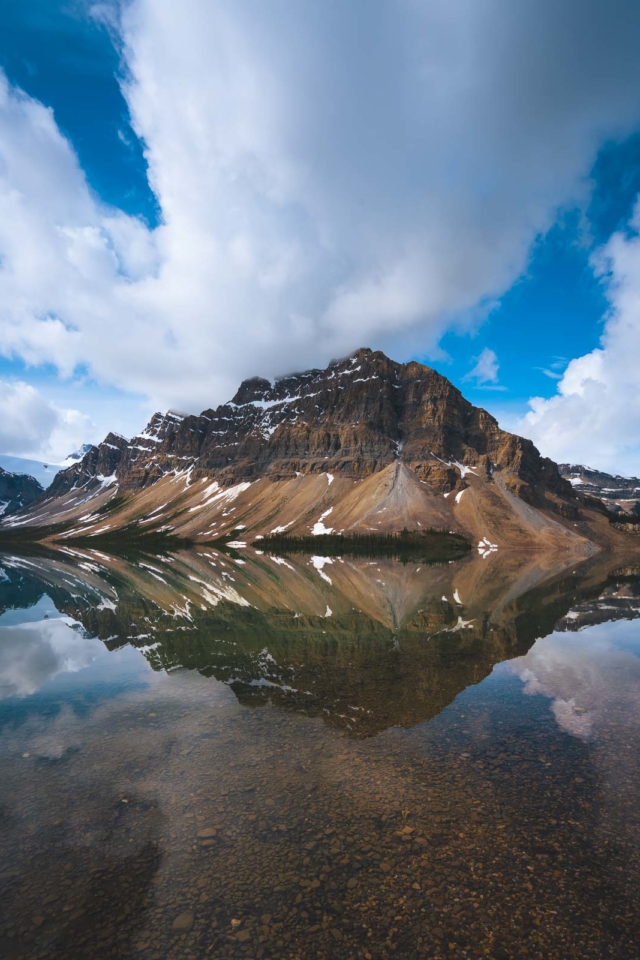
Our favourite lookout along the Parkway is Bow Lake with the most extraordinary reflections you’ll ever see. Located at Num Ti Jah Lodge, this is one of the first stops on the Icefields Parkway when driving from Banff National Park. You can go for a hike around the lake to take in different views.
There are plenty of other stops along the main highway to Jasper with hiking trails to lookouts and other lakes such as Peyto Lake, The Saskatchewan River Crossing, Sunwapta Falls, and The Weeping Wall. Peyto Lake is the most popular stop on this drive as people hike up to Bow Summit for views of the surrounding area.
16. Athabasca Glacier and Columbia Icefield
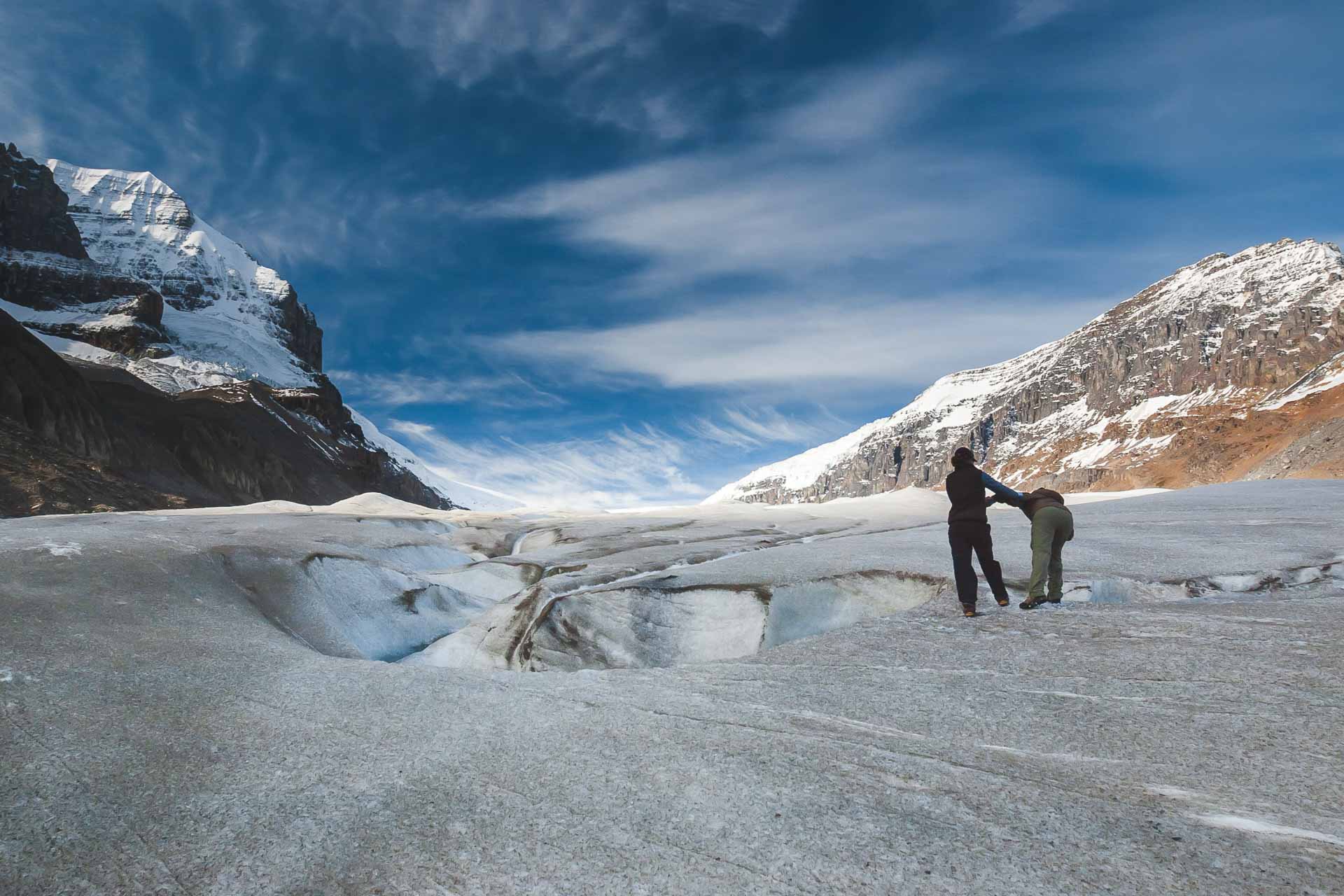
The Columbia Icefield is North America’s largest sheet of ice and on it, you can discover the Athabasca Glacier located directly on the highway. Take a tour to see this massive glacier in all its glory. You can even drive on a glacier vehicle to go out and witness the giant crevasses up close! There’s a great visitor’s center where you can grab a bite to eat and see the glacier from the viewing platform as well.
17. The Glacier Skywalk
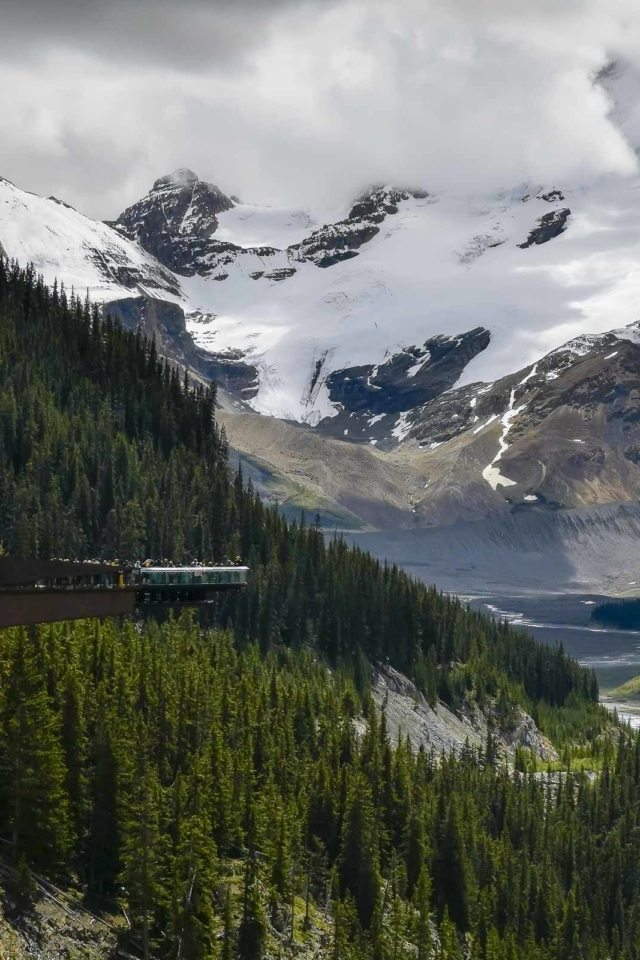
The Glacier Skywalk is one of Alberta’s newest attractions and it is definitely the most eye-catching. Walk along a glass floor that drops 280 m (918-foot) over the Sunwapta Valley if you dare. You can catch the bus from the Columbia Icefield visitor center and then spend an hour or so admiring the view and daring to walk along the glass floor.
18. Jasper National Park
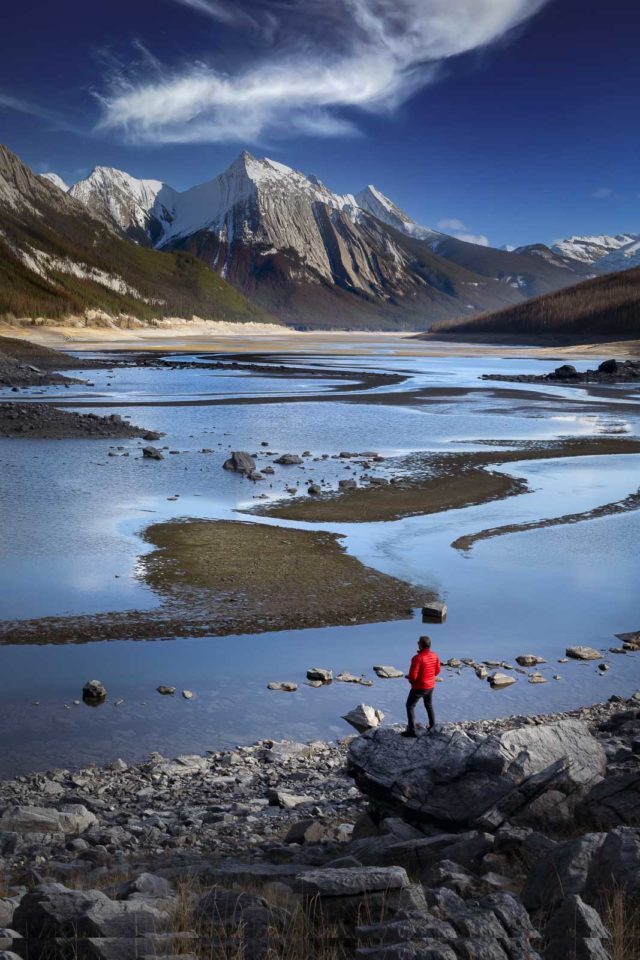
When you come to the end of the Icefields Parkway drive, you arrive at the incredible Jasper National Park. Famous for its dark sky festival and dark sky preserve plus gorgeous rocky mountain views, this is a place to spend a few days. There is an abundance of outdoor activities including amazing hiking trails, backcountry lodges, the Marmot Basin Ski Resort , and beautiful mountain lakes. The town of Jasper is a pleasant small town located within Jasper National Park with plenty of eateries and coffee shops The Rocky Mountaineer train ride also leaves from here. Read: 14 Best Hikes in Jasper National Park – Alberta Canada
19. Hike Maligne Canyon
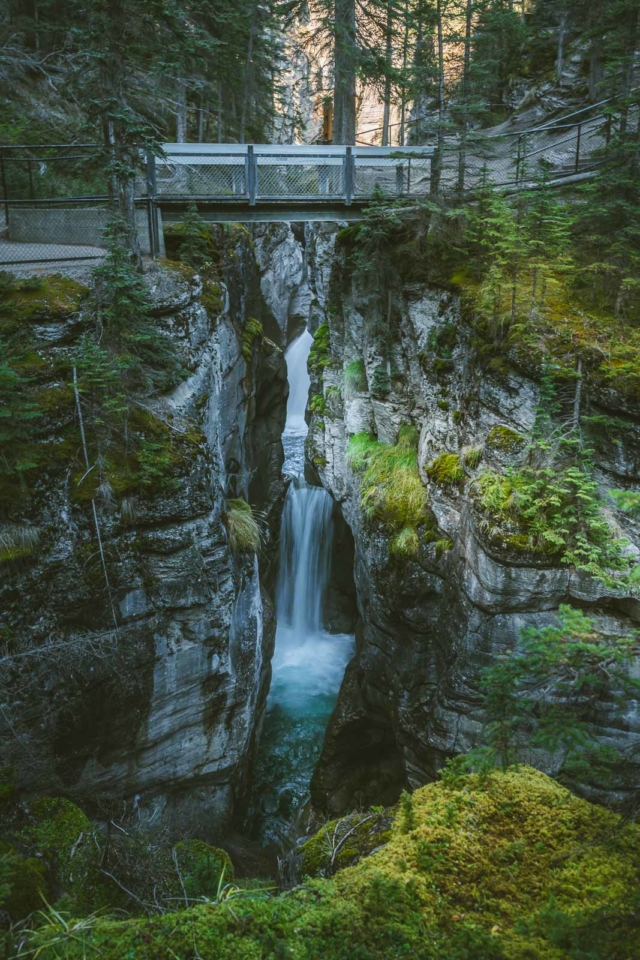
Maligne Canyon is my top recommendation for things to do in Jasper National Park. It is a stunning hike through a canyon dropping 50 meters (154 feet). With waterfalls and bridges, hiking trails, and scenic views, this is not to be missed! Read more: Amazing Things to do in Jasper, Alberta
20. Maligne Lake
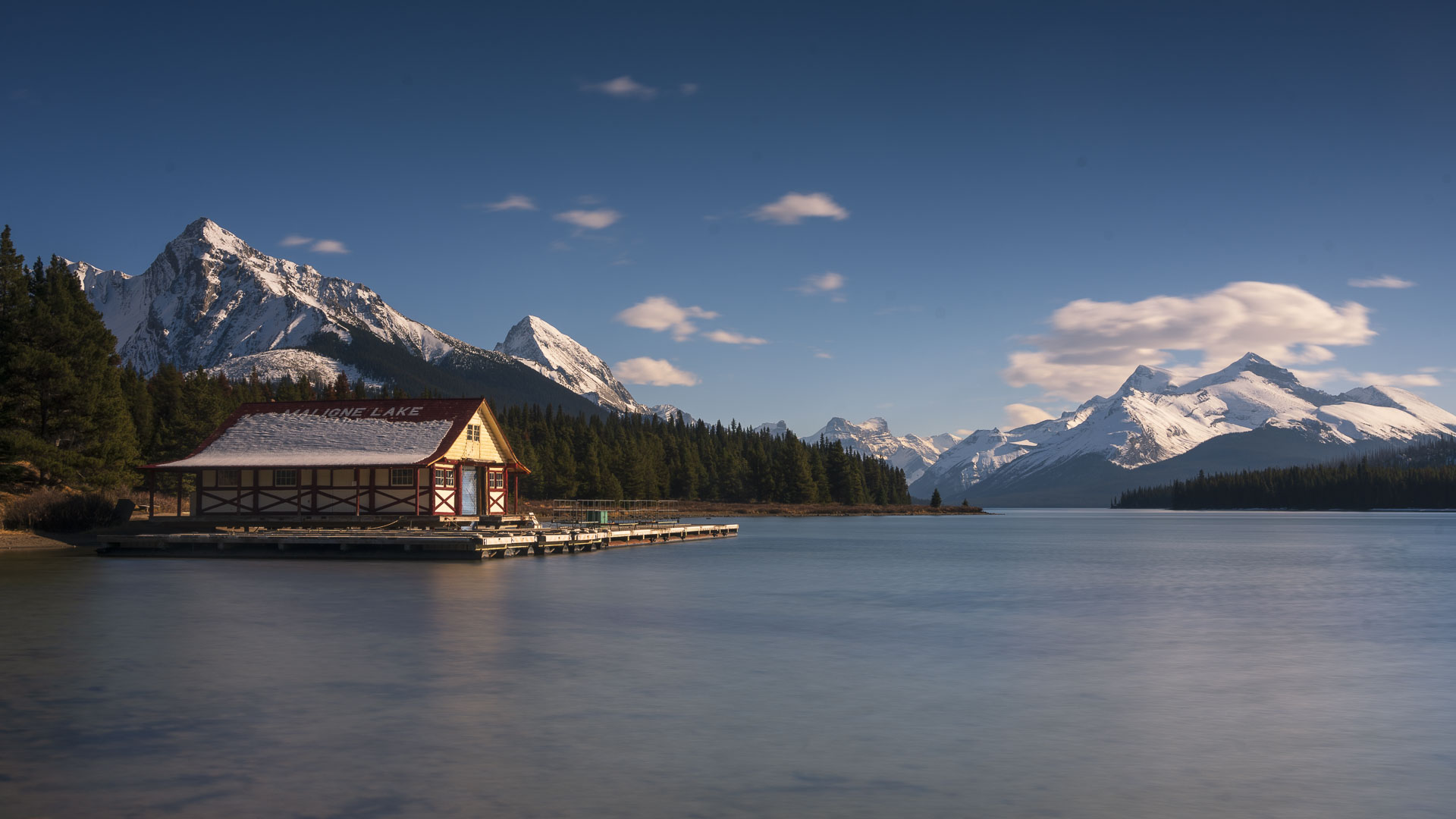
Just a little farther along the road is Malign Lake. It is the longest lake in the Canadian Rockies. Take a boat cruise to Spirit Island and witness this beautiful view surrounded by emerald water of the glacier lake. Or go for a walk along the hiking trails lining the lake.
21. Pyramid Lake
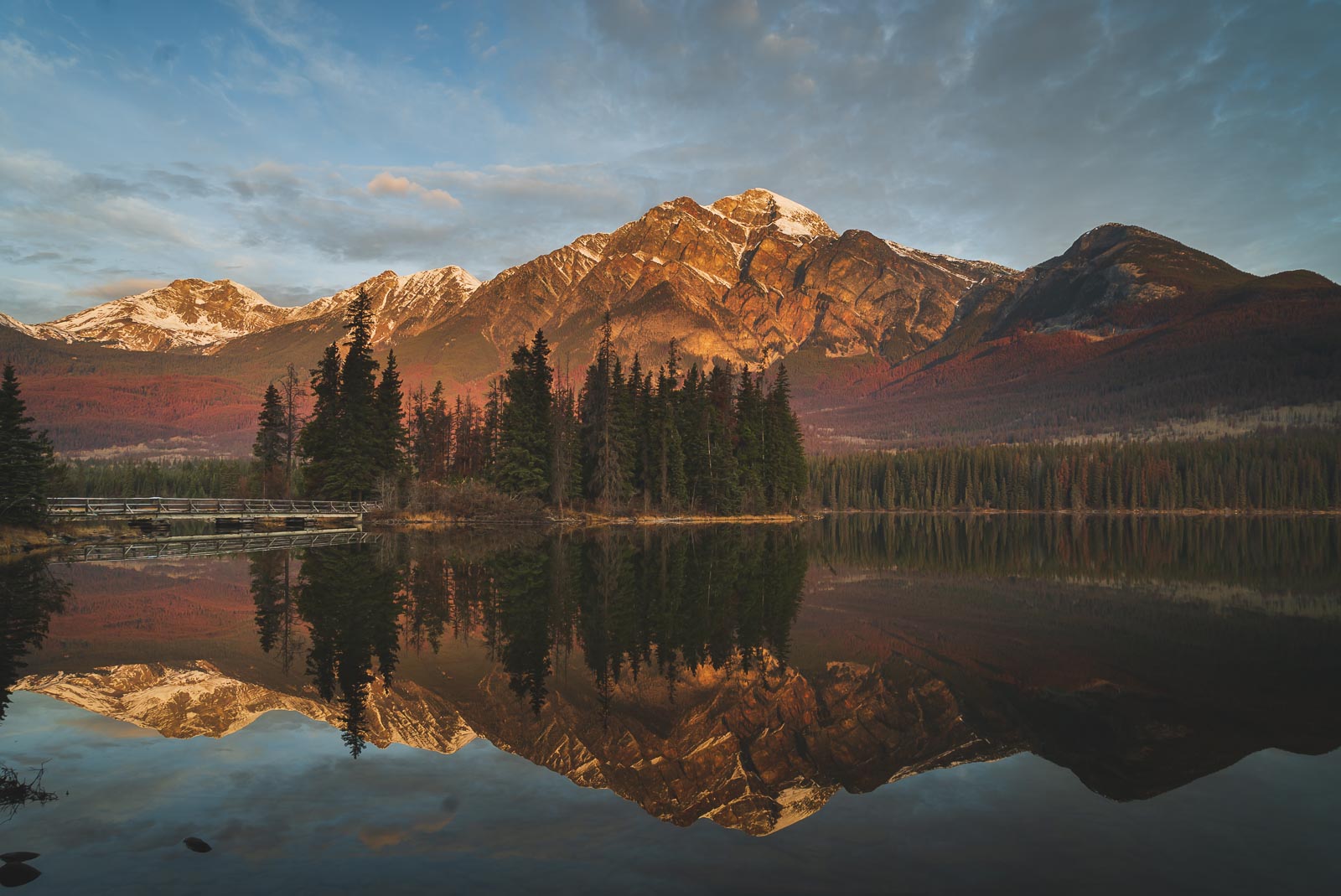
Maligne Lake is the top lake for visitors to see in Jasper, but our favourite was certainly Pyramid Lake. With beautiful reflections of a pyramid-shaped mountain twinkling in the still waters, it’s easy to understand how it got its name. Go in the morning at sunrise to see for yourself.
22. Fairmont Jasper Park Lodge
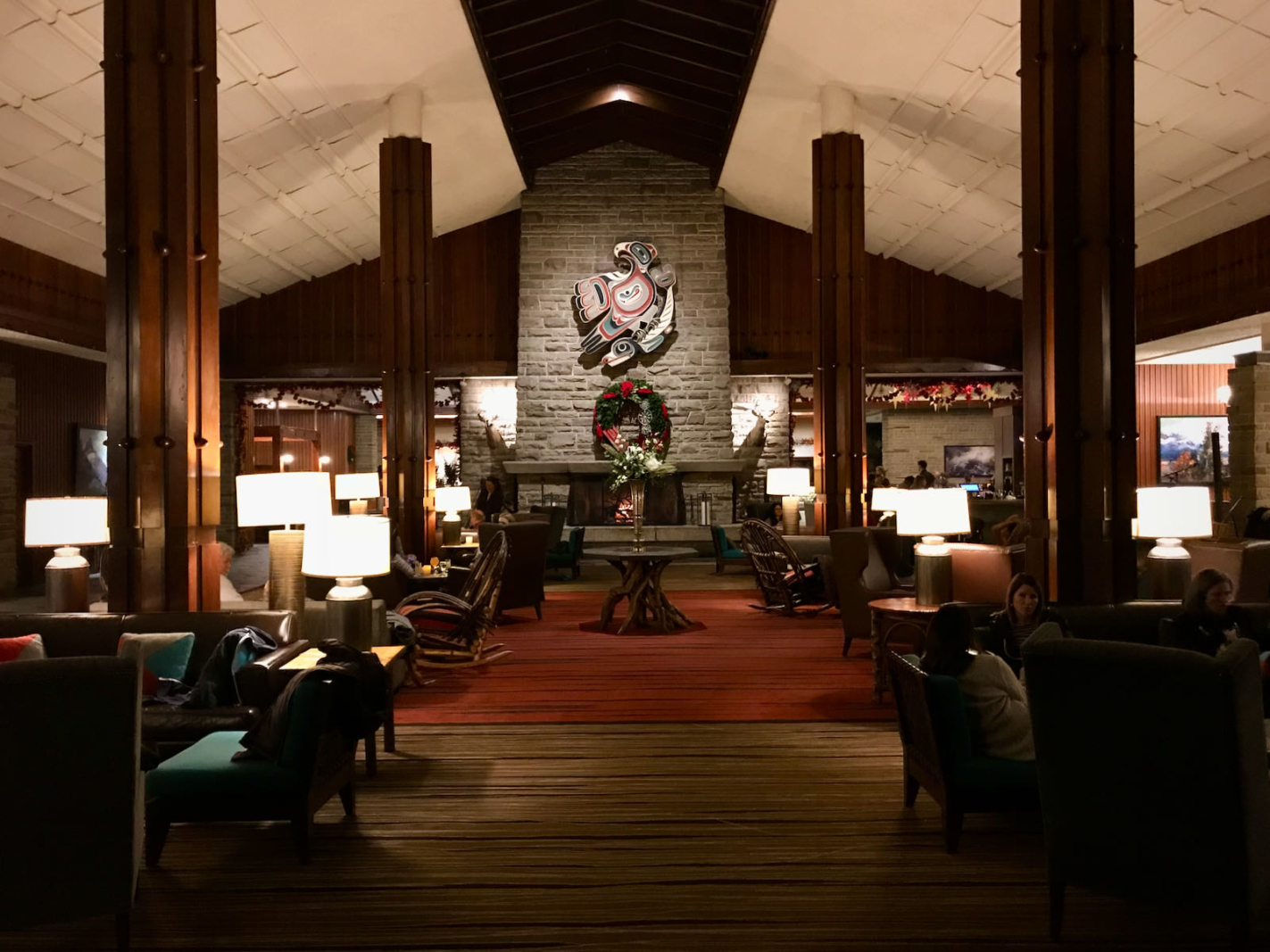
Staying at the Fairmont Jasper Park Lodge is an attraction unto itself. The rustic setting of luxurious and chic log cabins is set on the shores of Lac Beauvert. There are canoes, hiking trails, and wildlife on the premises. You’ll see elk, moose, and whitetail deer scurrying about in the woods. The Queen of England has graced these grounds. If it’s good enough for her, it’s good enough for us!
23. Northern Lights at Lake Annette
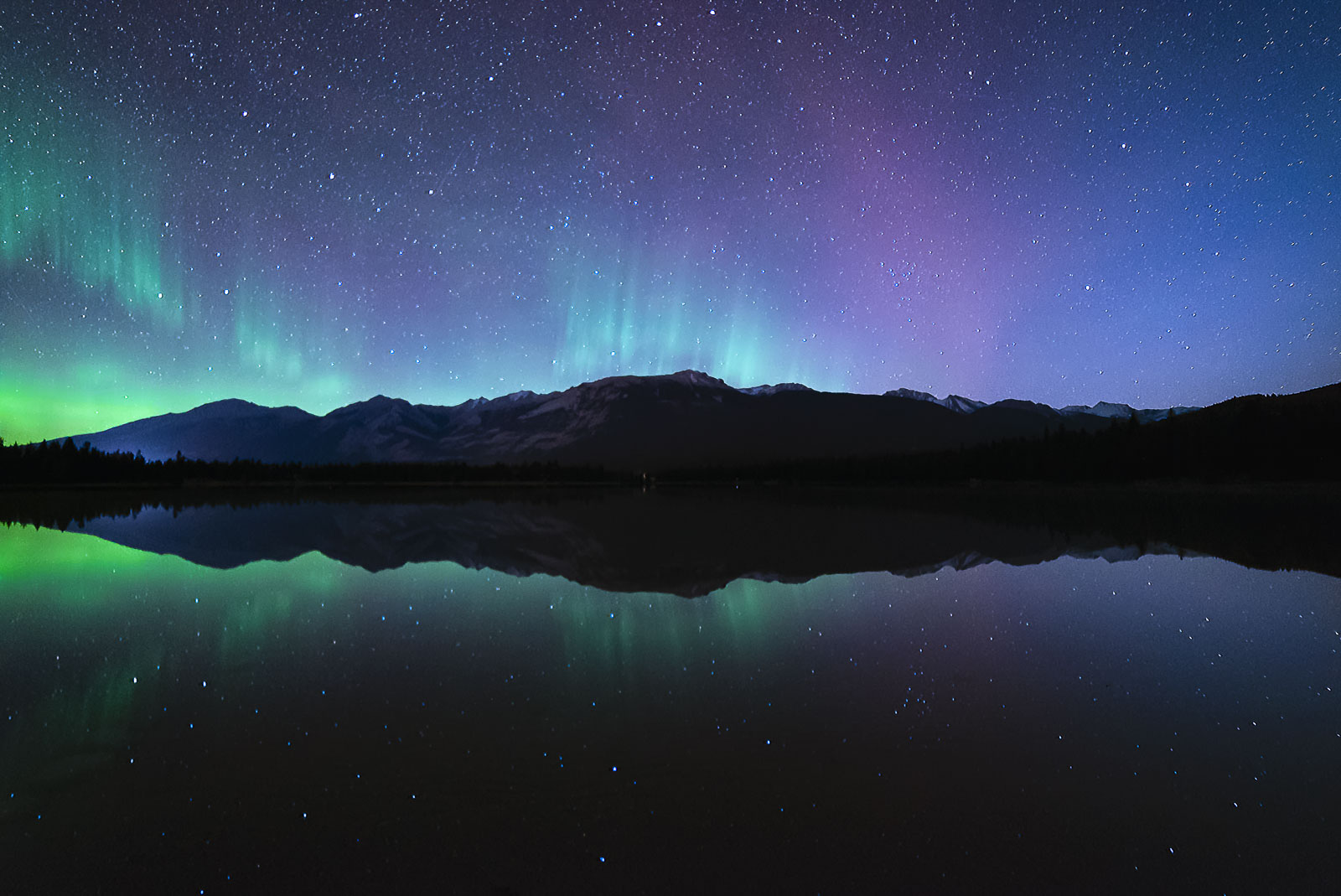
Alberta has many places to see dark skies, night stars, and the Aurora Borealis. Jasper is known for its dark sky preserve. It has unrivaled clear skies, and when staying at the Fairmont Jasper Park Lodge, we went to Lake Annette to photograph the night sky. That was when we were treated to the beautiful auroras ( northern lights ) dancing in the sky.
24. Side Car Motorcycle Tour
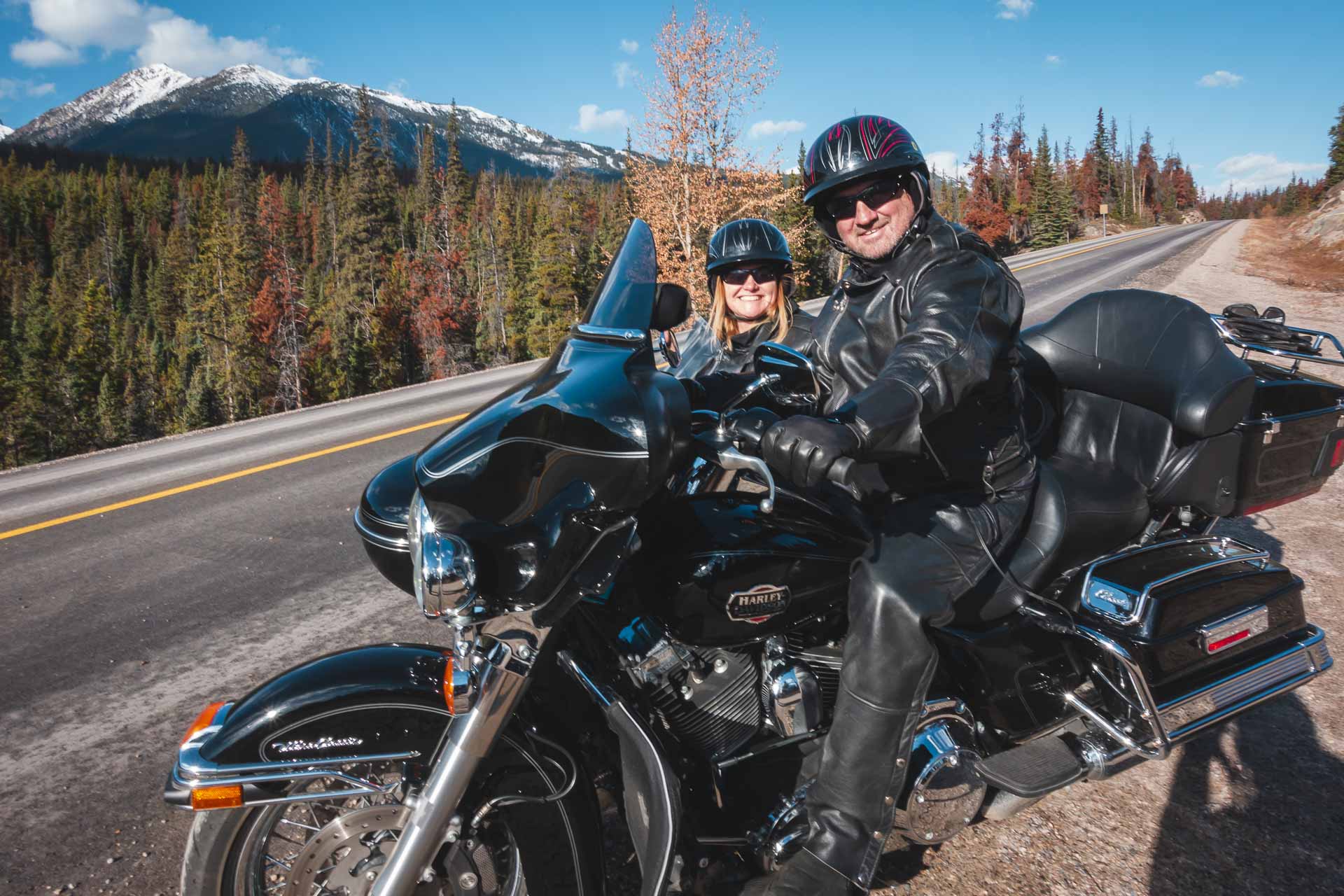
Our favourite excursion in Jasper is hands down the sidecar motorcycle tour. This is the coolest way to explore the roads of Jasper National Park. Hop in a Harley Davidson Motorcycle and take off to the high viewpoints of the Rocky Mountains from downtown Jasper. It’s one of the coolest and most unique things to do in Alberta that is for sure.
When driving to Jasper from Edmonton, keep an eye out for animals along the main highway. We saw bighorn sheep, bears and mountain goats on our way. This drive offered some of the best wildlife viewing in Alberta.
25. Canmore
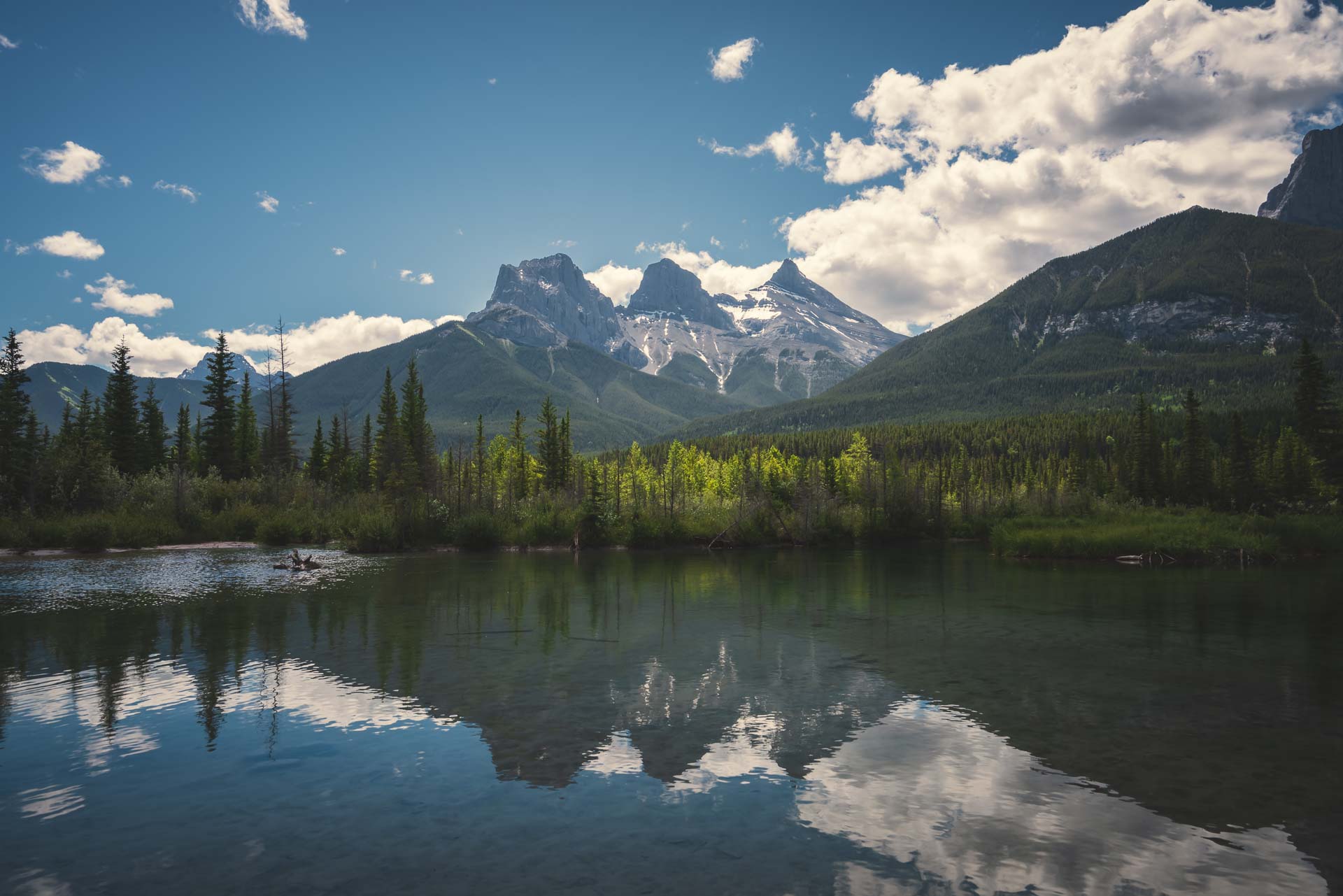
Canmore is located just outside Banff National Park and has turned into a destination unto itself. It can be used as a base to explore Banff National Park and Kananaskis but now Canmore has turned into a tourist town that has a lot of the attractions in Alberta in its own right. There are plenty of hiking trails, cross-country ski trails, and gorgeous viewpoints. There are so many things to do in Canmore you will need to split your time between here and Banff.

26. Yamnuska Wolfdog Sanctuary
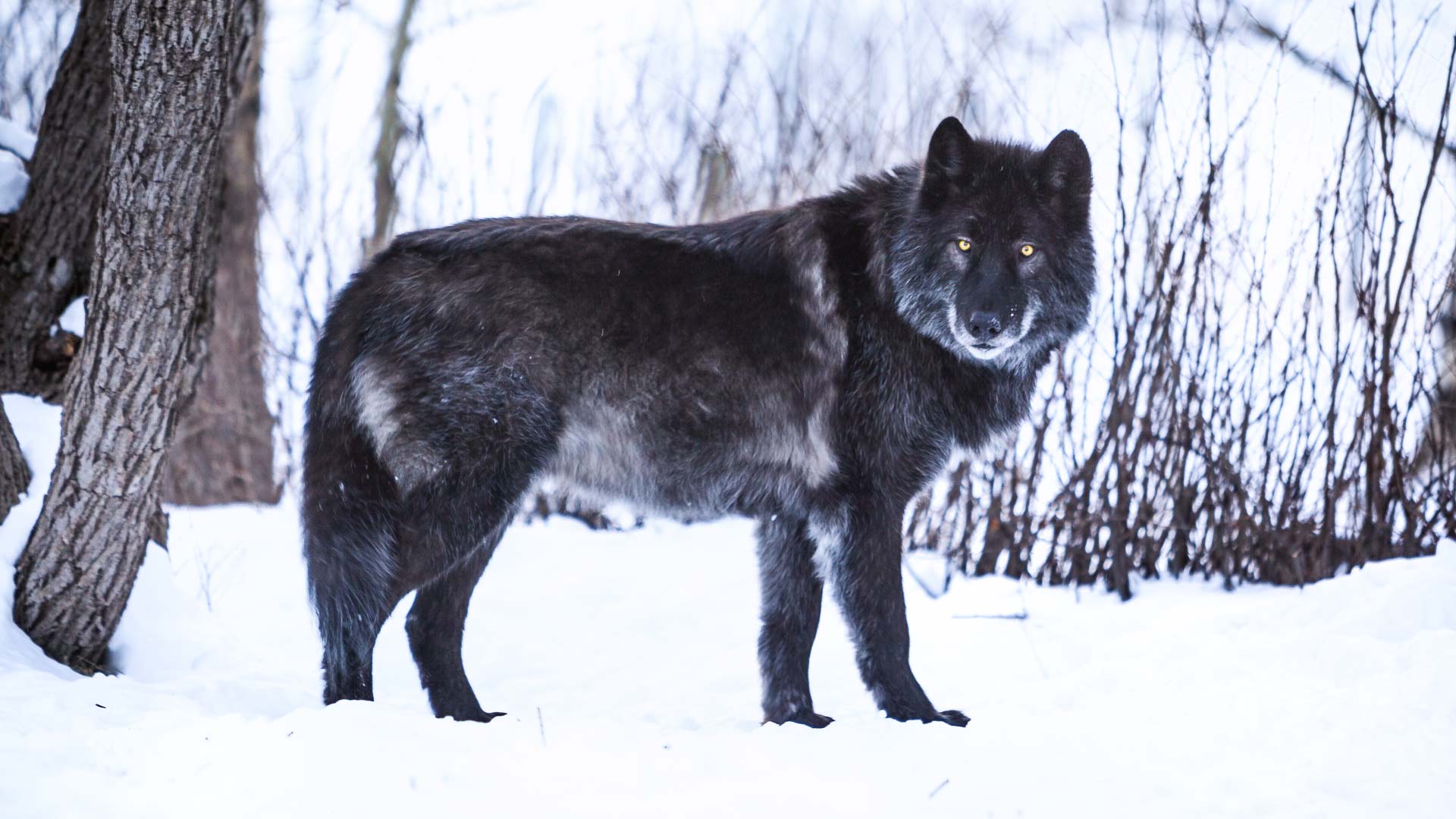
The Yamnuska Wolfdog Sanctuary is a rescue center for wolfdogs to rehabilitate abandoned and neglected wolf dogs. Wolfdogs are part wolf and part dog and often end up being too much for dog owners who don’t realize what is involved in owning a wild animal.
The sanctuary rehabilitates the dogs and finds them new homes. Visitors can sit with the wolfdogs and watch them interact and behave in their natural habitat. The wolfdog sanctuary is a magical experience visit their website for more details. Yamnuska Wolfdog Sanctuary
27. Rock Climbing
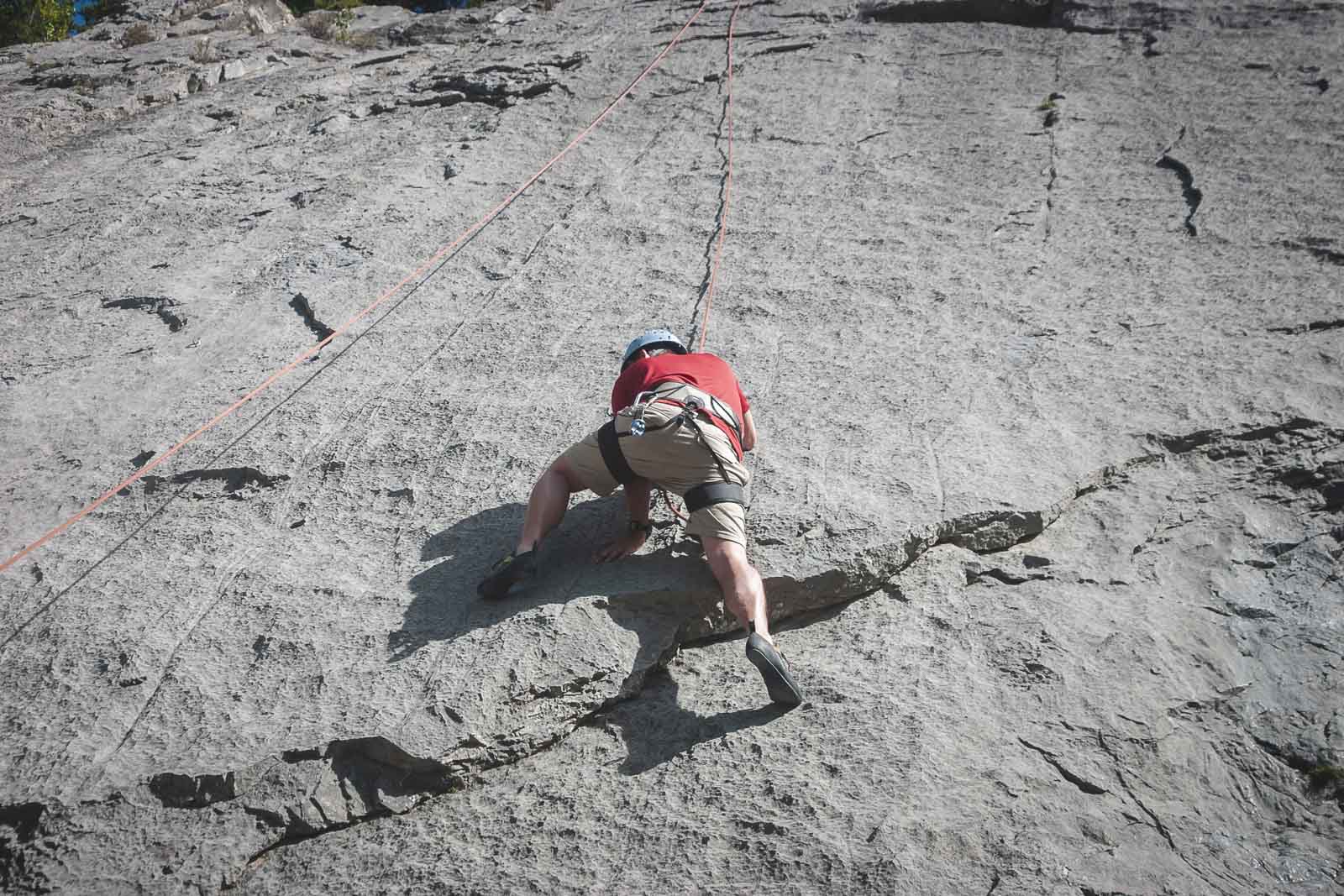
Alberta is home to some of the best rock climbing and mountaineering experiences on earth. When in Canmore, be sure to get out on a wall for some great sport climbing routes. Yamnuska Mountain Adventures in Canmore offers guided ice climbing and rock climbing excursions with professional Rock Climbers.
28. Ice Climbing
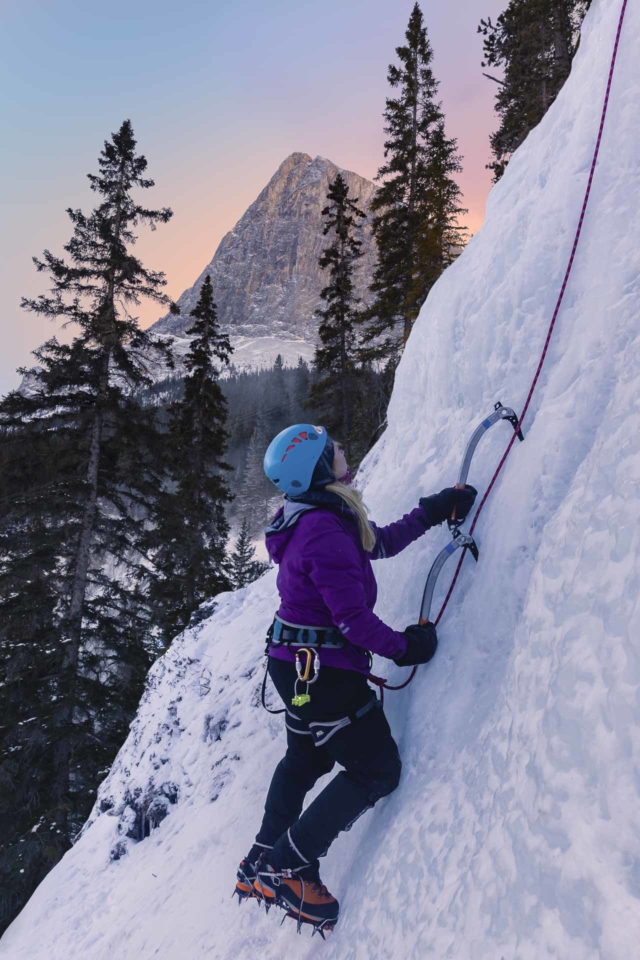
If you are looking for an adventure that gives you the ultimate adventure travel bragging rights, ice climbing in Alberta is a must. Canmore is the ice-climbing mecca of the world drawing top athletes to its routes each year to train and explore.
We’ve done both Rock Climbing and Ice Climbing in Canmore and they are both a thrill of a lifetime. Read more about ice climbing at Ice Climbing Adventure in Canmore
29. Skijoring
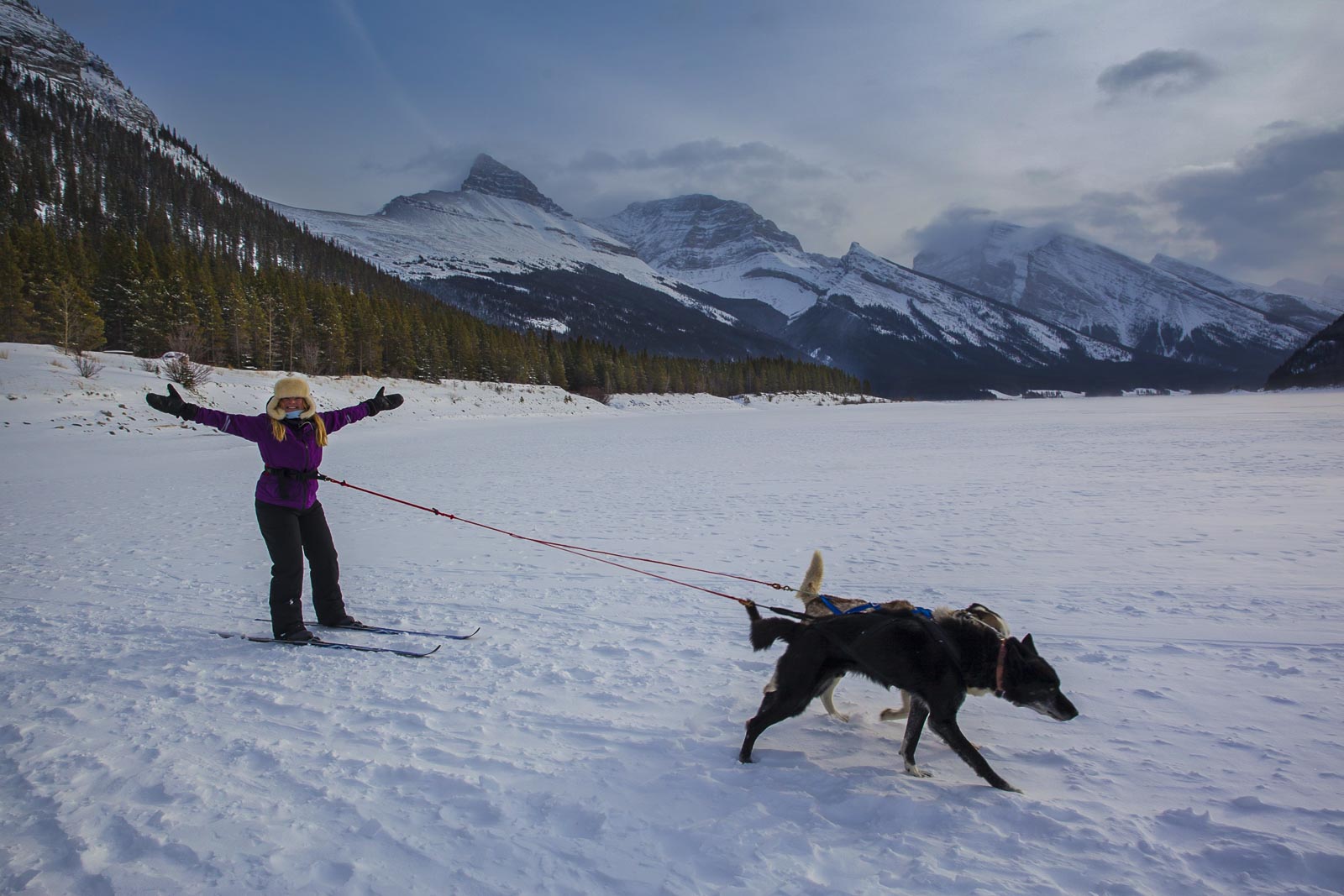
What on earth is skijoring you ask? It’s a mix between cross country skiing and dog sledding. Skijoring was invented in Norway, but Alberta has embraced it. We met Russell Donald of Mad Dog and Englishman Sled Dog Expeditions at Spray Lake outside of Canmore.
Skijoring was a thrill of a lifetime as two sled dogs pull you across the lake at breakneck speeds. Looking for more things to do in Alberta that involve dogs? See the Best Place to go Dogsledding in Banff
30. Scenic Flight over the Canadian Rockies
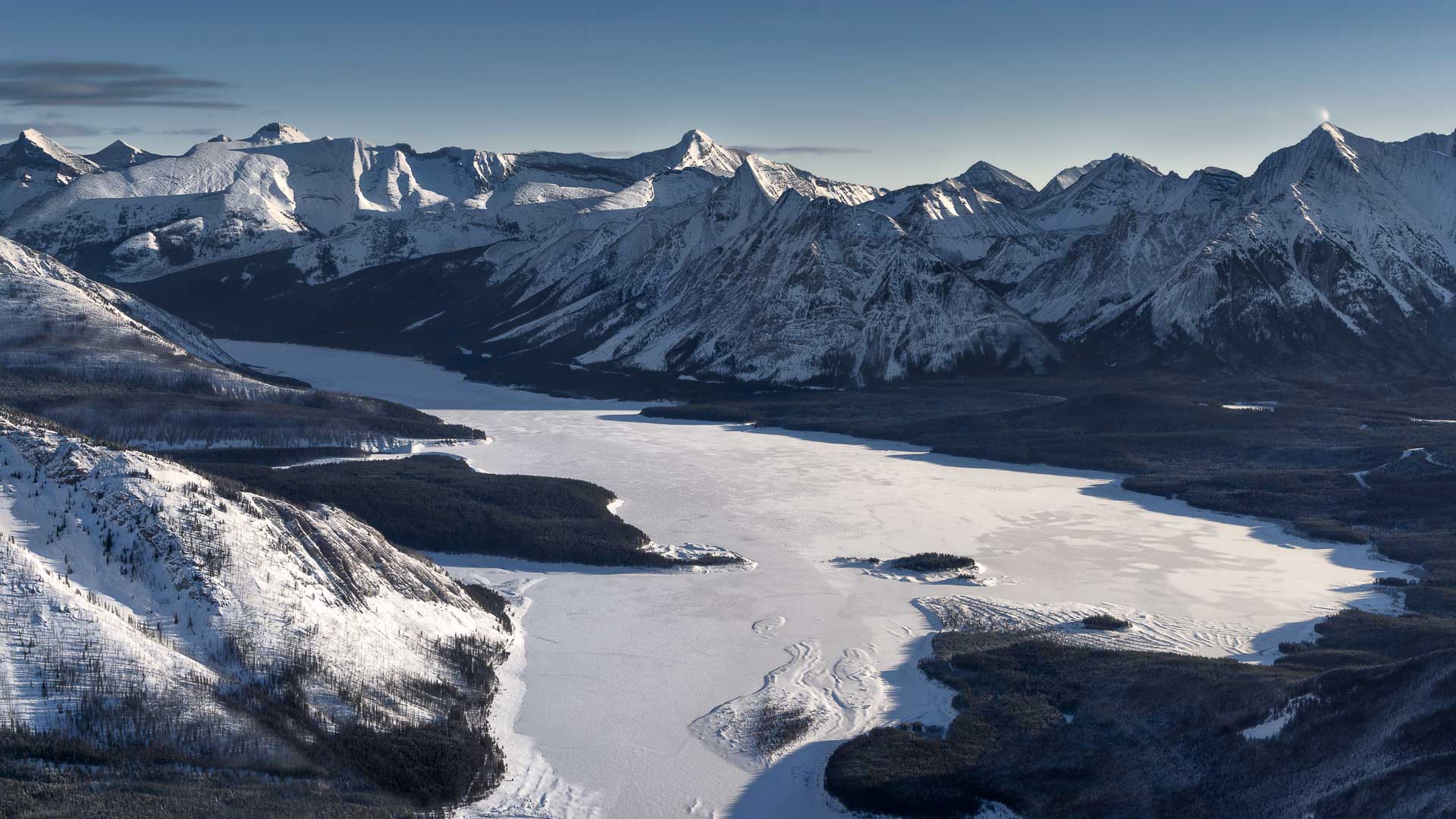
Located just an hour from Calgary and a short drive from Canmore or Banff, Rockies Heli is one of the premier helicopter tour companies in Alberta. Our helicopter tour took over Banff National Park to witness the famous peaks like Mt. Assiniboine, The Three Sisters, and Mount Lougheed.
This adventure offers the added bonus of landing on a peak just outside the park to go snowshoeing where nobody else dares to go. When landing a helicopter on the top of a mountain, you can be sure you won’t see crowds of people during your hike! Book your Alberta Helicopter tour with Rockies Heli located in two locations for your convenience
31. Snowshoeing
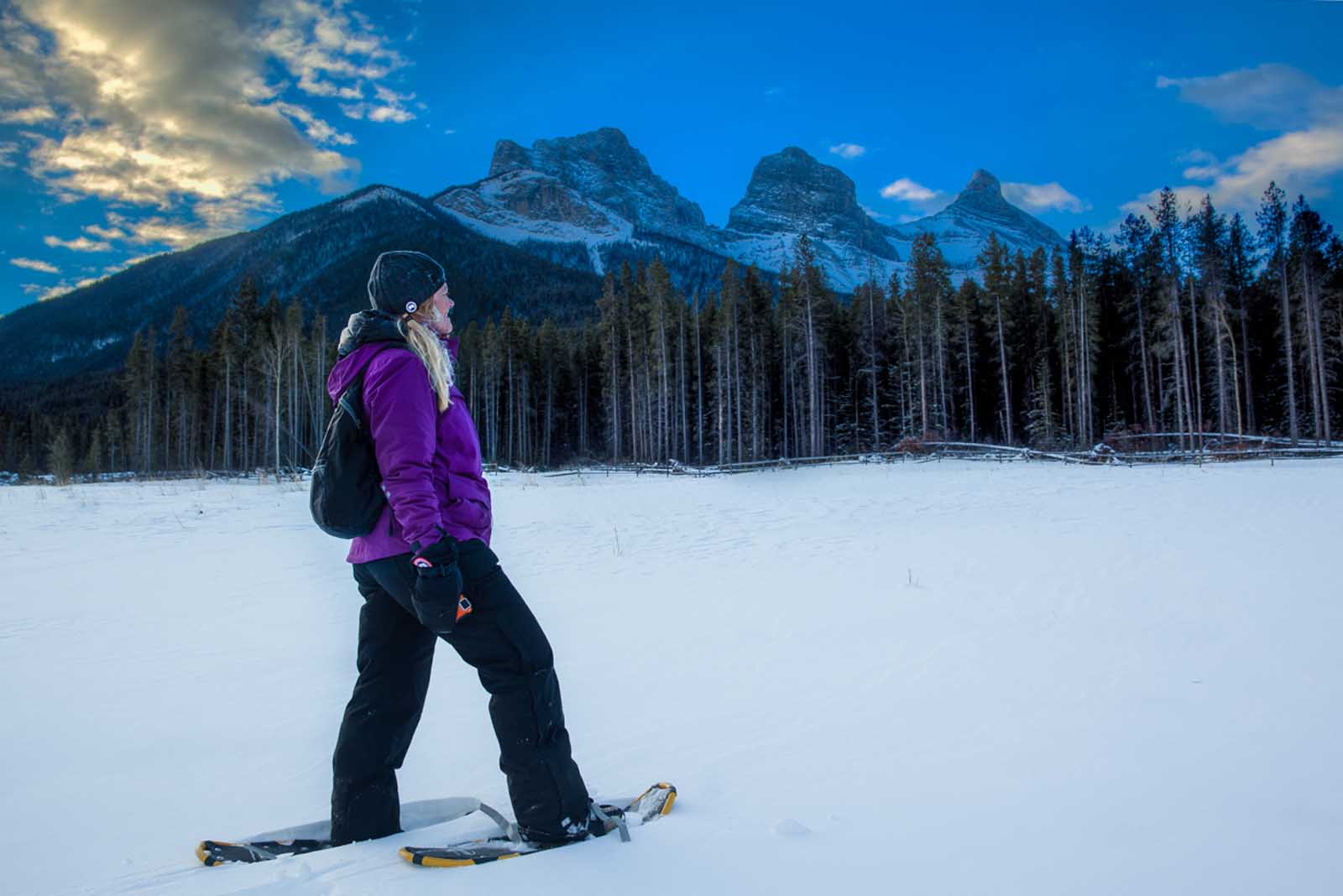
Canmore became popular as the population grew in Banff National Park. It’s now a town filled with outdoor lovers and very healthy people. You can do a lot of activities directly from town and we went snowshoeing from Canmore. It wasn’t long before we were surrounded by mountains and treated to spectacular views of the Three Sisters. If you are new to snowshoeing, hire a guide to take you out to the backcountry safely.
32. Southern Alberta
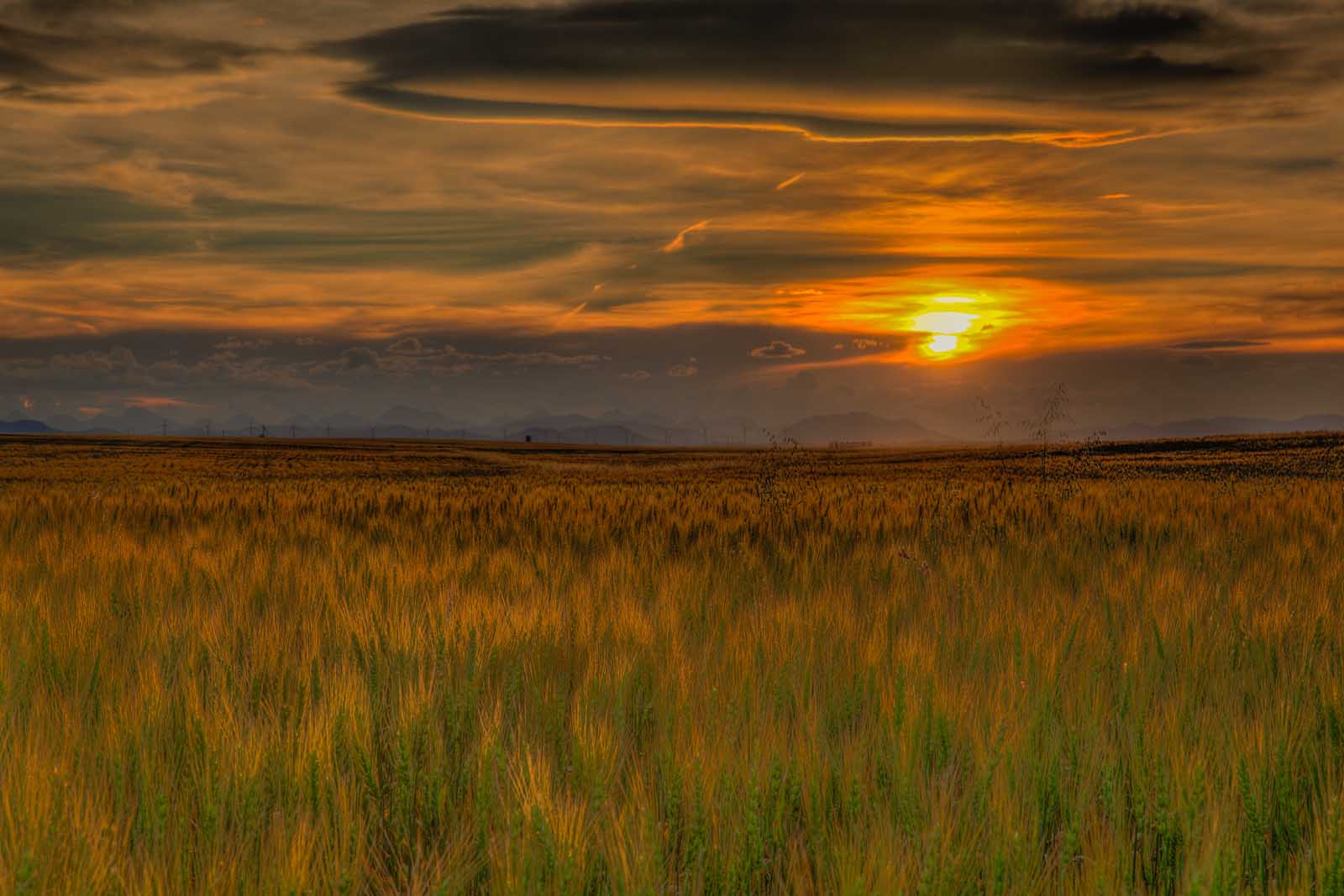
The south of Alberta will surprise and delight you. It is completely different from the more popular Banff and Jasper National Parks, but no less breathtaking or exciting. A road trip through this part of Alberta should be put at the top of every Alberta bucket list.
33. Bar U Ranch
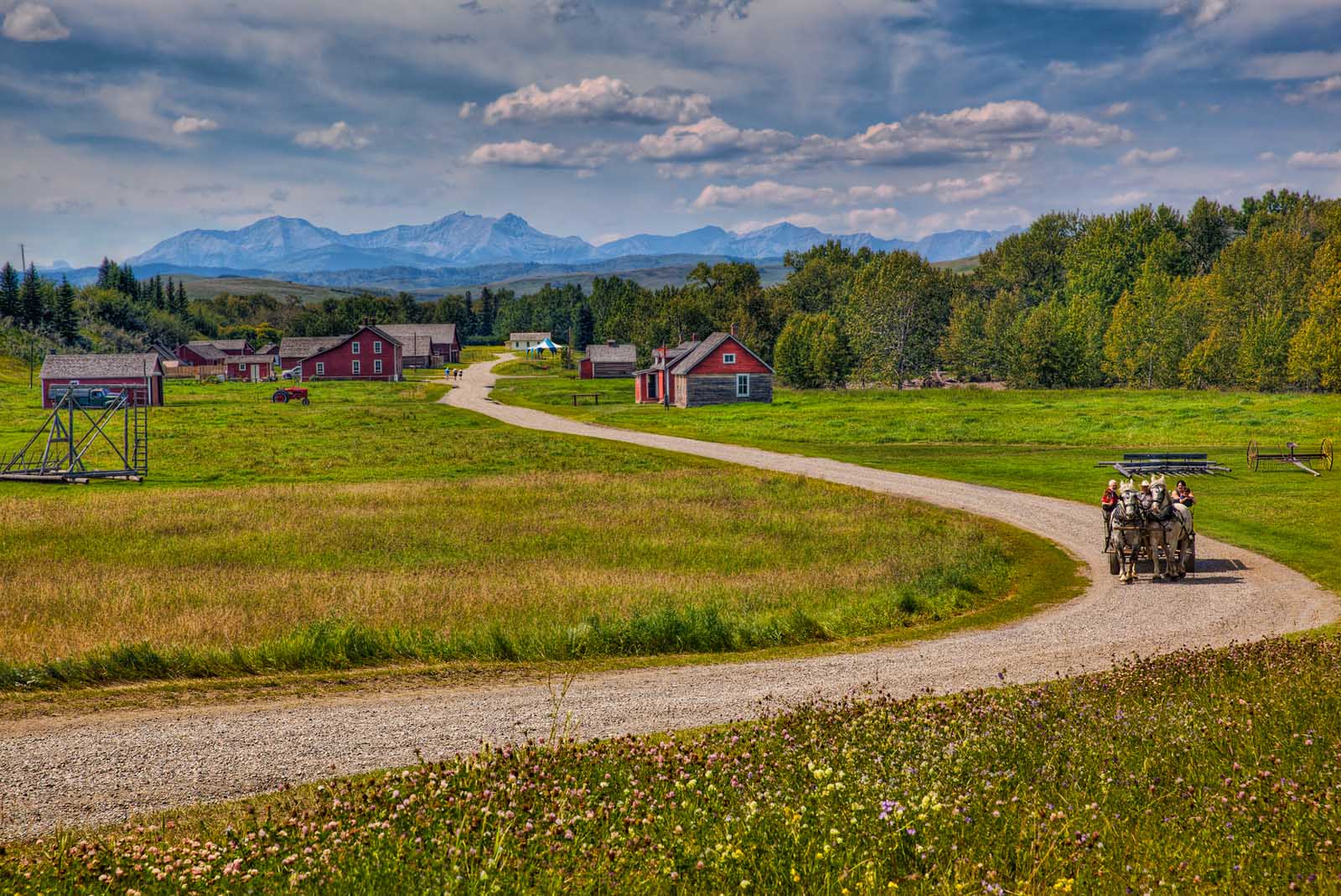
The Bar U Ranch is a National Historic Site and a very cool place to learn about Alberta’s Cowboy Heritage. This was once the largest ranch in North America spanning 160,000 acres and had 30,000 heads of cattle. The Sundance Kid worked on the Bar U Ranch and the Prince of Wales loved the setting so much, he bought a ranch right next door! Have a cowboy coffee, try your hand at the lassoo and learn everything about Ranch Life.
- Cool Fact: Deb lived on the Bar U Ranch when she was born. Her dad was the head ranch hand!
- Read about it here: Back to my Roots at the Bar U Ranch in Alberta Canada
34. Waterton Lakes National Park
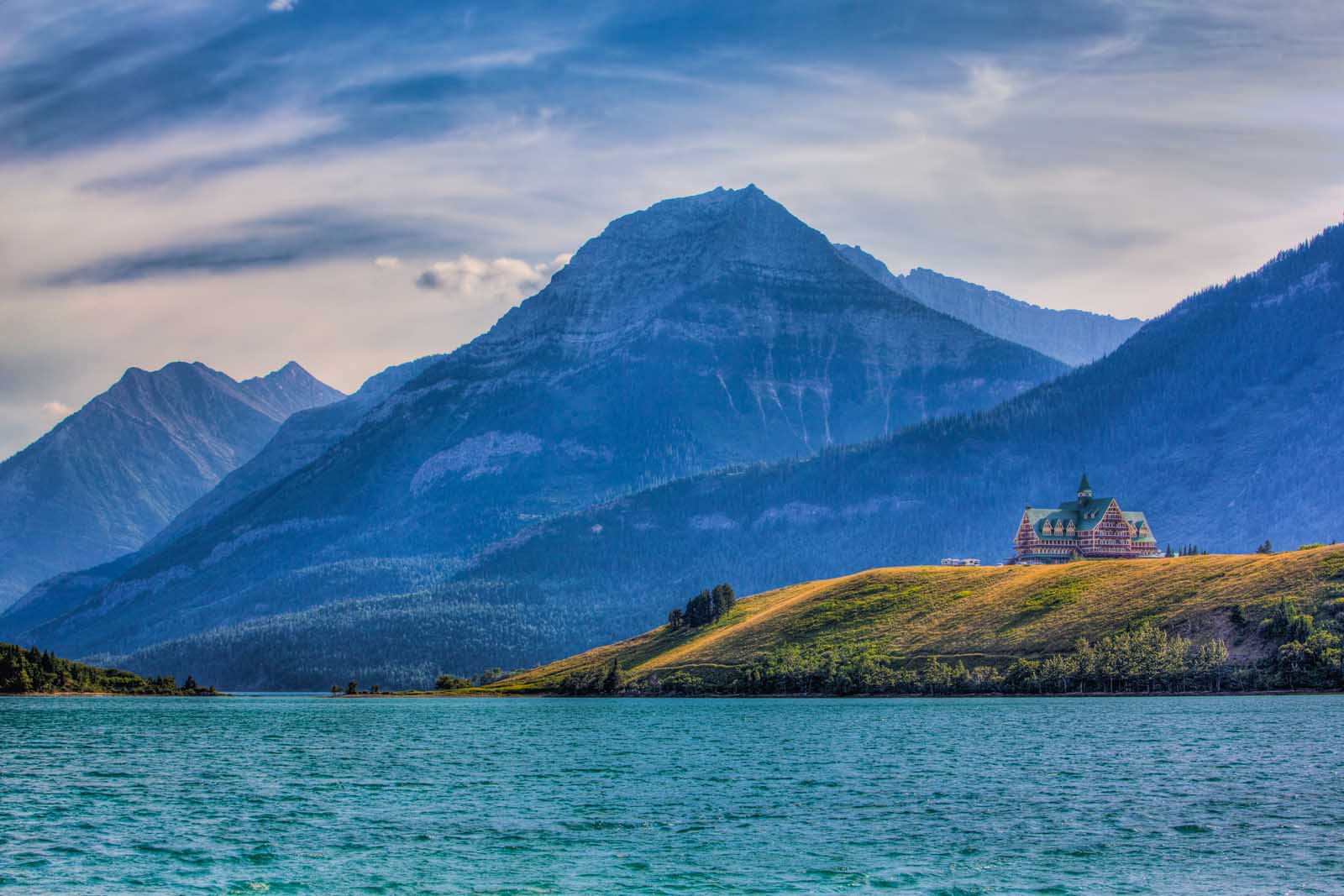
It may not be as famous as the national parks of Banff and Jasper, but Waterton Lakes National Park is one of the most extraordinary. This park is unique in the fact that it shares a border with Glacier National Park in the United States. Together, the two parks create the only UNESCO World Heritage Site, International Peace Park, and a Biosphere Reserve rolled all in one. It is here that you can see herds of buffalo roaming and head out on one of the extraordinary hikes into the foothills of the mountains. Book a night at the Prince of Wales Hotel located within the park for a truly royal experience.
35. Red Rock Canyon
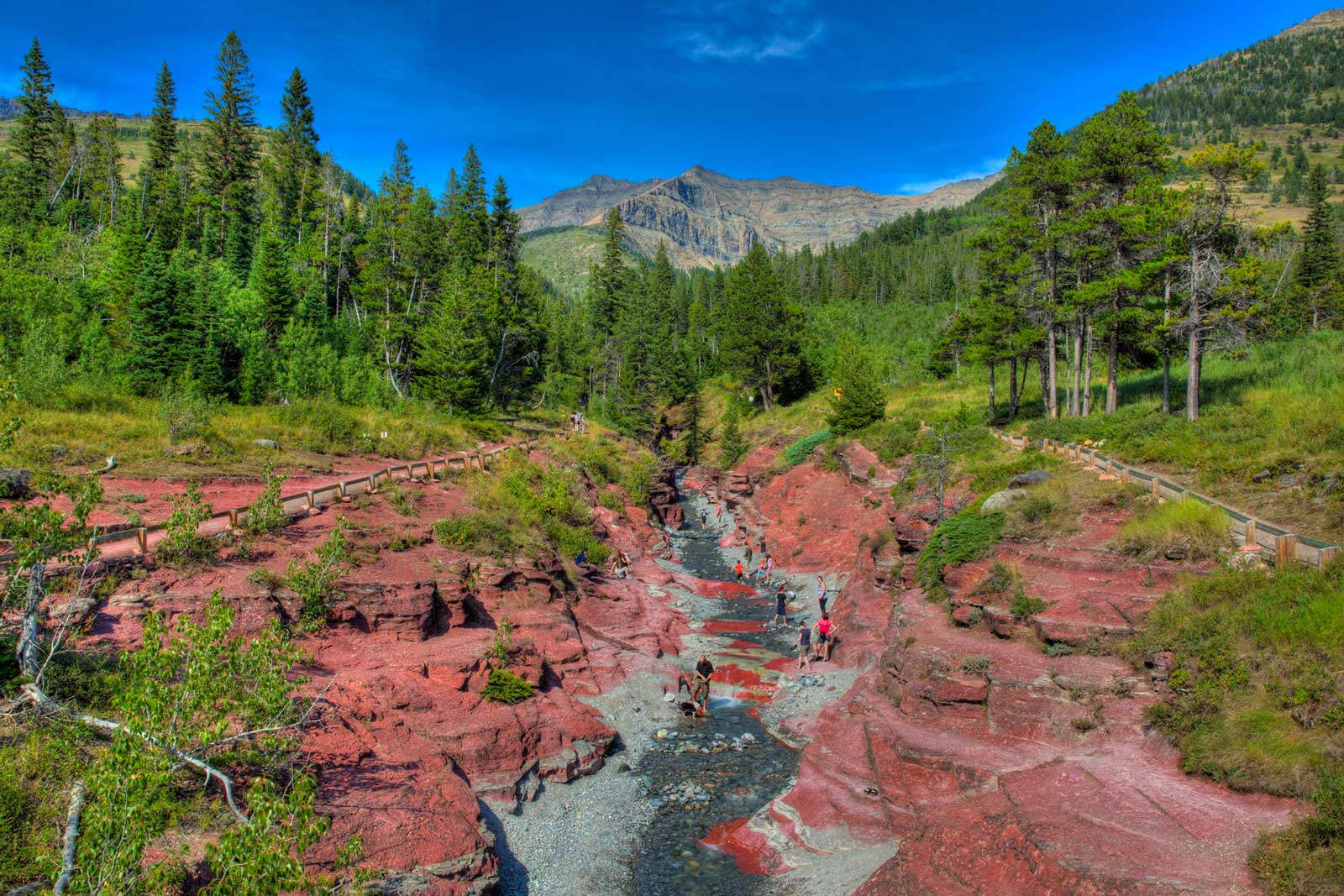
Make sure to visit Red Rock Canyon, the grand canyon of Alberta. There are some great hikes here and if you pair it with Waterton, you can easily spend a few days here. Read more: Things to do in Waterton Lakes National Park
36. High Mountain Trail Ride
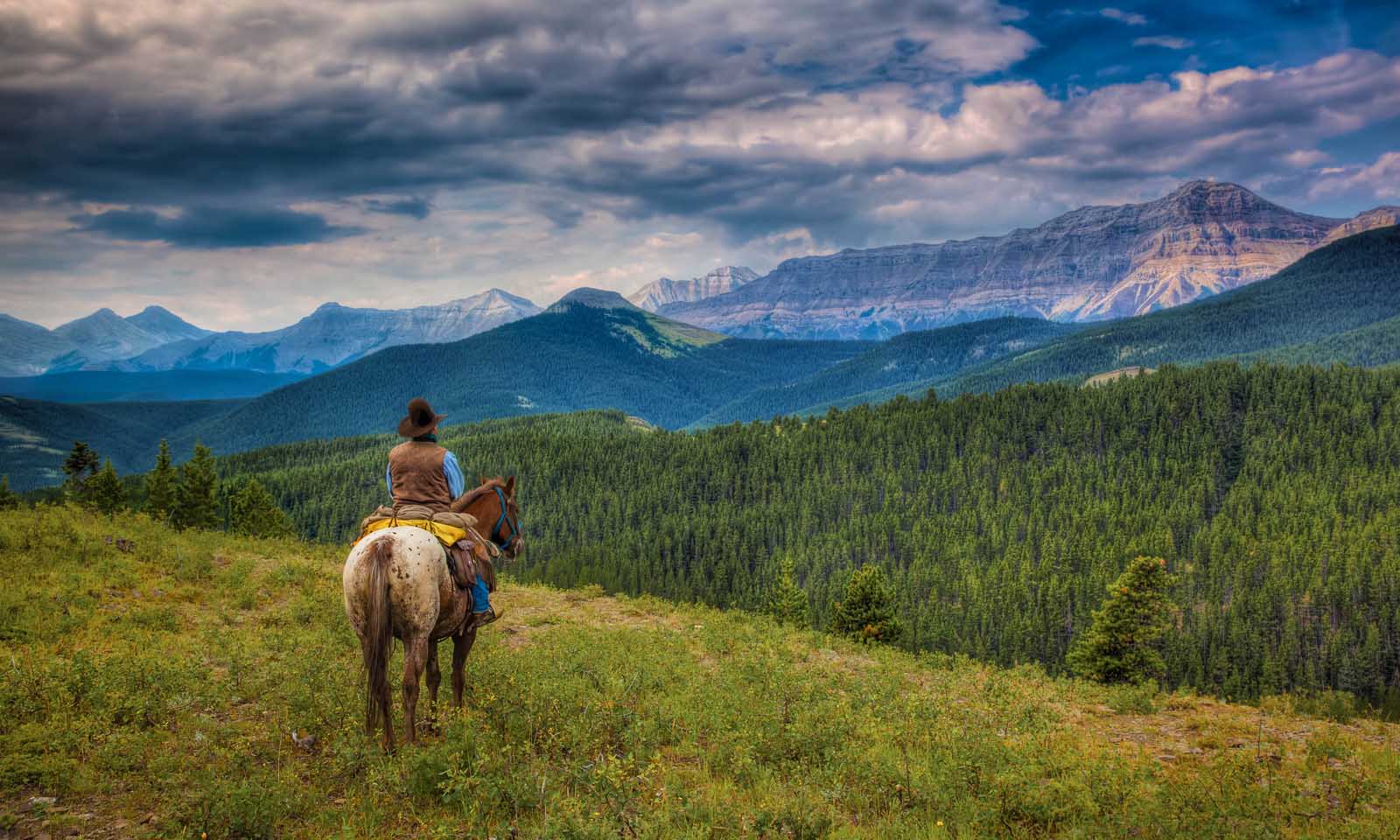
No trip to Alberta would be complete without riding a horse. This is horse country and in the foothills of the Rocky Mountains, you can take one of the best trail rides you’ll ever have in your life. Sure, you’ve taken a trail ride in other places, but in Black Diamond Alberta, a high mountain trail ride takes you into the foothills. Hop on a sure-footed horse and bushwhack your way up a mountain trail pass to the backcountry of Alberta. If there is one time in your life to go horseback riding, this is it! Read about it here A High Mountain Trail Ride, Black Diamond Alberta
37. Crowsnest Pass
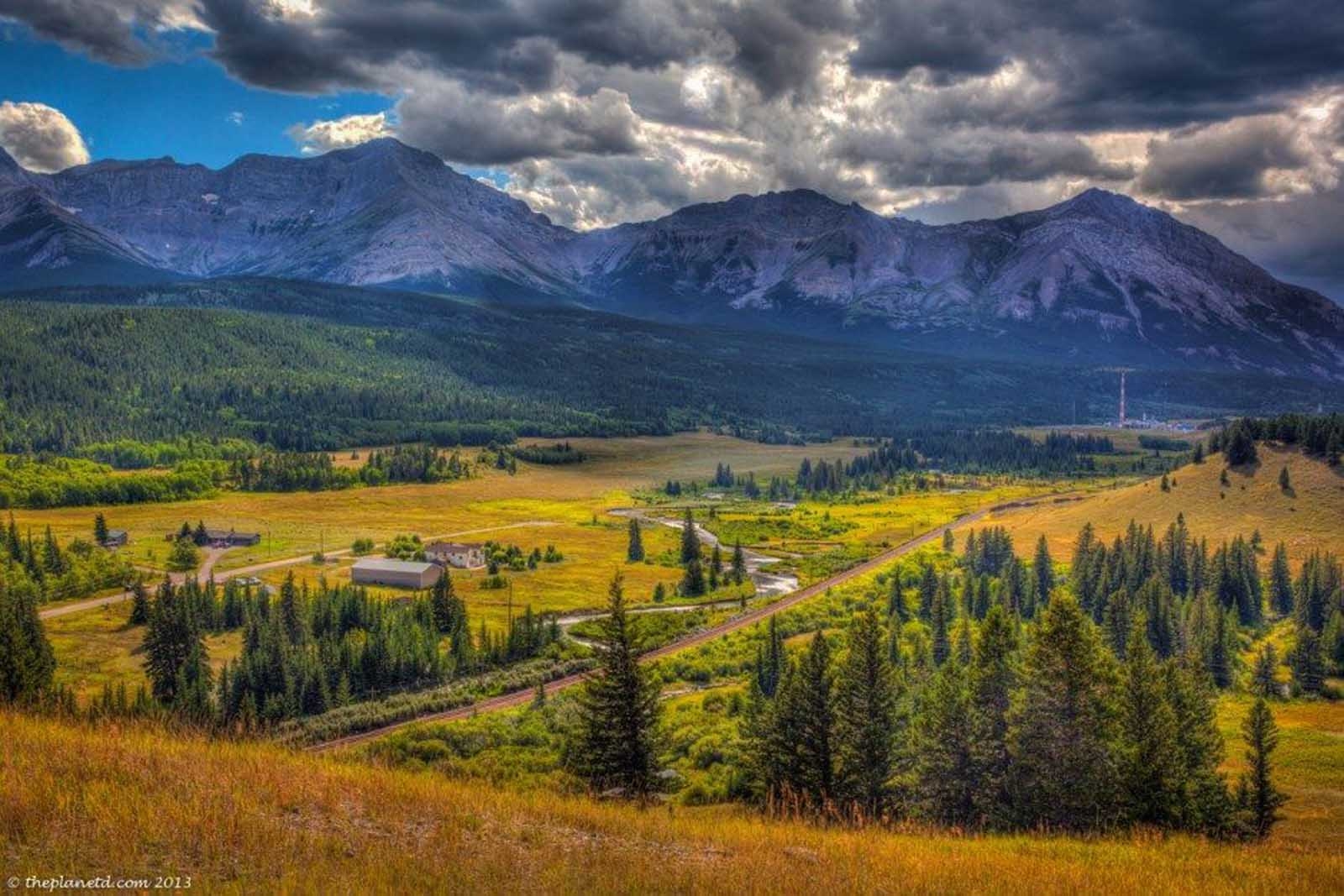
Crows Nest pass is a mountain pass along the continental divide where Alberta meets British Columbia . It is an interesting drive along this route with some cool sites to see! Read more: Things to do in Pincher Creek, Alberta
38. Frank Slide
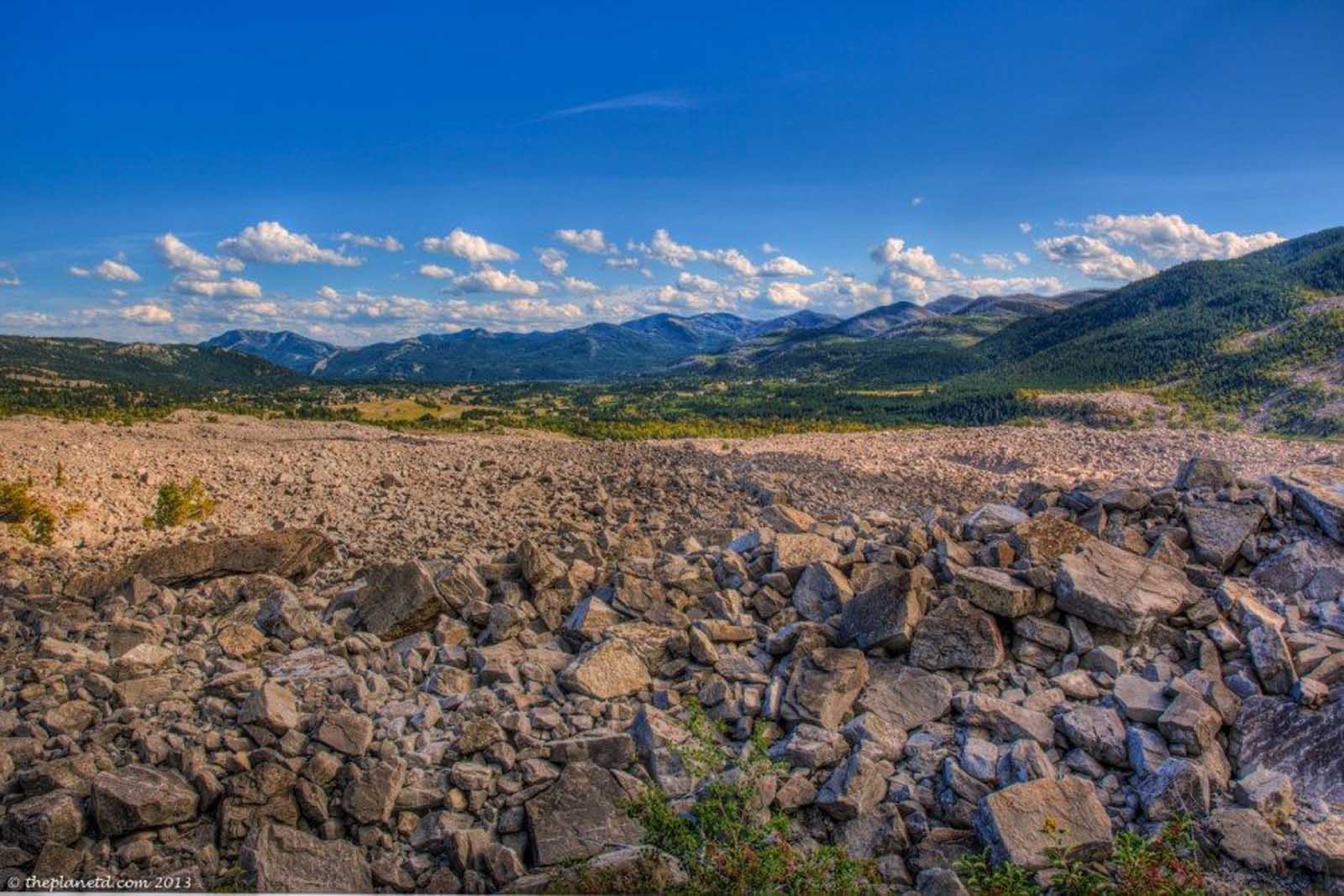
When stopping at the home of one of Canada’s most deadly natural disasters, you really see the power of Mother Nature. In 1903 the town of Frank was buried under 110 tons of rocks that broke off from Turtle Mountain. Looking out from the interpretive center shows just how far the rock slide traveled and how the town never stood a chance. 90 people lost their lives that fateful day. You can walk along paved trails to see the devastation up close.
39. Photograph the Burmis Tree
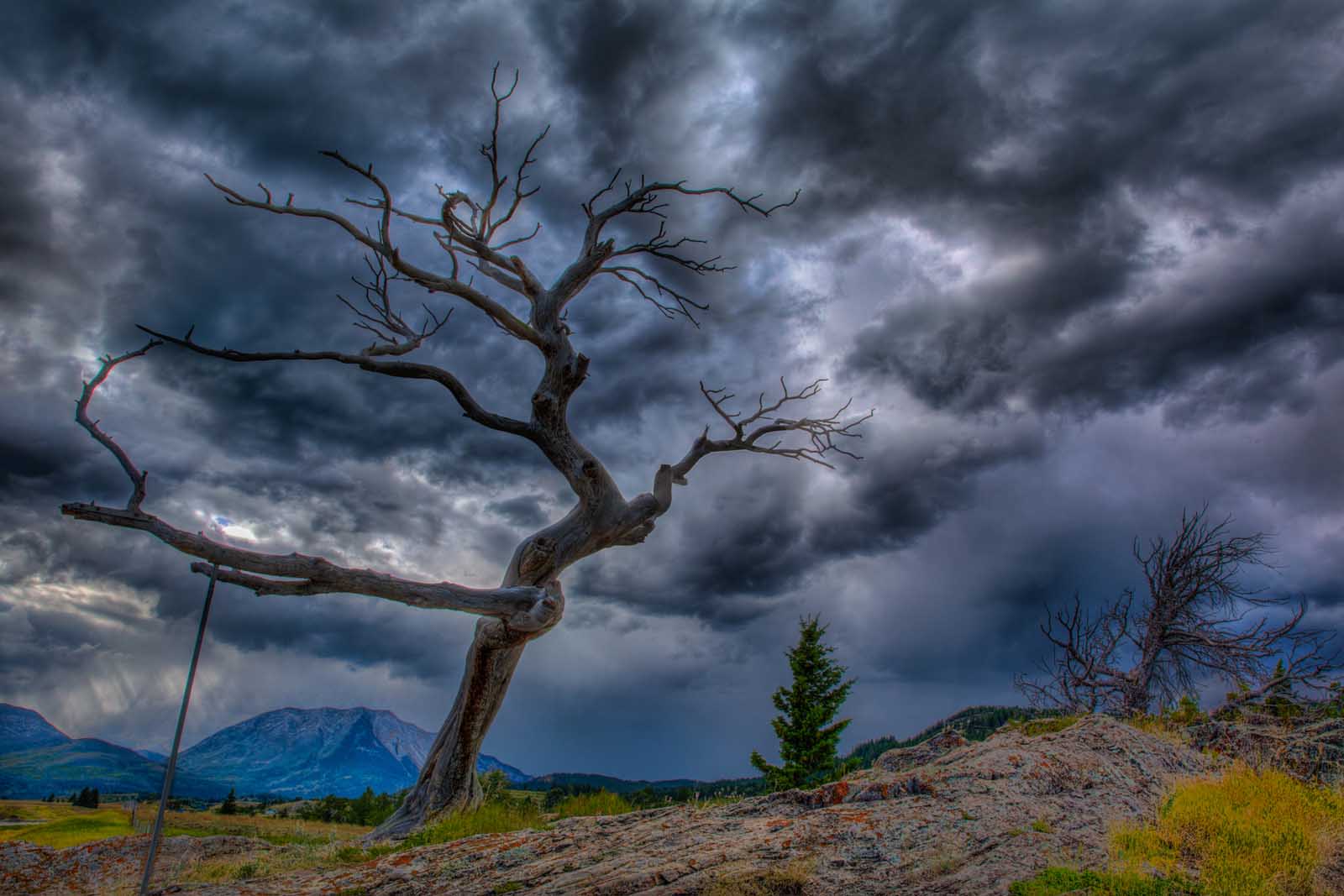
One of the most unique things to see in Alberta is the lone Burmis Tree standing at the entrance to Crowsnest Pass. This tree is a symbol of endurance for the people of the region. At years old, it is hanging on by a thread. Or I should say wire. The tree died years ago, but residents loved it so much, they saved it by wiring it together with stainless steel brackets to stabilize the roots. See it before it is too late!
40. Head Smashed in Buffalo Jump

Although it isn’t the most exciting thing to see in Alberta, it is a very historic place to visit. Head Smashed in Buffalo Jump Interpretive Centre, It’s a UNESCO World Heritage Site and an interesting stop. 6000 years of history of Plains Buffalo culture happened on this site where prehistoric plains people lured herds of buffalo to the edge of a cliff where they met their fate.
41. Writing on Stone Provincial Park
Writing on Stone Provincial Park is sacred to the First Nations of Alberta as it is a nature preserve containing many First Nations carvings. Located in the Milk River Valley, these carvings show evidence of life dating back 9000 years. It is a beautiful park with hoodoos and towering cliffs. There is a recreation of an RCMP outpost in the park commemorating the mounted police who patrolled the border in the late 1800s to prevent whisky smuggling
42. Canadian Badlands
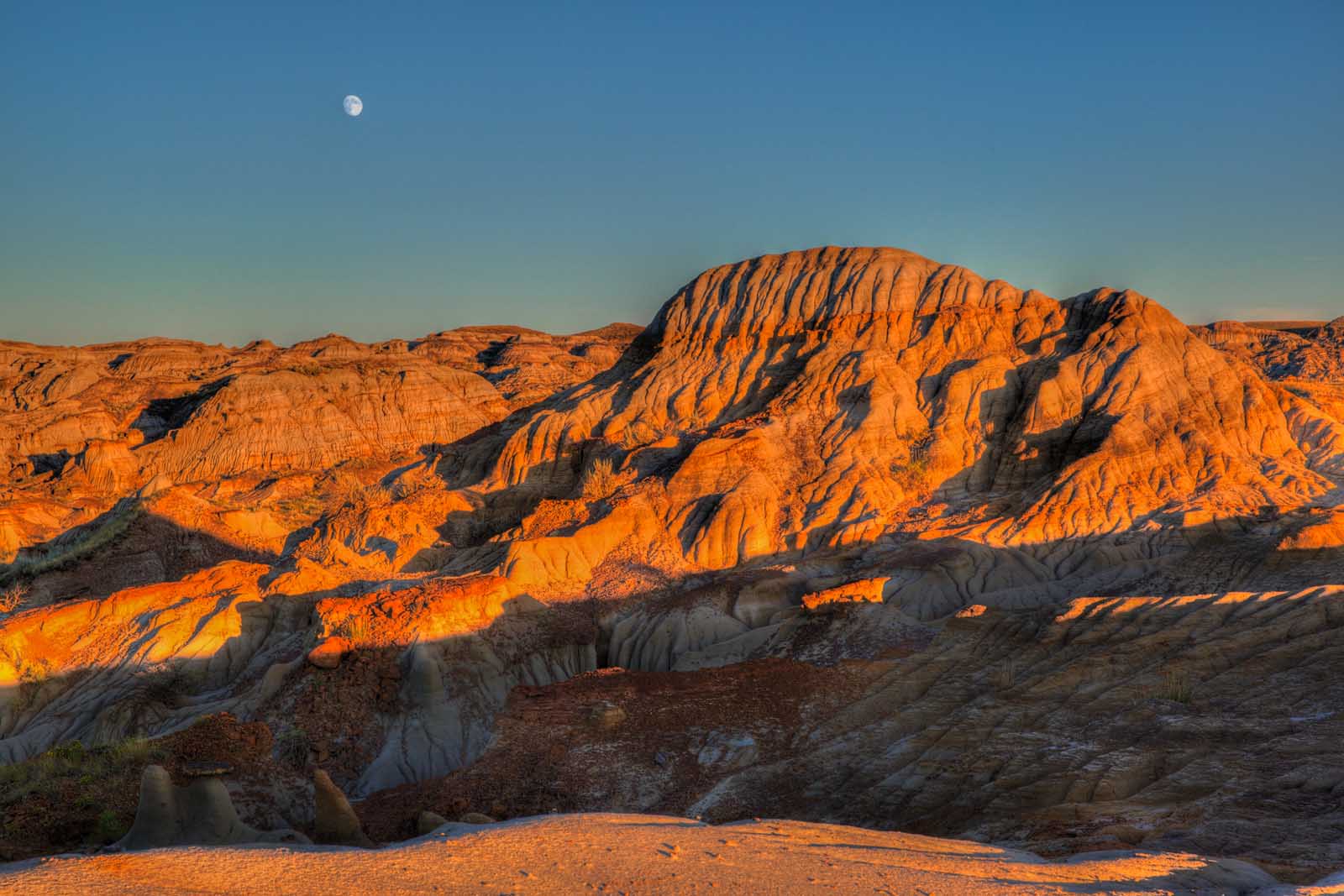
Often overshadowed by Banff and Jasper when planning things to do in Alberta, the Alberta Badlands are one of the most beautiful places to visit in the province. There are so many attractions in Alberta and these are the best in the badlands!
43. Dinosaur Provincial Park
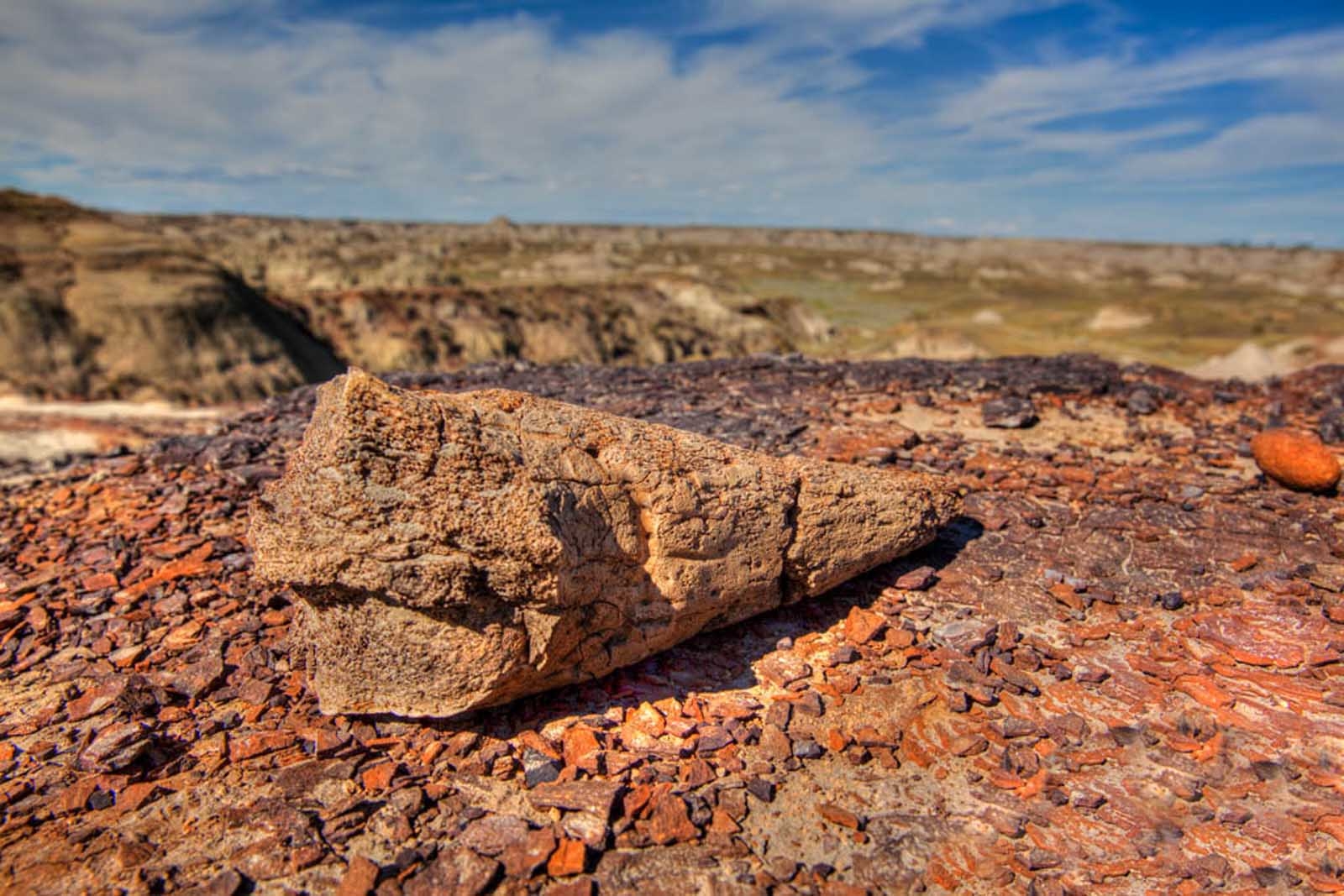
Dinosaur Provincial Park is a UNESCO World Heritage Site housing one of the largest dinosaur excavations sites on the planet. Around 75 million years ago, dinosaurs ruled this land. You can take a guided hiking tour to an excavation site to see dinosaur fossils. Be sure to stay in the park in one of the glamorous camping tents. It’s an amazing experience. Read about it here: Dinosaur Provincial Park – Glamping Tour in the Alberta Badlands
44. Drumheller Valley
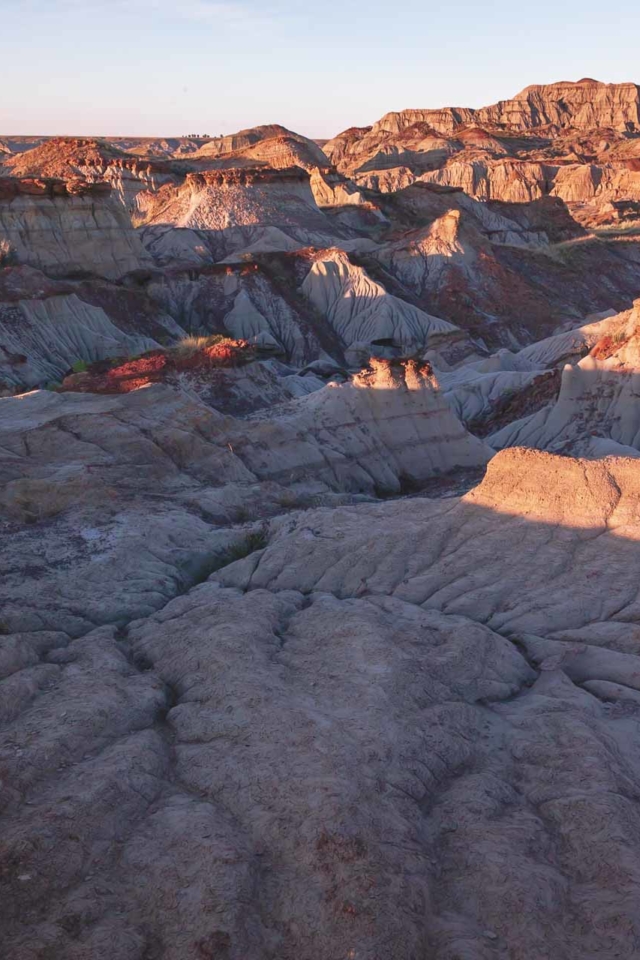
One of the best drives in the province is the Dinosaur Trail from Dorothy to Drumheller. Drumheller is a small town located just 90 minutes from Calgary and there is so much to do there. Spend a day or two in town to explore all of the sights of the Drumheller Valley like Horsethief Canyon, the Atlas Coal Mine, and the last chance saloon. This is where you’ll really feel like you’ve stepped into the wild west.
45. Hoodoos of Drumheller Valley
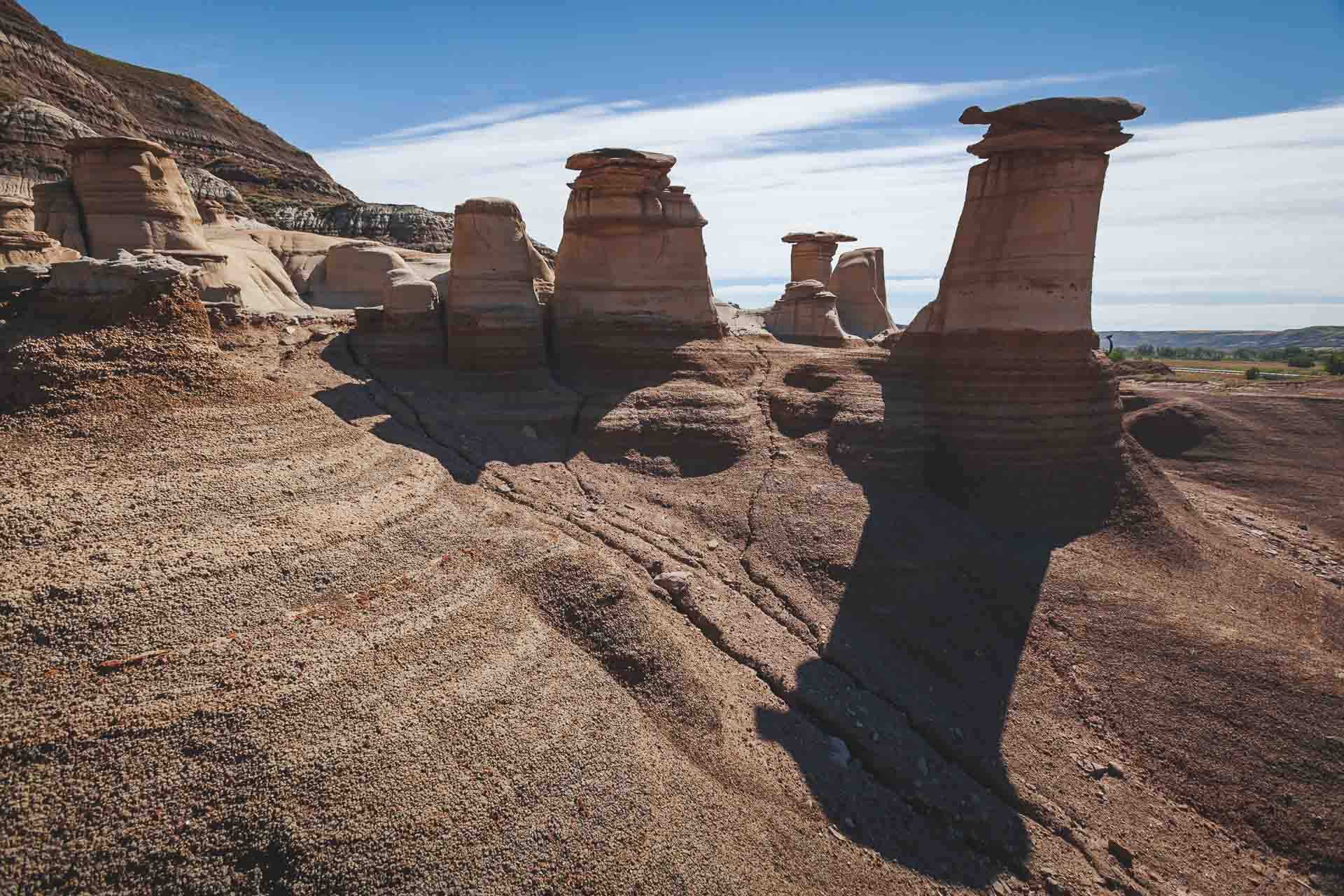
One of the most amazing sites in Alberta is the Hoodoos of Drumheller Valley. There are hoodoos throughout the badlands, but these are the most distinct and perfect hoodoos you’ll ever see in your life. Located directly on the side of the road, these fragile formations are formed over hundreds of years through erosion. This tiny cluster is a wonderful display of the beauty of Mother Nature. Read more about The Hoodoos of Drumheller
46. Royal Tyrrell Museum
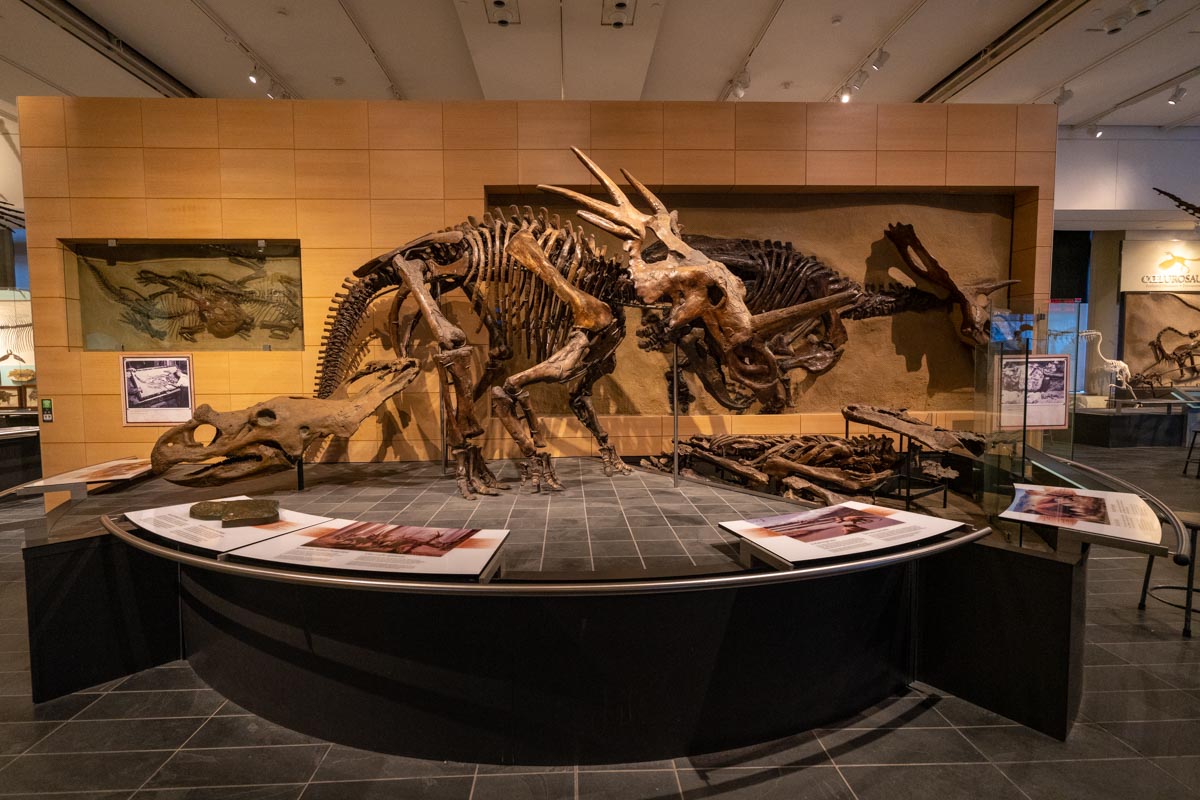
One of the best museums we’ve ever been to is the Royal Tyrrell Museum. We’ve seen a lot of dinosaur bone recreations in museums around the world, but this one has the real deal on display! Here you’ll see one of the best-preserved authentic T-Rex skulls in the world among the large dinosaur collection on display in Dinosaur Hall. And there are archeologists working in a lab on sight. Read more: Things to do in Drumheller, Alberta
47. Calgary, Alberta
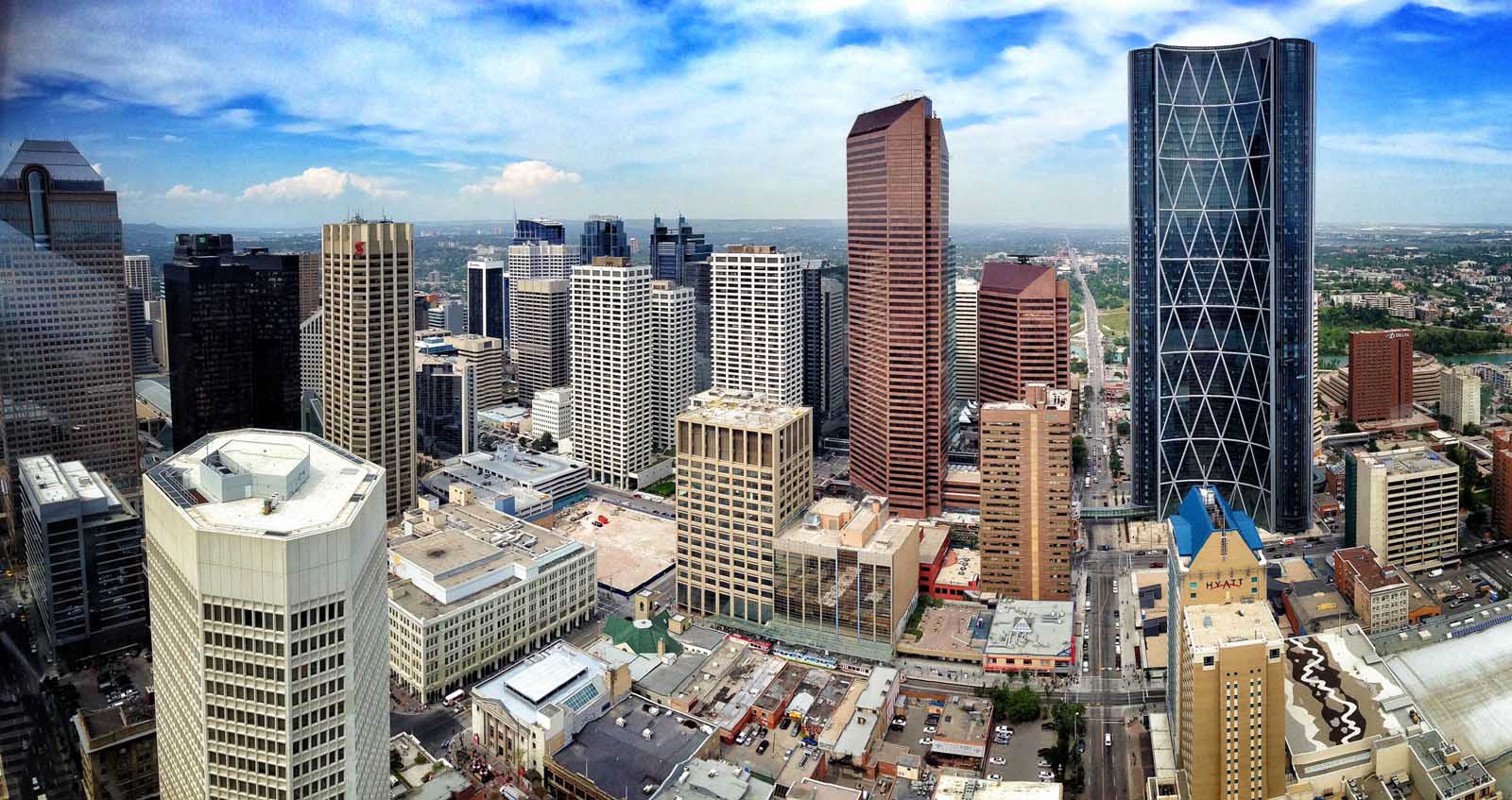
Calgary is the biggest city in Alberta and there are a ton of things to do downtown Calgary. It warrants its own article which we have right here: 21 Best Things to do in Calgary, Alberta . This Western Canada city has plenty of outdoor activities, urban adventures, an excellent food scene and it hosts the annual Calgary Stampede. This is a city that you must visit when exploring Alberta.
48. Bobsleigh – Canada’s Olympic Park
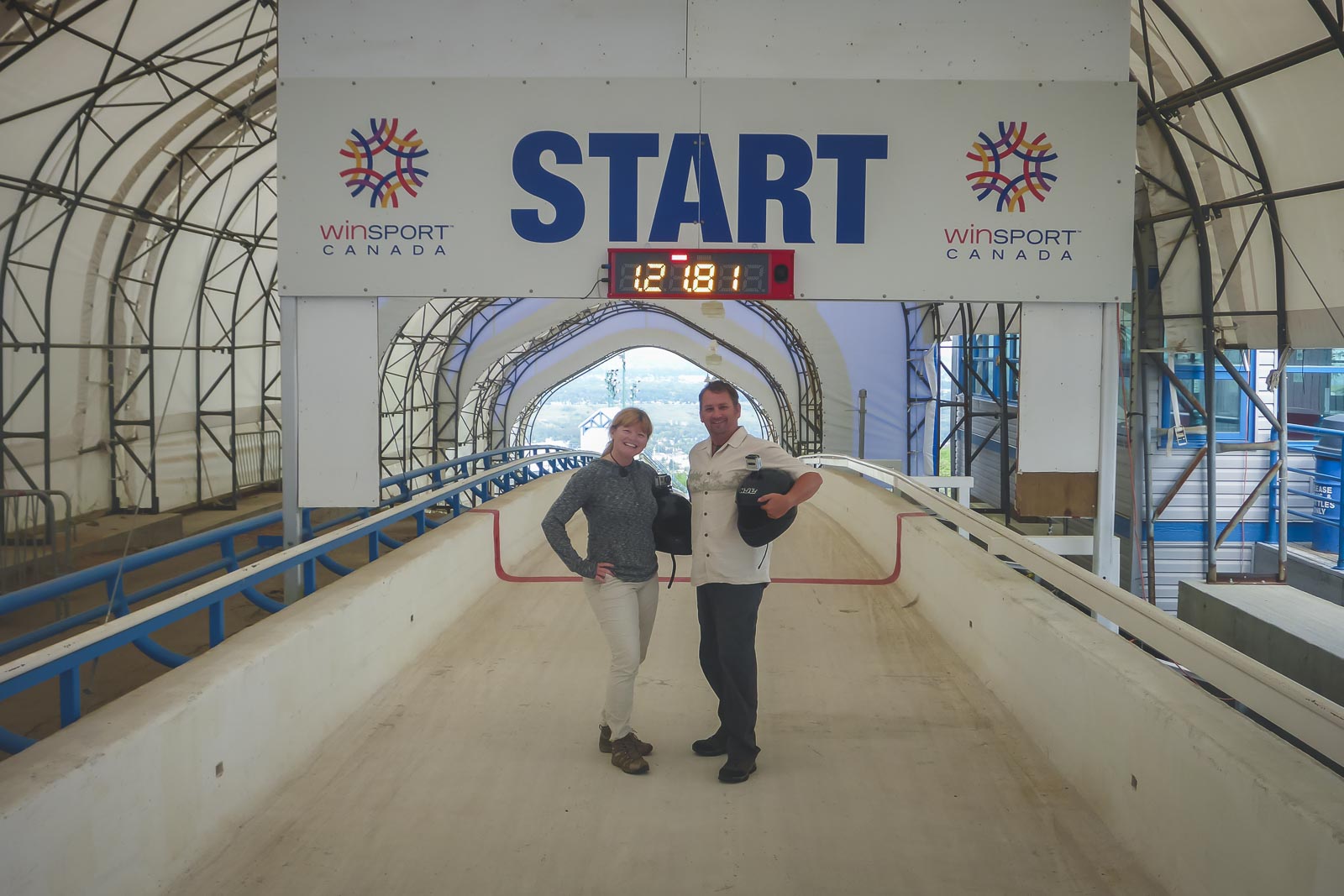
Who thought they’d ever get the chance to hop in a bobsleigh and barrel down the pipe with an Olympic athlete at steering the sled? Bobsledders from around the world train at Calgary’s Canada Olympic Park and to make some money on the side, they take tourists down their home track! Feel the G-force push you down as you reach speeds of 125km per hour while banking the icy turns as you plunge down the World Cup track. See our experience at Whipping Through the Olympic Village in Calgary
49. World’s Fastest Zipline
At the park you’ll also be able to ride the world’s fastest zipline. This zipline is so fast you need to pull a parachute out when you land! Taking off from the top of the big Olympic ski jump, this zip line is a thrilling experience! I can only imagine the courage ski jumpers have flying off this ramp. A Zipline was enough for me! We also took the luge down to the parking lot once we finished our extreme sports. There’s mountain biking at the park, a museum and hiking trails, so make a day out of it! Read more: Canada Olympic Park – Fun in Calgary Alberta
50. Calgary Tower
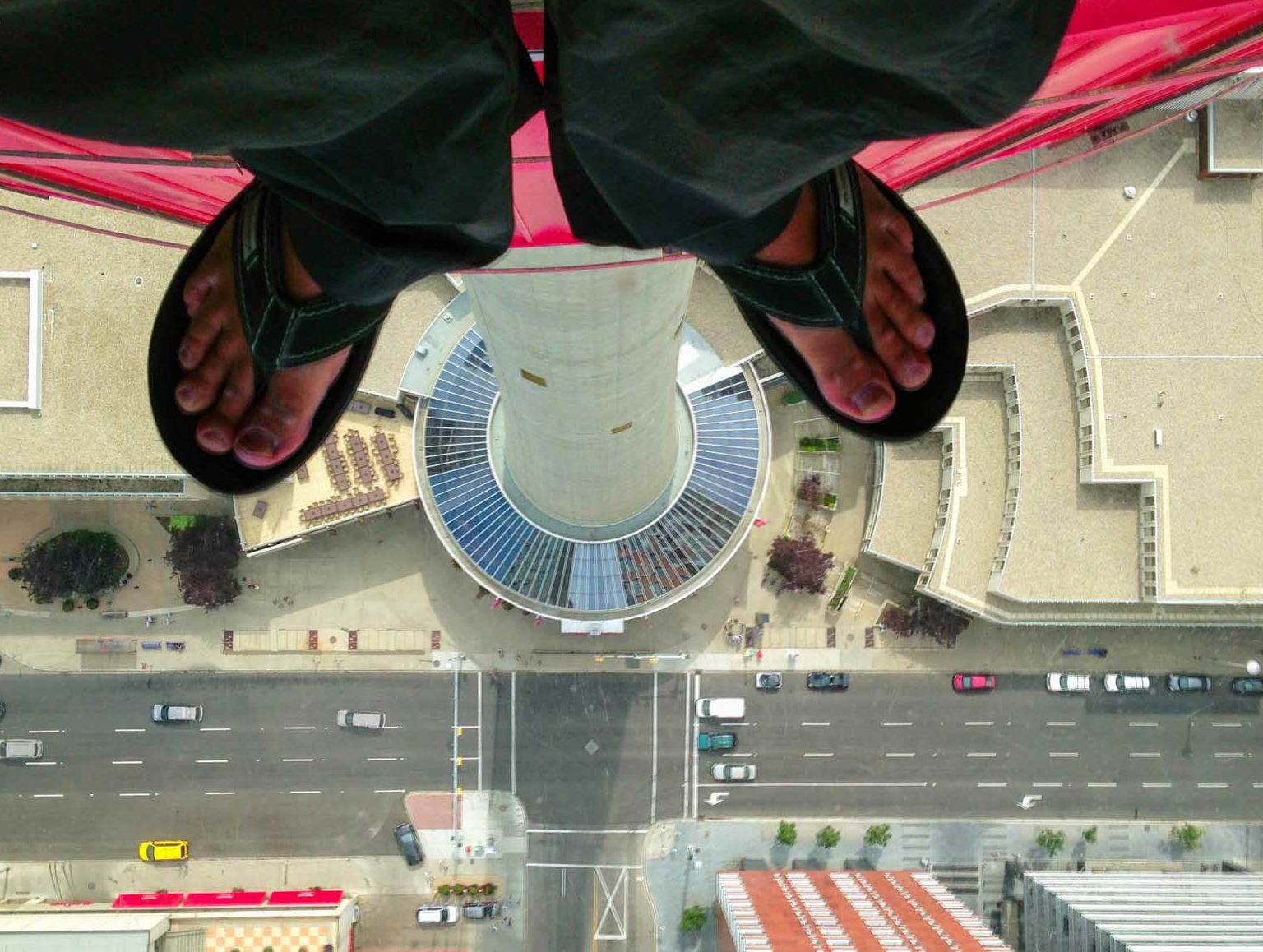
Like all world cities, Calgary has its own tower that makes for a superb lookout over the city. Make sure to go up and enjoy its view from the top floor. With beautiful views of the city, it is one of the most visited tourist attractions in Alberta, let alone Calgary. Book this bus tour to see the best of Calgary. This sightseeing tour includes stops at Heritage Park Historical Village, Canada Olympic Park, The Stampede Grounds, downtown Calgary, the Calgary Tower and more!
51. Calgary Peace Bridge
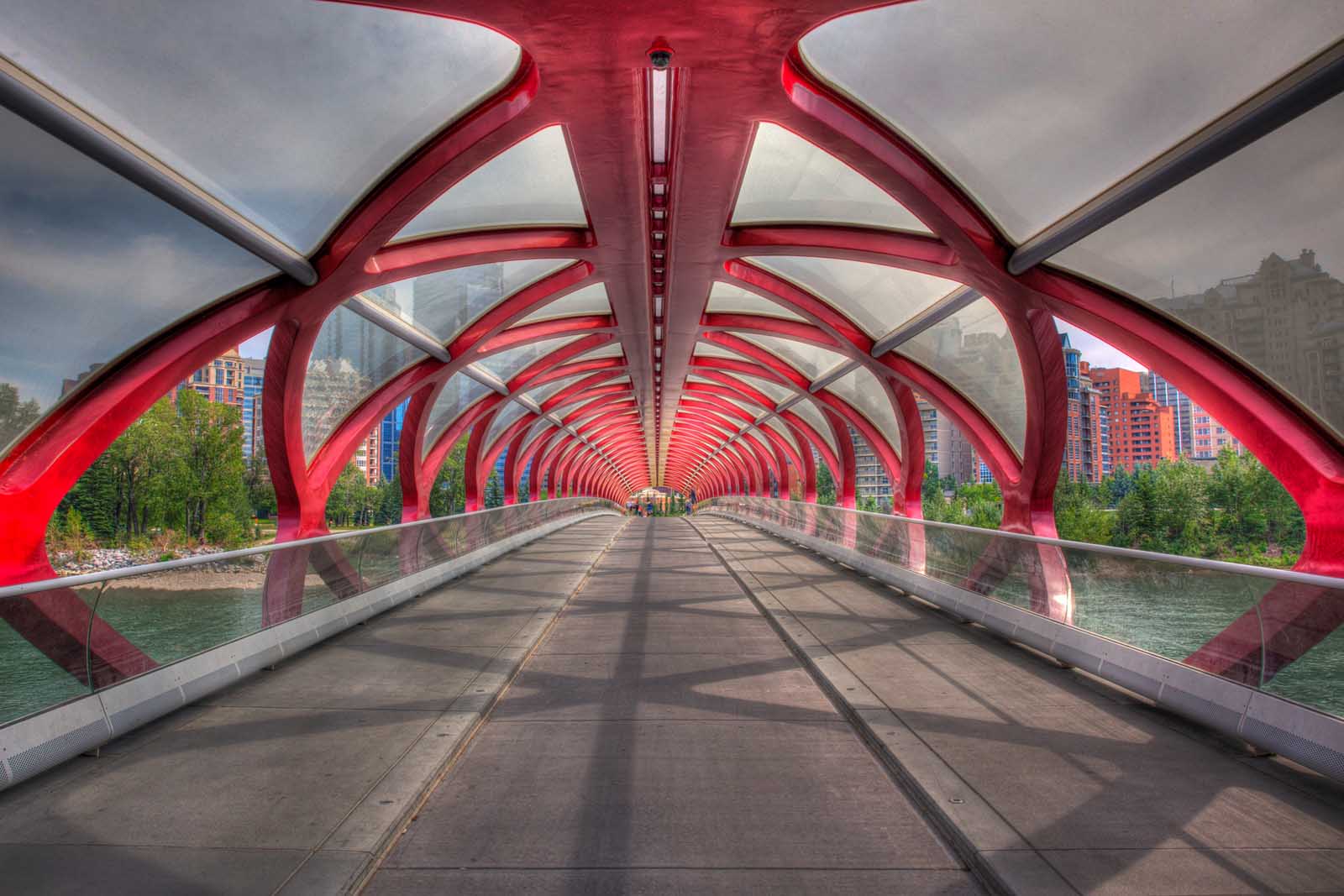
The Calgary Peace Bridge spans the Bow River from Downtown to communities across the river. It’s become a popular path for cycling and an iconic symbol of the city.
52. Calgary Stampede
If you are in the city in June, check out the greatest outdoor show on earth. Calgary hosts the annual Calgary Stampede – the world’s largest rodeo has been running since 1912 and is the biggest ticket in town. Besides all the rodeo activities like bull riding and chuckwagon races, there are midway rides, food stands and performances at the grandstand show. Read more: 21 Best Things to do in Calgary, Alberta
53. Heritage Park Historical Village
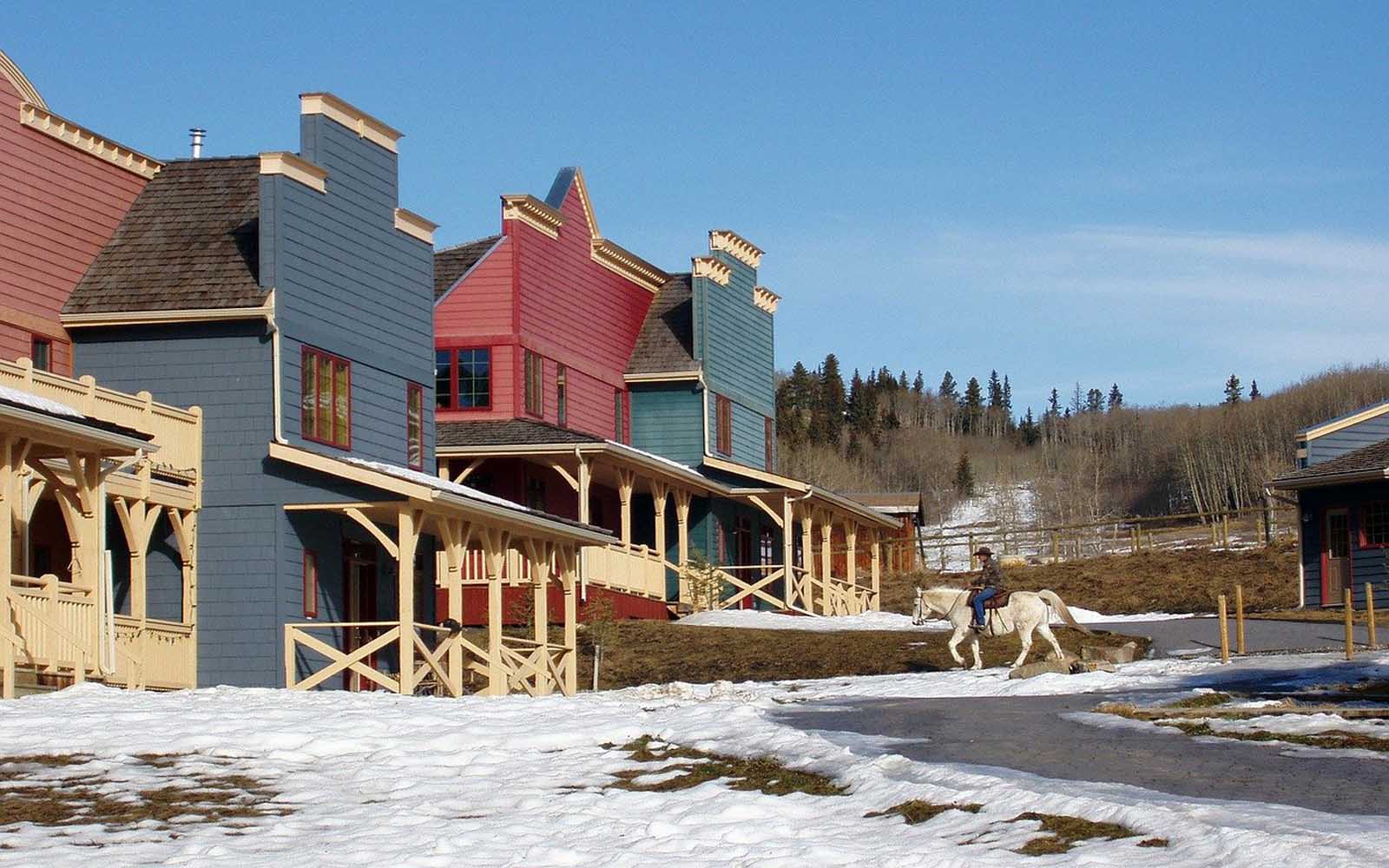
Heritage Park Historical Village in Calgary provides a glimpse into Alberta’s past. The buildings cover four key periods in Calgary’s history from a 1860s fur-trading fort to the 20th century. There’s an old steam engine that you can hop on for a ride around the village to explore a series of historic buildings from the pioneer era with ample costumed interpreters to help you travel back in. Other activities include a paddlewheel tour on the scenic Glenmore Reservoir and a visit to Gasoline Alley Museum.
54. Edmonton
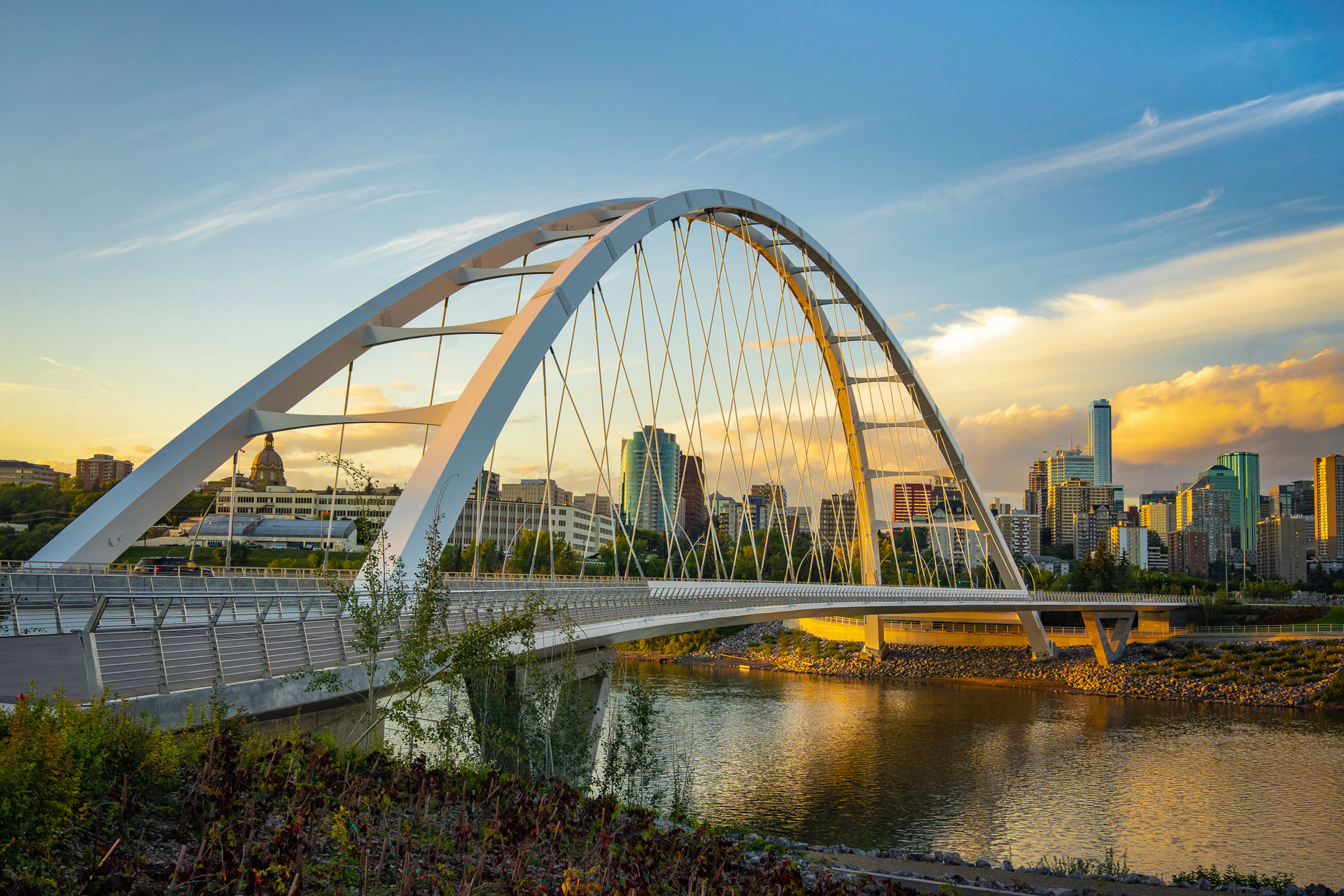
Edmonton is often overlooked when visiting Alberta, but it is worth adding to the list. With the world’s largest indoor amusement park, plenty of outdoor activities including Canada’s largest urban park and cultural activities, you’ll find something for everyone. Plus there is a festival in Edmonton for nearly every week of the year. Read more: The Best Things to do in Edmonton, Alberta
55. West Edmonton Mall
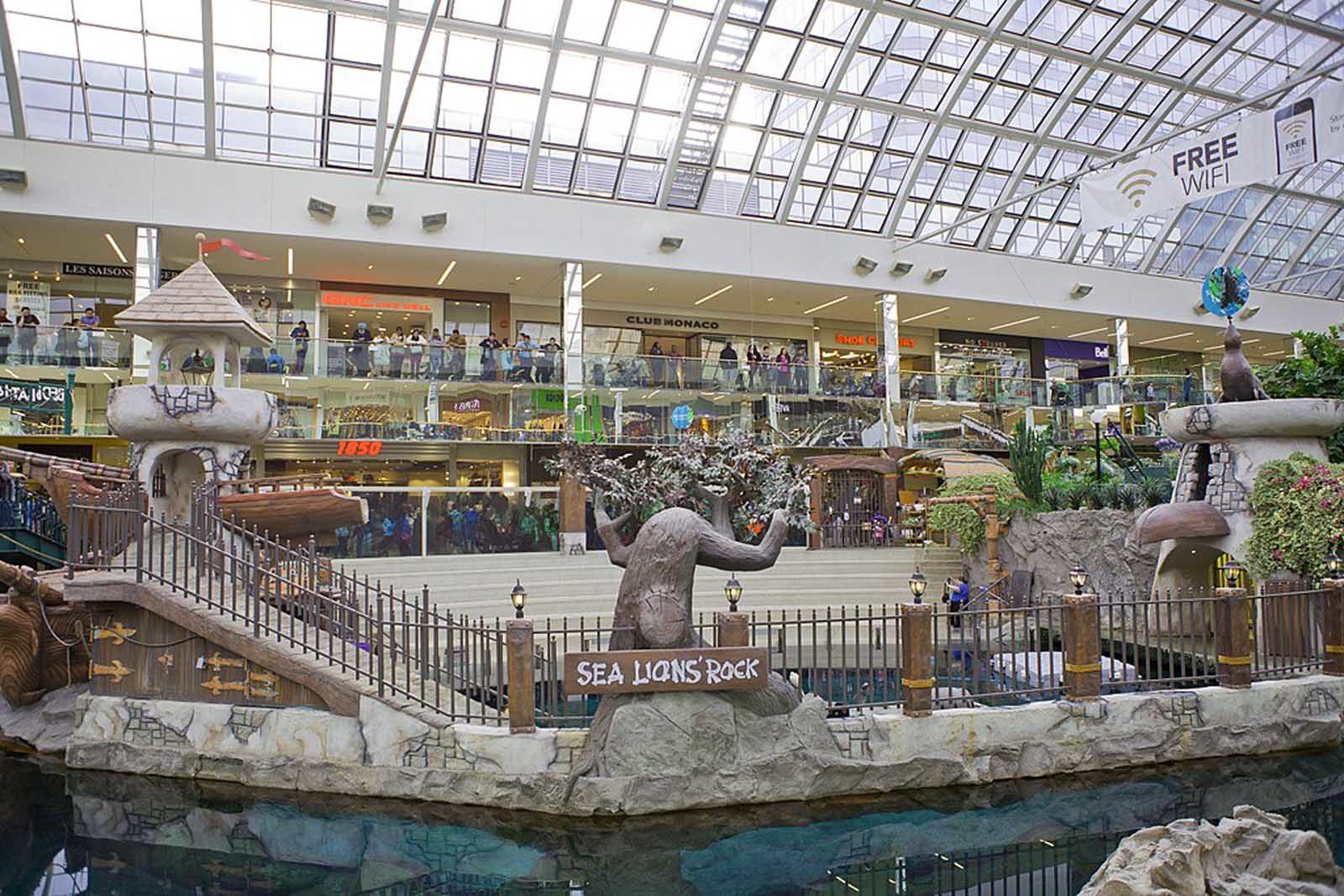
It is North America’s largest mall and probably what first put Edmonton on the map. The West Edmonton Mall is way more than a mall, it’s the lifeblood of Edmonton. If you like amusement parks, you’ll love this mall. With the world’s largest indoor amusement park, The World Waterpark, and an indoor skating rink, it is the original super mall! As Edmonton’s temperatures dip far below freezing in the Canadian winters, this mall is an oasis of warmth and fun.
56. Edmonton River Valley
The North Saskatchewan River Valley Park System covers 18,000 acres combining 20 different parks. It is Canada’s largest urban park. Anything outdoors that your heart desires is available in this green space. Hiking and cycling trails, a golf course, ravines and lakes and if you are into zoos, the Edmonton Valley Zoo is within the parks system. In the winter, there’s cross country skiing and even a downhill ski slope.
57. Fort Edmonton Park
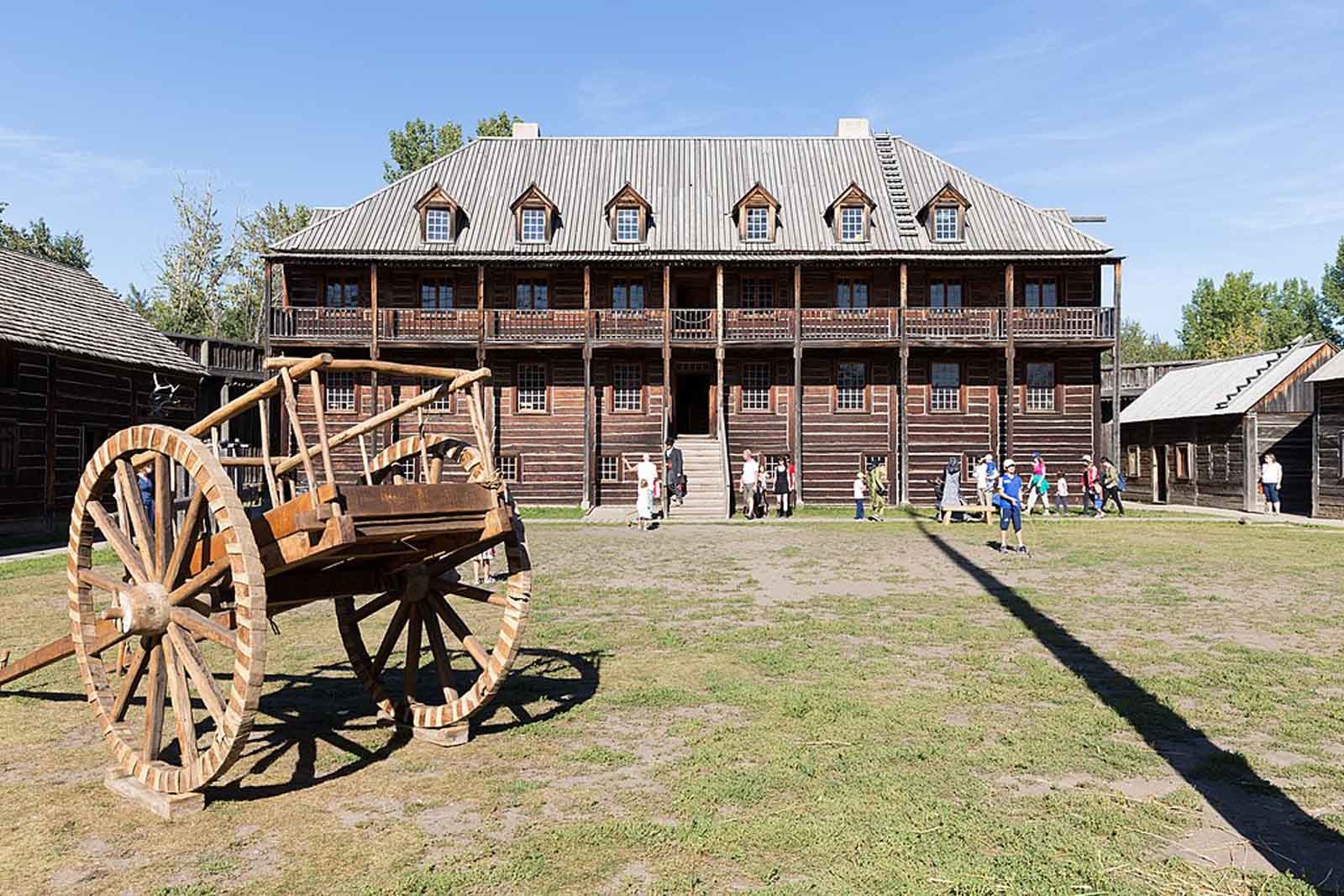
Time has stopped at Fort Edmonton Park where the streets are frozen in time depicting Edmonton’s early history. The 150 acre wooded parkland traces history from the Indigenous People’s experience to the 1920s. Costumed performers walk the replica of an 1885 street and you can tour an 1846 fort from the days of the Hudson Bay fur traders. If you want a look at bits and pieces of Alberta and Canadian historythe heritage park offers memorable experiences for everyone. This is also Canada’s largest living history museum. Visit the fort for details.
58. Kananaskis
A great day trip from Calgary or Banff is a visit to Kananaskis Country. Its views rival Banff National Park. You can stay overnight at the luxurious Kananaskis Mountain Lodge and use the spa, hike its trails and enjoy the luxury accommodation. It was one of our favourite places in Alberta.
59. Nordik Spa
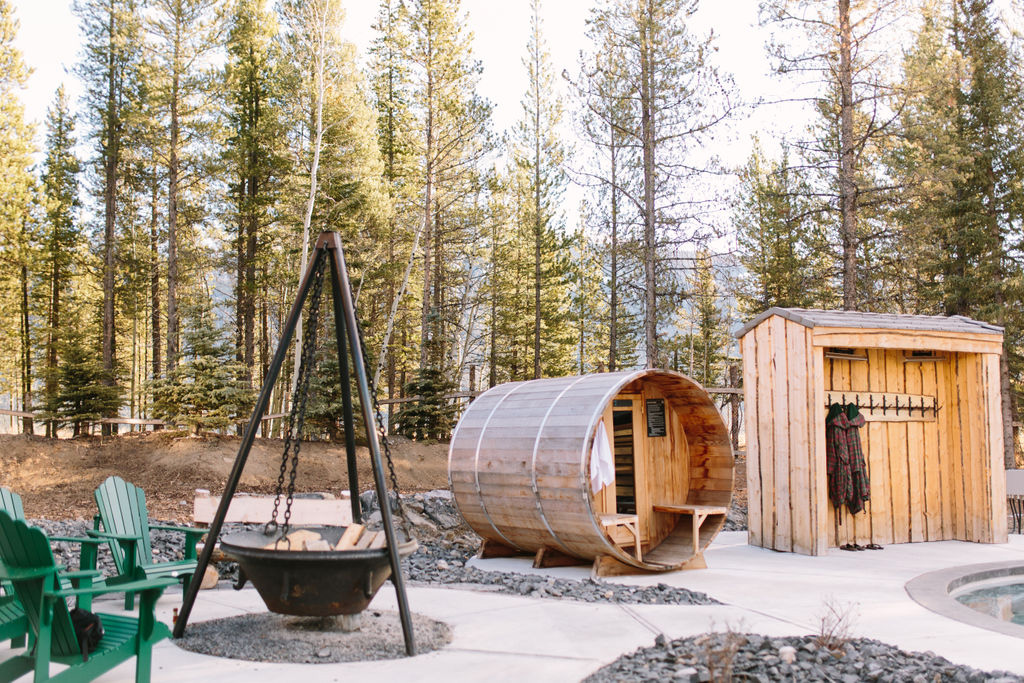
The spa is a year-round outdoor Scandinavian Spa with hot pools, saunas, and cold plunge pools. It’s the perfect place to soothe travel-weary muscles.
60. Ski Alberta
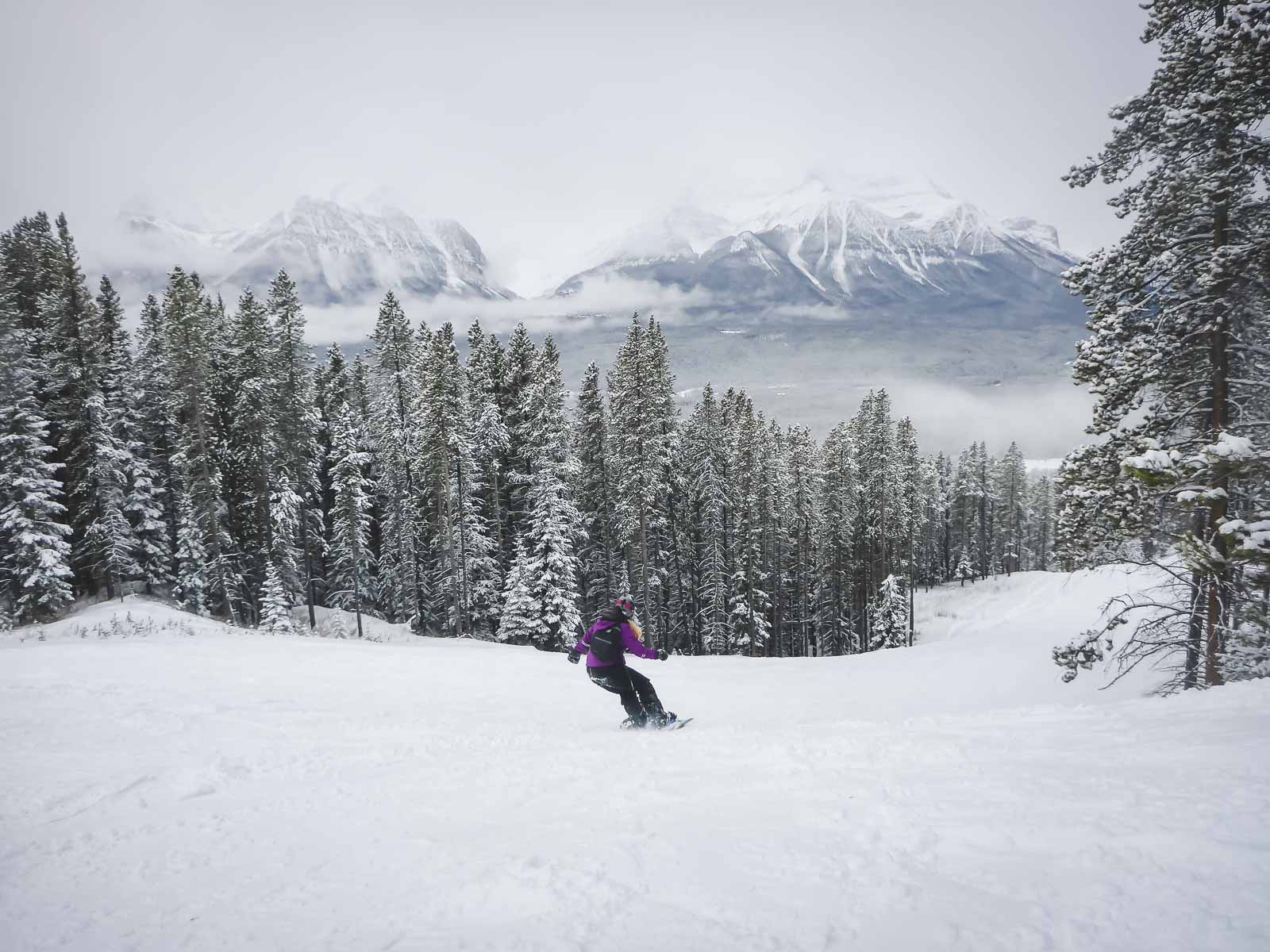
There is no going to Alberta in winter without going skiing or snowboarding. Banff National Park houses three different ski resorts alone! We love Sunshine Village because it has the Sunshine Mountain Lodge located right at the side of the hill offering the only ski in ski out adventures in Banff. It also has Banff’s largest hotel hot tub where after a day on the boards, you can soothe your aching muscles in the tub. Read more at 15 Top Ski Resorts in Canada For Winter Fun
Lake Louise is Alberta’s premier ski hill with 4200 skiable areas in one of the largest ski destinations in North America and one of Canada’s top ski destinations. There are trails for all levels of Skiing and Snowboarding. Lake Louise is on the World Cup Circuit with a Terrain Park and a Snowcross Course. It was also home to the Calgary Olympics, and you can be sure to carve actual Olympic runs! It’s Epic.
Norquay is the closest ski hill to Banff and is great for a day trip or for families. If you want to try something different, head over to do some snow tubing. It’s the ultimate couch potato thrill ride. You ride the magic carpet to the top, let them put you on the tube, and push you down the hill. All you have to do is hoot and holler all the way down!
61. Wood Buffalo National Park
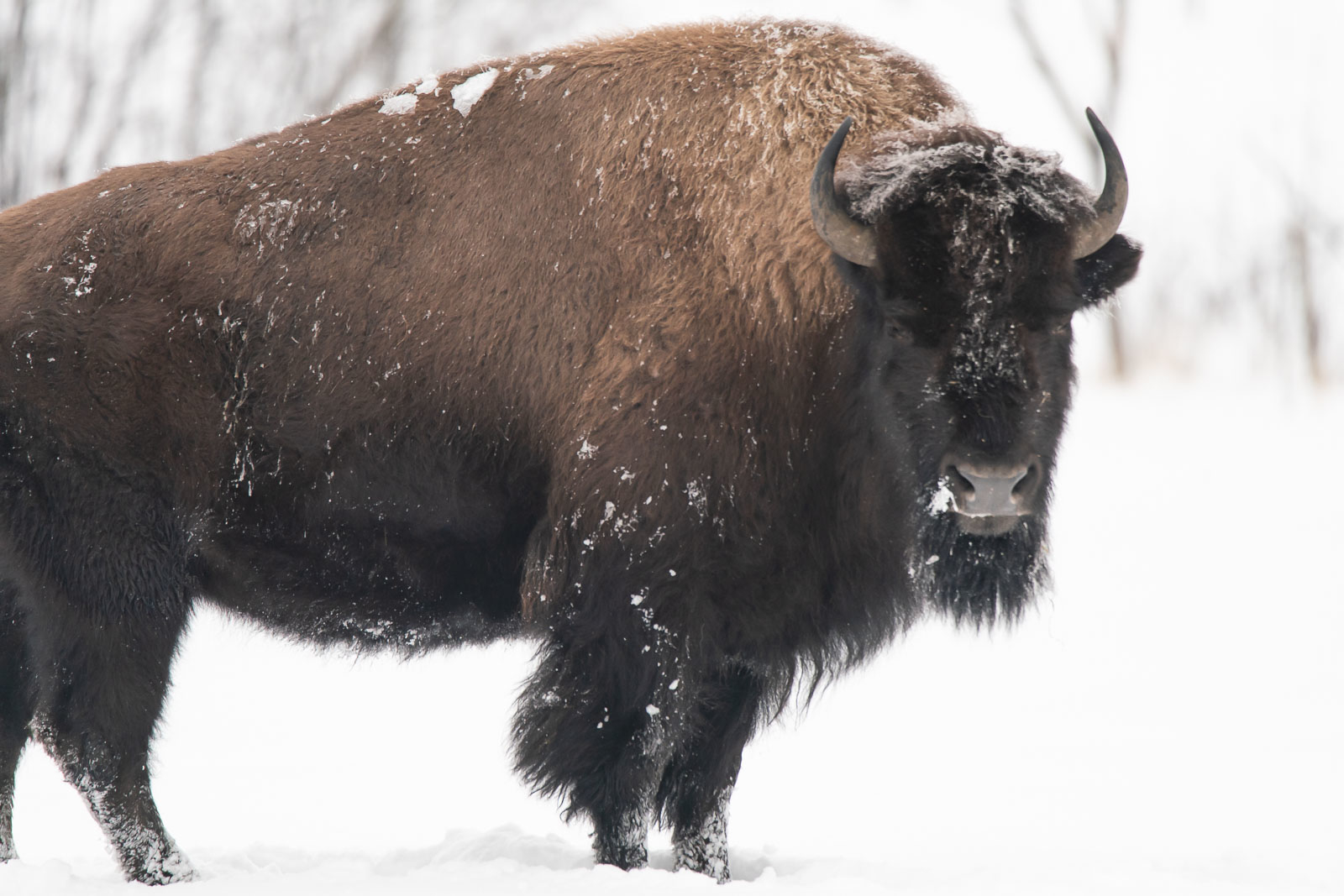
If you are looking for out of the ordinary things to do in Alberta, Canada make your way up to the far north to visit Wood Buffalo National Park. It is the largest national park in Canada and it is a national historic site. Established in 1922, Wood Buffalo National Park was designed to protect one of the last surviving herds of Bison.
62. the Rocky Mountaineer
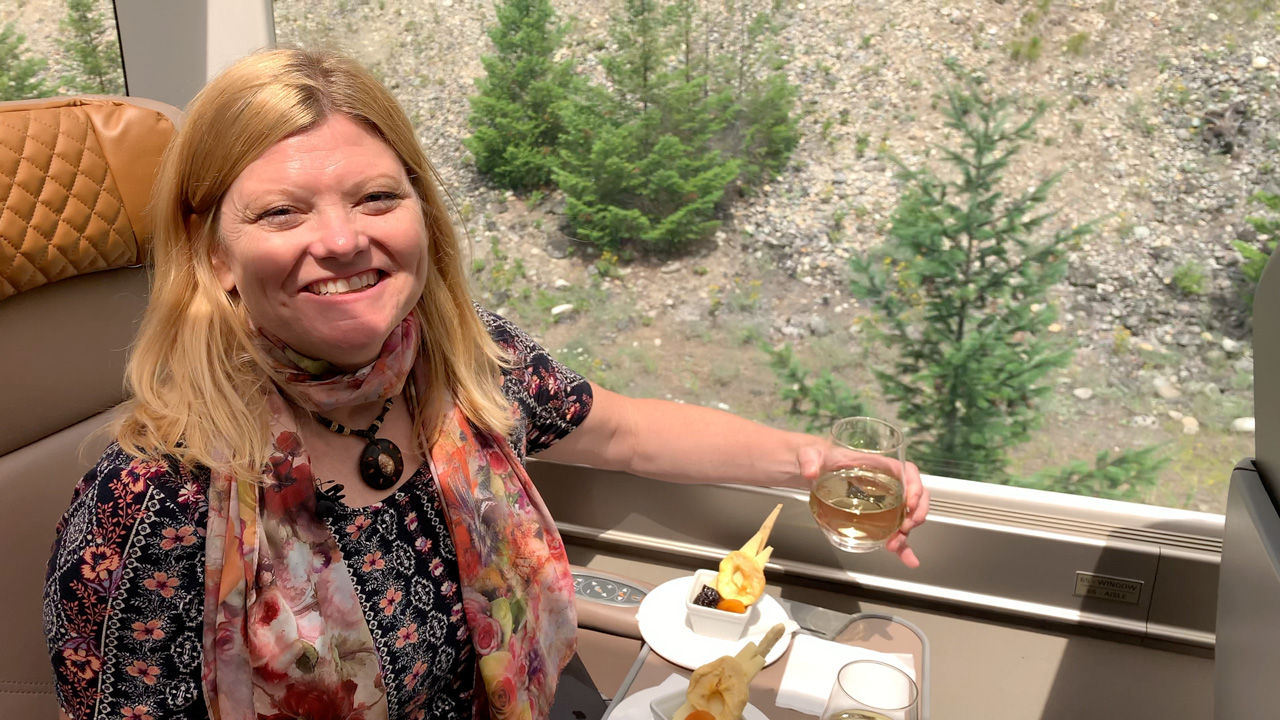
We took the Rocky Mountaineer from Vancouver to Calgary, but you can hop aboard in either Banff Town of Jasper. The one-way luxury train journey takes you through the Rockies and it is a rip-roaring good time with fine dining and outstanding views of some of the top attractions in Alberta. Note, you’ll be eating and drinking a lot so get ready!
Alberta has five national parks that include, Banff National Park and Jasper National Park, Wood Buffalo National Park, Waterton Lakes National Park, and Elk Island.
The top attractions in Alberta are Banff and Lake Louise, Jasper National Park, the Icefields Parkway, Waterton Lakes National Park, Drumheller and its hoodoos, The West Edmonton Mall and Wood Buffalo National Park.
Exploring Alberta is one of the greatest places to visit in Canada. With five national parks, world-class cities, the Rockies, glacier lakes and extraordinary beauty, Alberta is a destination that is second to none. These are our favourite things to do in Alberta, but we know we have not yet scratched the surface. What did we miss and what should we do next? Leave your recommendations in the comments below.
Plan Your Trip to Alberta with These Resources
- Ice Climbing : Ice Climbing Adventure in Canmore
- Lake Louise: Pond Hockey on Lake Louise- A Good Old Hockey Game
- Winter Adventures: Banff Helicopter Tours and Snowshoe
- Banff National Park : The Best Things to do in Banff, Alberta
- Canmore: The Best Things To Do In Canmore, Alberta
- Calgary: Canada Olympic Park – Fun In Calgary Alberta
- Edmonton: The Best Things To Do In Edmonton, Alberta
- Southern Alberta: Things To Do In Drumheller, Alberta
- Jasper National Park: Amazing Things To Do In Jasper, Alberta
Travel Planning Resources
Looking to book your next trip? Why not use these resources that are tried and tested by yours truly.
Flights: Start planning your trip by finding the best flight deals on Skyscanner
Book your Hotel: Find the best prices on hotels with these two providers. If you are located in Europe use Booking.com and if you are anywhere else use TripAdvisor
Find Apartment Rentals: You will find the cheapest prices on apartment rentals with VRBO .
Travel Insurance: Don't leave home without it. Here is what we recommend:
- Allianz - Occasional Travelers.
- Medjet - Global air medical transport and travel security.
Need more help planning your trip? Make sure to check out our Resources Page where we highlight all the great companies that we trust when we are traveling.
You May Also Like
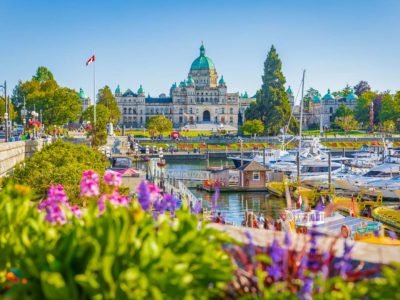
34 Incredible Things to Do In Victoria, BC (Our 2024 Guide)
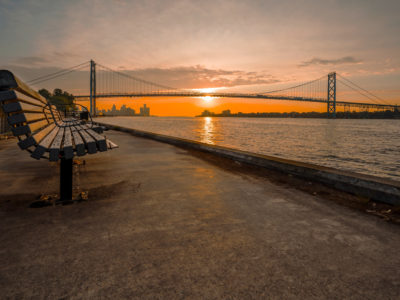
20 Best Things To Do in Windsor, Canada in 2024
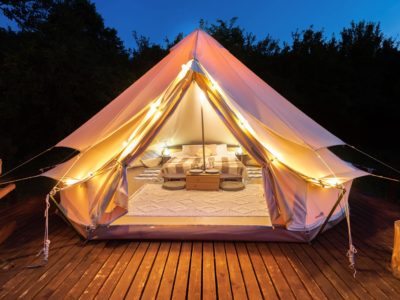
Glamping in Ontario: 14 Best Luxury Camping Sites To Visit In 2024
About The Planet D
Dave Bouskill and Debra Corbeil are the owners and founders of The Planet D. After traveling to 115 countries, on all 7 continents over the past 13 years they have become one of the foremost experts in travel. Being recognized as top travel bloggers and influencers by the likes of Forbes Magazine , the Society of American Travel Writers and USA Today has allowed them to become leaders in their field.
Join thousands of others who get our monthly updates!
Leave a comment cancel reply.
Save my name, email, and website in this browser for the next time I comment.
10 thoughts on “The 62 Best Things to do in Alberta, Canada – The Ultimate Guide”
Well at least you mentioned Edmonton. My goodness, the second largest Fringe Theater in the world, world class casinos, Elk Island is far easier to see Buffalo and about 45 minutes from Edmonton. The Ukrainian Village just 15 minutes from Elk Island Park Gates. Wood Buffalo and Elk Island are both dark preserves as well. My goodness Wood Buffalo is bigger than the Country of Switzerland! There are 5 golf courses in our river valley, boat cruising from Devon to Ft. Saskatchewan. Edmonton gets overlooked because for some strange reason people take the simple way out and don’t see what this amazing City has to offer. The Capital City has way more to offer than West Edmonton Mall. Do your homework!!
Perhaps you should have clicked on the link to the article where we discuss all of these great things to do in Edmonton and more than you have actually included yourself. This article is meant to touch on the highlights of places. Please don’t accuse us of not doing our research until you have actually done yours.
Very beautiful and cool video guide! I really liked it, and it is also very useful – thank you very much.
Great guide! – Many thanks to the author for this super useful material. I will keep this guide bookmarked so as not to lose, and not to forget what to do in Alberta when traveling as a family.
Winter in Alberta is not something everyone can manage. But, this guide is a pretty fantastic guide, and if you are looking to stay in Alberta for winter, this guide will help you get through the season without any problem.
Calgary is a cool place but freezing brutal cold winters ! I remember when the Olympics were there so cool.! I agree with getting regular massages ?
Thanks for sharing nice content with us. Keep on sharing such article, I love it lot.
“A bunch of happiness and excitement”. This might be one of the best winter experience I’ve seen. Glad you’ve shared this. Anyhow, Looking forward to more of this.
I made it to Banff and Jasper this summer for the first time. Visiting in winter would be a lot of fun. I didn’t know you could play hockey on Lake Louise!
wow, beautiful winter guide at Alberta. Those videos were nice an I like the 1st video the most. Good Work Guys… Keep on TRAVELLING…

7 Essential Places to Visit in Alberta
From expansive national parks to lively cities, the canadian province will keep you busy for days..
- Copy Link copied

Abraham Lake may be lesser known than Lake Louise but it’s no less spectacular.
Photo by David Wirzba/Unsplash
With turquoise glacial waters set against soaring, snow-capped peaks, the iconic alpine scenes of Alberta ’s Banff National Park are arguably the poster child of Canada . And while the rugged Canadian Rockies live up to their reputation, they’re just the tip of the iceberg when it comes to Alberta’s striking landscapes. From the mushroom-shaped hoodoos of the fossil-laden Badlands to the ice bubbles trapped beneath the surface of Abraham Lake —there is no shortage of natural wonders to discover.
Four national parks and five UNESCO World Heritage sites offer year-round adventure for outdoor enthusiasts. But with a burgeoning Indigenous tourism industry and the two main cities– Calgary and Edmonton—becoming increasingly cosmopolitan, all while maintaining their western charm—Alberta is ripe for cultural exploration, too.
From the rowdy Calgary Stampede to the spiritual mountain lakes to the desolate northern parklands, where you can catch a rare glimpse of the world’s last remaining wild buffalo and, if you’re lucky, the Northern Lights —these are the places you won’t want to miss on your next trip to Alberta.

Visit in July for the Calgary Stampede.
Photo by Steve Estvanik/Shutterstock
While skiers and snowboarders still hit the slopes at the former 1988 Olympic venue Winsport , Canada’s fourth largest city is no longer just a gateway to Alberta’s alpine attractions. In the summer, you’ll find locals and visitors floating on tubes down the Bow River that splits the city in two. While in the winter, penguins waddle freely at the Calgary Zoo , home to nearly 1,000 animals spanning 119 species. Across the river in the popular East Village, music lovers appreciate the 2,000 rare instruments housed at Studio Bell. Around the corner, the Calgary Central Library attracts architecture enthusiasts and bookworms alike for its collection of over 400,000 books stacked amid soaring cedar arches and winding terraces inspired by Alberta’s foothills and Chinook winds.
Creativity also abounds in the East Village’s many kitchens, where chefs and mixologists rewrite “Cowtown’s” culinary reputation as the beef-loving city where the popular Caesar cocktail—a savory mix of vodka and Clamato juice served in a celery salt-rimmed glass–was born.
Locally grown vegetables take center stage at the beloved Coup and Japanese-style Nupo (don’t miss the omakase and hidden eight-seat restaurant in the back). Cheap beer and Caesars are swapped for sophisticated cocktails at Bengali-style curry house Calcutta Cricket Club and Cannibale , a speakeasy concealed behind a full-service barbershop.
Still, Calgary hasn’t forgotten its western roots. Every July, you can find Calgarians shading the hot prairie sun with their cowboy hats while waiting in line for “stampede breakfast.” The complimentary pancakes are doled out by businesses across the city in celebration of the annual Calgary Stampede , a world-class rodeo known as “the greatest outdoor show on earth.”
2. Drumheller
Seventy-five million years ago, dinosaurs roamed the lush, subtropical environment just northeast of Calgary. Today, it’s an arid tundra known as the Canadian Badlands, and home to the richest dinosaur fossil collection in the world. Housing over 130,000 fossils and a 67-million-year-old T-rex, the Royal Tyrrell Museum is a must for dinosaur fans. As is a stop in the nearby former coal town of Drumheller , to climb inside the mouth of the world’s largest dinosaur. It may be the “Dinosaur Capital of the World,” but with its mystical hoodoo rock formations and dusty desolate canyons, you don’t have to be a science whiz to be wowed by the Badlands.
3. Banff National Park
Sore muscle relief is available on the lower slopes of Sulphur Mountain at the Banff Upper Hot Springs . For more impressive views, take the Banff Gondola up to the summit, where you’ll find an interpretative center, boardwalk, and locally sourced Canadian cuisine served 2,292 feet in the sky. The experience is offered year-round, but skiers and snowboarders will want to wait for winter to hit Banff’s pristine slopes. Adrenaline junkies can also find their fix climbing the Via Ferrata cliffs above Mount Norquay or traversing the frozen waterfalls of nearby Johnston Canyon .
Back at sea level, an hour-long cruise of Lake Minnewanka —also known as the “Lake of the Spirits”—offers Indigenous history and wildlife sightings on its placid shorelines. Stretching over 17 miles long, Minnewanka is the largest lake in Banff National Park, and more than a pretty picture—cold-water divers can explore Minnewanka Landing , a sunken resort town dating back to 1886. Spirit-chasers will want to head south afterward to visit the ghost town of Bankhead .
Where to stay at Banff National Park
Fairmont Chateau Lake Louise
Book now: From $299 per night, expedia.com
With countless outdoor activities on offer—such as canoe rentals and forest bathing—the Fairmont Chateau Lake Louise makes a convenient home base for exploring Canada’s first national park any time of year. History buffs will revel in Renaissance revival architecture dating back to 1890 while wellness-seekers take in the mountain air at an outdoor morning stretch session or pamper themselves at one of the spa’s 20 indulgent treatments.
4. Icefields Parkway
Arguably one of the most scenic drives in the world, the three-hour stretch between Banff and Jasper is a must to experience Alberta’s more rugged natural wonders. It’s worth braving the crowds midroute to marvel at the thick ice sheets and frozen rivers of the 10,000-year-old Athabasca Glacier —one of the six glaciers of the Columbia Icefield .
For a more capacious experience, head to the Glacier Skywalk at night to view the Icefield beneath a blanket of stars from the glass-floored balcony. Equally impressive are the methane ice bubbles that form on the surface of Alberta’s largest reservoir, Abraham Lake . Stops at Sunwapta Falls and Athabasca Falls offer more opportunities to witness aquatic forces of nature.
5. Jasper National Park
A UNESCO World Heritage site and the largest park in the Canadian Rockies, Jasper National Park is teeming with fossils, flora, and fauna to explore. In the summer, a half-day canoe journey or relaxed boat cruise takes you out to Spirit Island , one of Canada’s most photographed destinations due to its remote location and the distinct emerald color of the surrounding Maligne Lake, while the six suspension bridges that soar above Maligne Canyon are a hiker’s dream. Ice climbers will want to wait until the winter, when the 50-meter-deep canyon transforms into a winter fortress of frozen ice floes.
For a more laid-back adventure, the Jasper Skytram transports you 7,000 feet above sea level to the summit of the Whistlers in a mere eight minutes. Spectacular sky views are also had at the Jasper Planetarium, where you’ll find the most powerful telescopes in the Rockies, and astronomers explaining the stars and Northern Lights, from the 50-seat outdoor domed theater. A short drive south will land you at Jasper Brewing Company , the first brewery in a Canadian national park.
6. Edmonton
Home to the largest stretch of urban parkland in North America, Edmonton River Valley , Alberta’s capital city embodies the province’s main draw—nature. The North Saskatchewan River that cuts through the heart of the city makes for a peaceful urban kayak or canoe, while the Valley’s more than 20 parks offer 100 miles of trails for hiking, cycling, and cross-country skiing.
When the harsh winter proves too cold for outdoor pursuits, head indoors to West Edmonton Mall . Housing the world’s largest indoor amusement park, indoor lake, and indoor wave pool, plus a zoo, skating rink, and over 800 shops—North America’s largest mall is a destination in its own right.
Calgary’s rival city also has an artistic side. In the vibrant Arts District , you’ll find an eclectic mix of Indigenous and contemporary art at the Royal Alberta Museum and Art Gallery of Alberta . With over 60 annual festivals, most notably the summer Fringe Theatre Festival (the largest and oldest of its kind in North America), the aptly nicknamed “ Festival City ” is a delight for theater buffs. The city’s growing dining scene sees Alberta beef reimagined nose-to-tail style at Rge Rd and drinks infused with juniper foraged from the Alberta Badlands at Strathcona Spirits , the smallest distillery in North America.

Métis Crossing is expanding in 2022.
Courtesy of Travel Alberta
7. Elk Island National Park
Once numbering in the millions, Canadian bison—Alberta’s most emblematic animal—have dwindled to a wild population of less than a thousand. This “ island of conservation ,” located a 30-minute drive east of Edmonton, is the best place to encounter the remaining few, and the Northern Lights, at the light pollution–free Beaver Hills Dark Sky Preserve .
Despite its remote nature, the national park gets a glamping glow-up in the summer with luxury Geo Domes , complete with gas fireplaces and charcuterie delivery. The culturally savvy will want to head north to rest at the forthcoming Métis-designed boutique lodge at Métis Crossing , which also features Indigenous-led experiences—among them, wildlife tours and stargazing workshops—and hearty Canadian fare, like bannock, crafted by Indigenous chefs.
>> Next: Discover a Side of Indigenous Canada at Métis Crossing, Newly Expanding in 2022

404 Not found
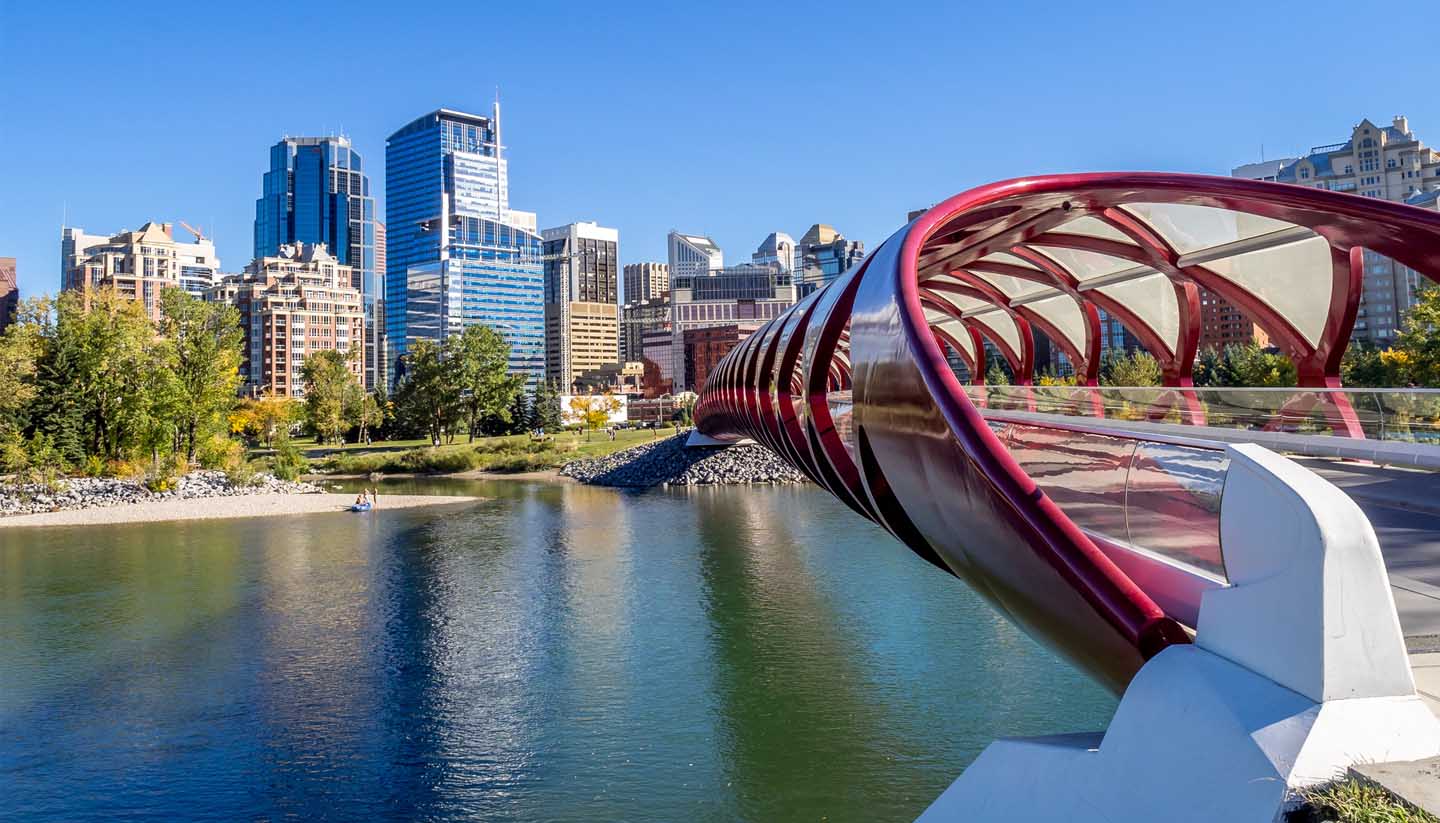
Introducing Alberta
About alberta.
- Images of Alberta
- History, language & culture
- Weather & geography
Plan your trip
- Travel to Alberta
- Where to stay
While you’re there
- Things to see & do
- Shopping & nightlife
- Food & drink
- Getting around
Canada: Key Info
- Passport & visa
- Public Holidays
- Money & duty free
Book your flights
- Calgary International Airport
Ski Resorts
- Lake Louise
Alberta travel guide
Hulking great mountains, sprawling ice fields and emerald lakes are Alberta’s star attractions, but equally thrilling are its dinosaur-strewn Badlands and cowboy heritage.
You’d swear they’ve added a drop of dye to the lakes in the Rocky Mountains. Could they really be such a startling colour? Yes they could, and you need to supercharge your camera battery if you’re going to capture every snap-worthy scene that comes your way.
Whether you’re spotting grizzlies and elk alongside the Icefields Parkway, soaking in Banff’s hot springs, hiking around Maligne Lake or skiing fresh powder at Lake Louise, you’d have to be a Martian not to be bowled over.
This pristine nature sits uneasily next to the controversial oil sands of Alberta’s north, whose modern-day gold rush has fuelled the province’s booming economy. This wealth is evident in cities like Calgary and Edmonton, home to shiny new skyscrapers, flashy restaurants and ever-expanding suburbs.
While much of Alberta beyond the Rockies seems to be an endless vista of prairies topped with a generous sprinkling of lakes, the Badlands pop out like a Christmas cracker surprise. Stripy hills and sandstone hoodoos like giant mushroom stalks conceal many dinosaur bones – in its day this must have been the Cretaceous equivalent of Tokyo or Delhi.
Get your own bones rocking at Edmonton’s summer fiesta, K Days, a 10-day jamboree featuring whirring fairground rides and big-name bands. Or join the cowboy extravaganza that is the Calgary Stampede, when chuckwagon races, bull riding and dazzling stage shows make you yee-haw till you’re hoarse.
661,848 sq km (255,541 sq miles).
4.1 million (2016).
5.77 per sq km.
Travel Advice
Before you travel.
No travel can be guaranteed safe. Read all the advice in this guide and any specific travel advice that applies to you:
- women travellers
- disabled travellers
- LGBT+ travellers
- solo and independent travel
- volunteering and adventure travel
Travel insurance
If you choose to travel, research your destinations and get appropriate travel insurance . Insurance should cover your itinerary, planned activities and expenses in an emergency.
About FCDO travel advice
The Foreign, Commonwealth & Development Office ( FCDO ) provides advice about risks of travel to help British nationals make informed decisions. Find out more about FCDO travel advice .
Follow and contact FCDO travel on Twitter , Facebook and Instagram . You can also sign up to get email notifications when this advice is updated.
This information is for people travelling on a full ‘British citizen’ passport from the UK. It is based on the UK government’s understanding of the current rules for the most common types of travel.
The authorities in Canada set and enforce entry rules. If you’re not sure how these requirements apply to you, contact the Canadian High Commission in the UK .
COVID-19 rules
There are no COVID-19 testing or vaccination requirements for travellers entering Canada.
Passport validity requirements
To enter Canada, your passport must be valid for the length of your planned stay.
If you’re travelling through another country on your way to or from Canada, check the entry requirements for that country. Many countries will only allow entry if you have at least 6 months validity remaining on your passport.
Visa requirements
To enter or transit through Canada, most people need a visa or an Electronic Travel Authorization ( eTA ) – not both.
Check if you need a visa or an eTA online .
You do not need a visa for short visits (normally up to 6 months). You may need an eTA instead.
You do not need an eTA , if you are:
- arriving by land and sea – you must have acceptable travel documents and ID
- a British-Canadian dual national – you must have a valid Canadian passport
See Canada’s entry requirements for full details of eTA and visa requirements.
Contact the Canadian High Commission in the UK if you are unsure about visa requirements or your eligibility to enter the country, for example, if you have a criminal record or have been arrested.
Checks at border control
Canadian border officials may ask you to show a return or onward ticket and proof that you have sufficient funds to support yourself for the duration of your stay, even if you are staying with family or friends.
Visas for permanent residence, study or work
See information on visas for permanent residence, study or work in Canada .
Transiting through Canada
If you are travelling through Canada (transiting) by air, you must have an eTA or a transit visa.
If you have questions, contact:
- your airline
- Immigration, Refugees and Citizenship Canada
- your nearest Canadian high commission, embassy or consulate
Find out more about transiting Canada .
Visa and eTA scams
Some unauthorised websites charge for submitting visa applications. These websites are not associated with the Canadian government.
You can check your eTA status online with the Canadian government . If it has been 72 hours since you applied, and you have not received confirmation of your application, complete an enquiry form .
Travelling with children
If a child travels alone or with only one parent or legal guardian, they should carry a letter of consent from the non-travelling parents or guardians. Immigration officers have the right to question children using simple and appropriate language to see if there are any concerns about child abduction.
For more information, check with the Canadian High Commission in the UK or the Canada Border Services Agency .
Vaccine requirements
For details about medical entry requirements and recommended vaccinations, see TravelHealthPro’s Canada guide .
Customs rules
There are strict rules about goods that can be taken into and out of Canada . You must declare anything that may be prohibited or subject to tax or duty.
The Canadian authorities will confiscate banned food products and you could get a fine. For more information, see importing food, plants or animals to Canada .
If you visit a farm or have contact with wild animals before entering Canada, and plan to visit a farm during your stay, you must declare this on your Customs Declaration Card. For more information, see biosecurity at the Canadian border .
There is a high threat of terrorist attack globally affecting UK interests and British nationals, including from groups and individuals who view the UK and British nationals as targets. Stay aware of your surroundings at all times.
UK Counter Terrorism Policing has information and advice on staying safe abroad and what to do in the event of a terrorist attack. Find out how to reduce your risk from terrorism while abroad .
Terrorism in Canada
Terrorists are likely to try and carry out attacks in Canada.
Attacks could be indiscriminate, including in places visited by foreigners. You should remain aware of your surroundings, keep up to date with local media reports and follow the advice of local authorities.
Recent attacks include:
- in 2023, one person stabbed and injured in Surrey, British Columbia
- in 2021, 4 people killed and one injured by a vehicle in London, Ontario
- in 2020, one person killed with a hammer in Scarborough, Ontario
- in 2020, one person killed and 2 wounded in a machete attack in Toronto, Ontario
See the Canadian government’s national terrorism threat level .
Take precautions to protect yourself from petty crime, including:
- not leaving your bag or luggage unattended
- keeping luggage out of sight in cars
- keeping valuables and passport in a safe location
- leaving copies of important documents with family and friends in the UK
- carrying a copy of your passport for ID
Laws and cultural differences
Recreational cannabis is legally available in Canada. Laws vary depending on the province or territory you are visiting . It is illegal to take cannabis across the Canadian border without a permit or exemption authorised by Health Canada. Those who attempt to take cannabis out of Canada without the relevant permit face arrest.
See the Canadian Border Services Agency website for more information.
If you are hiking or camping, be considerate and cautious of local wildlife. You should:
- take all rubbish with you including food items to avoid attracting animals to your site
- be careful around animals with nearby young or nests – they may be aggressive when protecting their territory
- research the region to learn about the local wildlife
- take particular care if you’re in an area where bears have been sighted
- keep a safe distance from any wildlife including marine animals and birds
- follow park regulations
Outdoor activities and adventure tourism
See advice on visitor safety when planning outdoor activities and adventure tourism in Canada, and on preparing for winter sports abroad .
Transport risks
Road travel.
If you are planning to drive in Canada, see information on driving abroad .
See driving in Canada for information on traffic and safety laws. Laws vary between provinces and territories, including:
- whether you are allowed to turn right on a red light
- driving licence requirements – you may need to get an international driving permit ( IDP )
Take extra care when travelling on country roads and watch out for wild animals. For more information on road conditions and road safety, see Transport Canada , the Canadian Automobile Association and Travel Canada .
Hire car companies often have stricter requirements for their customers, such as a year of driving experience, a higher minimum age and holding an IDP .
Driving in winter
In winter, highways are often closed because of snowstorms and avalanches in Alberta, British Columbia and other provinces. Check local weather conditions on The Weather Network .
Driving conditions can be dangerous, even when roads remain open during a winter storm. Take care, follow local restrictions or guidelines and make sure your vehicle has snow tyres and emergency supplies. See winter driving advice , including vehicle preparation and using winter tyres.
Extreme weather and natural disasters
Find out what you can do to prepare for and respond to extreme weather and natural hazards .
From July to November, hurricanes can affect coastal areas. Check the US National Hurricane Center , Environment Canada and The Weather Network websites for the latest weather conditions.
Avalanches can happen in mountainous regions, including Alberta and British Columbia. Always follow avalanche advice and stay away from closed trails. Follow the directions of local guides or instructors. For more information and avalanche news, see the Canadian Avalanche Foundation website.
Earthquakes and tsunamis
Familiarise yourself with safety procedures in the event of an earthquake or tsunami. The Canadian government has information about emergency preparedness .
Thunderstorms
Summer thunderstorms are frequent in most parts of Canada, particularly between April and September. They can damage property and threaten lives.
Winter storms
Winter storms, including freezing rain, blizzards and hail, are frequent in many parts of Canada, particularly from November to April. They can make driving conditions dangerous, damage property and threaten lives. Follow local warnings or news for details.
Tornadoes can happen anywhere in Canada from May to September, but June to July is the peak season in:
- southern Ontario
- south-eastern Quebec
- southern Saskatchewan and Manitoba through to Thunder Bay
- the interior of British Columbia and western New Brunswick
Follow instructions from Canadian officials or law enforcement. Check the US National Hurricane Center for weather updates.
Forest fires
Forest fires can start at any time, whatever the season. There is greater risk of fire in the grasslands and forests of western Canada. In summer 2023 there were significant fires in eastern Canada, including parts of Ontario, Quebec and Nova Scotia. Follow local warnings or news for details on the latest outbreaks.
The Canadian Wildland Fire Information System shows active wildfires and forecasts .
Arctic travel
Parts of Canada are in the Arctic Circle, including some very remote areas of land and sea. Emergency medical assistance and search and rescue are limited in these areas. See Arctic travel safety advice .
Before you travel, check that:
- your destination can provide the healthcare you may need
- you have appropriate travel insurance for local treatment or unexpected medical evacuation
This is particularly important if you have a health condition or are pregnant.
Emergency medical number
Dial 911 and ask for an ambulance.
Contact your insurance or medical assistance company quickly if you’re referred to a medical facility for treatment.
Vaccine recommendations and health risks
At least 8 weeks before your trip:
- check the latest vaccine recommendations for Canada
- see where to get vaccines and whether you have to pay on the NHS travel vaccinations page
See what health risks you’ll face in Canada .
Altitude sickness is a risk in parts of Canada, including skiing and hiking destinations in the Canadian Rockies such as Banff and Lake Louise. Read more about altitude sickness on TravelHealthPro .
The legal status and regulation of some medicines prescribed or bought in the UK can be different in other countries.
TravelHealthPro explains best practice when travelling with medicines .
The NHS has information on whether you can take your medicine abroad .
Healthcare in Canada
Medical treatment can be very expensive. There are no special arrangements for British visitors.
For emergency healthcare, go to a hospital emergency room or a walk-in clinic.
If you have dual British-Canadian citizenship, you may still have to pay for medical treatment if you do not meet provincial residency requirements for healthcare. Check with the relevant province or territory health ministry for more information.
COVID-19 healthcare in Canada
Public Health Canada has COVID-19 updates and guidance. These Twitter accounts are also official sources of information and guidance:
- @GovCanHealth
- @CPHO_Canada
Travel and mental health
Read FCDO guidance on travel and mental health . There is also guidance on TravelHealthPro .
The Foreign, Commonwealth & Development Office ( FCDO ) cannot provide tailored advice for individual trips. Read this travel advice and carry out your own research before deciding whether to travel.
Emergency services in Canada
Telephone: 911 (ambulance, fire, police)
Coastguard maritime emergencies
Telephone: 1 800 463 4393
Contact your travel provider and insurer
Contact your travel provider and your insurer if you are involved in a serious incident or emergency abroad. They will tell you if they can help and what you need to do.
Refunds and changes to travel
For refunds or changes to travel, contact your travel provider. You may also be able to make a claim through insurance. However, insurers usually require you to talk to your travel provider first.
Find out more about changing or cancelling travel plans , including:
- where to get advice if you are in a dispute with a provider
- how to access previous versions of travel advice to support a claim
Support from FCDO
FCDO has guidance on staying safe and what to do if you need help or support abroad, including:
- finding lawyers and translators and interpreters in Canada
- dealing with a death in Canada
- being arrested in Canada
- getting help if you’re a victim of crime
- what to do if you’re in hospital
- if you are affected by a crisis , such as a terrorist attack
Contacting FCDO
Follow and contact FCDO travel on Twitter , Facebook and Instagram . You can also sign up to get email notifications when this travel advice is updated.
You can also contact FCDO online .
Help abroad in an emergency
If you’re in Canada and you need emergency help from the UK government, contact the British High Commission in Ottawa or your nearest consulate .
FCDO in London
You can call FCDO in London if you need urgent help because something has happened to a friend or relative abroad.
Telephone: 020 7008 5000 (24 hours)
Find out about call charges
Risk information for British companies
The Overseas Business Risk service offers information and advice for British companies operating in Canada on how to manage political, economic, and business security-related risks.

Related Articles
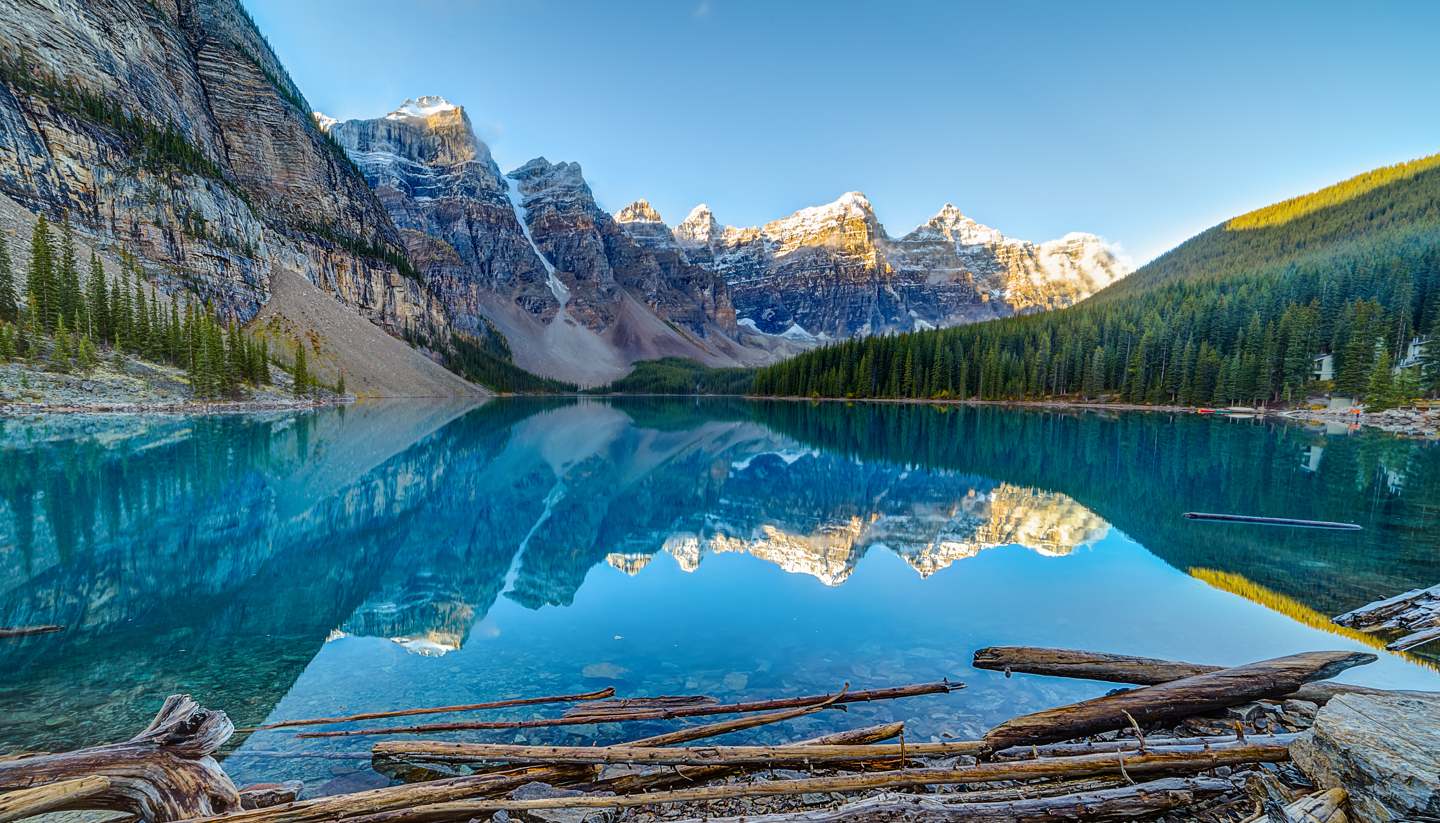
Going off the trail in the Rockies
Banff National Park in the Canadian Rockies is worth visiting.
Book a Hotel
© Columbus Travel Media Ltd. All rights reserved 2024
- Skip to primary navigation
- Skip to main content
- Skip to footer
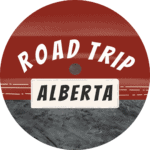
Road Trip Alberta Itineraries & Travel Guides
Take the guesswork out of your trip to alberta.
Our Alberta experts have curated travel guides and itineraries to hit the top highlights of the province (and share some local gems)! For one low price, get travel planning details and local advice that you WON’T find anywhere else.
* JOIN THE HUNDREDS OF PEOPLE WHO HAVE PLANNED AN EPIC ALBERTA VACATION USING OUR GUIDES AND ITINERARIES!
Choose from 8 available ebooks (get a discount when you buy 3 or more) ..
Click on the books to learn more about each.
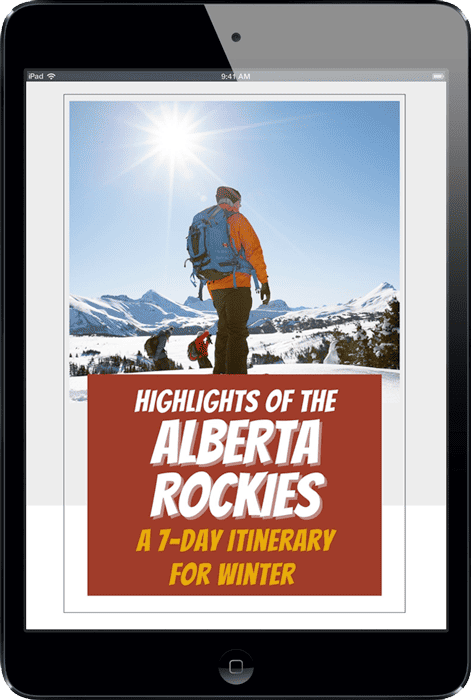
has been added to your cart!
have been added to your cart!
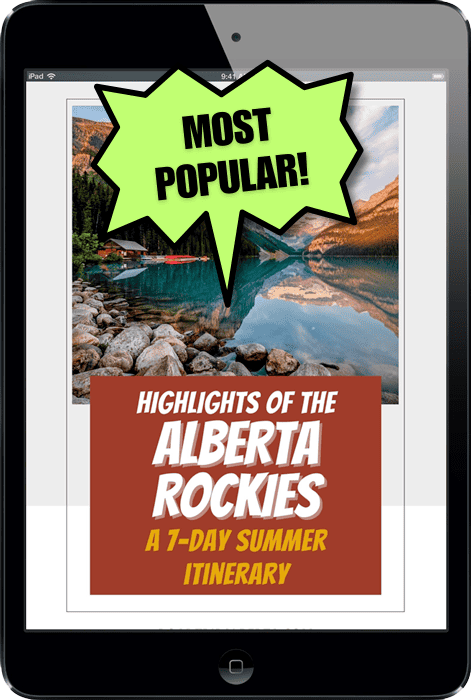
Each book is $14, or purchase 3 for $35!
The discount will be applied at checkout.
“The 7-day Itinerary was very well laid out, informative and organized. Everything – the restaurant and hotel recommendations – were spot on.”
~ Sunny. May, 2021.
Included in each ebook:
- Details about the top sights and activities that we recommend.
- Recommended accommodations for every budget.
- A curated list of where to eat and drink. Plus, details on festivals, guided tours, and more.
- Information on road conditions and driving tips, national park passes, and wildlife safety.
- Direct links to booking pages, to enable easy planning.
- A custom Google map you can launch on your phone to lead you around the area.
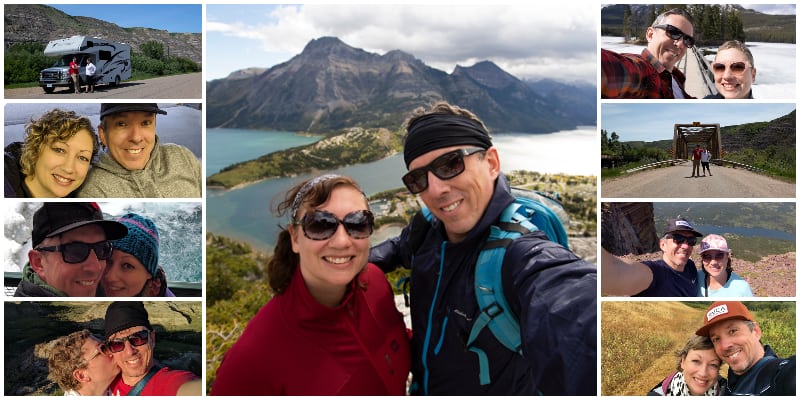
Custom Alberta Travel Planning Services
Want to go a step further and have a bespoke trip planned with your exact needs and desires in mind? We can do that too. Learn more about our Alberta vacation travel planning services .
“Your itinerary is truly outstanding! It’s so helpful and will continue to be for the duration of our trip. Traveling to a destination for the first time that offers so many options can be overwhelming. What you guys offer is priceless!”
~ Loreto from Toronto, Ontario. August, 2021.
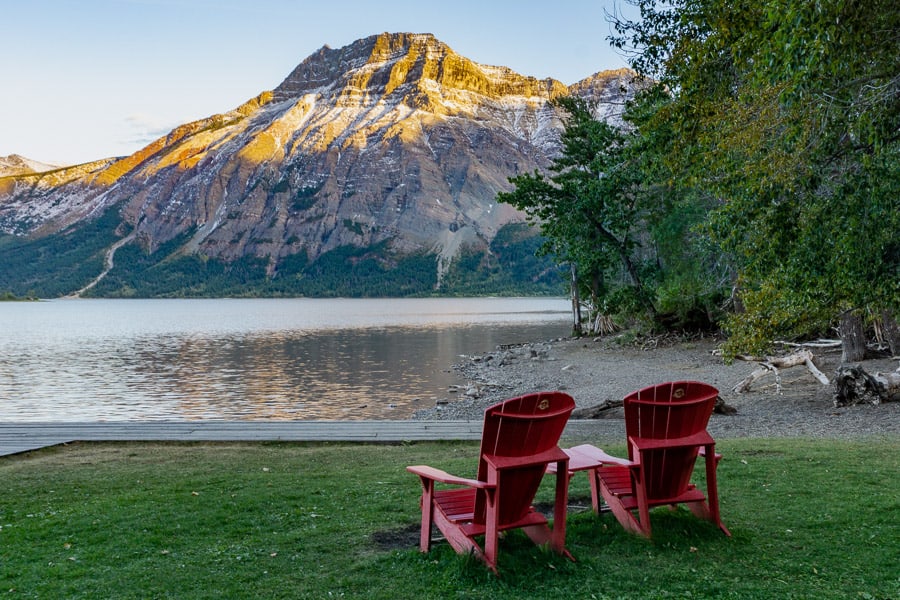
Related Posts
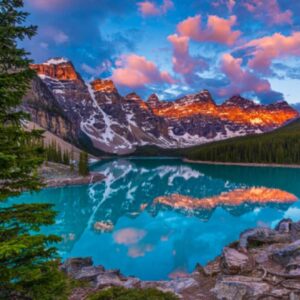
Sharing is caring!
Before Footer
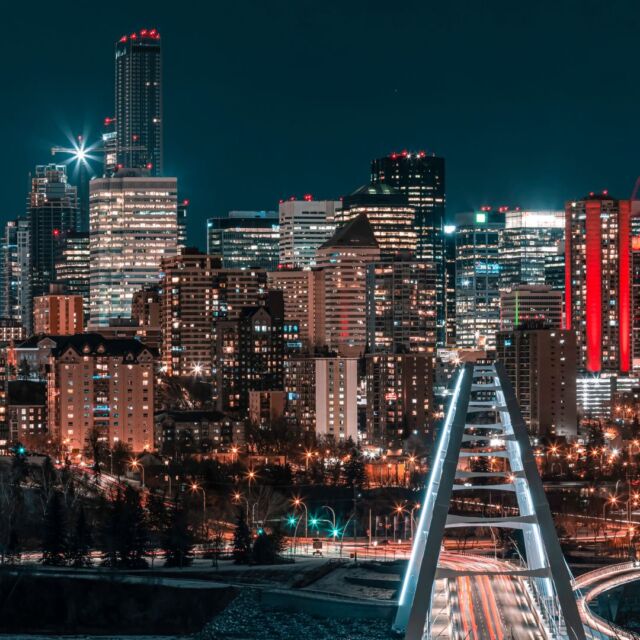
We're here to help you plan your Alberta vacation with real, local advice!
- Destination Guides
- Route Guides
- Driving Advisories
- Alberta Driving Guide
- Alberta Weather
- Alberta itineraries
Play Alberta Road Trip Bingo!
We've created FOUR Alberta specific bingo games to make your road trip even MORE fun. Included are some insider tips on what to see and eat in the province!
Don't miss this deal!
Use code RTA20PERCENT at checkout to save 20% on ebooks.

Alberta Travel Guide
Strapped between British Columbia to the west and Saskatchewan to the east, Alberta rivals all provinces in oil production and the hottest stampede show put on in the country. Officially, the province has the largest shopping mall in the world attracting travelers year round both nationally and internationally. Alberta's lakes, dinosaur sites, prairies, and stunning Provincial Parks act as popular outdoor playgrounds to the public during the summer season. Less well known, may be the storm watching season for thunder and lighting shows that make for a memorable vacation and wild nights. Appropriately, the pink Wild Rose represents the province - its rugged winters, its rich agriculture, its dense grasslands, and its unpredictable Chinook winds. Supported by major epicenters for business, Alberta pulls out the red carpet for travelers wanting cultural diversity, urban attractions, and the true Western experience. Choose any region to find out more!
- Drayton Valley
- Fort Macleod
- Grande Cache
- Grande Prairie
- High Prairie
- Lac La Biche
- Lake Louise
- Peace River
- Picture Butte
- Pincher Creek
- Rainbow Lake
- Rocky Mountain House
- Saskatchewan River Crossing
- Sherwood Park
- Stony Plain
- Sylvan Lake
Nomadic Matt's Travel Site
Travel Better, Cheaper, Longer
Calgary Travel Guide
Last Updated: August 30, 2023
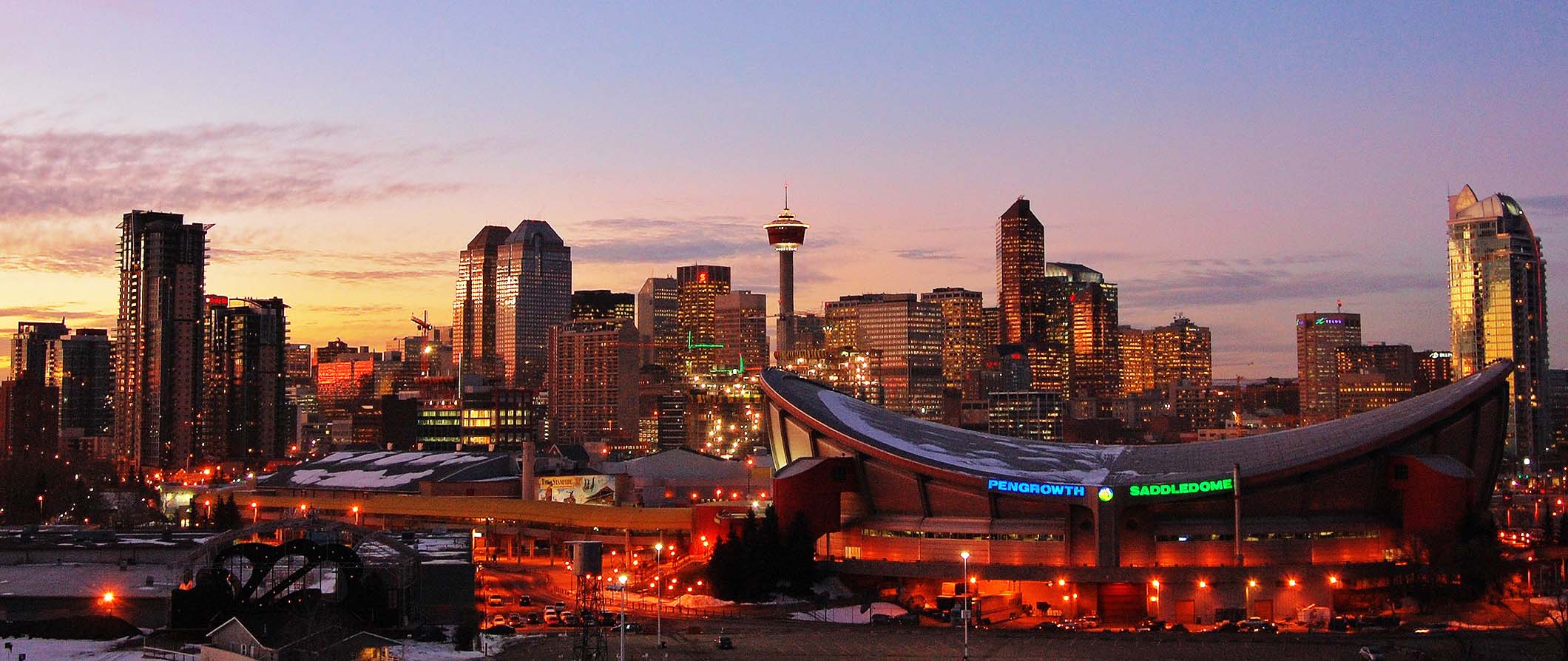
While the city itself isn’t particularly pretty — it’s full of skyscrapers and doesn’t have a lot of historic buildings — underneath all that glass is a cosmopolitan destination with a rough and wild cowboy charm to it. There’s great hiking, kayaking, skiing, water rafting, and camping all around Calgary and the city itself is one of the liveliest in the country, especially during the Stampede.
There’s a ton of greenspace here too. Add in a rotating roster of food trucks, craft beer bars, and top-notch museums, and you’ve got a recipe for one of my favorite cities in Canada.
From here, you can head out to Banff National Park or Canmore to get up close and personal with nature and explore one of Canada’s most scenic regions.
This travel guide to Calgary can help you plan your trip, save money, and make the most out of your time in Calgary!
Table of Contents
- Things to See and Do
- Typical Costs
- Suggested Budget
- Money-Saving Tips
- Where to Stay
- How to Get Around
- How to Stay Safe
- Best Places to Book Your Trip
- Related Blogs on Calgary
Top 5 Things to See and Do in Calgary
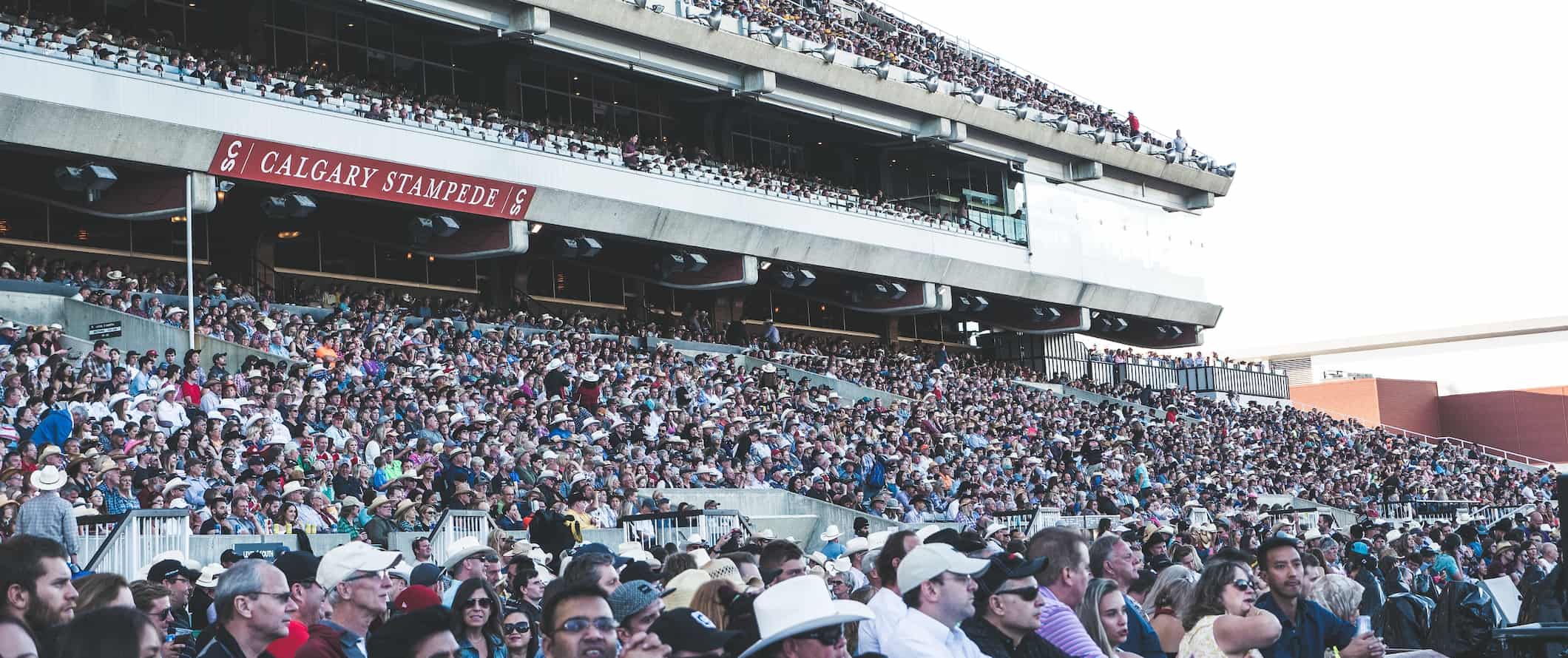
1. Celebrate the Calgary Stampede
The Calgary Stampede is the world’s largest open-air rodeo held every year in July. The Stampede celebrates Canada’s western heritage with chuckwagon races, bull riding, concerts, carnival rides, and endless fair food (deep-fried butter, anyone?). It’s also a crazy party. Daytime rodeos start at 66 CAD and evening rodeos start at 84 CAD. There’s even a Drag Queen brunch in case you didn’t know you could combine a Western theme with a drag show! Just be sure to book your accommodation early as the city fills up fast!
2. Walk Stephen Avenue
Stephen Avenue is a pedestrian-only thoroughfare in the heart of downtown Calgary. It’s lined with antique stores, boutiques, restaurants, and bars. It’s best in the summer when the outdoor patios are overflowing with locals enjoying an after-work drink. This street is a great place for food trucks, outdoor festivals, and live music. In February, it turns into a snowy wonderland during the Downtown Glowfest light festival with performances and beautiful art installations. At the same time, you can warm your hands with delicious hot chocolate served both with and without alcohol at the YYC Hot Chocolate Festival.
3. Relax in the many parks
Calgary makes incredible use of its green spaces and there are many beautiful places where you can lounge and relax or enjoy the area cycling the numerous trails around the city. Visit Bowness Park, one of the city’s most popular parks in warm weather alongside the Bow River, where you can enjoy walking the paths, swim in the lagoon, BBQ, or rent a boat for the day. In winter, it’s a popular spot for ice skating and cross-country skiing, and the popular Canadian winter sport of crokicurl (hybrid of curling and crokinole). Prince’s Island Park is where people gather for Canada Day and Calgary’s Folk Festival celebrations in July. The Winter Music Folk Festival also happens there as well. In short, there is a ton of greenspace that can help you enjoy the city and take in the local pace of life on a budget.
4. Visit the Calgary Zoo
Not only is the Calgary Zoo home to tons of interesting wildlife, but it also houses the Centre for Conservation Research. There are currently around 900 animals from all over the world. Go see the penguins splashing around or check out the ‘Canadian Wilds’ area with moose, grizzly bears, bighorn sheep, and more. Or explore the indoor ‘Destination Africa’ pavilion with giraffes, monkeys, hippos, and more. Every month there are different special events. If you’re here at Christmas, attend the Zoolights, a spectacular light show composed of three million lights. And if you want to splash out, you can even sit inside a warm ‘Snowglobe’ in their Garden of Light and enjoy a hot cup of mulled wine and an artisan cheese board (175 CAD for two people). Regular admission is 30 CAD.
5. Go to the Rockies
Calgary is close to the Rocky Mountains, and the highlight of this region is the spectacular Banff National Park. The Park is a UNESCO World Heritage Site and both Canada’s first national park and its most famous due to its picturesque turquoise lakes, snow-capped peaks, wildlife, and breathtaking scenery. There are over 1,600 kilometers (1,000 miles) of stunning mountain trails with all sorts of activities, from hiking, skiing, and horseback riding, as well as places to camp. You can certainly visit as a day trip from Calgary, but you’ll be missing out if you don’t spend a few days here. There is something for every budget when it comes to how much you want to experience nature. You can pitch a tent at a campsite, rent a cabin, try glamping, or stay in Banff town at a hotel. Even without a car, it’s easy to get here via bus (though renting a car is the best way to explore this area).
Other Things to See and Do in Calgary
1. take a free walking tour.
The first thing I do when I arrive in a new city is take a free walking tour. It’s the best way to see the highlights and meet a local expert guide who can answer all your questions. Walk the YYC runs a solid free tour that can introduce you to the city. Just be sure to tip your guide at the end! There’s also Calgary Greeters, a free local greeting program that connects you with a local who can show you around (advanced bookings required).
2. Hang out in Prince’s Island Park
Right on the Bow River, this park spans 50 acres and is the most popular park in the city. There are free festivals and events year-round, such as the Calgary Folk Music Festival and Shakespeare in the Park. It also has running and hiking paths, cross-country skiing trails, picnic areas, flower gardens, and lots of space to simply lounge and relax. In the winter, people go skating on the lagoon.
3. Check out Fish Creek Provincial Park
Fish Creek also sits along the Bow River and is perfect for walking, cycling, and rollerblading. In the summer, people come here to fish, swim in Sikome Lake, and have barbecues. Locals also hit the trails in the winter for cross-country skiing and snowshoeing. Just be aware the park closes between 6pm-10pm depending on the time of year.
4. Explore the nightlife of Kensington
Located in the northwest part of the city, Kensington is a tiny business district full of trendy shops, bars, and restaurants. Whether you’re seeking a quiet pub, an outdoor patio, or a fun-filled night of dancing, you’ll find it here. Kensington Pub, Winebar Kensington, and Container Bar are all great spots to hang out for their cozy atmosphere and unique decor.
5. Go brewery hopping
If you’re a craft beer lover, Calgary has a huge number of brewpubs, small breweries, and even a Craft Beer Market. Citizen Brewing Company, Cold Garden Beverage Company, and Big Rock are some of my favorites. You can also do a brewery hopping tour with Canadian Craft Tours to 3-4 different breweries for 109 CAD.
6. Watch the Calgary Flames
Hockey is a religion in Canada, and the folks in this city take their hockey very seriously. Calgary has one of 7 Canadian teams in the NHL so check and see if there’s a game on during your visit. Tickets start around 37 CAD but you can also just find a busy pub or bar to grab a beer and watch the game with locals.
7. Wander Eau Claire Market
This indoor market has something for everyone, including a variety of upscale shops, restaurants, and a food court. In the summer, there’s a playground and a wading pool for kids. Buskers are everywhere making balloon animals, performing music, or even putting on puppet shows. Eau Claire is also the festival district, so there is often some sort of community event taking place (usually concerts). It’s a bit cheesy, but it’s a fun spot if you’re traveling with family.
8. See the Family of Man Sculptures
This collection of ten aluminum cast sculptures (some weighing as much as 1,500 pounds and measuring 21 feet tall) makes for quite the sight to see surrounded by skyscrapers and office buildings in downtown Calgary. Originally designed by Mario Armengol and displayed at the Expo 67 World’s Fair in Montreal, these sculptures were later presented and dedicated to the city in 1969.
9. Check out the Canada Olympic Park
Calgarians are an active bunch. On Friday afternoons in the winter, you’ll see SUVs and trucks loaded up with ski gear leaving town for the mountains. The Olympic Park is where many of them get their start with winter sports. This ski hill and training/competition complex serves as a tribute to the 1988 Olympic Games and is mostly used as a training ground for young athletes. If you’re here in the winter, sign up for a downhill or cross-country ski lesson, which costs about 75 CAD for 90 minutes. You can even try the bobsled or luge!
10. Head to the top of the Calgary Tower
Built in 1967, the Calgary Tower stands 191 meters (626 feet) and commemorates Canada’s Centennial. It’s the centerpiece of the city and at the top, you’ll get uninterrupted views straight to the Rocky Mountains. Plus, the glass floor at the observation deck is thrilling (and terrifying). A ticket to the top is 19 CAD if you buy online and 21 CAD at the ticket window.
11. Visit the Heritage Park Historical Village
This heritage park is like a living museum. It showcases Western Canadian history from the 1860s to the 1950s. You can ride a steam train, learn how to make old-fashioned ice cream, chat with actors dressed up as prairie settlers, explore First Nations history, and take a horse-drawn wagon ride. It’s another one of those somewhat cheesy experiences, but you’ll learn a lot and it’s fun for kids. Tickets are 30 CAD.
12. Take a food tour
If you want to sample the finest foods that Calgary has to offer, take a food tour with Alberta Food Tours. They have several different excursions, including a Calgary Farmers’ Market tour and a walk through the Inglewood neighborhood. You can try poutine, cheeses, charcuterie, sweet treats, a few drinks, and more throughout the evening. Food Tours run during the high season until October and cost 95 CAD. There is also a self-guided tour all year round using their app for only 45 CAD, which is 2.5 hours long and includes some tastings as well as discounts from several of their business partners.
For more information on other cities in Canada, check out these guides:
- Montreal Travel Guide
- Nova Scotia Travel Guide
- Ottawa Travel Guide
- Quebec City Travel Guide
- Toronto Travel Guide
- Vancouver Travel Guide
- Vancouver Island Travel Guide
Calgary Travel Costs
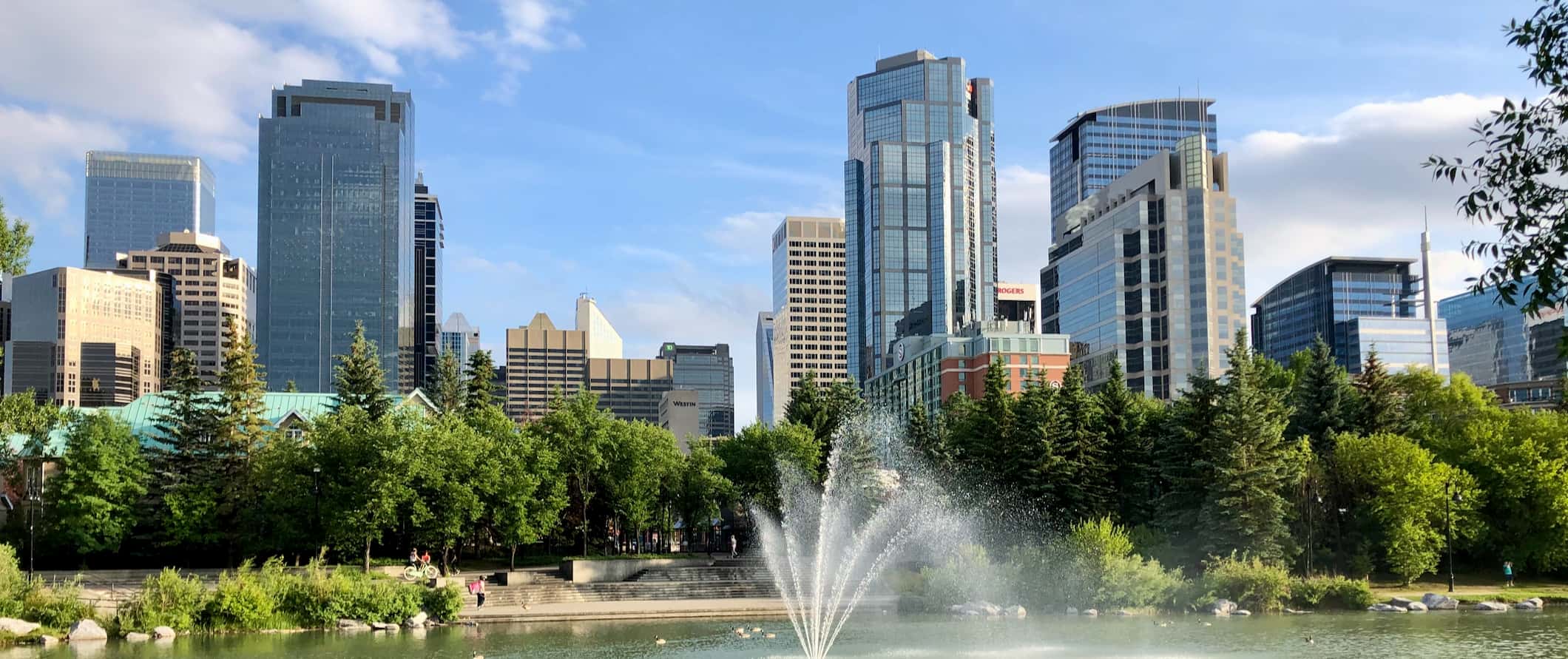
Hostel prices – There are only a couple of hostels in Calgary. A bed in a room with 4-6 beds is 30-45 CAD per night while a dorm with 8 beds or more costs about 40 CAD.
Private hostel rooms start from 90 CAD per night for two people but can go as high as 175 CAD. During the Stampede, prices shoot up by about 50% and sell out months in advance, so make sure you book ahead.
For those traveling with a tent, camping is available outside the city for 30 CAD per night. This gets you a basic plot without electricity. RV plots cost around 55 CAD per night.
Budget hotel prices – Budget hotels start at 90 CAD, but these aren’t near the city center. For something closer to downtown, expect to pay at least 120 CAD per night. Free Wi-Fi, AC, TV, and a coffee/tea maker are usually included.
Airbnb is available everywhere in Calgary, with a private room starting at 50-65 CAD per night. An entire home/apartment averages 90-125 CAD per night. Prices double when not booked in advance.
During the summer months, there is also the option of renting a dorm room from a university. Rooms are generally available from early May to late August and offer access to on-campus services (laundry, parking). Mount Royal University has single rooms starting from 109 CAD per night.
Food – Overall, the food here is a collage of dishes from other cultures, owing to the country’s diverse history of immigration. In Calgary, beef is the go-to meat since half of the entire country’s beef supply comes from Alberta. Bison is also common, as are fresh berries in the summer. More general Canadian staples include beaver tails (fried dough with fresh maple syrup), Canadian bacon, poutine (fries with gravy and cheese curd), and the oddly tasty ketchup chips.
For the city’s best eats, hit the food trucks. Calgary has an epic food truck scene, and their locations change daily. Download the Street Food Calgary app to follow the trucks in real time.
You can find pizza by the slice for 4 CAD. Larger meals like taco salad or curry cost around 11 CAD.
A combo meal at McDonald’s costs about 12 CAD. Pubs and chain restaurants are very reasonable at about 20 CAD for a meal with a drink.
Higher-end restaurants set you back around 60 CAD if you also order an appetizer and a drink.
A glass of wine is around 9 CAD while beer is 7 CAD. A latte/cappuccino costs around 4.75 CAD. Bottled water costs 2 CAD.
If you cook for yourself, expect to spend around 50-60 CAD per week on groceries. This gets you basic staples like pasta, rice, produce, and some meat.
Some of my favorite places to eat in Calgary include CRAFT Beer Market, Holy Grill, Bridgette Bar, and Peters’ Drive In.
Backpacking Calgary Suggested Budgets
If you’re backpacking Calgary, expect to spend about 75 CAD per day. This budget assumes you’re staying in a hostel, cooking all your meals, taking public transportation to get around, limiting your drinking, and doing mostly free activities like hanging out in the parks and wandering Stephen Avenue. Add 10-15 CAD extra per day if you plan on drinking.
On a mid-range budget of 155 CAD per day, you can stay in a private Airbnb room, eat out more (but still cook some meals), rent a bicycle to get around and take the occasional taxi, enjoy a couple drinks, and visit more attractions like the zoo. If you plan to visit during the Stampede, add in another 66 CAD per day.
On a “luxury” budget of 315 CAD per day or more, you can stay in a hotel, eat out for all your meals, drink more, rent a car, and do whatever tours and activities you want. This is just the ground floor for luxury though. The sky is the limit!
Keep in mind that many of these prices (especially accommodations) increase by 50% during Stampede time!
You can use the chart below to get some idea of how much you need to budget daily, depending on your travel style. Keep in mind these are daily averages — some days you’ll spend more, some days you’ll spend less (you might spend less every day). We just want to give you a general idea of how to make your budget. Prices are in CAD.
Calgary Travel Guide: Money-Saving Tips
Calgary is not a cheap city. If you stick to mostly free activities, you’ll save some money but otherwise, things here are pricey. It’s one of the more expensive cities in Canada and it’s tough to visit on a limited budget. Nevertheless, here are some tips to help you save money in Calgary:
- Stay with a local – If you plan ahead, you can usually find a Couchsurfing host to give you a free place to stay. You’ll not only save money but you’ll get to connect with a local insider who can share their tips and advice.
- Take a free walking tour – Walking tours are a great way to get familiar with a city and its culture. Walk the YYC is the only free walking tour in town, but it’s a good one! You can also book a Calgary Greeter — a local volunteer who walks you around the city.
- Avoid the Calgary Stampede – If you’re not dying to see the Stampede, avoid the dates around this event. Prices are higher everywhere. On the other hand, if you are here during Stampede, take advantage of the city’s many free pancake breakfasts (stampedebreakfast.ca).
- Look for free events – Most of Calgary’s street festivals are free to attend, and there are free events year-round. Check out Visit Calgary’s website for their up-to-date event listings!
- Spend your time in nature – With its abundance of outdoor activities, walking/biking trails, and relaxing parks, if you spend most of your time soaking up Calgary’s big nature you’ll save a lot of cash.
- Bring a water bottle – The tap water here is safe to drink so bring a reusable water bottle to save money. LifeStraw makes a reusable bottle with a built-in filter to ensure your water is always safe and clean.
Where to Stay in Calgary
There are only a few hostels in Calgary so be sure to book early if you can. Here are my suggested places to stay:
- HI Calgary City Centre
- Wicked Hostels Calgary
- HI Kananaskis (located west of Calgary, near the mountains)
- HI Lake Louise (Banff)
How to Get Around Calgary
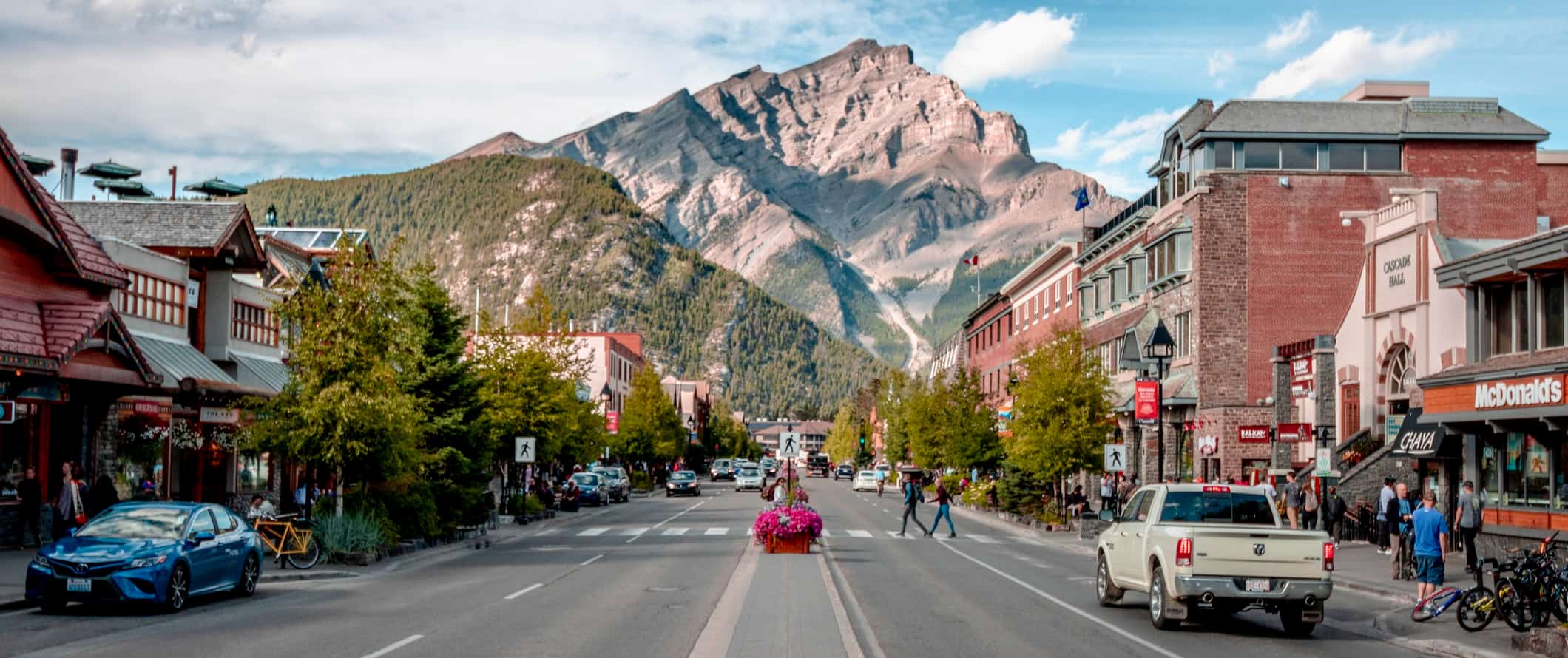
Public transportation – Calgary has a well-connected bus system. Use cash to purchase a ticket on the bus (exact change required), or buy tickets at many drug stores, supermarkets, and corner shops. Fares are 3.60 CAD one way, or you can pay 11.25 CAD for a day pass (which is the best deal). One-way fares are valid for 90 minutes.
Calgary also has two Light Rail Transit (LRT) lines known as the C-Train. You can buy tickets with cash or credit card at any C-Train station, and ticket prices cost the same as the bus. You can ride the C-Train for free in Calgary’s downtown core between the City Hall Station and Downtown West/Kerby Station, but make sure you have a ticket as soon as you leave the free zone (a section downtown where fares are free between 3rd Street East and 11th Street West along 7 Avenue).
Taxi – Taxis are not cheap here. Their base rate is 4 CAD, and it’s an additional 1.93 CAD per kilometer afterward. Prices add up fast so skip the taxis here if you can!
Ridesharing – In addition to taxis, you can also use Uber to get around Calgary. It’s cheaper, but it’s still going to break the bank if you use it often, so stick to public transportation as much as possible.
Bicycle – Calgary has more cycling paths than anywhere in North America, with nearly 850 kilometers (528 miles) of pathways! Plus, most major streets have designated biking lanes. Lime Bike is a public bike-share program that lets you rent an e-bike to get around. Just download the app, search for a bike nearby, and unlock it for 1 CAD. After that, it’s 0.30 CAD per minute to ride, meaning a 30-minute journey costs about 10 CAD. If you’d like to take a bike out for longer, Sports Rent offers rentals for 35 CAD per day.
Car rental – Car rentals can be found for around 40 CAD per day for a multi-day rental. However, unless you’re leaving the city to explore I wouldn’t suggest renting one. Parking adds up and the bus can get you anywhere you need to go on a budget!
When to Go to Calgary
Late spring and summer in Calgary are the best times to visit, especially between May and early September. There’s so much going on in the city, and everyone is outdoors making the most of it. The average daily temperature is around 23°C (73.4°F), but it’s often higher than 30°C (86°F). Calgary is never really overcrowded with visitors compared to places like Toronto and Vancouver (except during Stampede in July).
Things start cooling off considerably in the fall; don’t be surprised if you see snow in September. Winters are cold, with average temperatures hovering around -11 to -14°C (12-6.8°F). This doesn’t discourage Calgarians in the slightest, however, and you’ll find most people hitting the slopes around Kananaskis and Banff on their time off.
If you’re into winter sports, embrace the cold and take advantage of the near-constant perfect snow conditions.
If the national parks are your priority, aim for a spring or fall visit. The parks are bursting with people in the summer. Additionally, try to skip weekend visits as that’s when the parks are busiest.
How to Stay Safe in Calgary
Calgary is a very safe city. Violent crime here is very rare. Your greatest risk is petty theft, such as pickpocketing, but even that is rare. Just keep your valuables secure and out of reach at all times just to be safe.
The eastern part of downtown (east of City Hall) is a bit sketchy at night, so avoid walking through that area alone.
If you’re not used to severe winter weather, make sure you bring lots of layers and appropriate clothing if you’re visiting in the winter. Avoid staying outside for too long if you’re not adequately protected. It gets cold!
Solo female travelers should feel safe here, however, the standard precautions apply (never leave your drink unattended at the bar, never walk home alone intoxicated, etc.).
Scams here are rare, but if you’re worried about getting ripped off you can read about common travel scams to avoid here.
If you experience an emergency, dial 911 for assistance.
The most important piece of advice I can offer is to purchase good travel insurance. Travel insurance will protect you against illness, injury, theft, and cancellations. It’s comprehensive protection in case anything goes wrong. I never go on a trip without it as I’ve had to use it many times in the past.
Calgary Travel Guide: The Best Booking Resources
These are my favorite companies to use when I travel. They consistently have the best deals, offer world-class customer service and great value, and overall, are better than their competitors. They are the companies I use the most and are always the starting point in my search for travel deals.
- Skyscanner – Skyscanner is my favorite flight search engine. They search small websites and budget airlines that larger search sites tend to miss. They are hands down the number one place to start.
- Hostelworld – This is the best hostel accommodation site out there with the largest inventory, best search interface, and widest availability.
- Booking.com – The best all around booking site that constantly provides the cheapest and lowest rates. They have the widest selection of budget accommodation. In all my tests, they’ve always had the cheapest rates out of all the booking websites.
- Get Your Guide – Get Your Guide is a huge online marketplace for tours and excursions. They have tons of tour options available in cities all around the world, including everything from cooking classes, walking tours, street art lessons, and more!
- SafetyWing – Safety Wing offers convenient and affordable plans tailored to digital nomads and long-term travelers. They have cheap monthly plans, great customer service, and an easy-to-use claims process that makes it perfect for those on the road.
- LifeStraw – My go-to company for reusable water bottles with built-in filters so you can ensure your drinking water is always clean and safe.
- Unbound Merino – They make lightweight, durable, easy-to-clean travel clothing.
- Top Travel Credit Cards – Points are the best way to cut down travel expenses. Here’s my favorite point earning credit cards so you can get free travel!
Calgary Travel Guide: Related Articles
Want more info? Check out all the articles I’ve written on backpacking/traveling Canada and continue planning your trip:
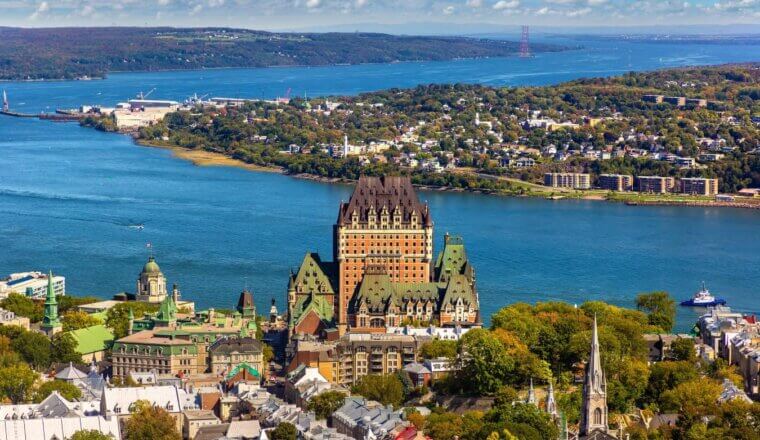
Where to Stay in Quebec City: The Best Neighborhoods for Your Visit
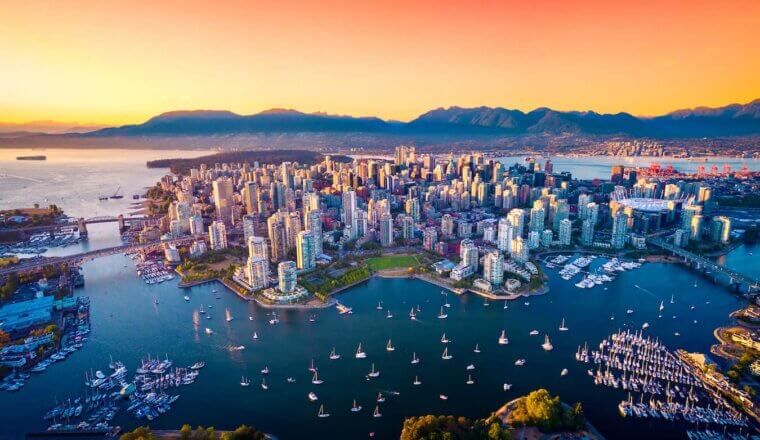
Where to Stay in Vancouver: The Best Neighborhoods for Your Visit
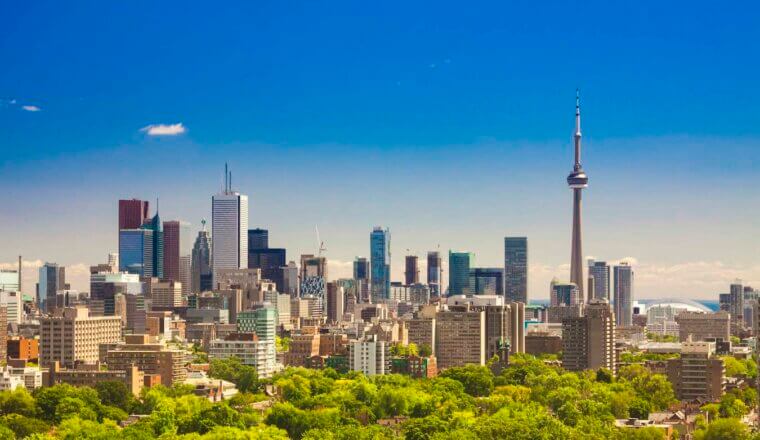
Where to Stay in Toronto: The Best Neighborhoods for Your Visit
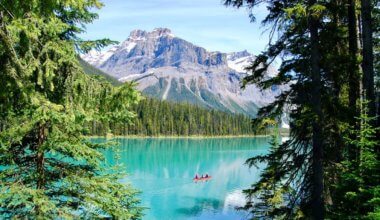
Canada Road Trip: A One Month Suggested Itinerary
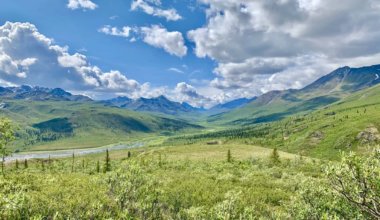
How to Road Trip the Yukon on a Budget
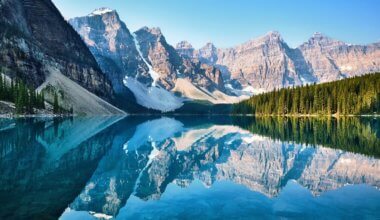
How to See Alberta: A 10-Day Suggested Driving Itinerary
Get my best stuff sent straight to you, pin it on pinterest.
- Where To Stay
- Transportation
- Booking Resources
- Related Blogs

IMAGES
VIDEO
COMMENTS
Canada's Rocky Mountains hold unforgettable experiences for all who visit. Explore our mountains. Banff, Canada's first national park, was established in 1885. Banff has 1,600 km (994 mi) of maintained trails—that's like walking the length of New Zealand.
The Rocky Mountain Parks. The most iconic tourist destination in Alberta — and possibly the entire country — is the beautiful Banff National Park and its emerald-green Lake Louise.Containing over 6,000 square kilometers of unspoiled Rocky Mountain scenery, Canada's most popular outdoor resort is home to virtually every activity you could imagine, with over 1,000 km of hiking trails, a ...
Welcome to the enchanting province of Alberta, a captivating destination nestled in the heart of Canada. Known for its breathtaking natural beauty, Alberta offers a diverse range of landscapes that will leave travelers in awe. From the majestic Canadian Rockies to the vast prairies and vibrant cities, Alberta is a haven for nature enthusiasts ...
The Canadian Rockies are home to turquoise lakes shimmering beneath towering peaks. With so many lakes, Lakelands boasts Alberta's only canoe circuit. Experience the wonder of northern lights in the Wood Buffalo region. Digging for dinosaur bones in the unique landscape of the Canadian Badlands.
Find epic content and personal tips to plan your Alberta trip on the wild side. Explore the Rocky Mountains, the Canadian Badlands, the boreal forest, the prairies and more with this comprehensive guide.
Featured road trips & itineraries. 3D Tour. 3D Tour. 3 Days. Make your way from Calgary to Jasper on the most scenic route through the Rocky Mountains. Learn more. 3 Days. Saddle up for unforgettable equine experiences as you journey across cowboy country. See sweeping views of Alberta's foothills, filming location of one of Netflix's most ...
Alberta. Canada, North America. Alberta does lakes and mountains like Rome does cathedrals and chapels, but without the penance. For proof head west to Jasper and Banff, two of the world's oldest national parks; despite their wild and rugged terrain, they remain untrammeled and easily accessible. They're majestic, breathtaking, awesome.
Alberta is one of the most beautiful places to visit in Canada. There is so much that it has to offer - the amazing rocky mountains of Banff, Jasper, and Waterton National Park, the rolling prairies, the dinosaur capital of the world and the badlands, the chance to see the Northern Lights, buffalo watching at Elk Island National Park, and SO ...
Because Alberta is so large, and its attractions so spread out, make sure to fly into the right airport. The Alberta Badlands, the Cowboy Trail, and Banff and Waterton national parks are closer to Calgary, while Jasper National Park is closest to Edmonton. Another scenic way to arrive in Alberta is by train. VIARail's Canada Line runs between ...
Get information on Alberta Travel Guide - Expert Picks for your Vacation hotels, restaurants, entertainment, shopping, sightseeing, and activities. Read the Fodor's reviews, or post your own.
Days 3 & 4 - Banff National Park. The lakes really are this blue in Banff National Park. Banff National Park is one of Canada's top adventure and scenic destinations and will surely be a shining star on your road trip through Alberta. To get to Banff National Park, hop in your car and drive one hour west from Calgary.
Alberta Travel Guide. National Geographic's latest travel stories about Alberta. Photograph by Keith Barraclough, Nat Geo Image Collection. Featured Articles. 10 Must-Have Experiences in Alberta.
5 Jasper - Banff's northerly neighbour - less visited than Banff but no less stunning. 49.694167 -112.832778. 6 Lethbridge - a city in southern Alberta with a population of about 93,000 and most famous for "coulees" (canyons) and proximity to four world heritage sites. 50.033333 -110.666667.
2. Canoe Lake Louise. Lake Louise is the most famous of all tourist attractions in Alberta and the first place most people stop when visiting Banff. Victoria Glacier and the surrounding mountains are reflected in the still turquoise waters making it truly one of the most beautiful places in Alberta.
3. Banff National Park. No trip to Alberta would be complete without a visit to the picturesque sister lakes of Lake Louise and Moraine Lake in Banff National Park. Set in the Valley of the Ten Peaks, the latter attracts serious hikers to its surrounding strenuous trails in the summer, while Lake Louise is a more relaxed year-round affair, with ...
1 Top 10 Things to do in Alberta Canada. 1.1 Spend some time in Calgary, Alberta, Canada. 1.2 Visit Lake Louise. 1.3 Drive the Icefields Parkway. 1.4 Traipse through the Badlands. 1.5 Discover Drumheller. 1.6 Sleep amid the dinosaurs. 1.7 Jasper National Park. 1.8 Take a boat across the border.
Canada Travel Guide 2023 > Alberta Vacation Plan. 2023 Alberta Visitors Guide. Alberta's grandeur or beauty are apparent from which moment of arrival. Rolling hilltop, intimidating mountains, both early hoodoos are a few of Alberta's more distinct native monuments. ... As an Amazon Associate, Free Amusement Guides may earn commissions from ...
Explore the incredible sights and eerie locations of HBO's Alberta-filmed series, The Last of Us, for yourself. The first season was filled with iconic shots from across the province, including downtown Calgary, the Legislature Building in Edmonton, Fort Macleod, Canmore and Calgary's SAIT and Mount Royal University. Read the article.
The World Travel Guide (WTG) is the flagship digital consumer brand within the Columbus Travel Media portfolio. A comprehensive guide to the world's best travel destinations, its print heritage stretches back more than 30 years, with the online portal reaching its 20-year anniversary in 2019. Available in English, German and Spanish versions ...
A curated list of where to eat and drink. Plus, details on festivals, guided tours, and more. Information on road conditions and driving tips, national park passes, and wildlife safety. Direct links to booking pages, to enable easy planning. A custom Google map you can launch on your phone to lead you around the area.
Alberta Travel Guide Strapped between British Columbia to the west and Saskatchewan to the east, Alberta rivals all provinces in oil production and the hottest stampede show put on in the country. Officially, the province has the largest shopping mall in the world attracting travelers year round both nationally and internationally. Alberta's ...
Last Updated: August 30, 2023. Calgary is one of the largest cities in Canada and home to the massive Calgary Stampede, an annual rodeo and festival that brings in over 1 million visitors each year. It's the economic hub of Alberta, one of the country's western provinces, and is just a stone's throw from the stunning vistas of Banff ...
From ancient historic sites to small towns and mountain scenery, Alberta is equal parts journey and destination. Explore all sightseeing & attractions. Natural Attractions. Shopping. Shopping along Europa Boulevard at West Edmonton Mall. Mountain biking in the Badlands.
A Guide to Accessible Travel in Alberta. Reading time: ... Travel Alberta honours and acknowledges the traditional territories of the many First Nations, Métis and Inuit in Alberta. Alberta is situated within historical and present-day lands that Indigenous Peoples have cared for and lived on for generations. We honour the territories of ...